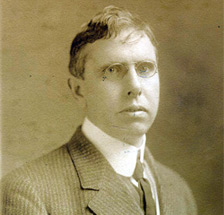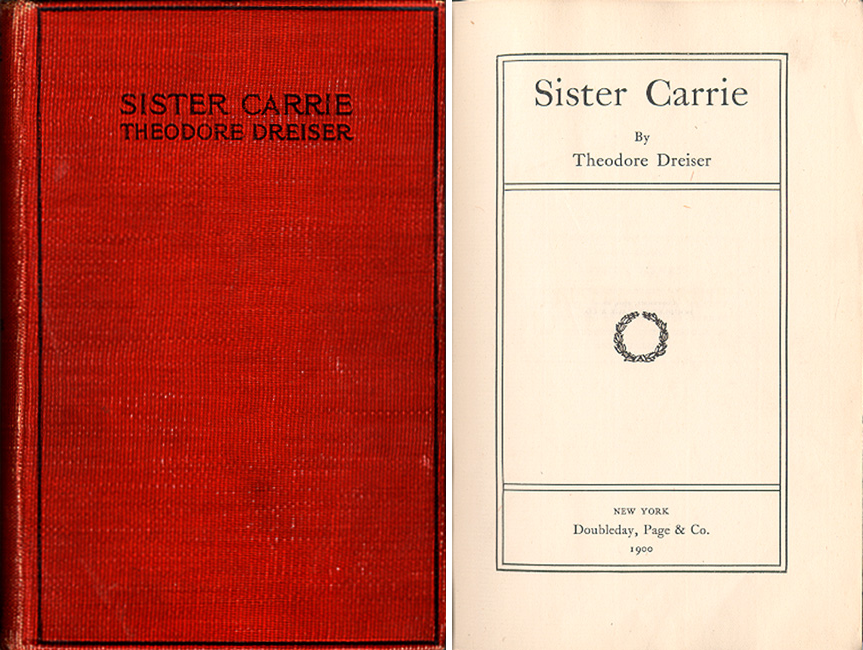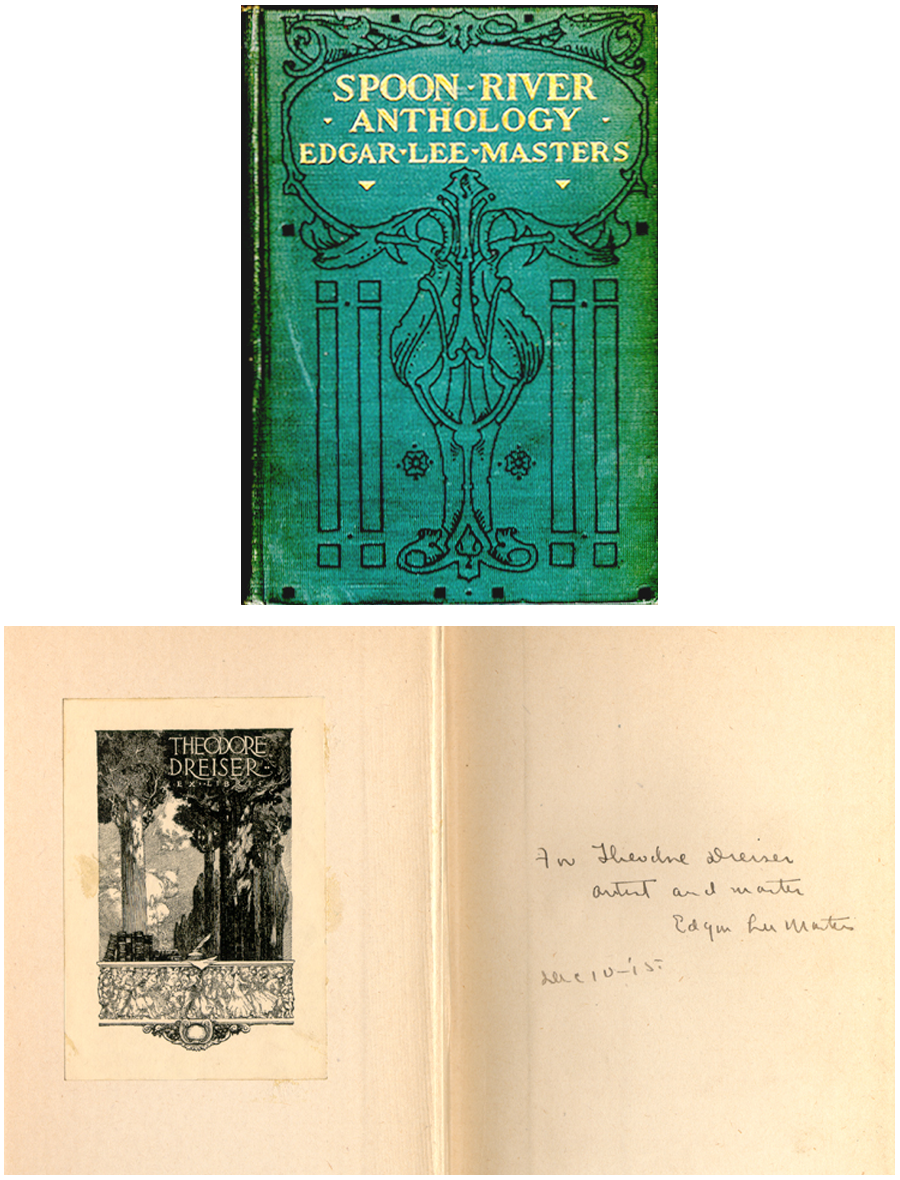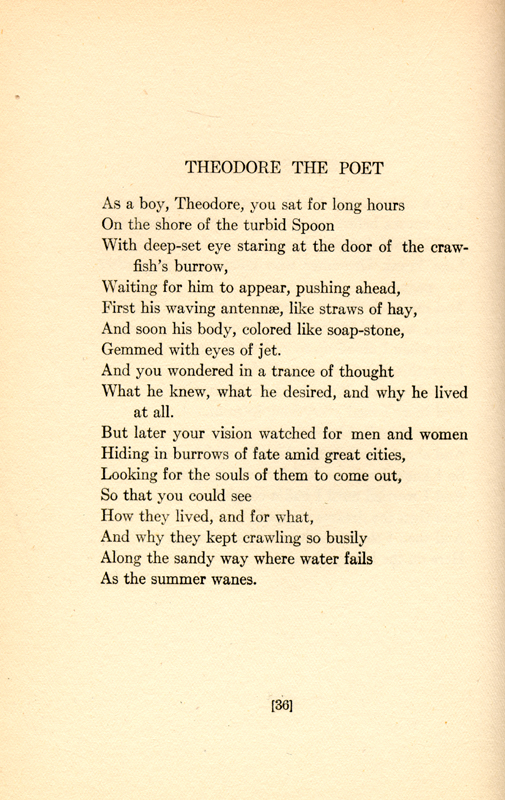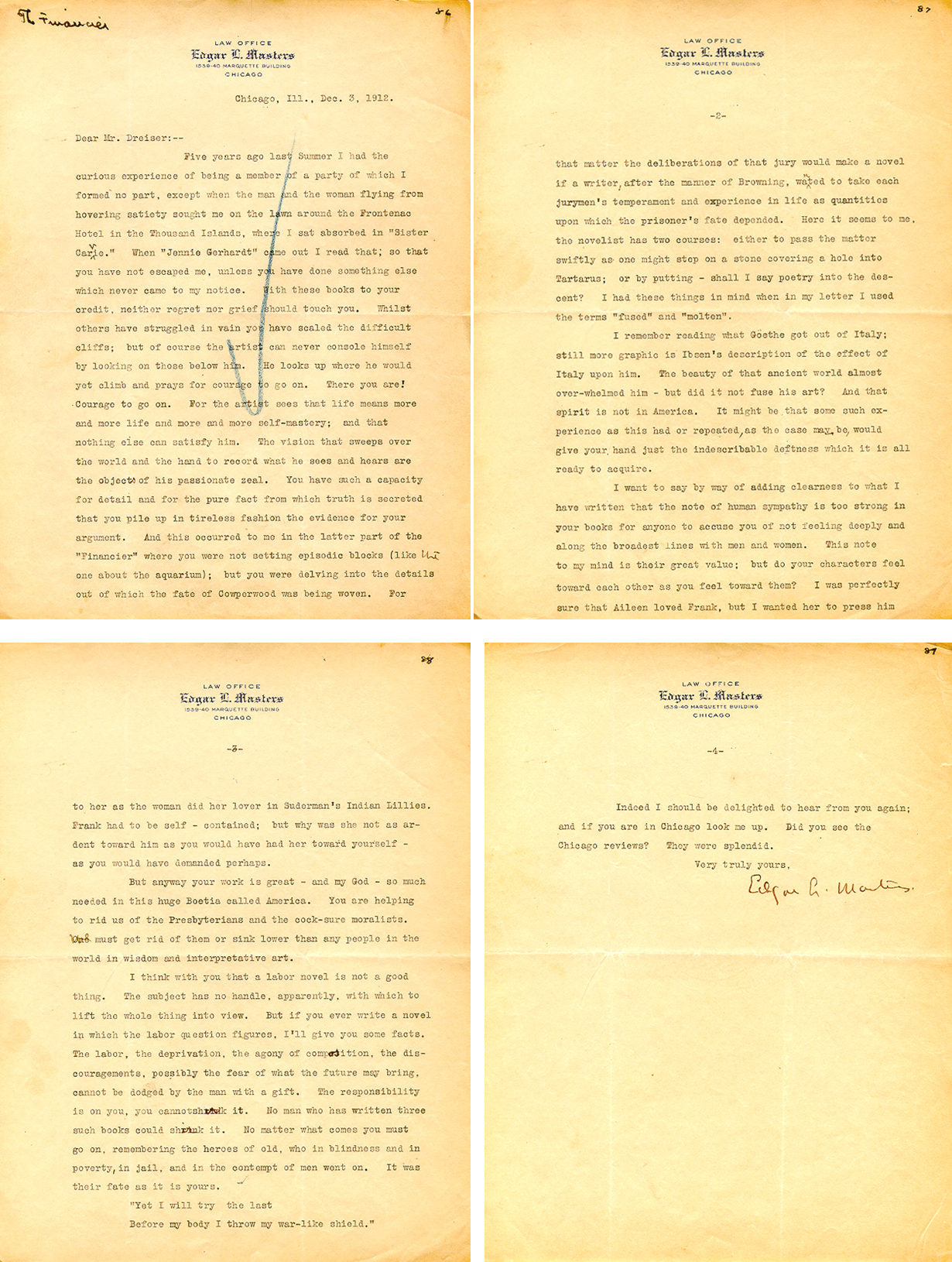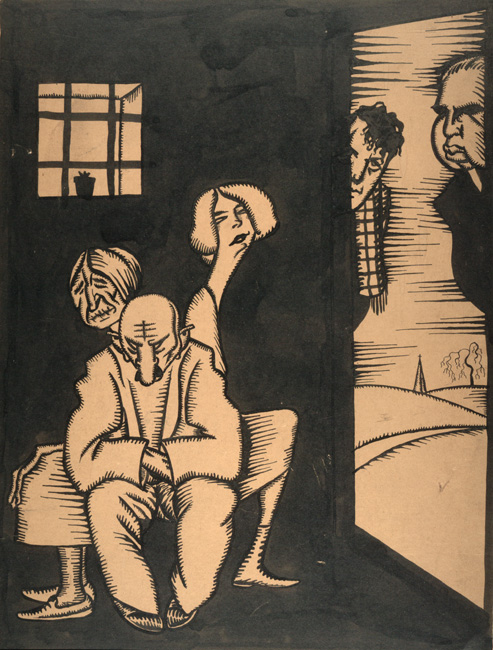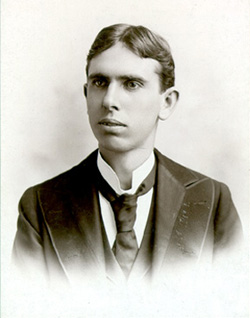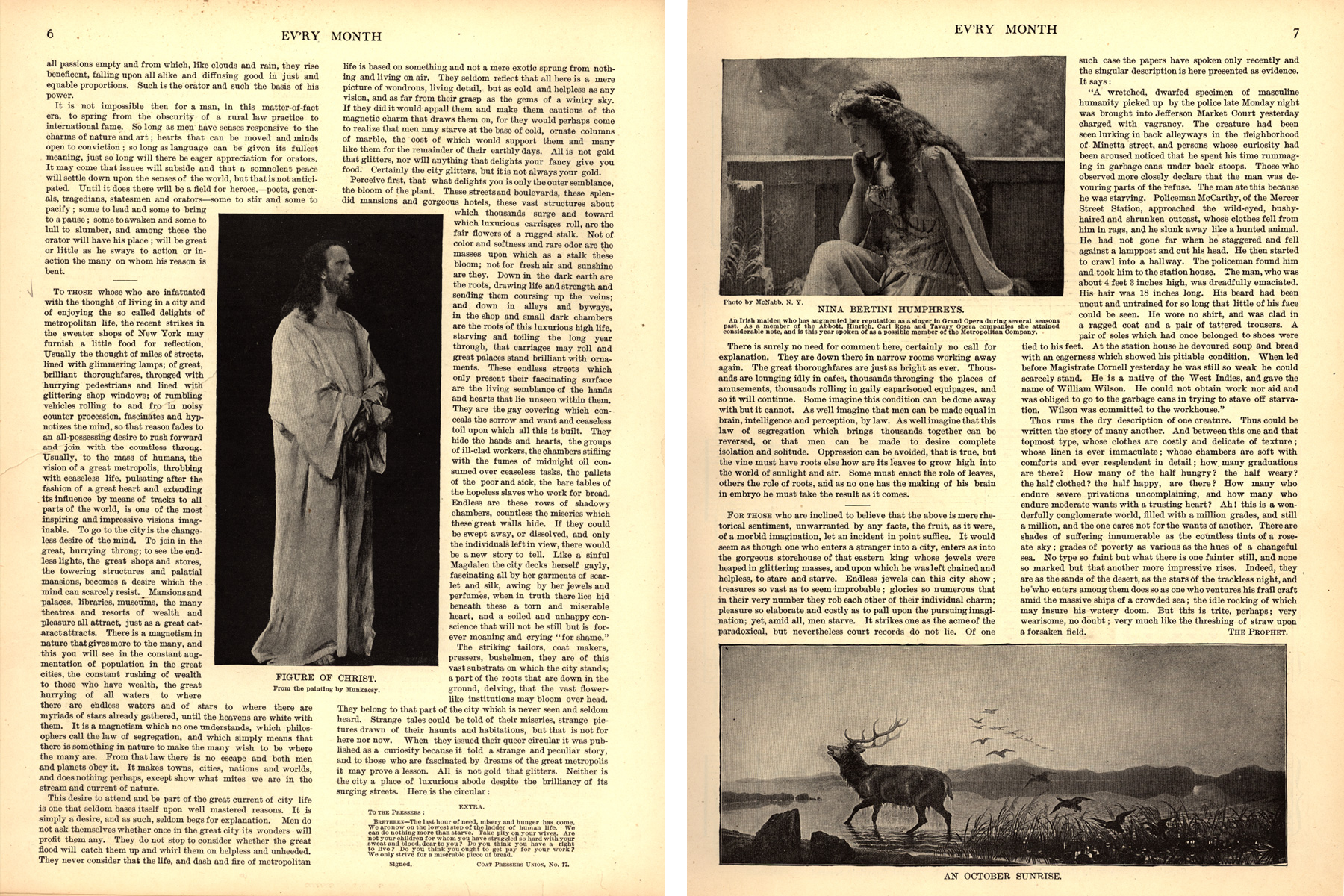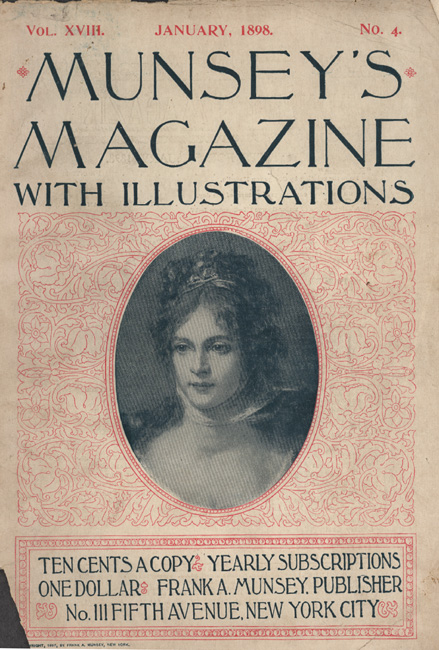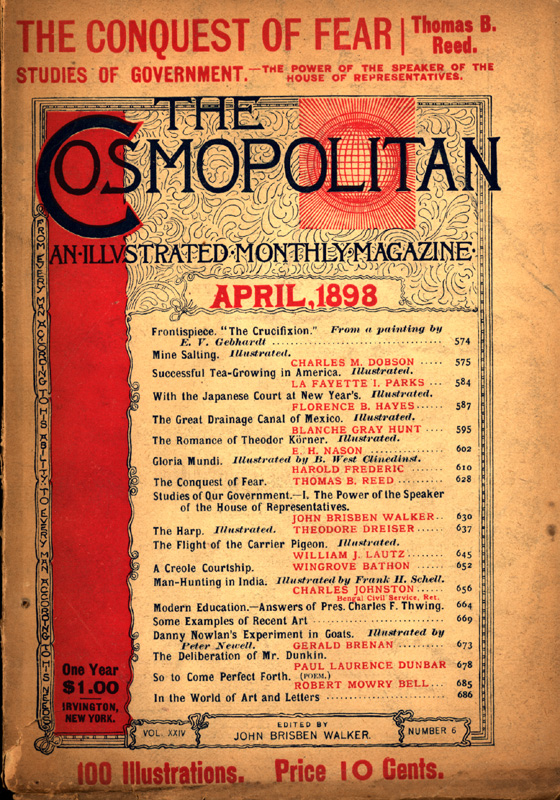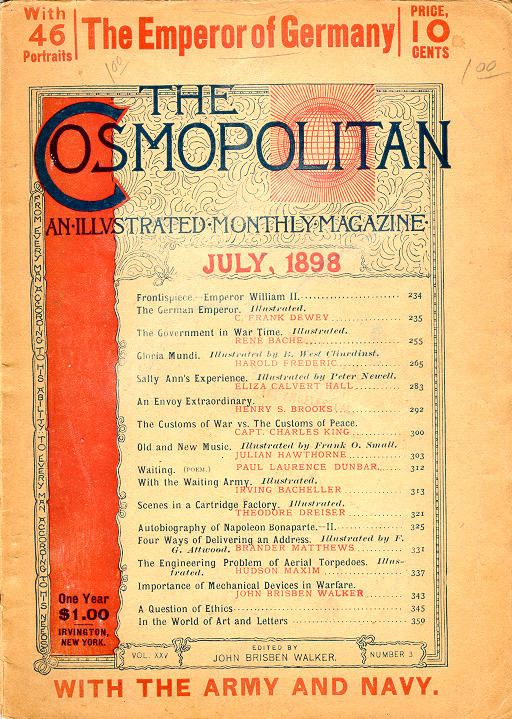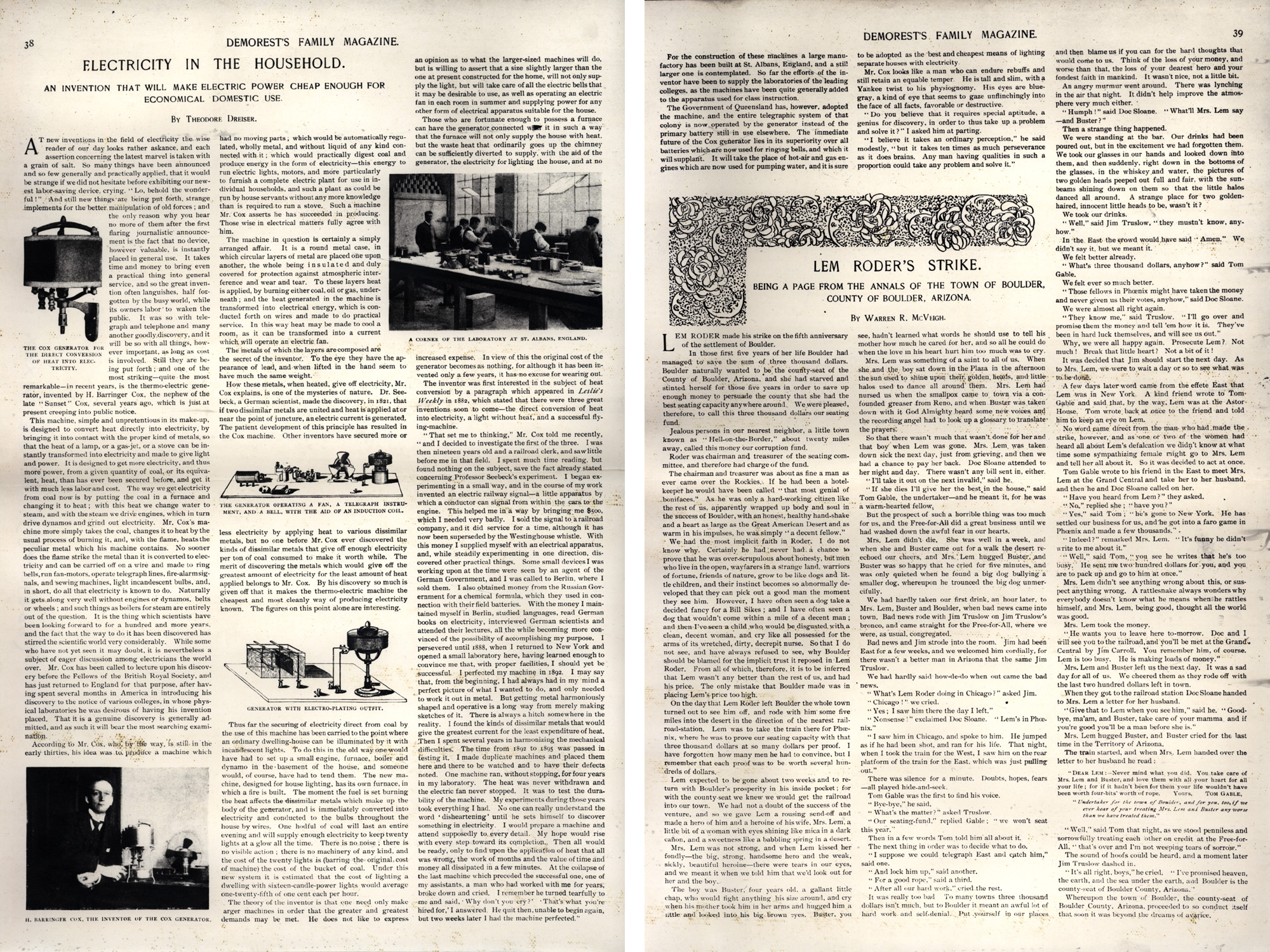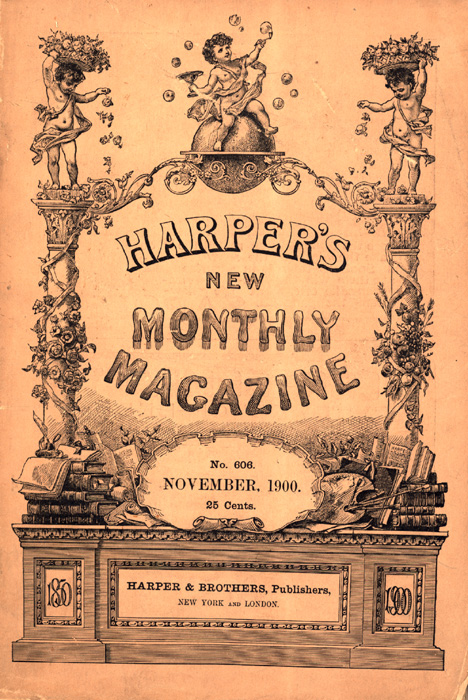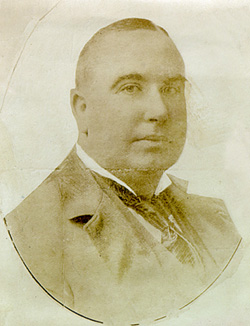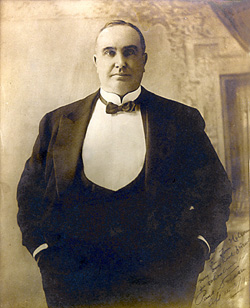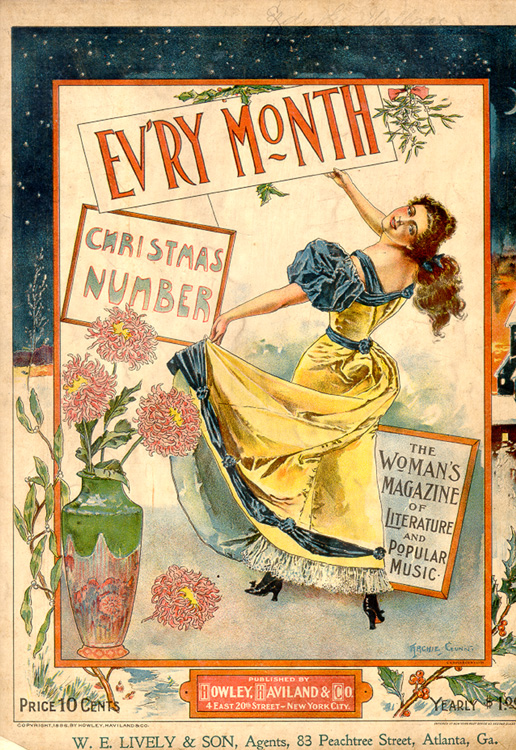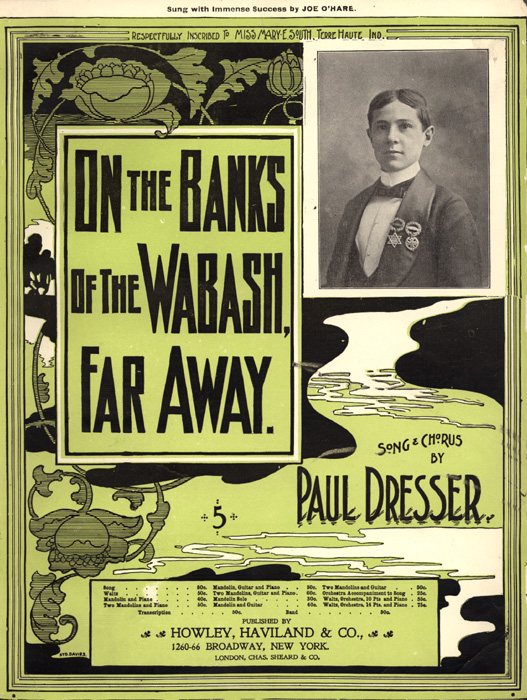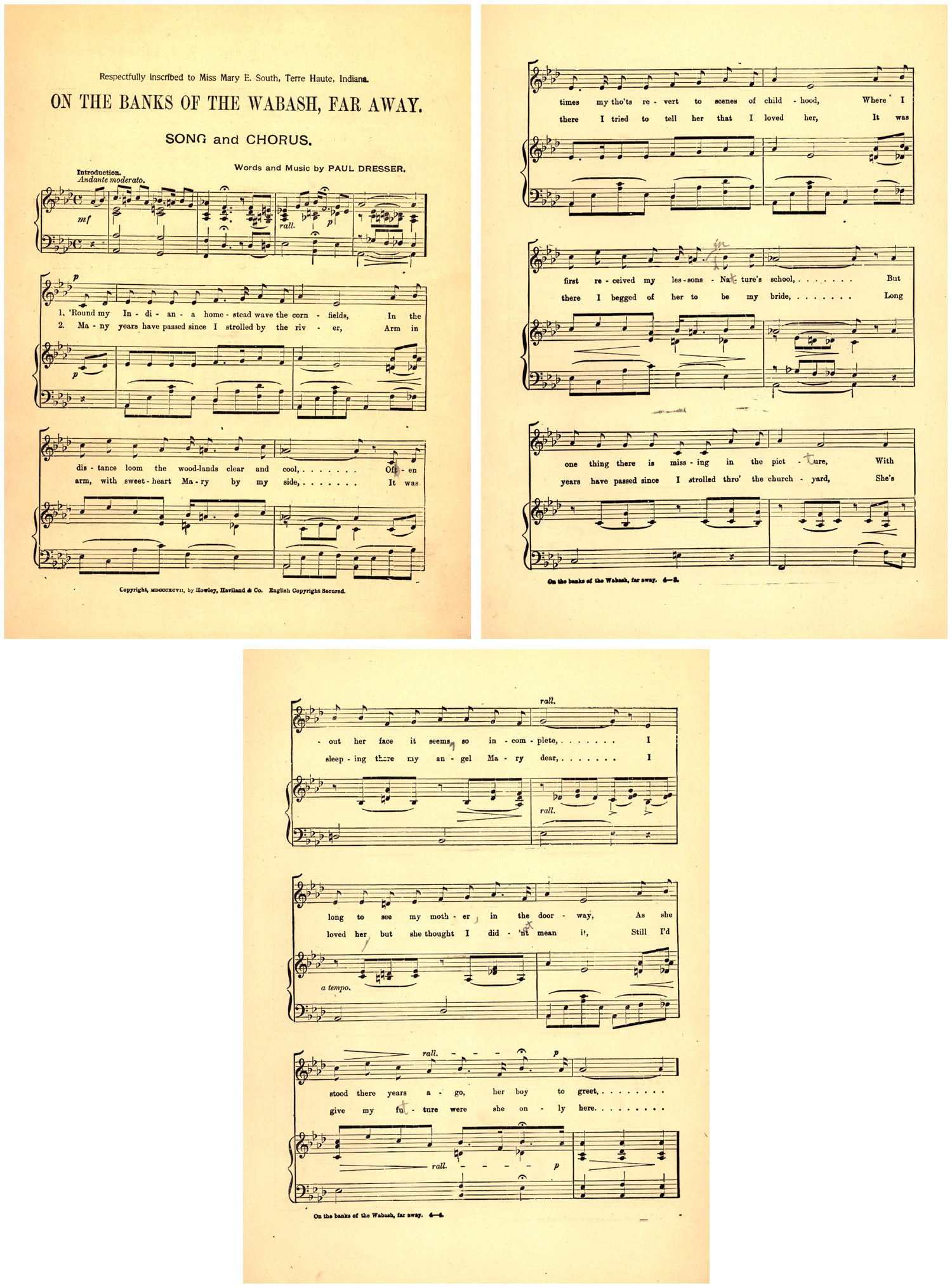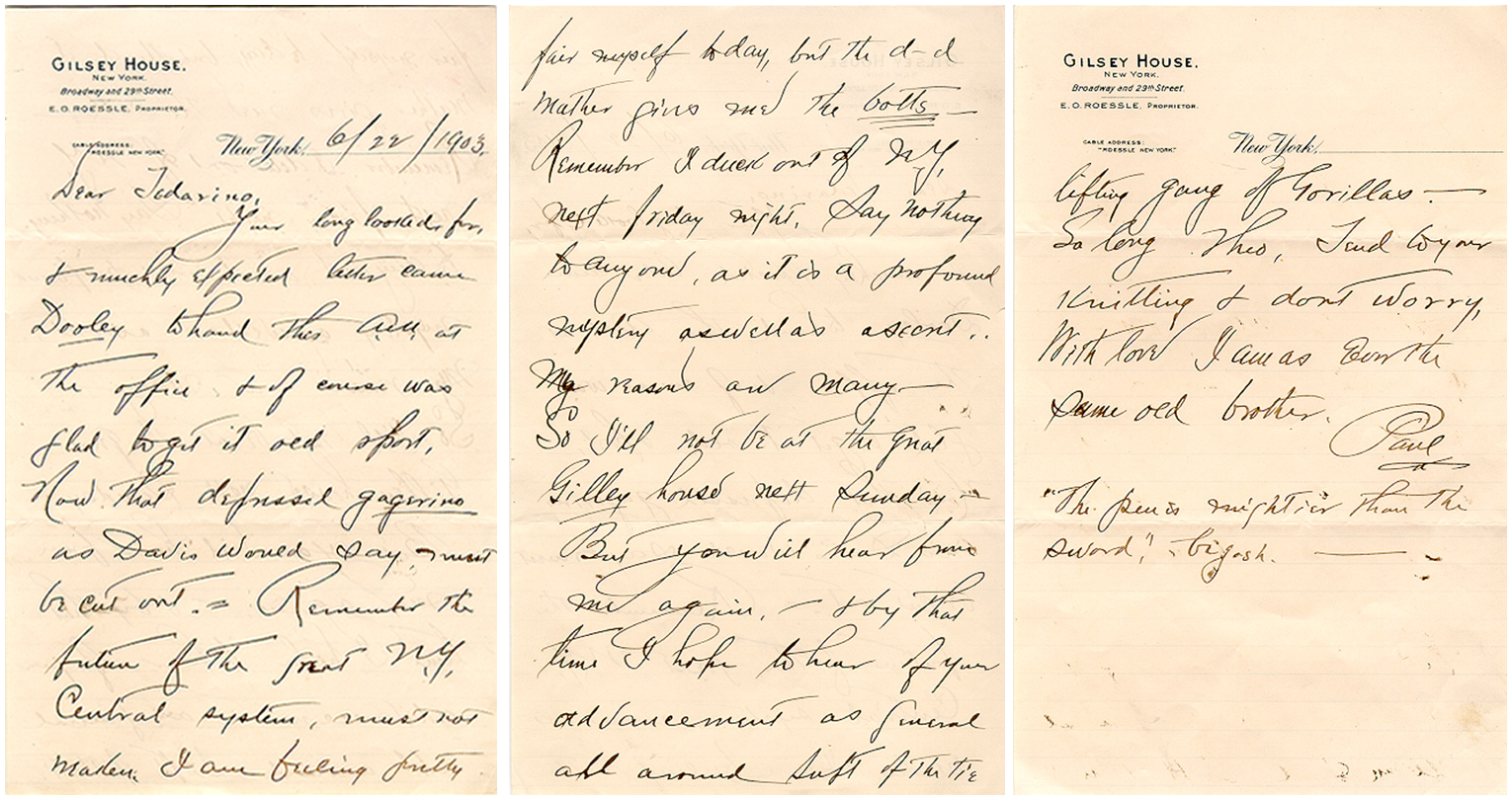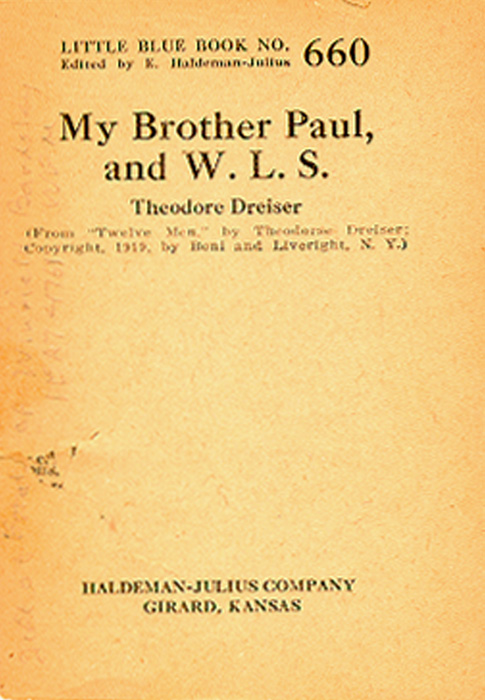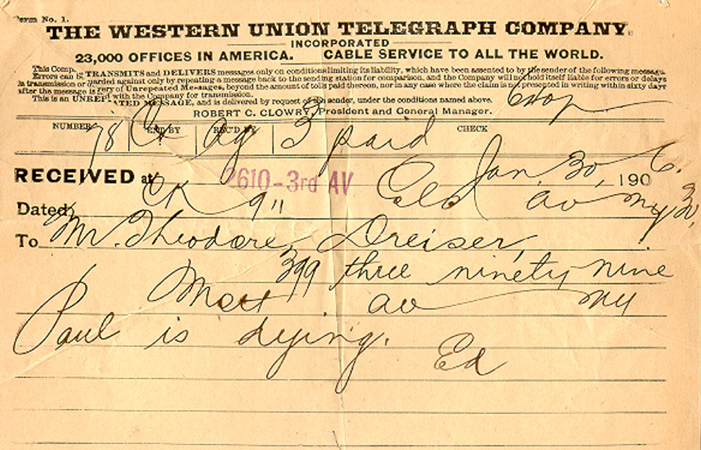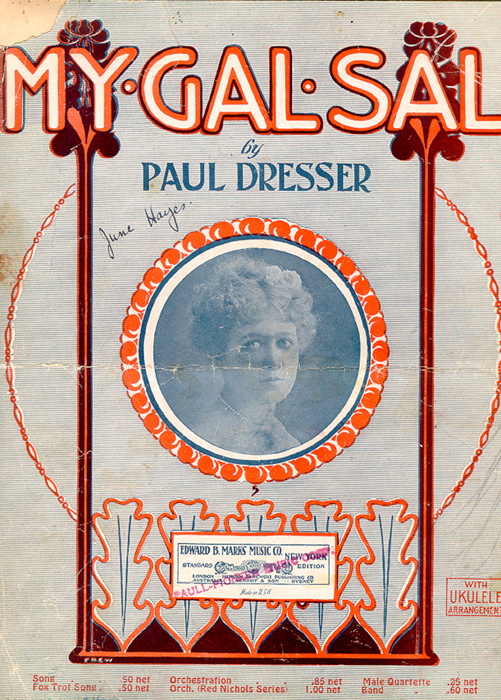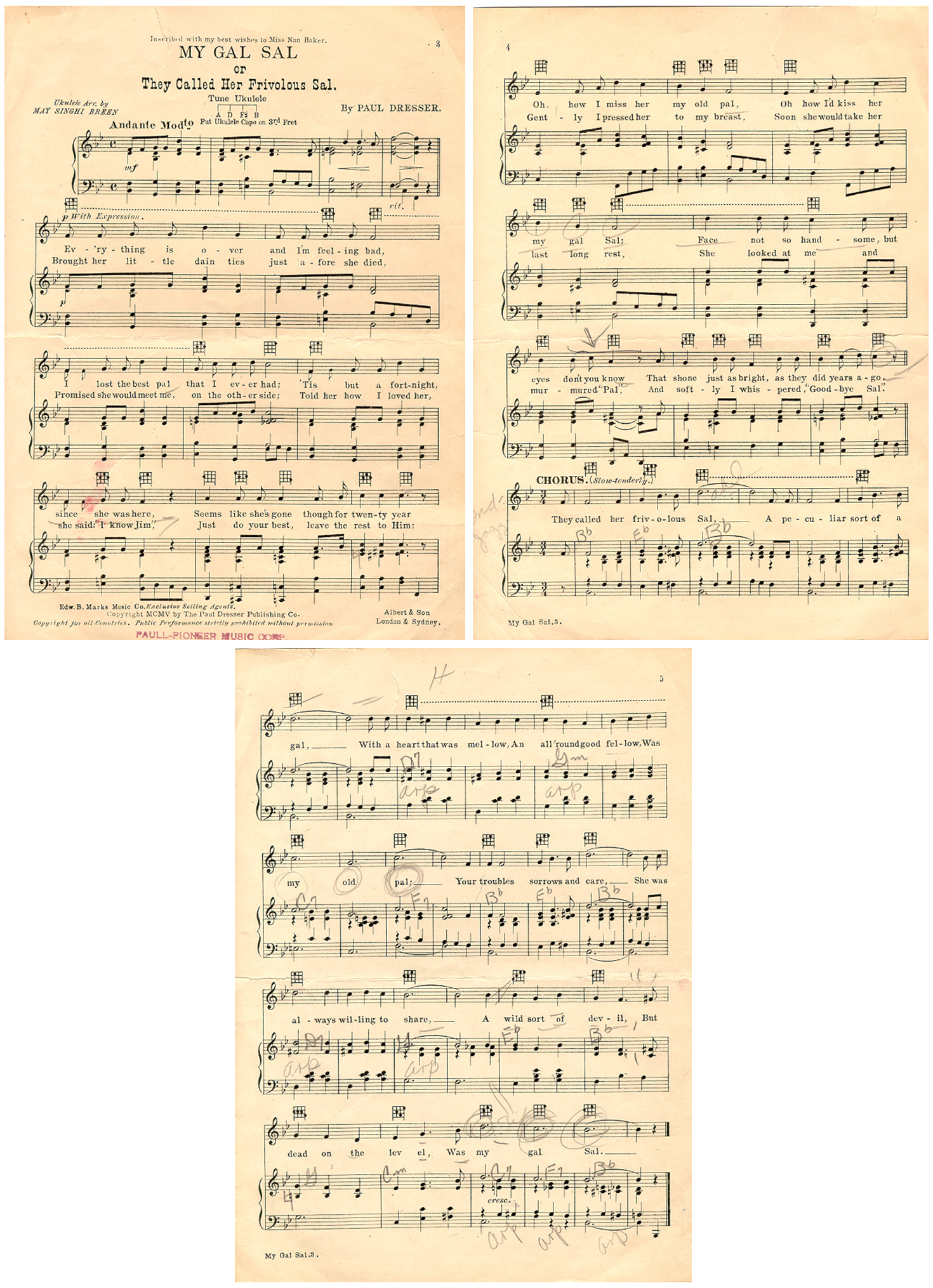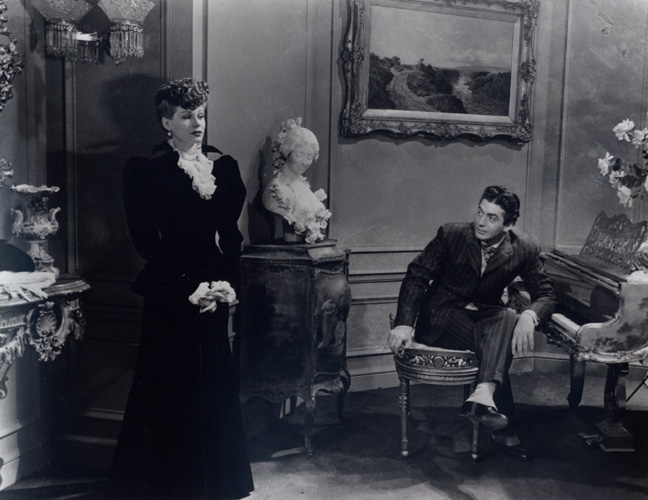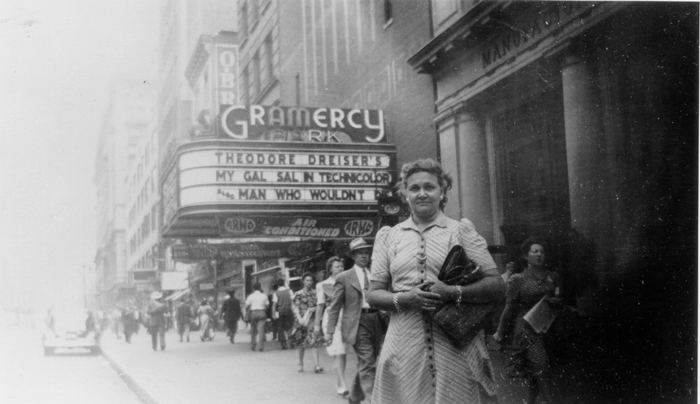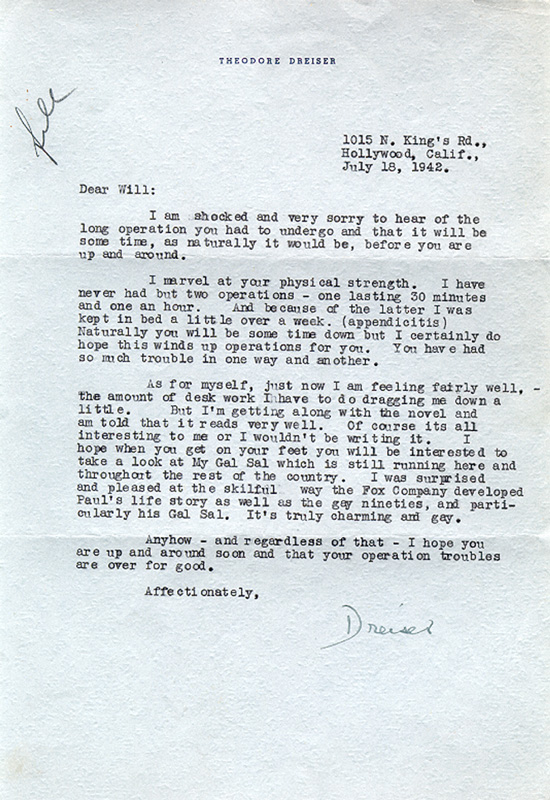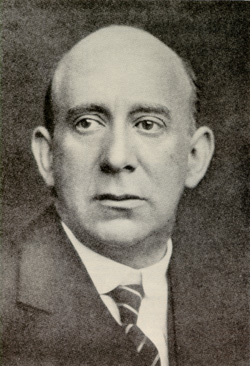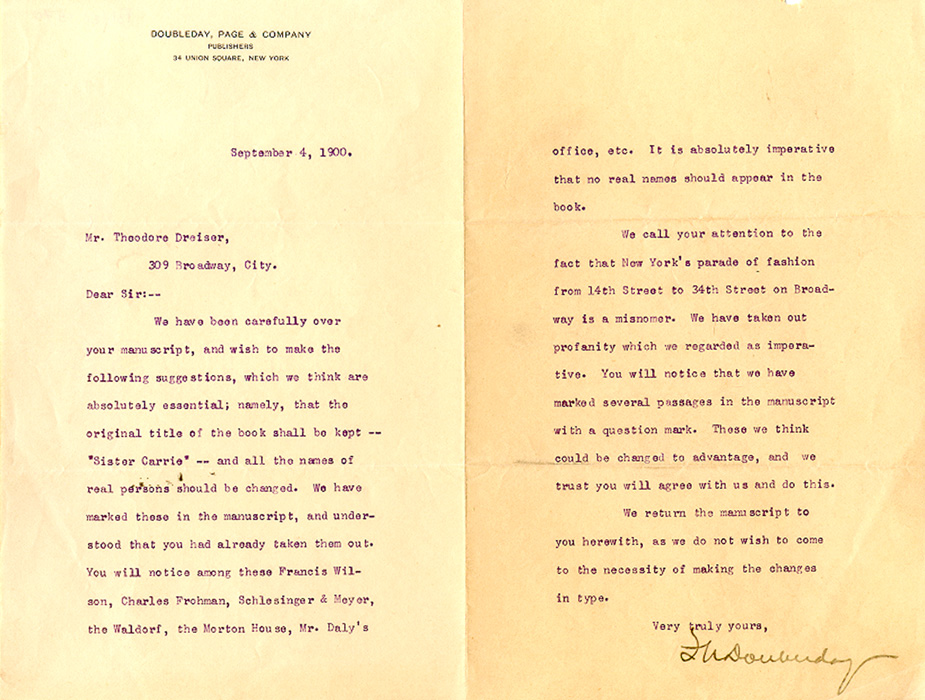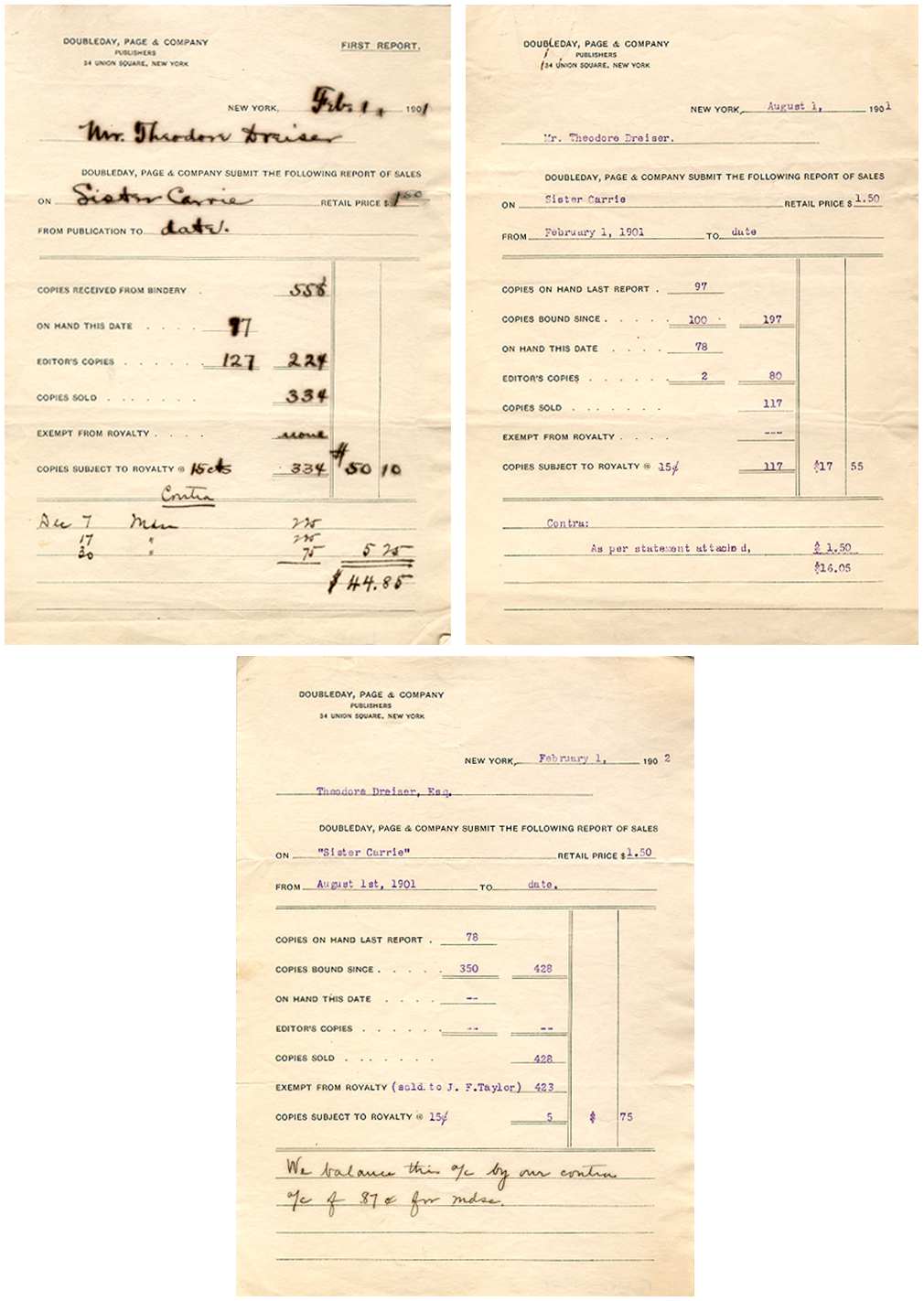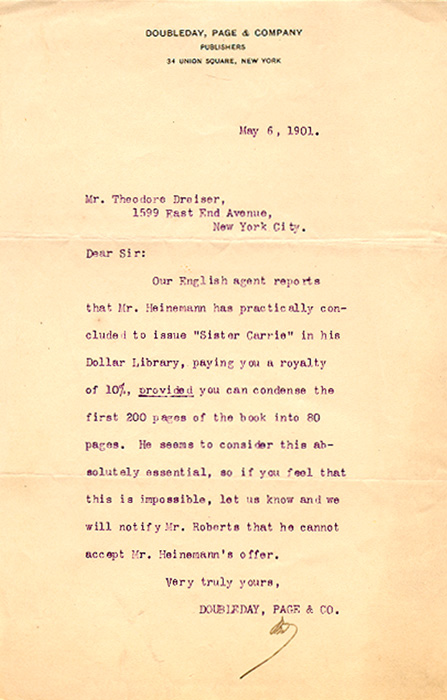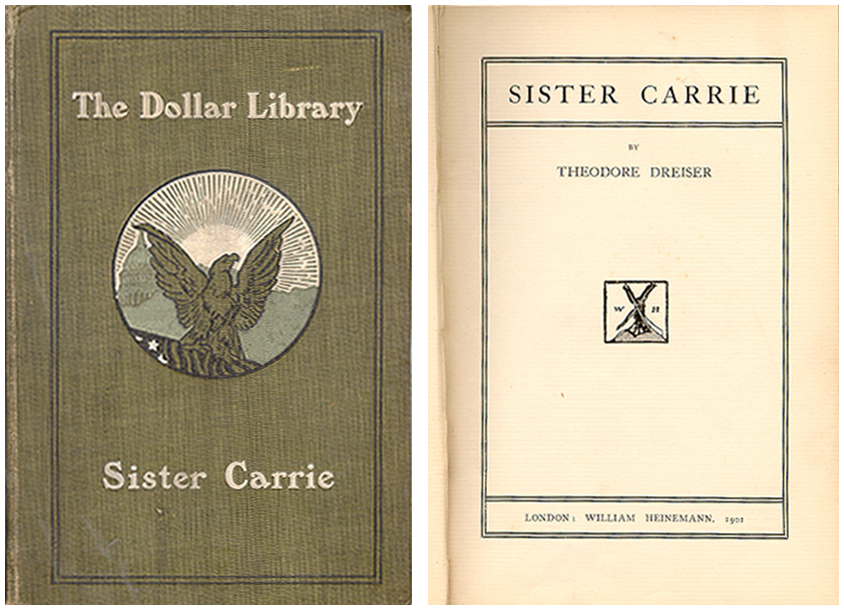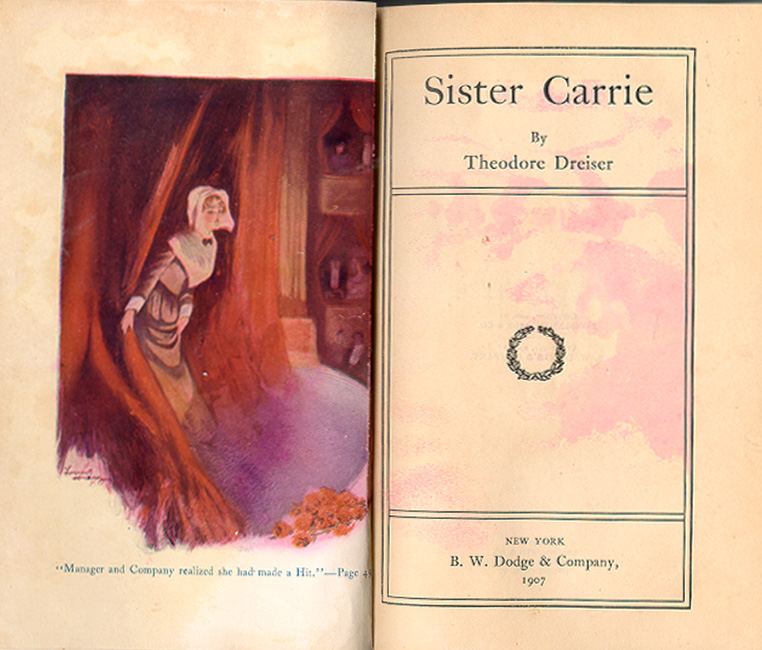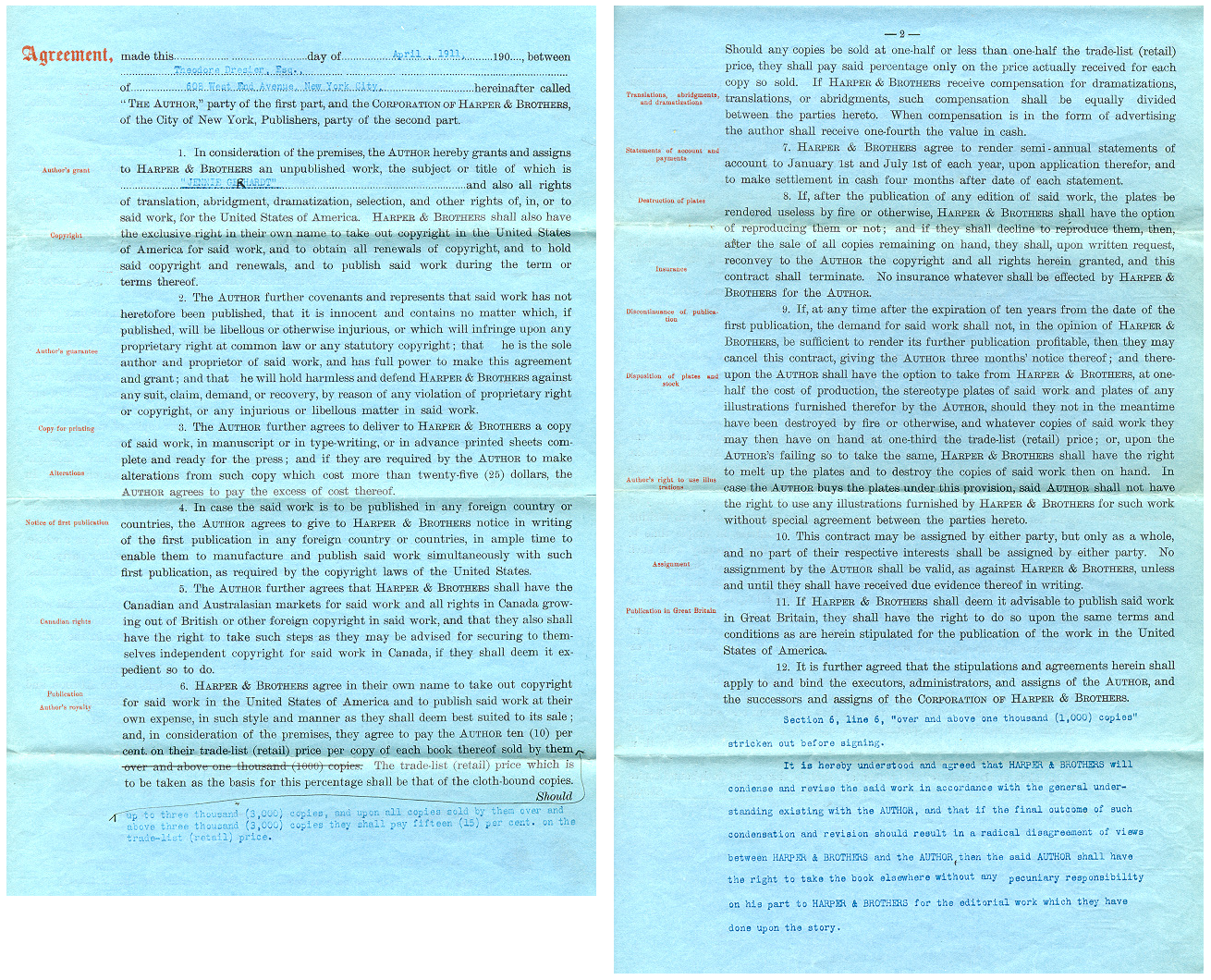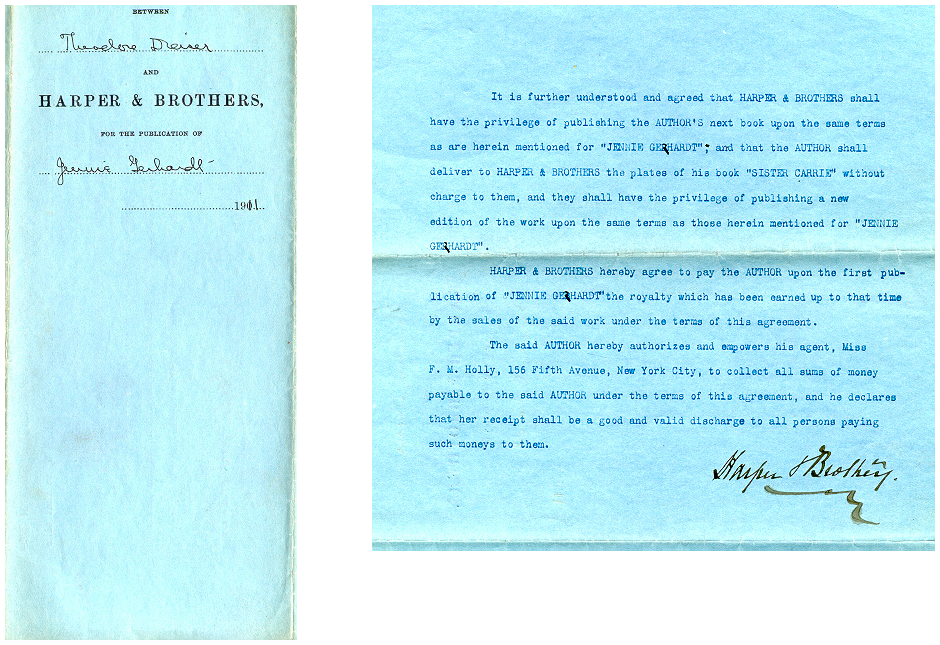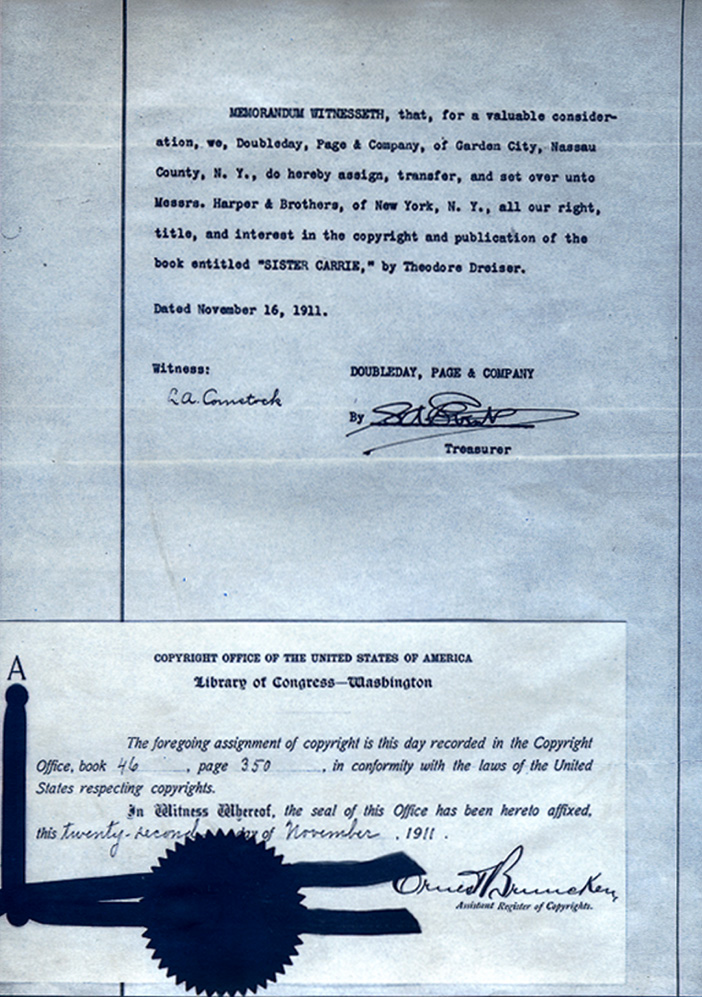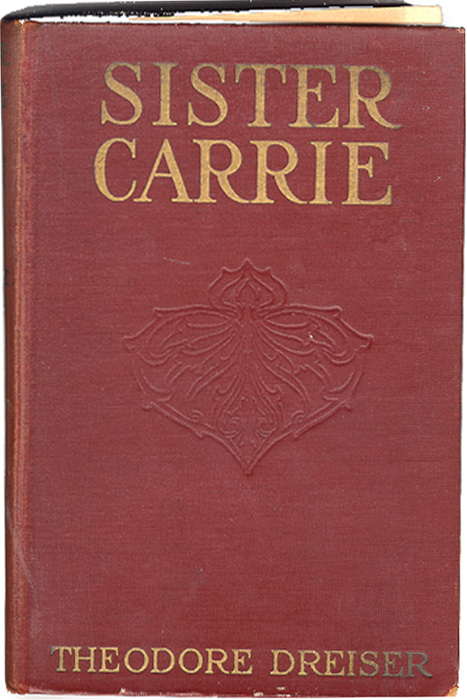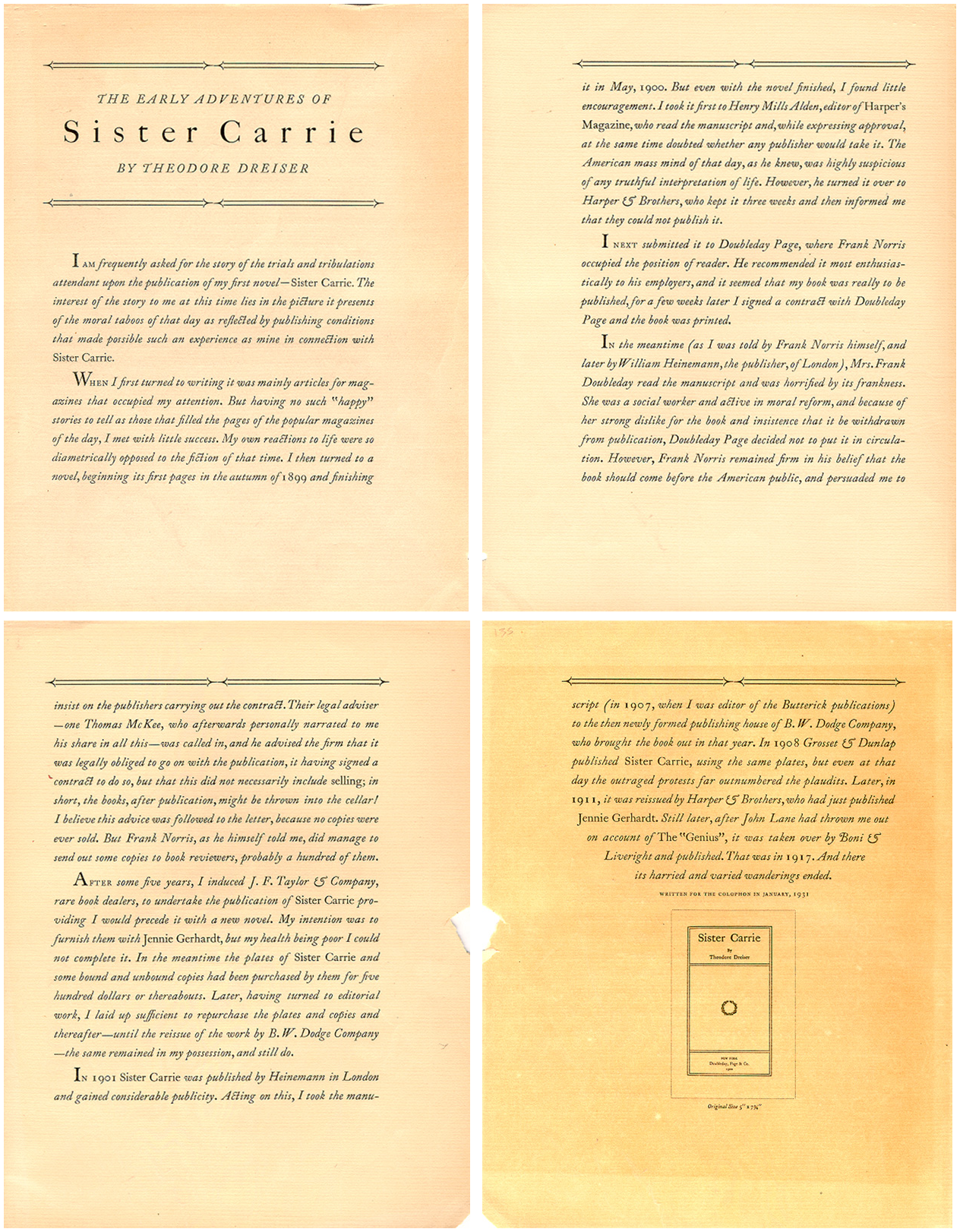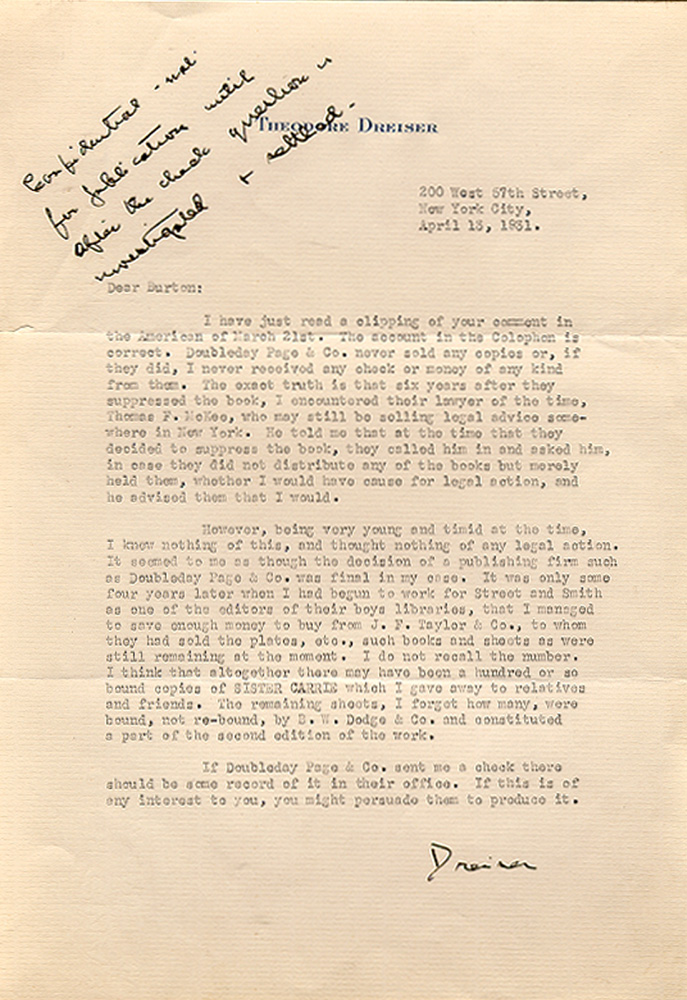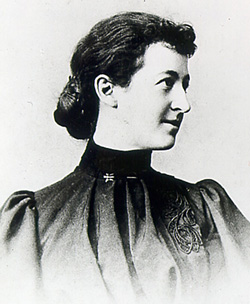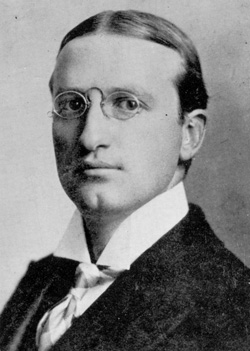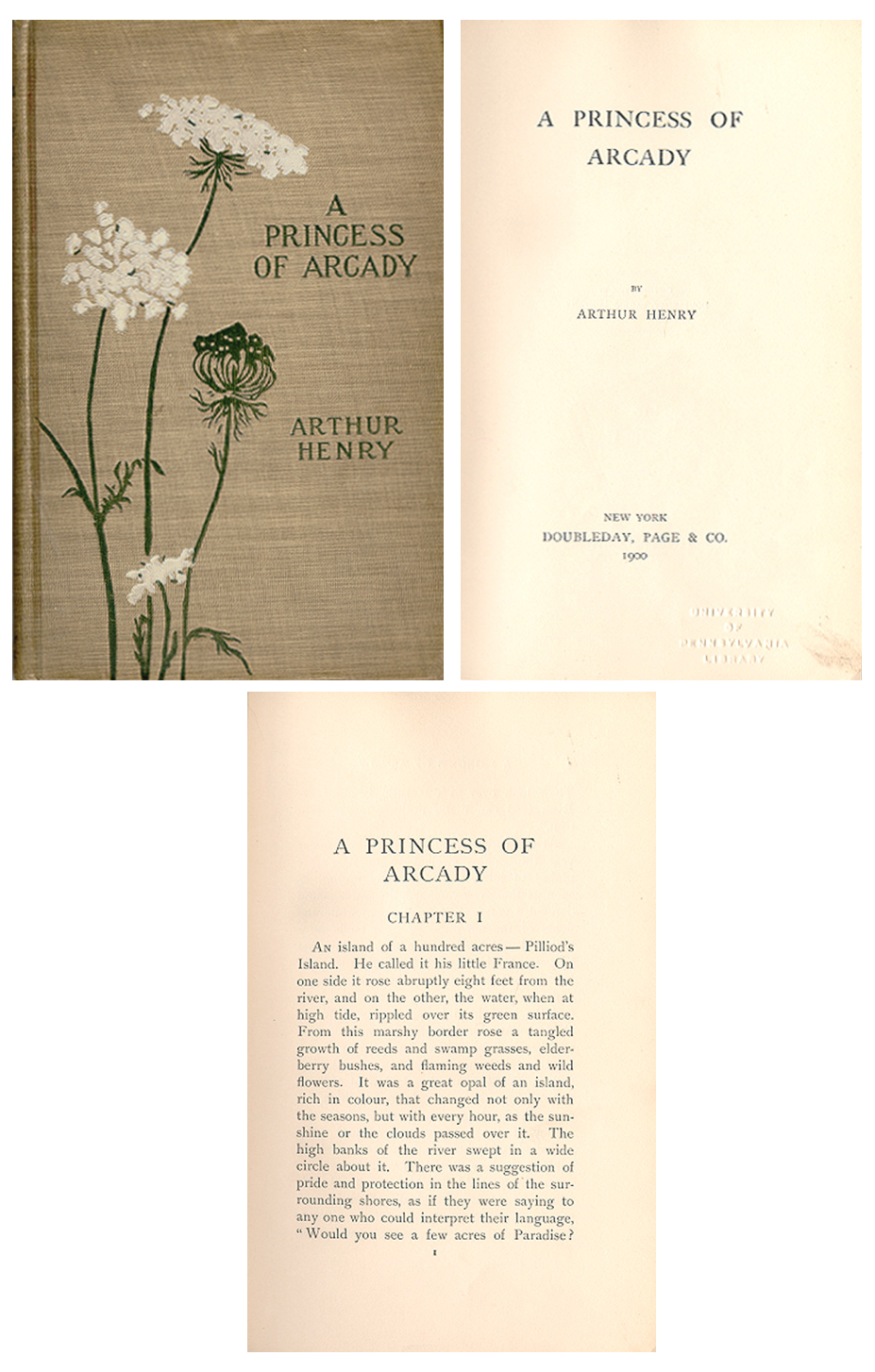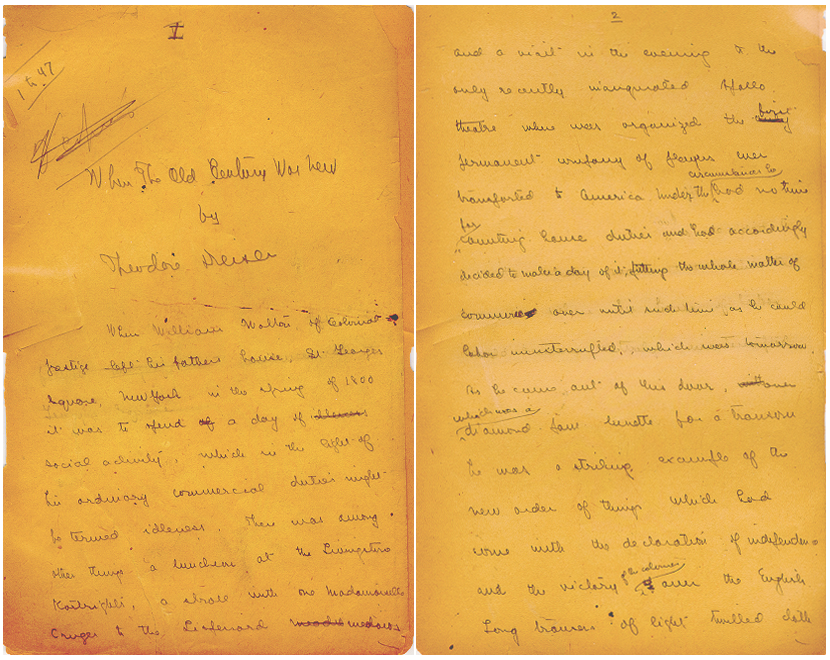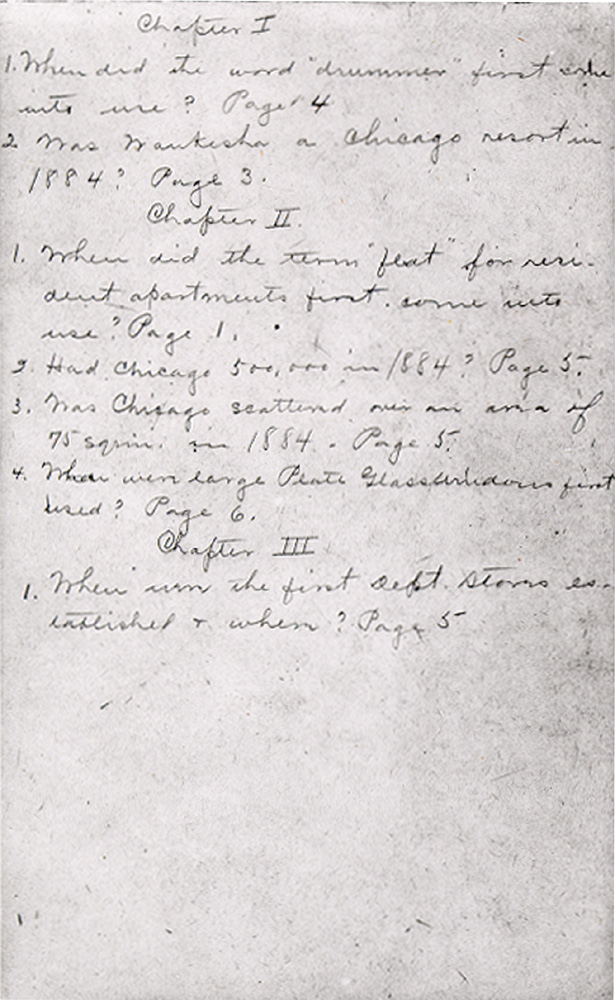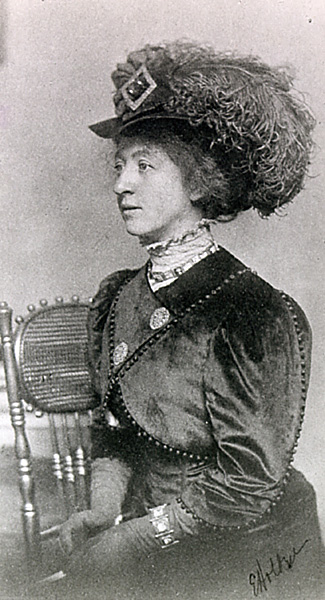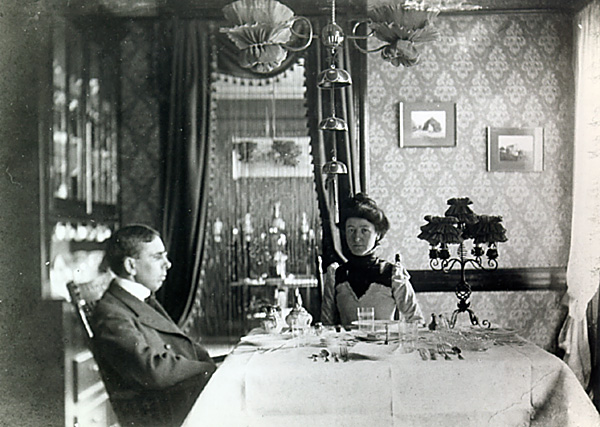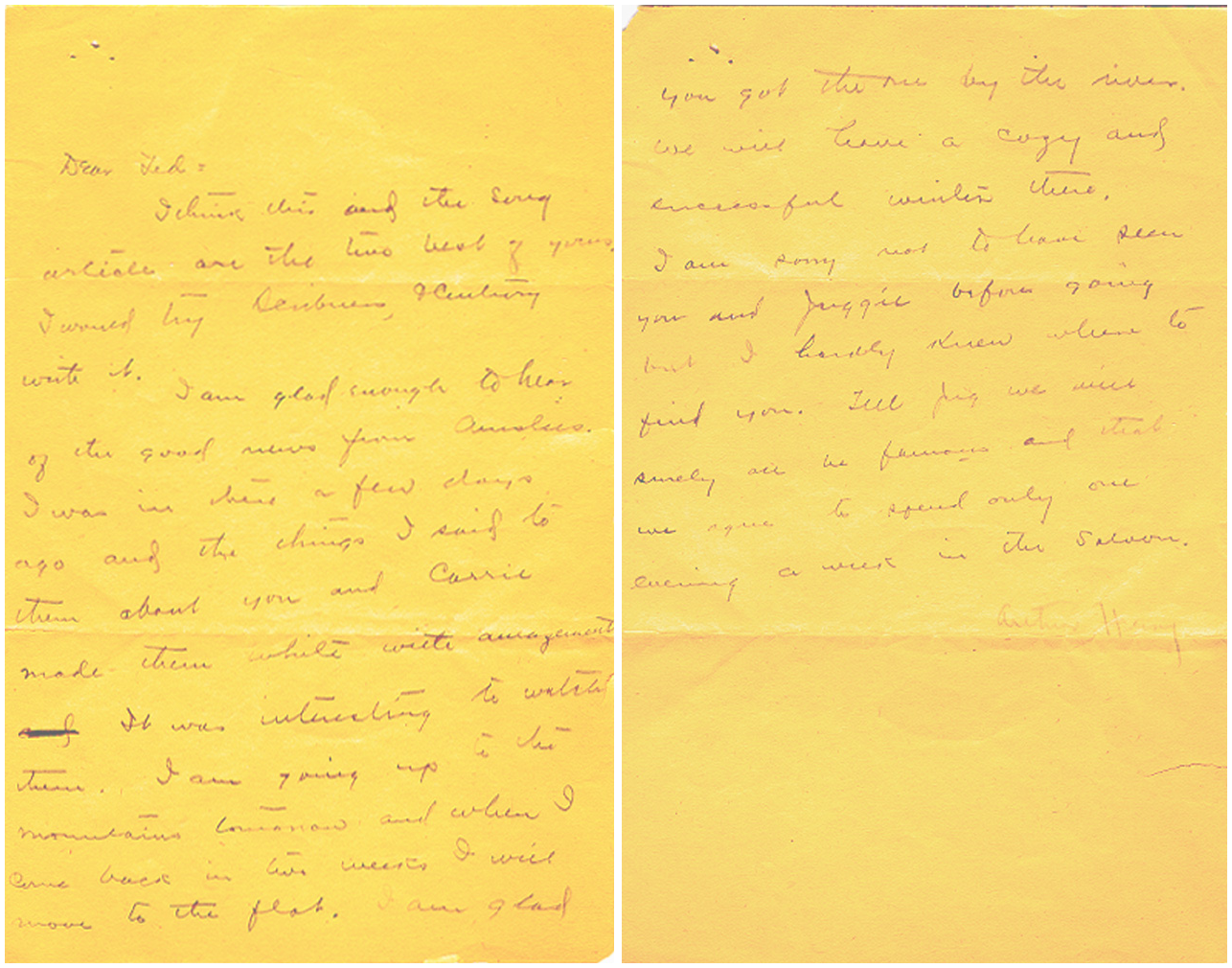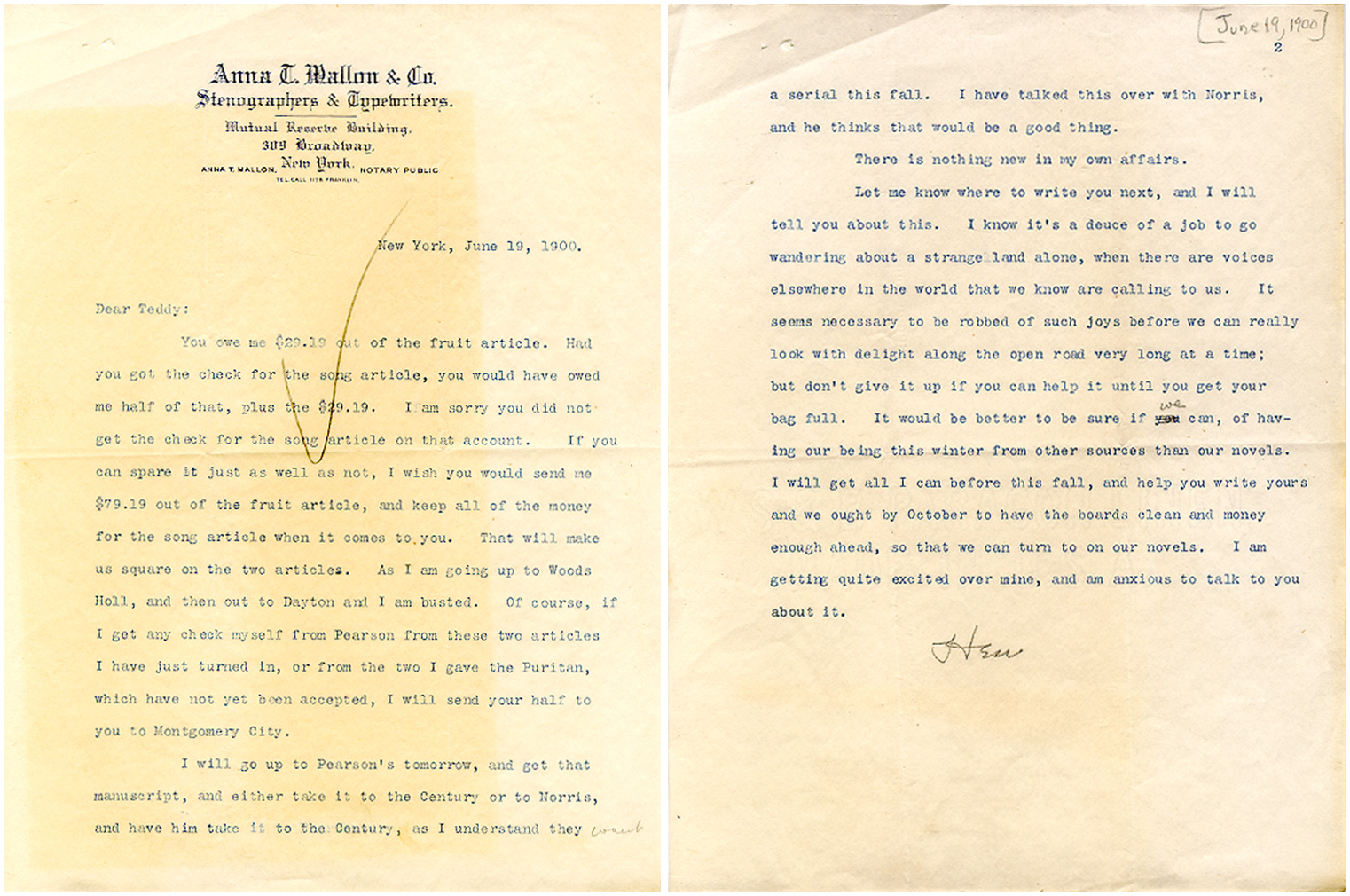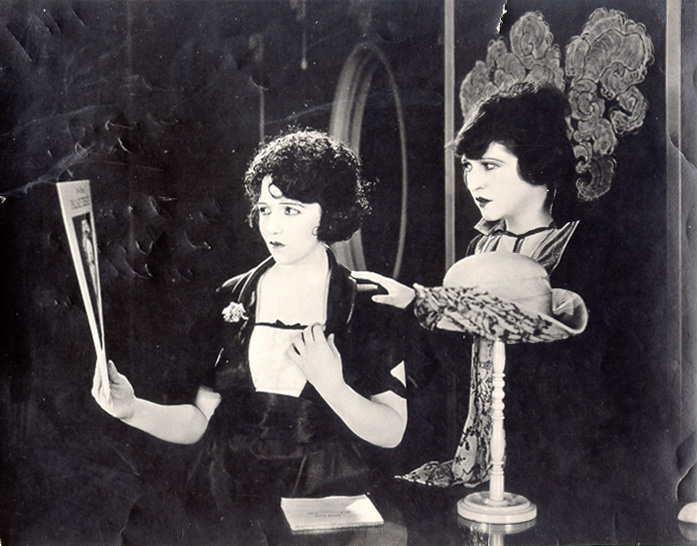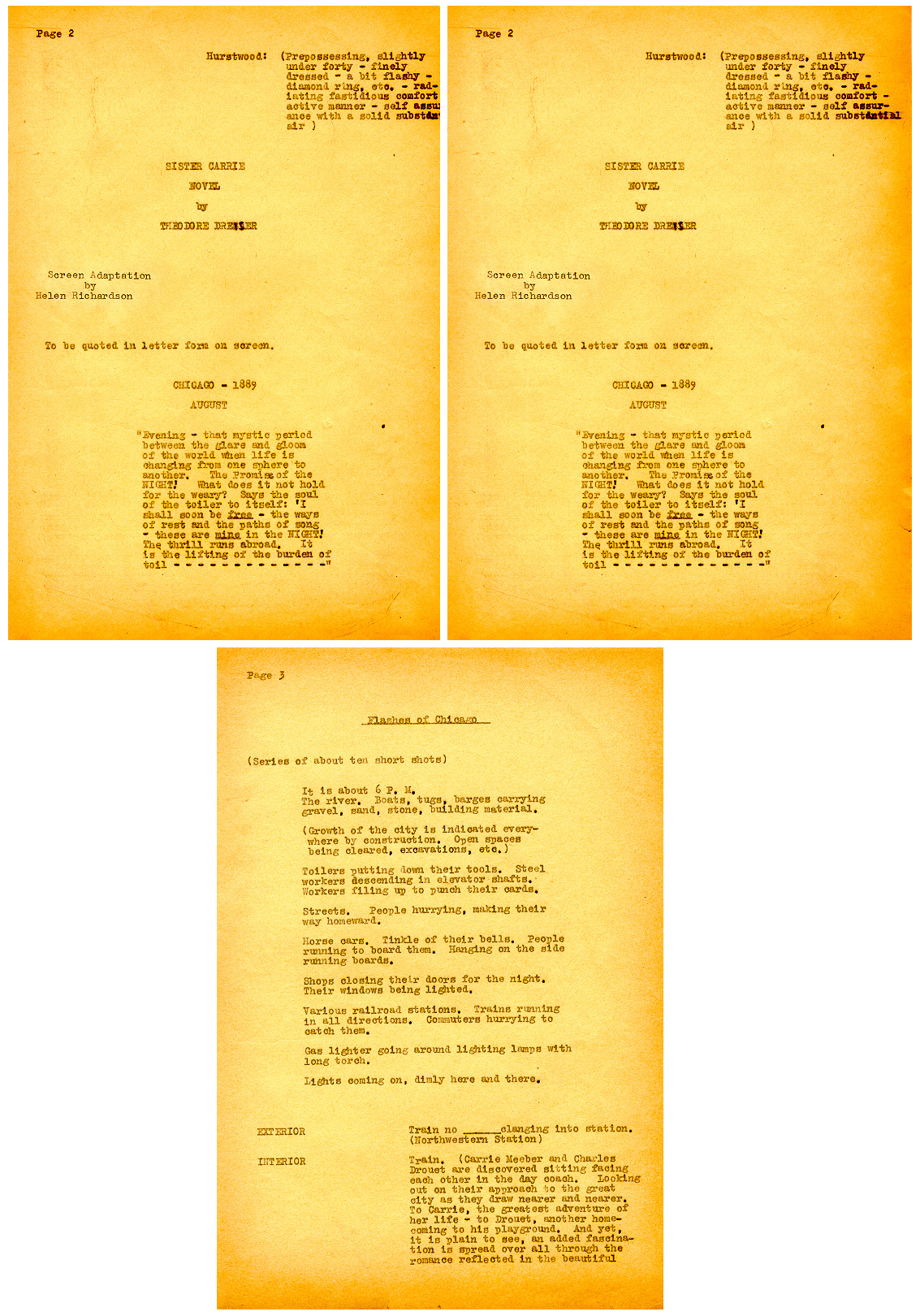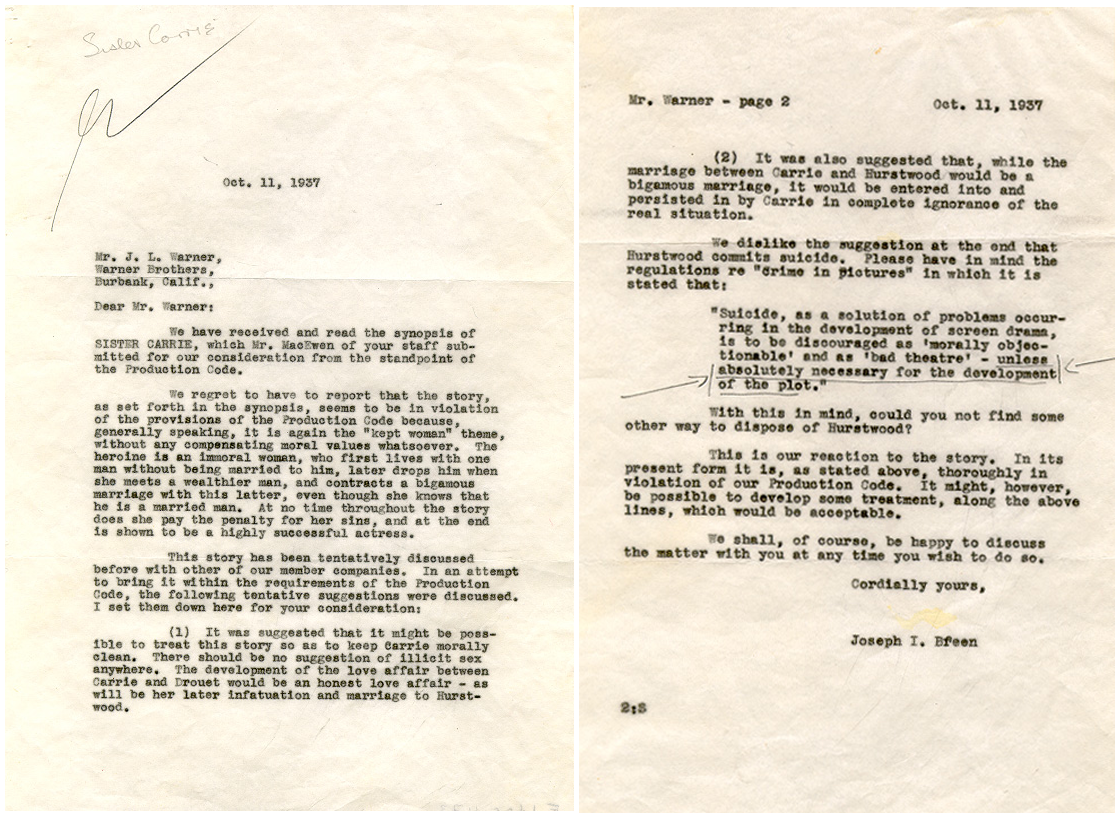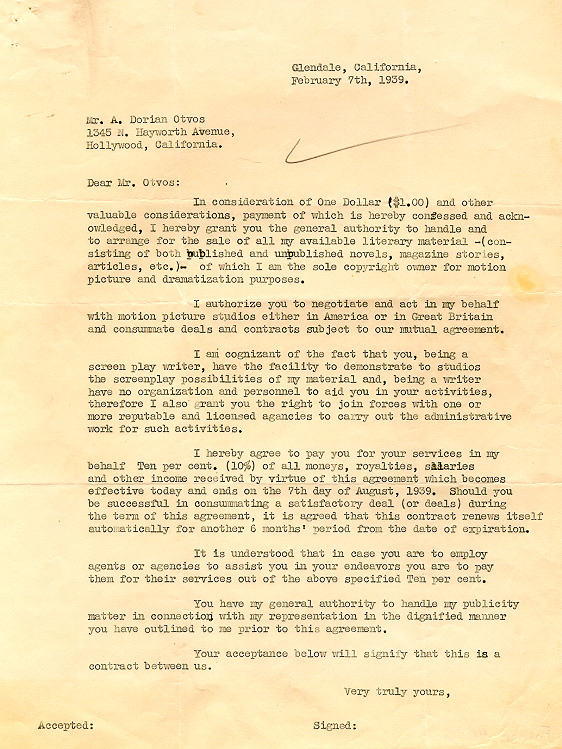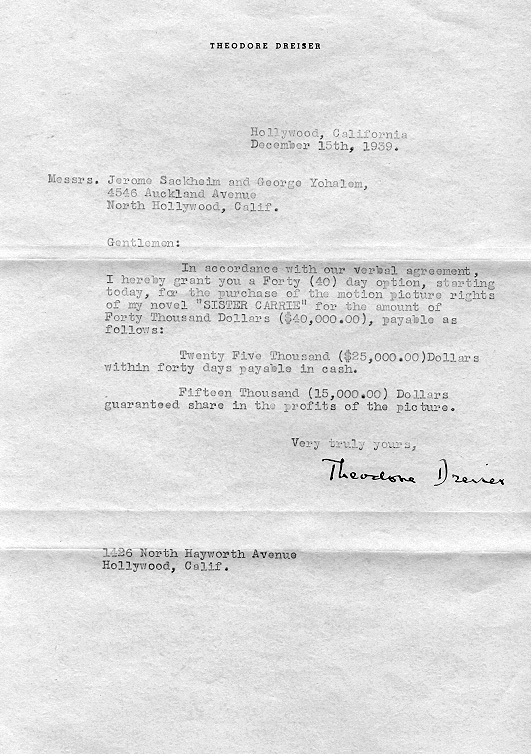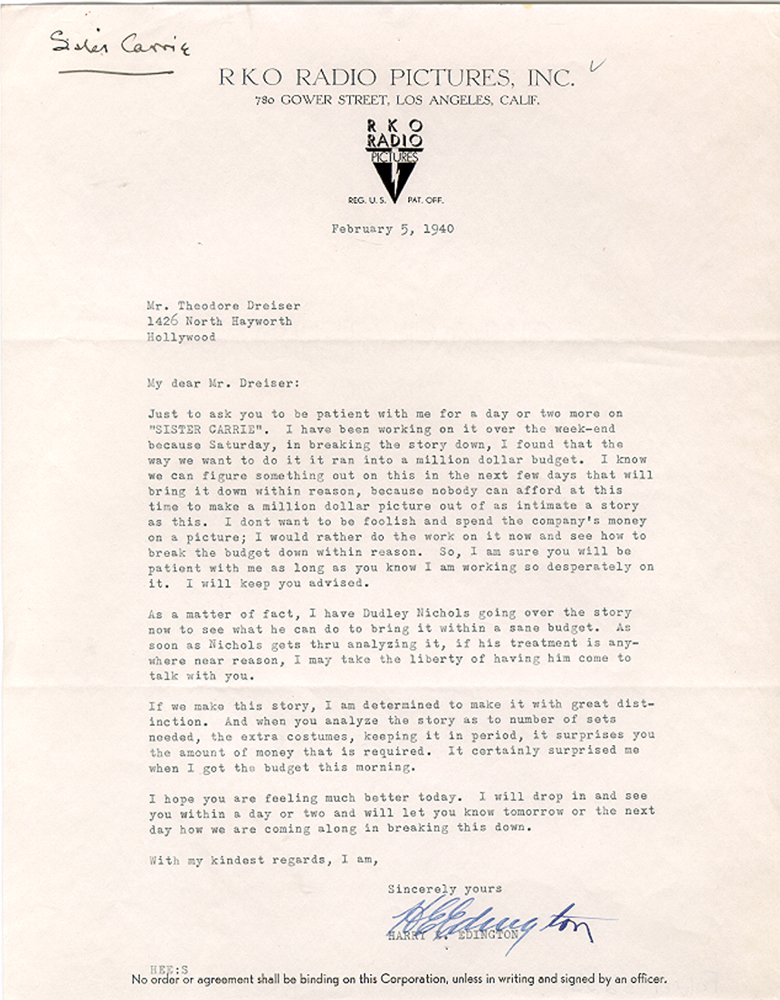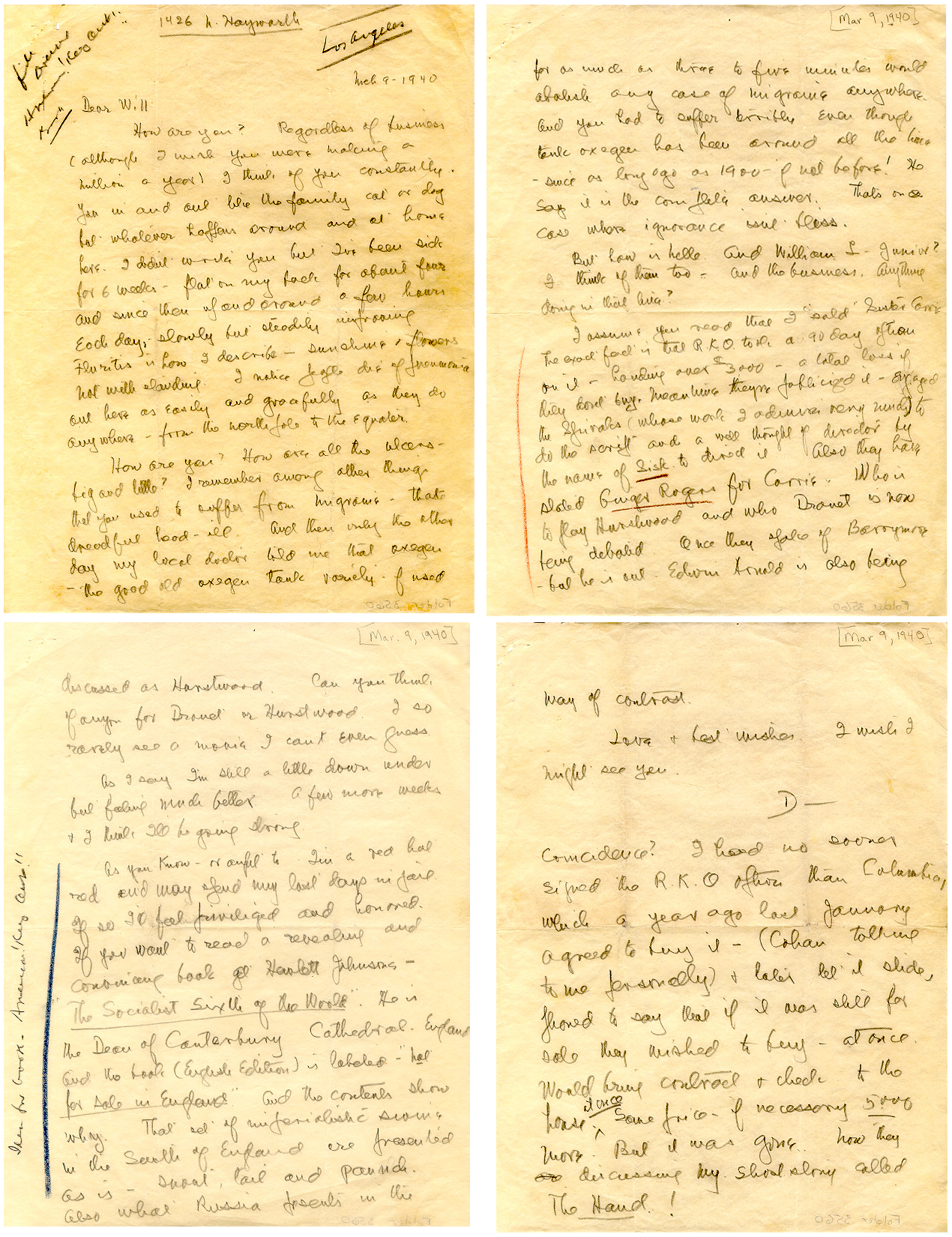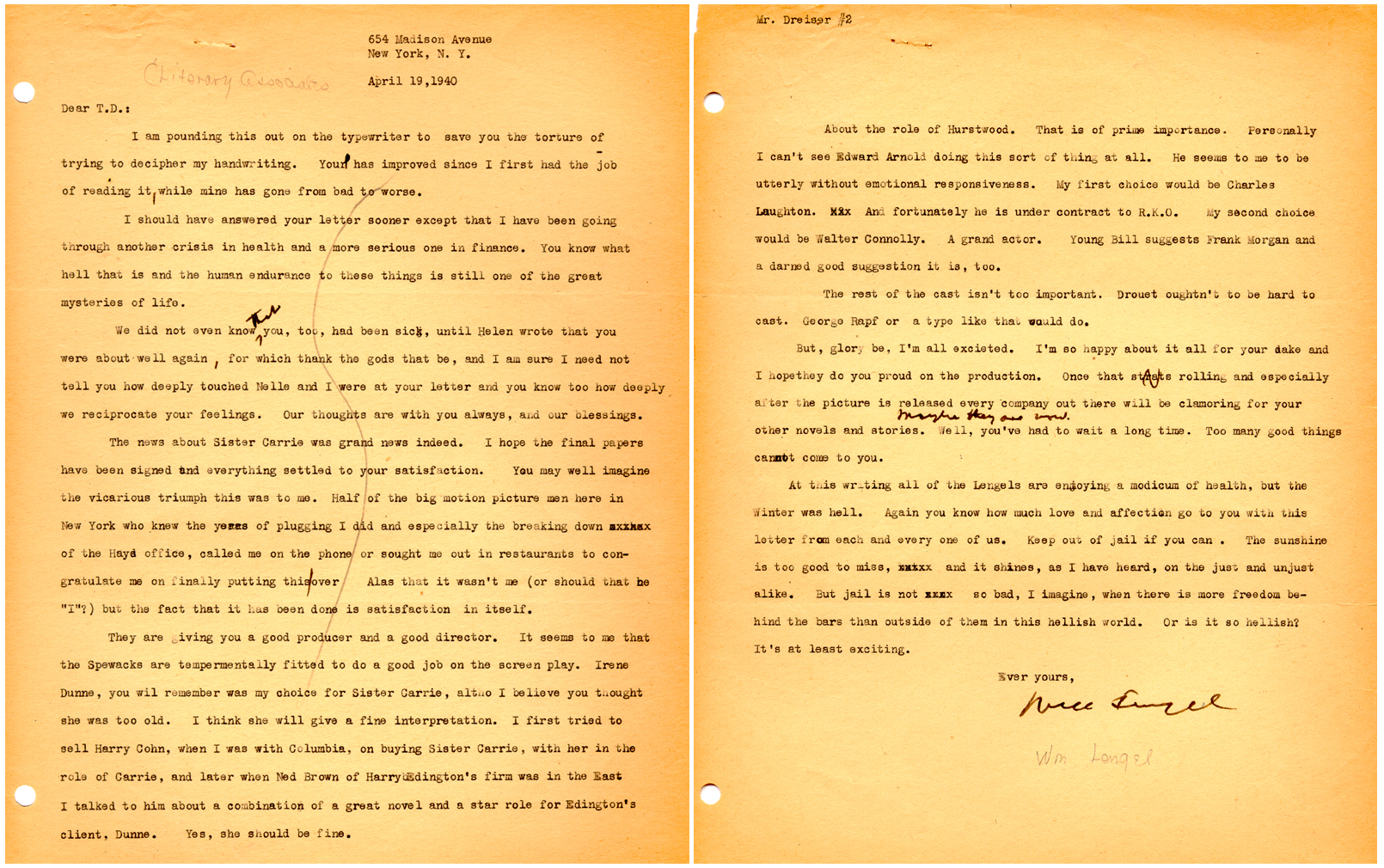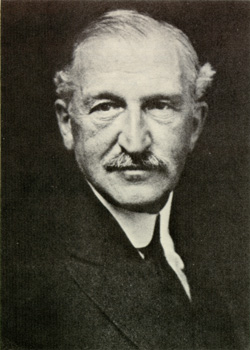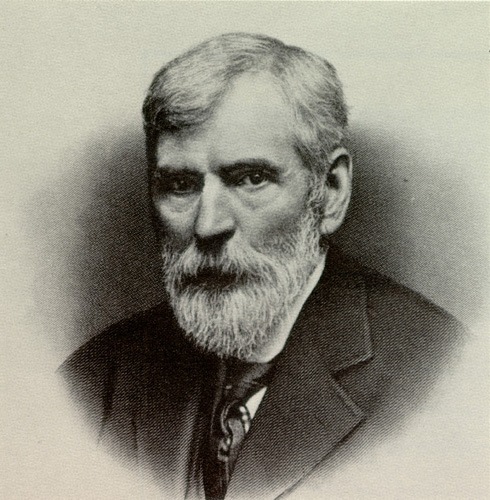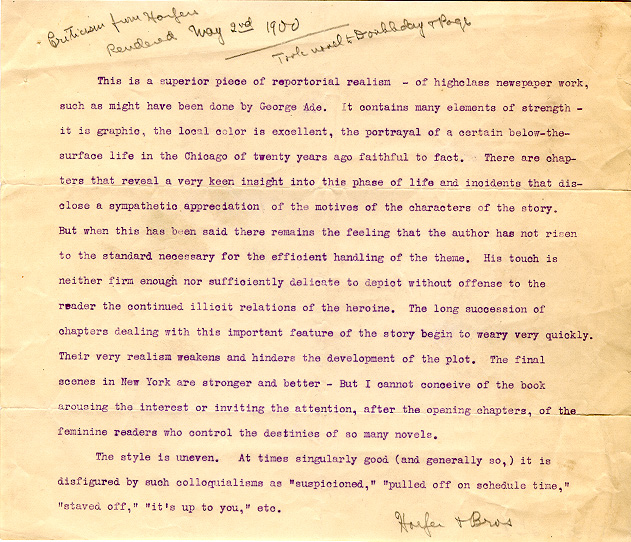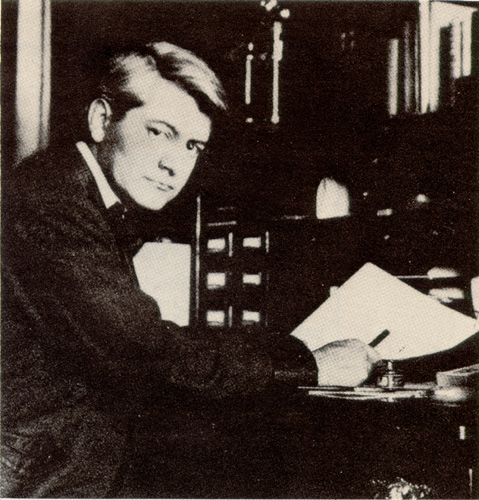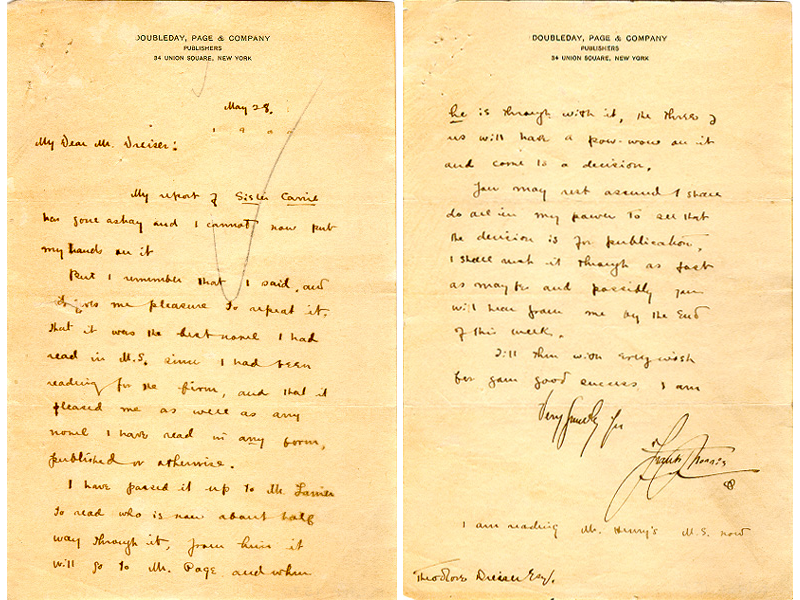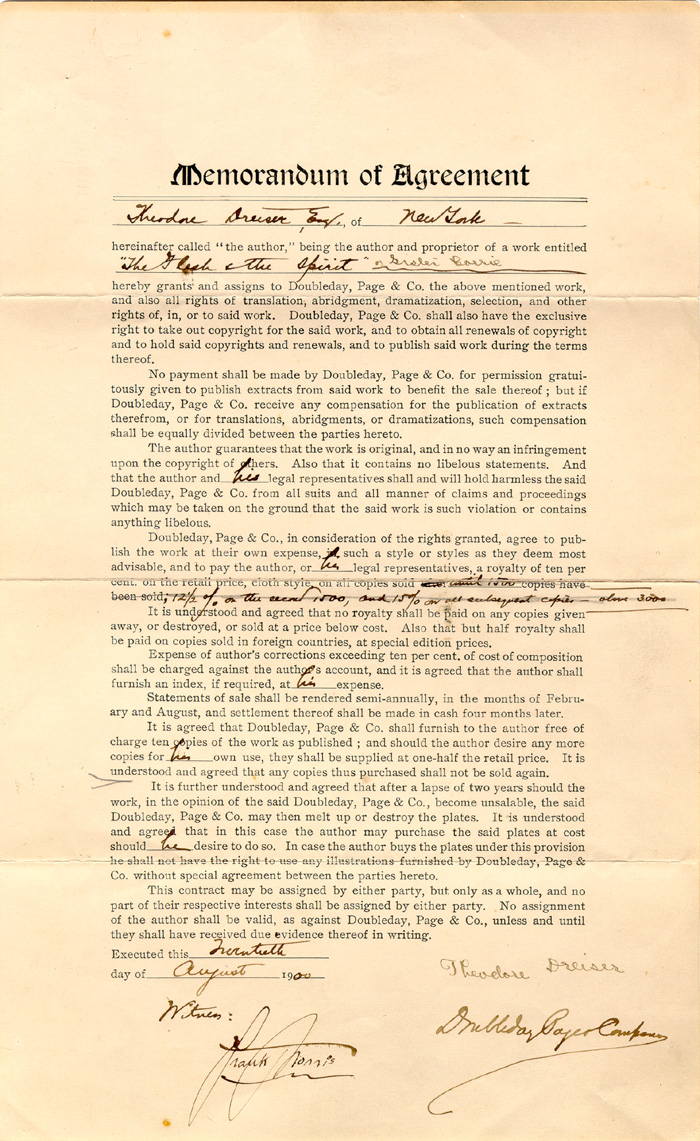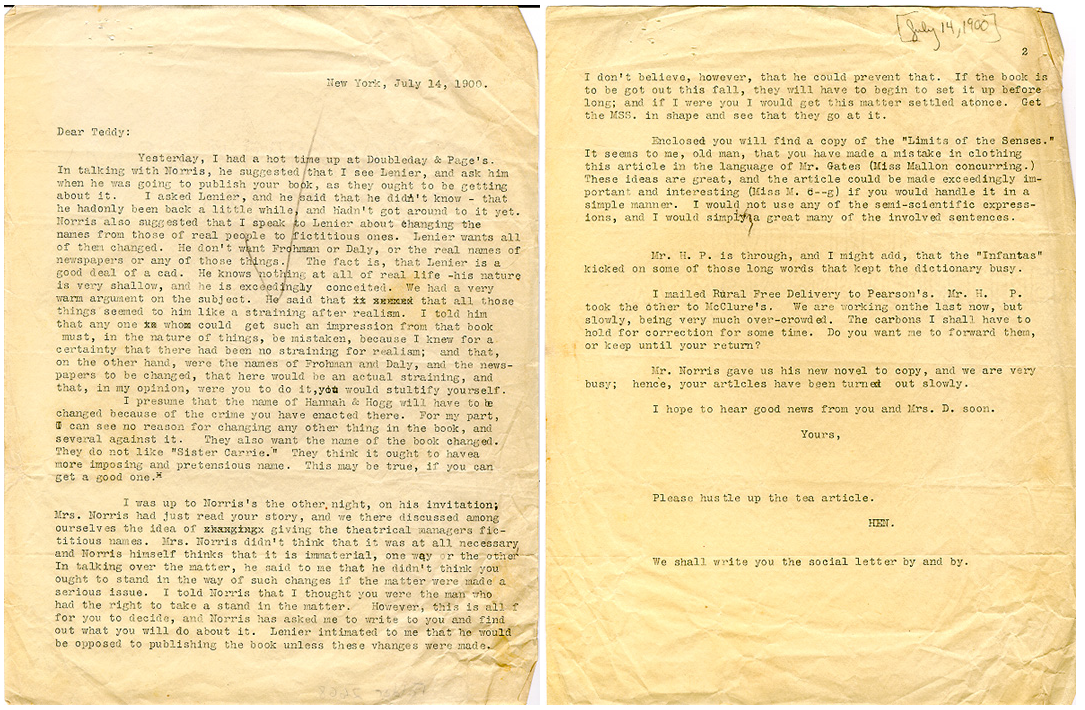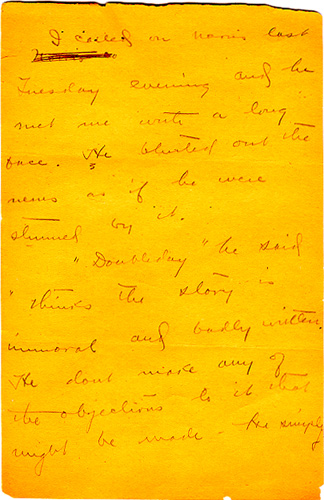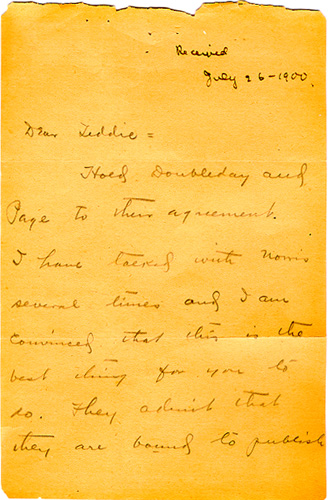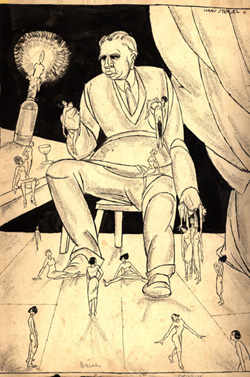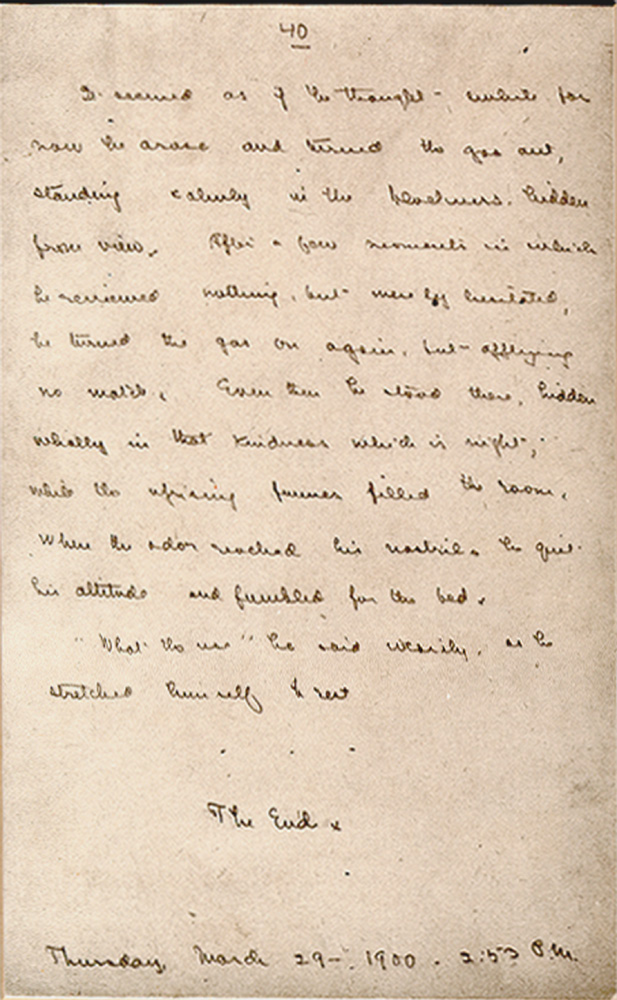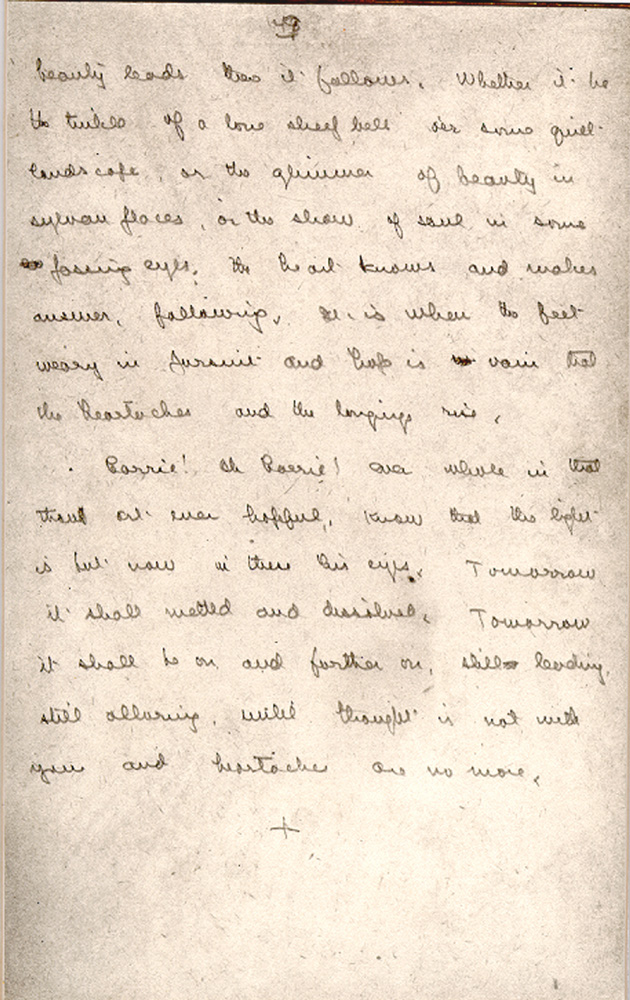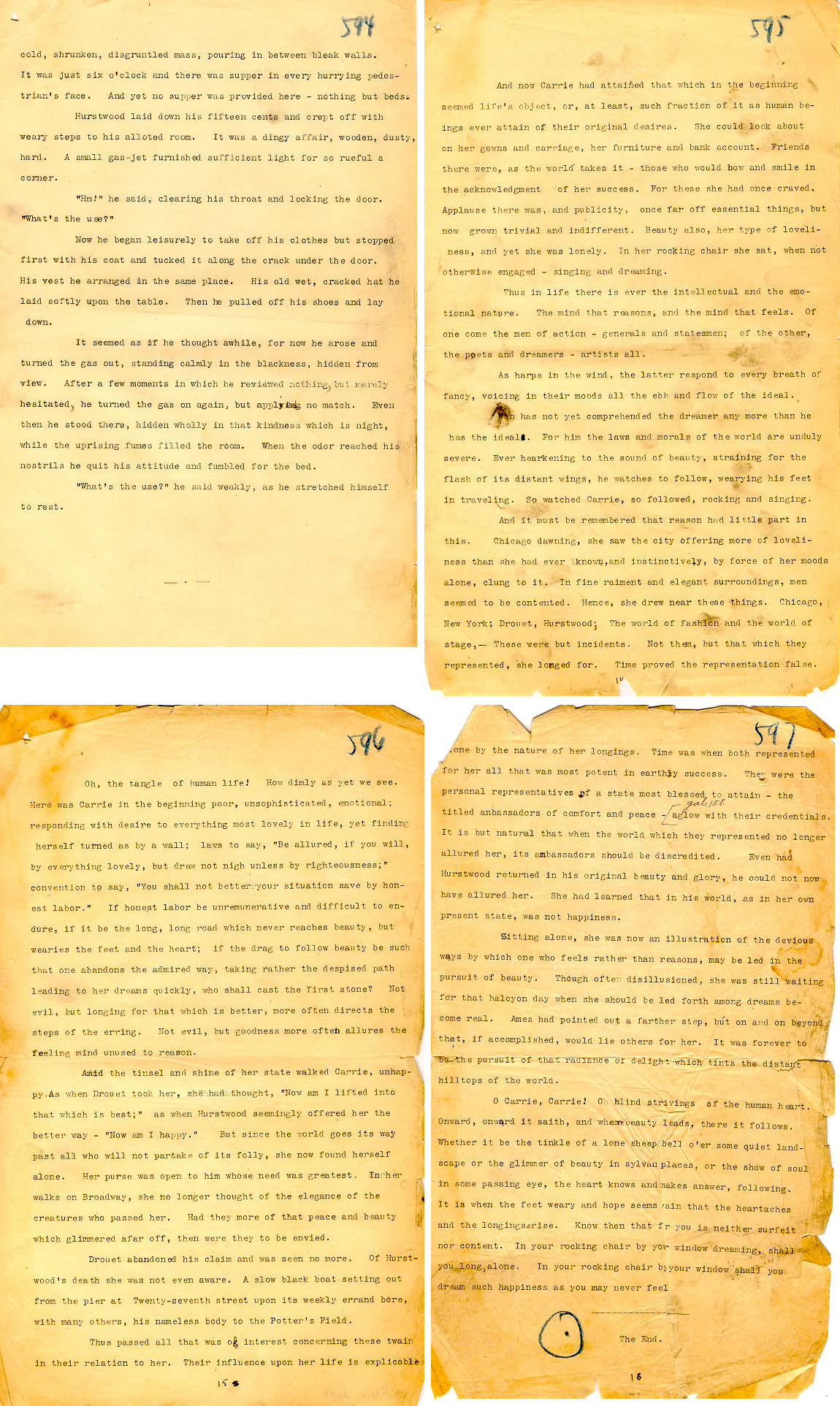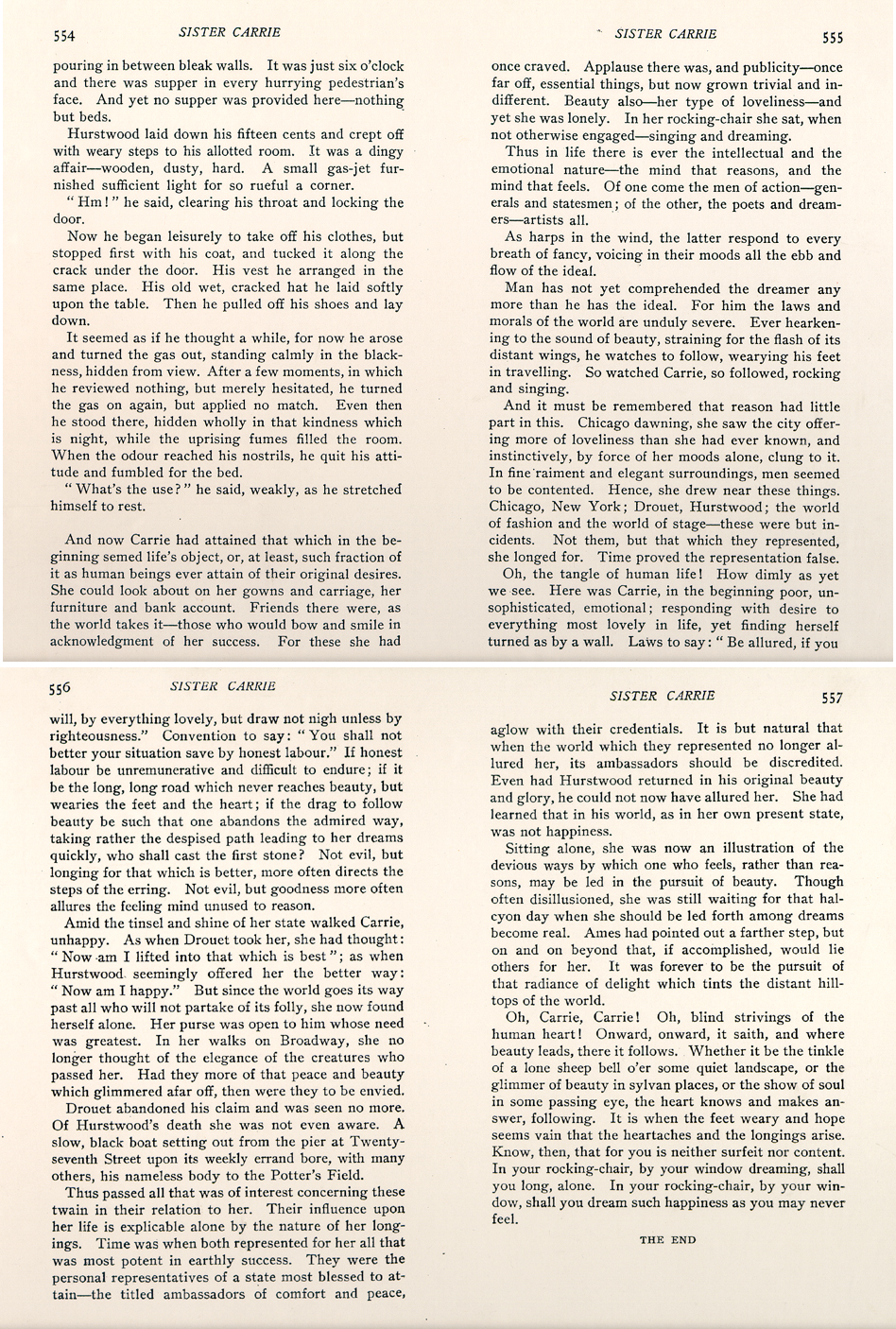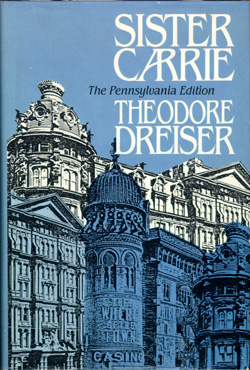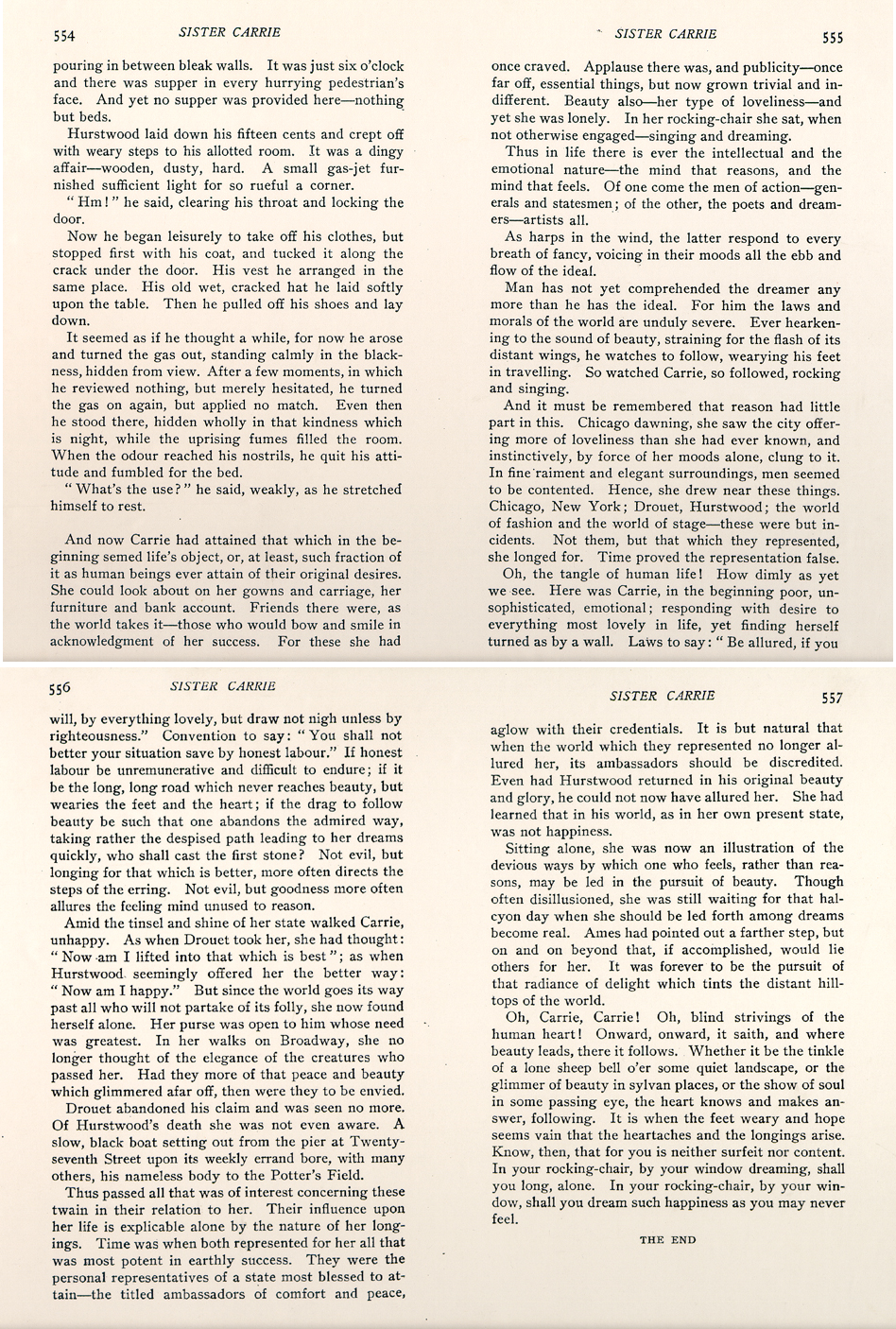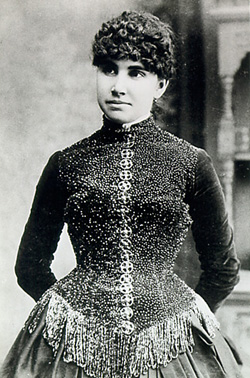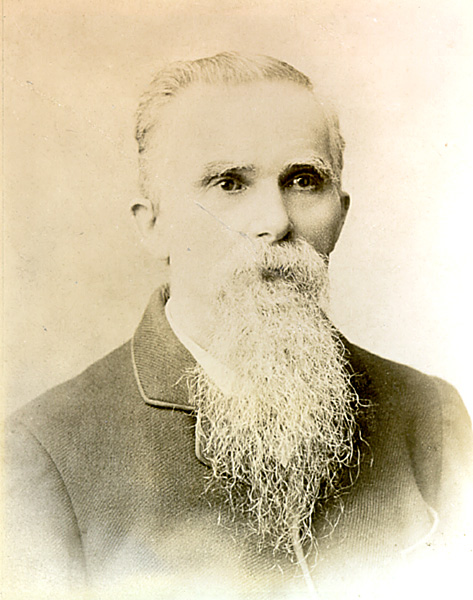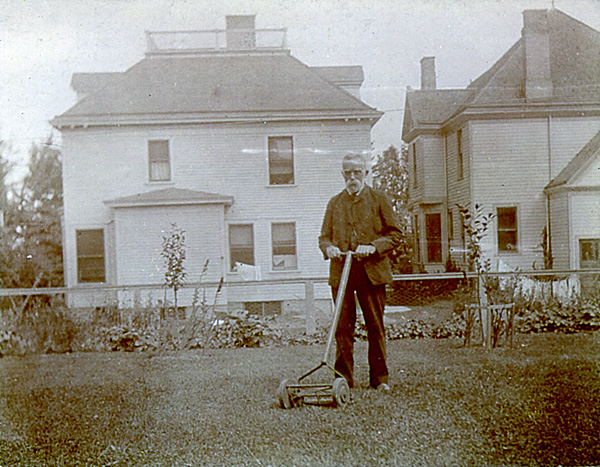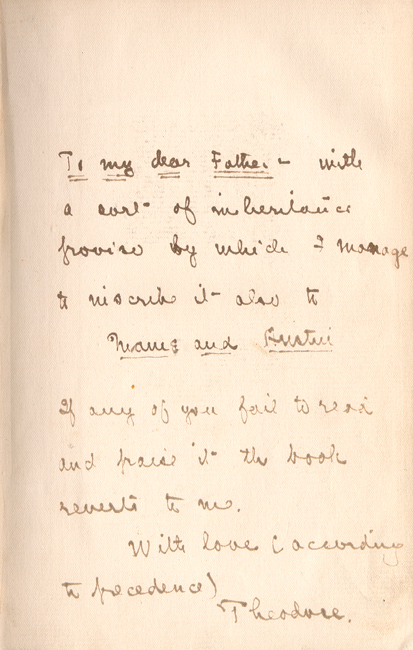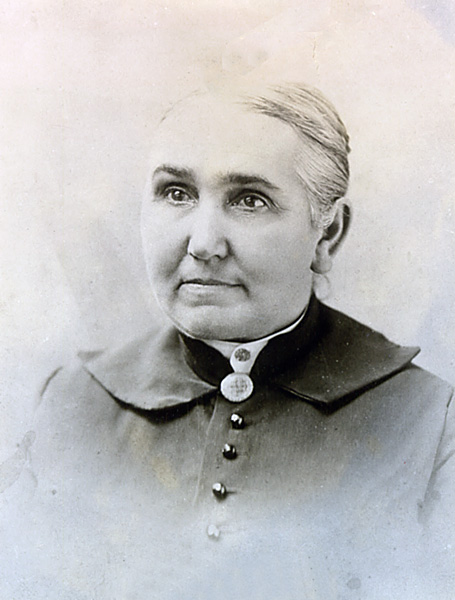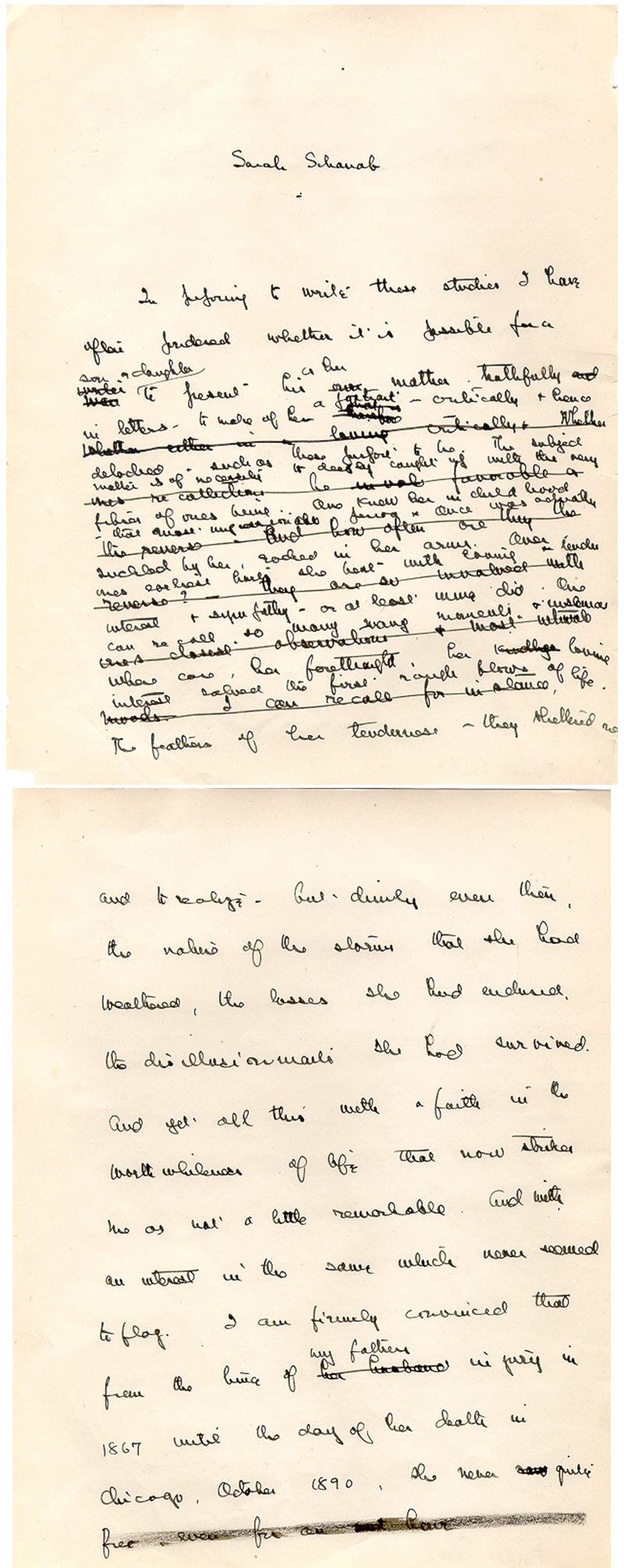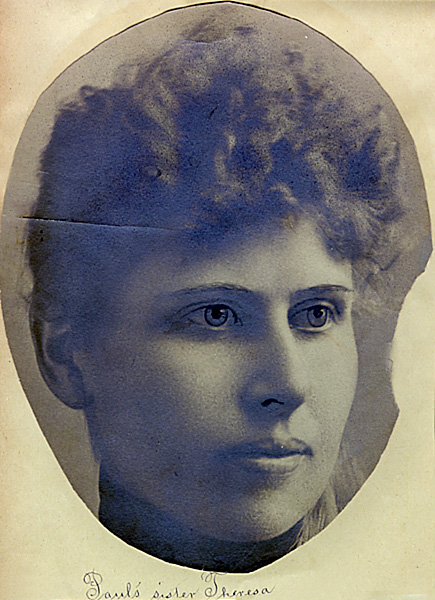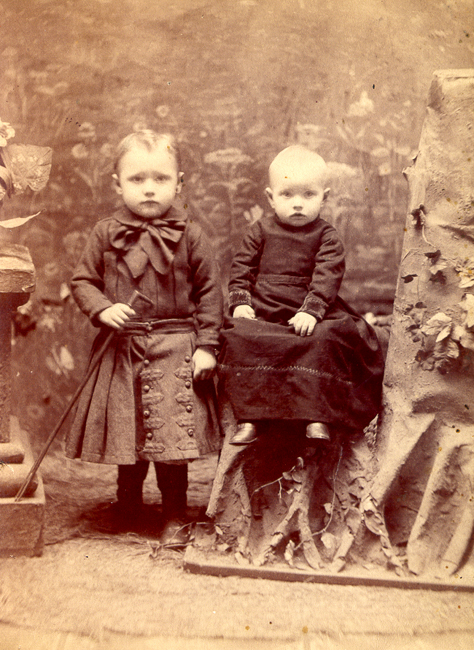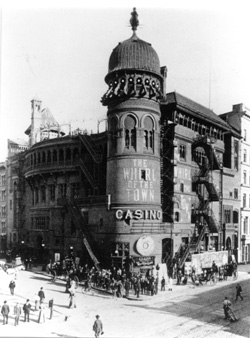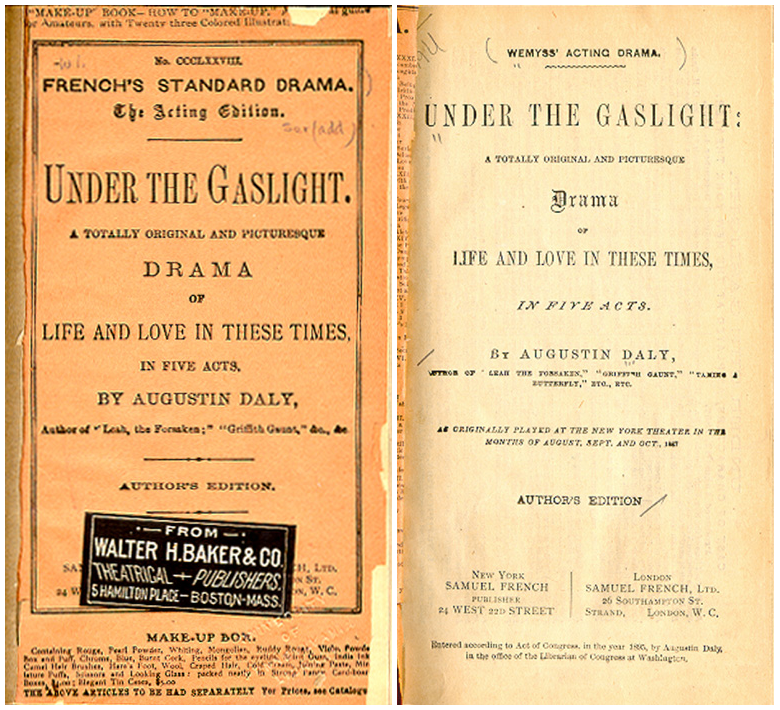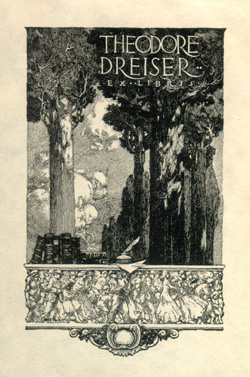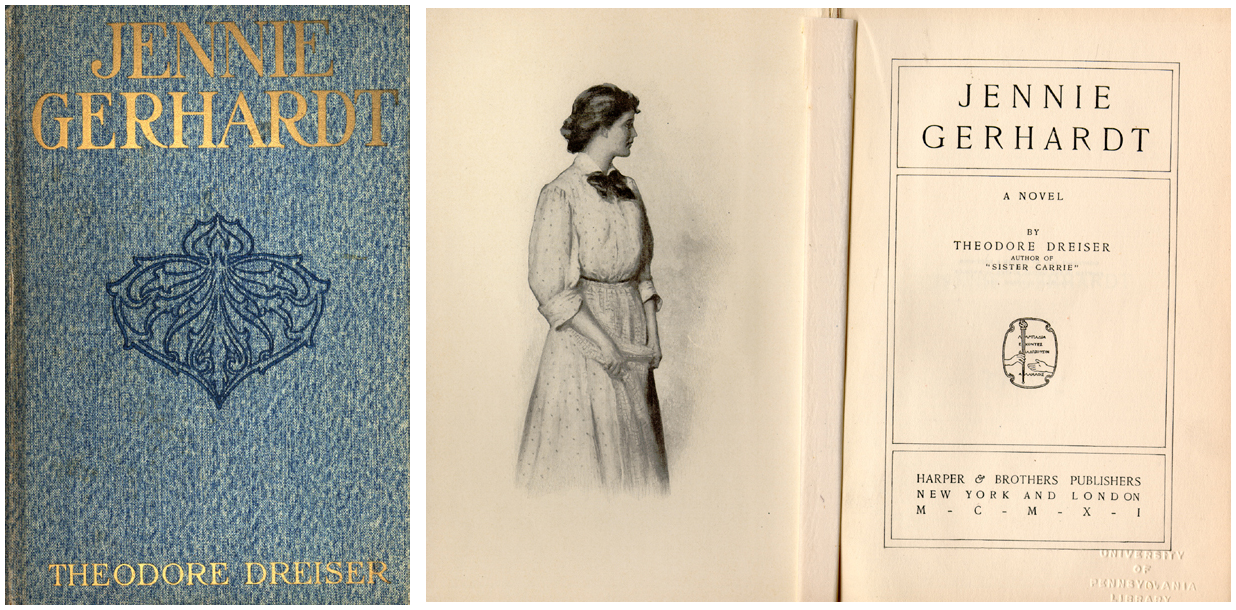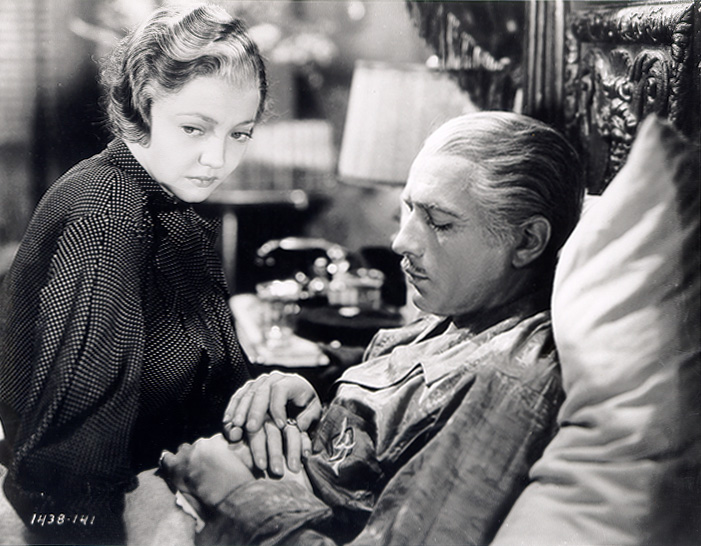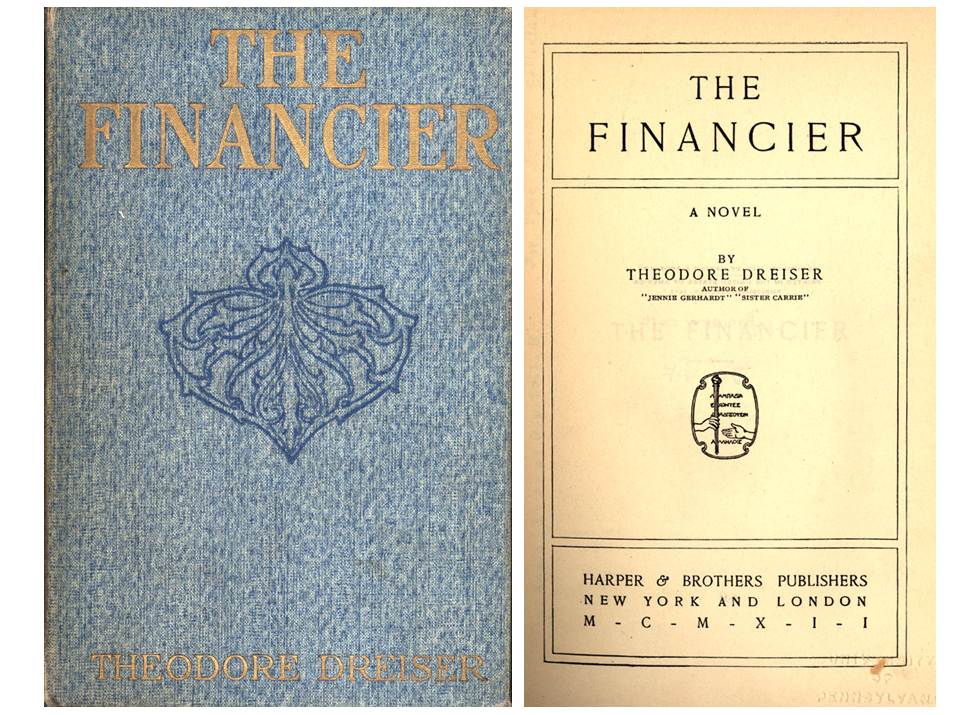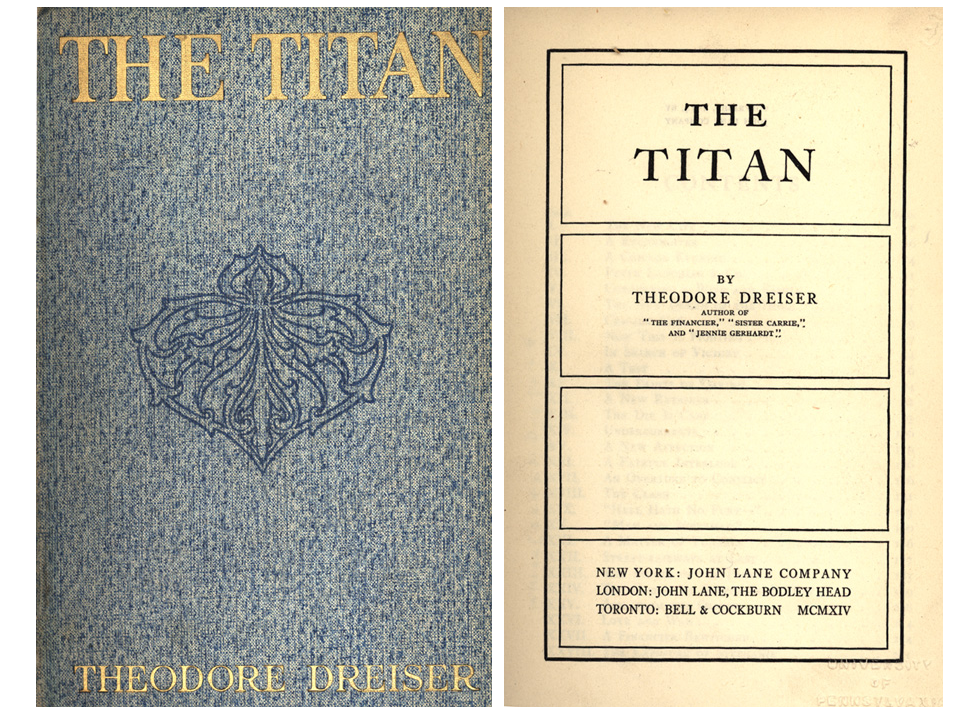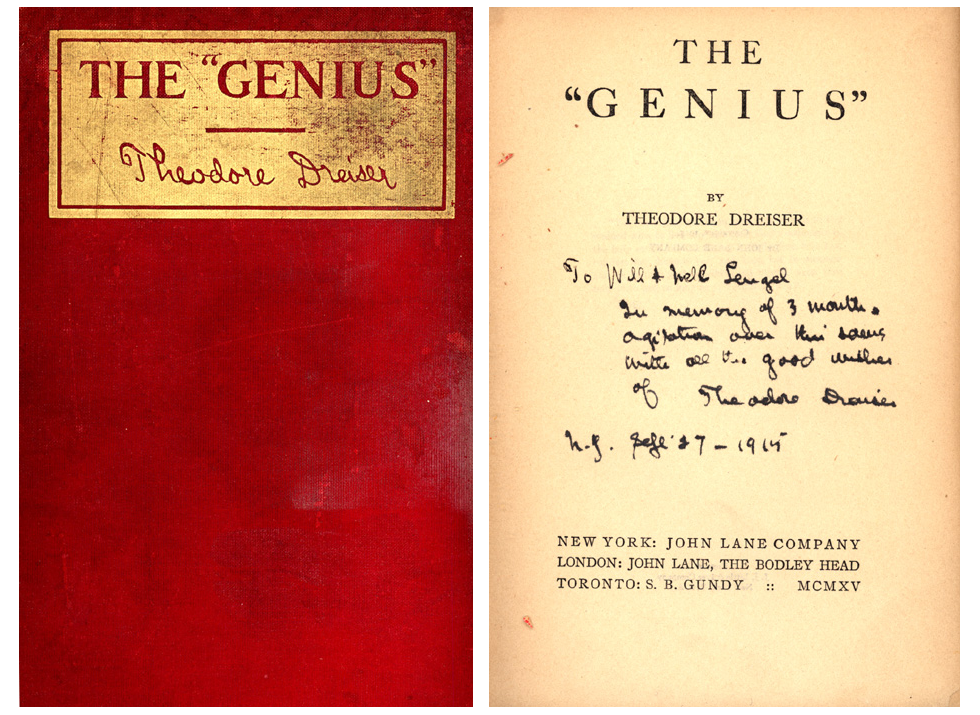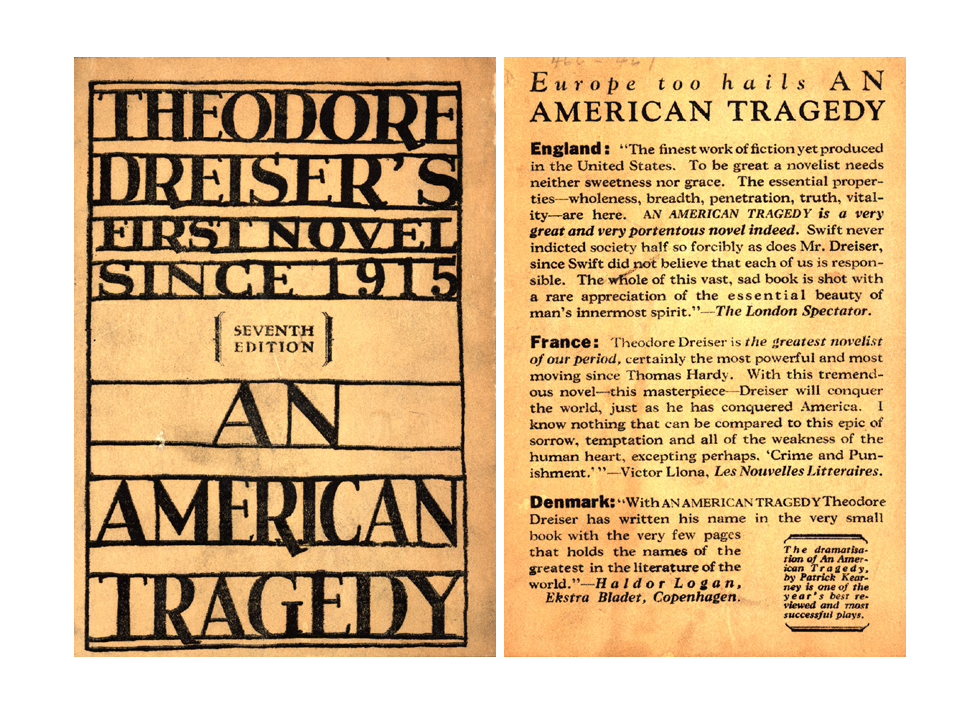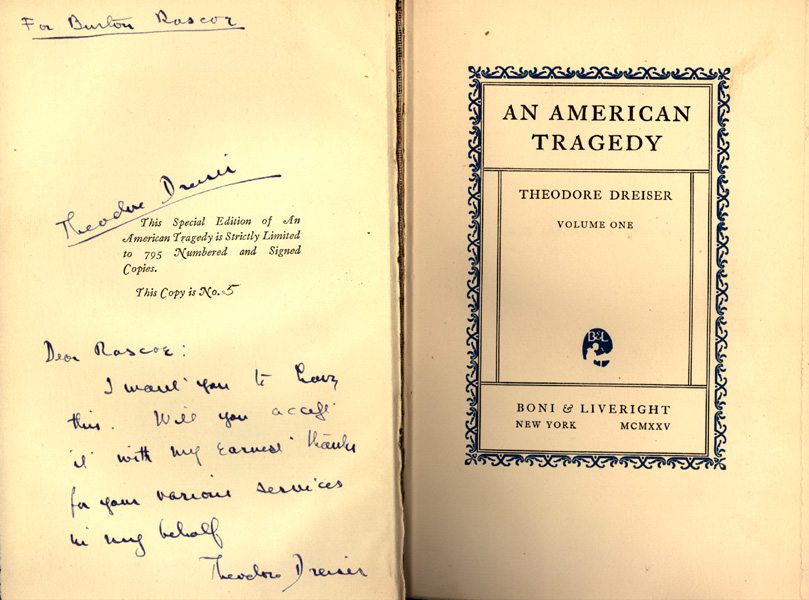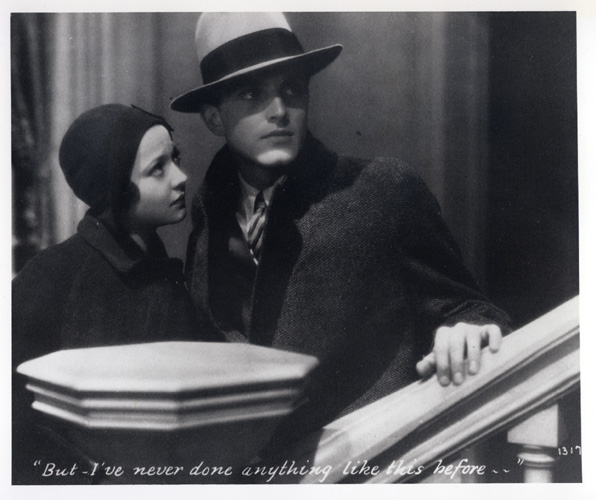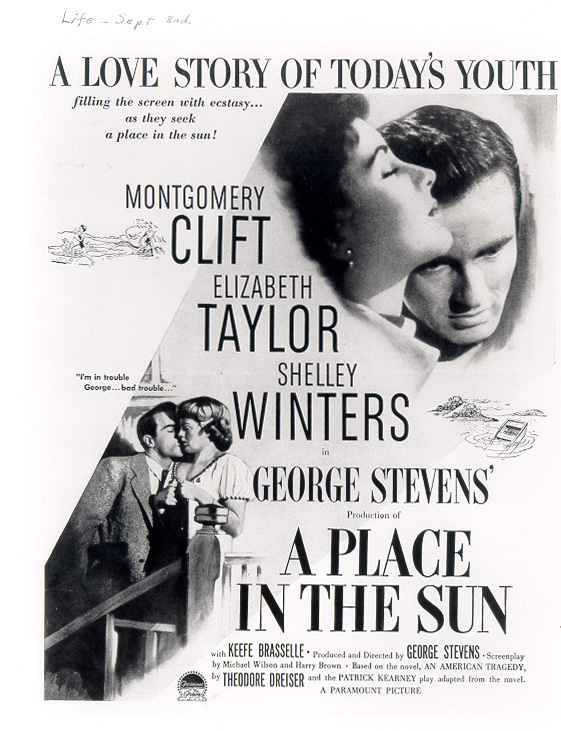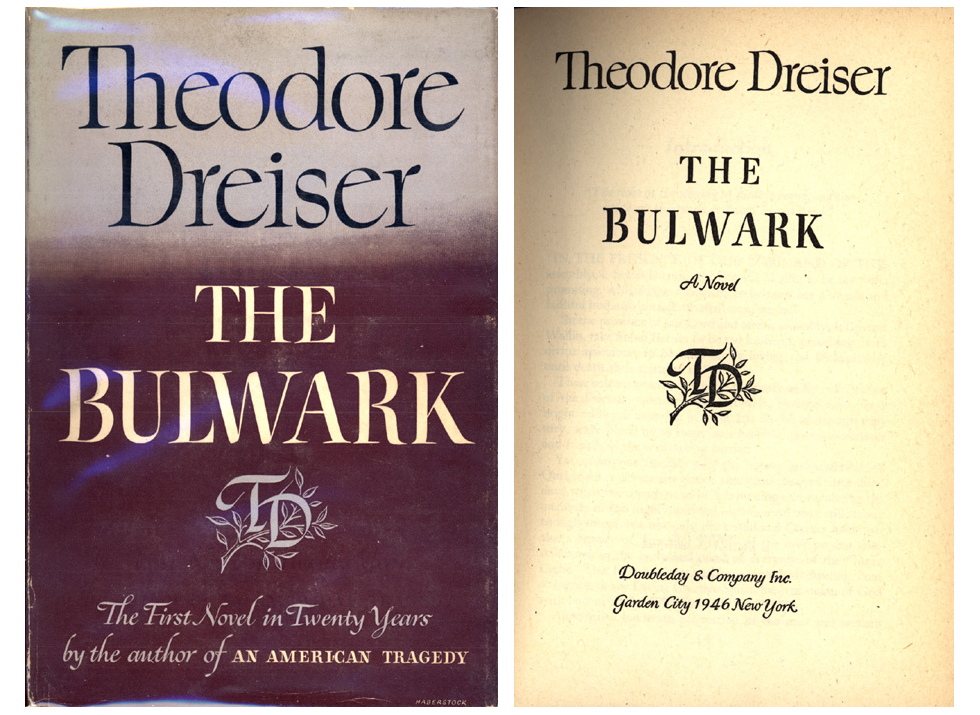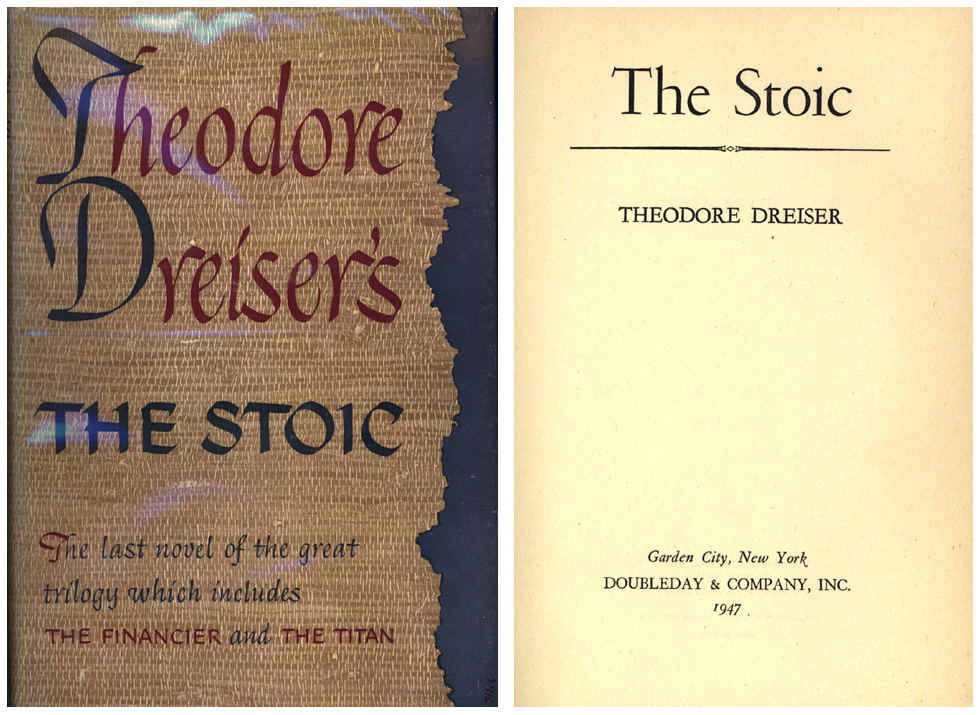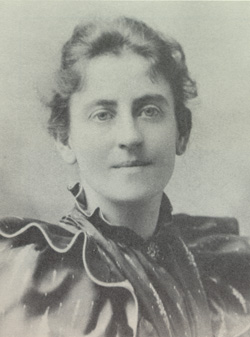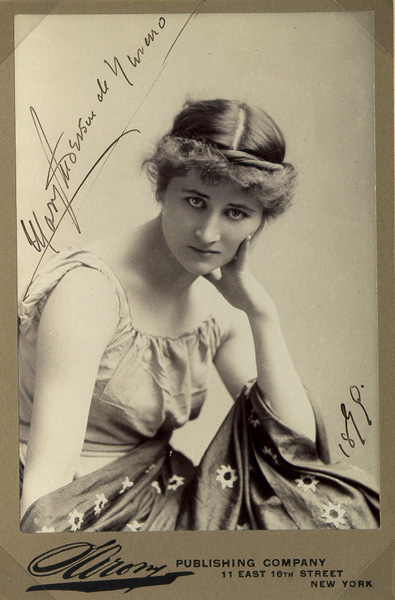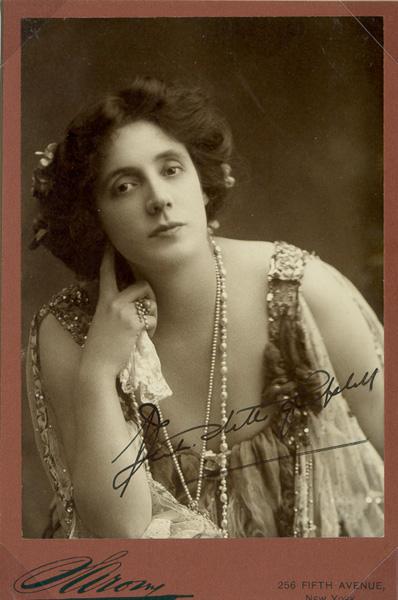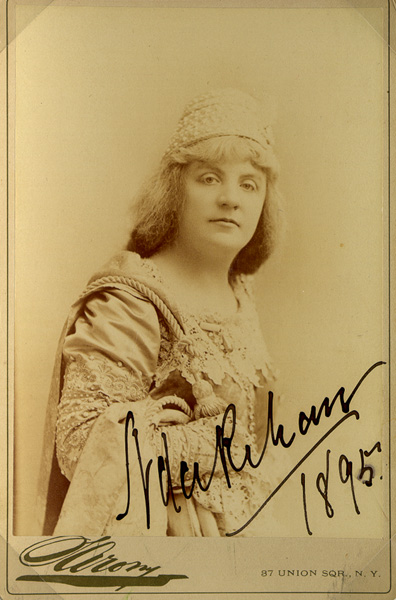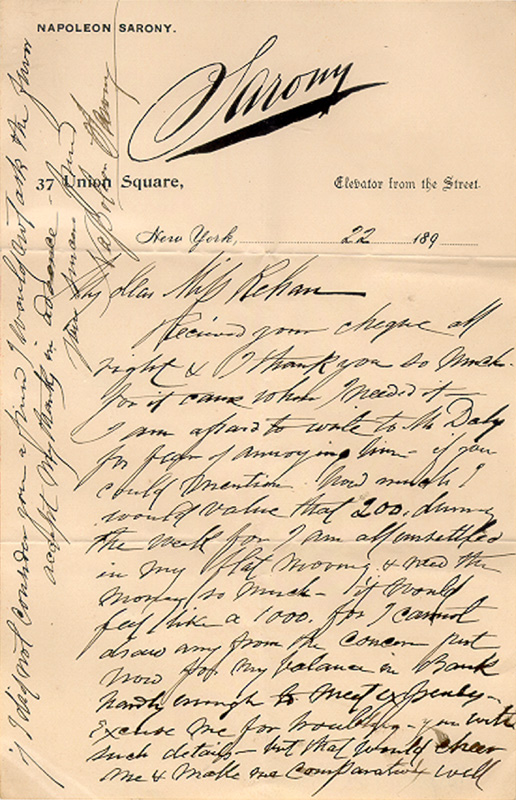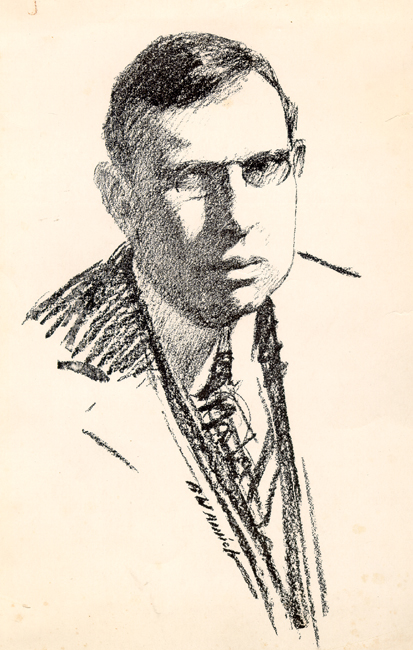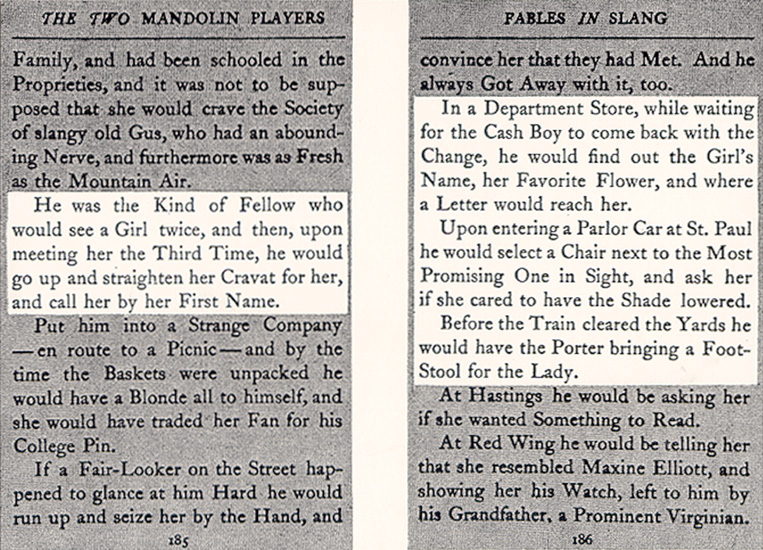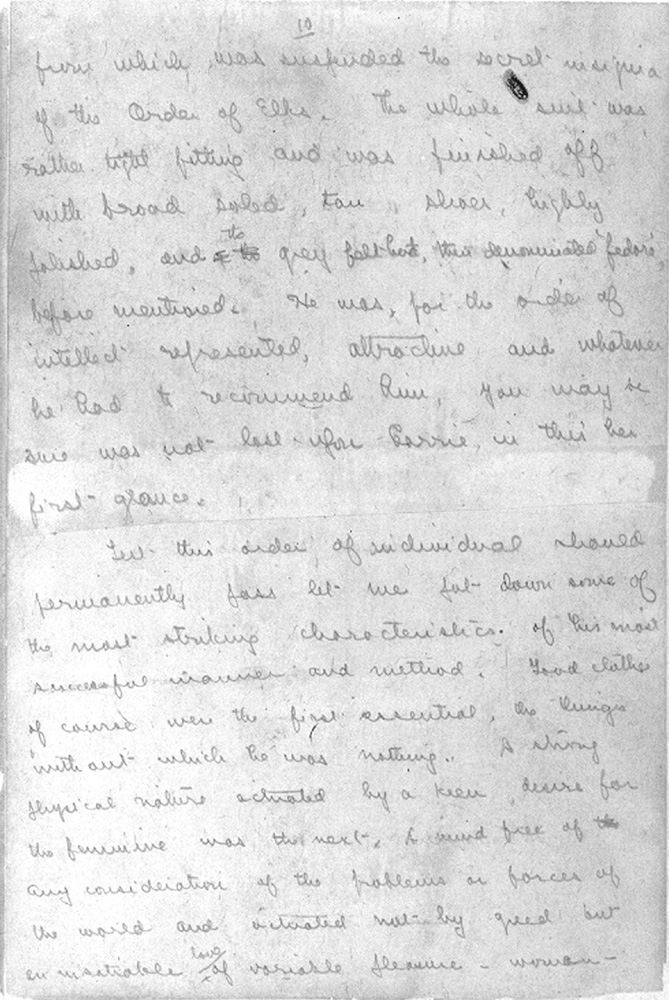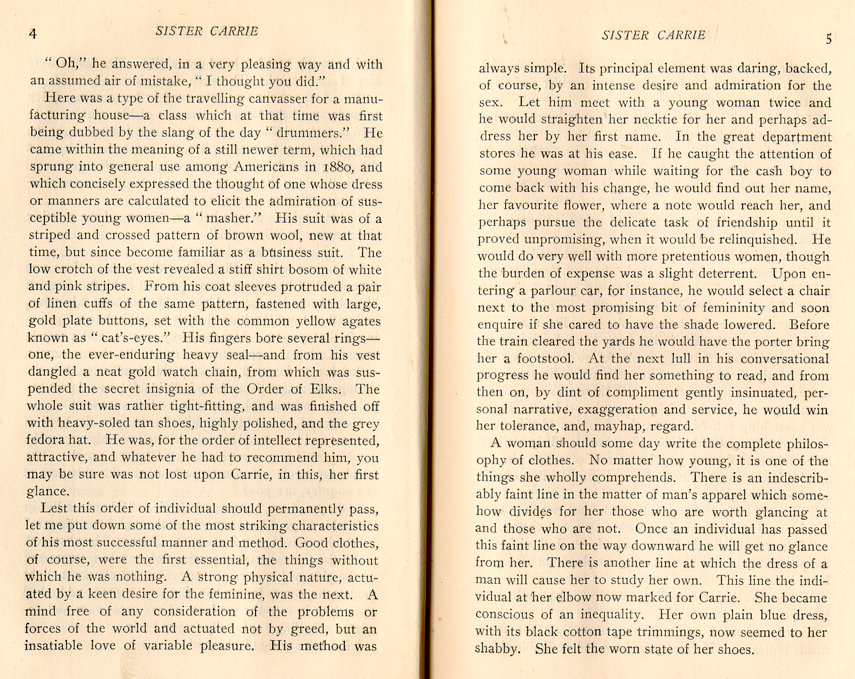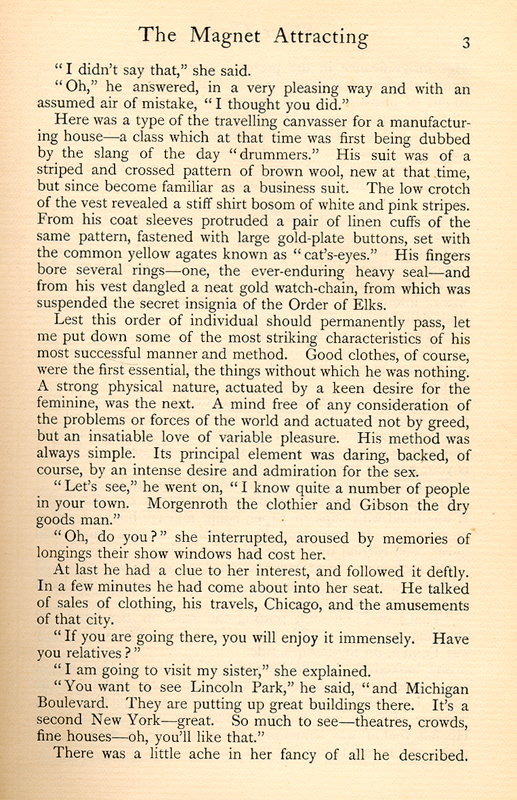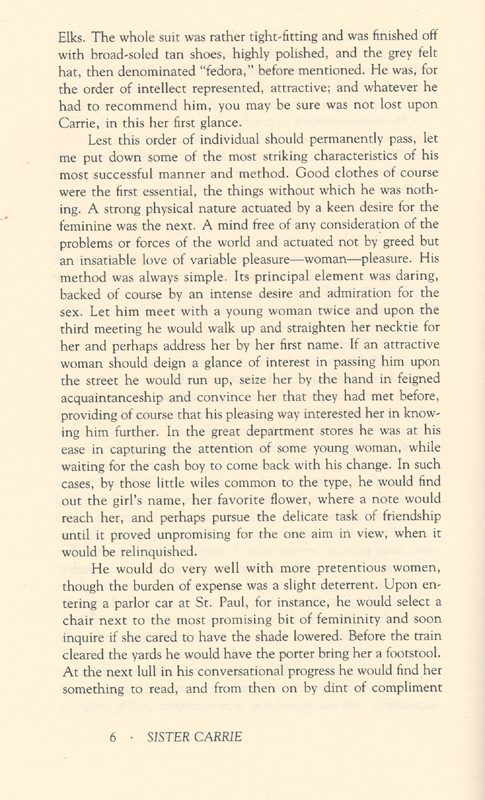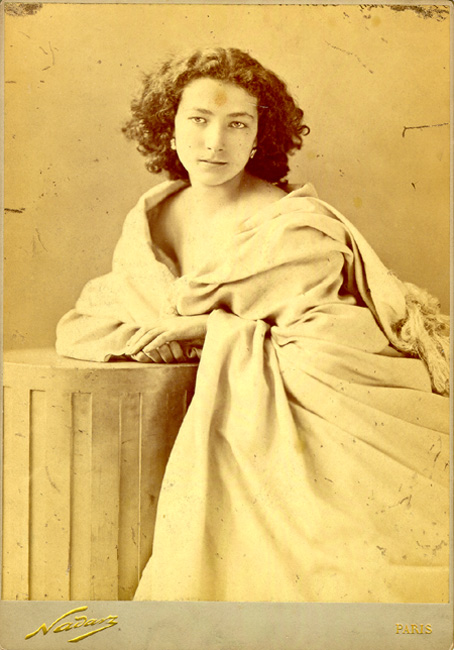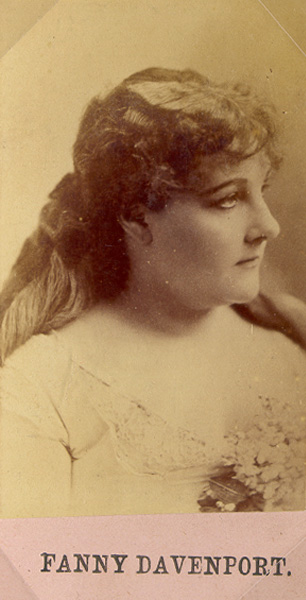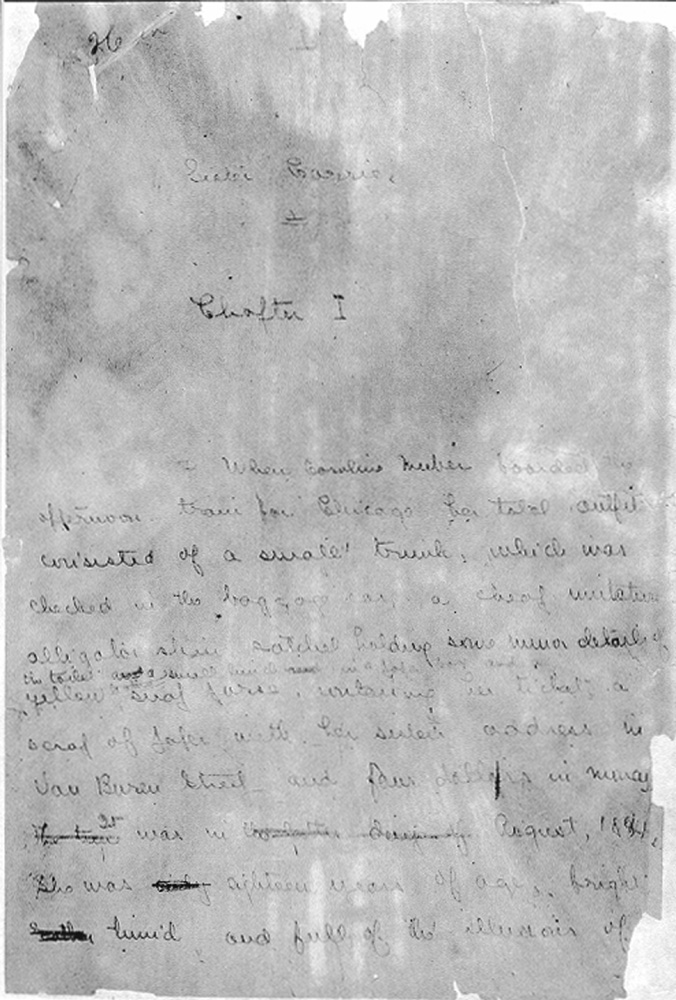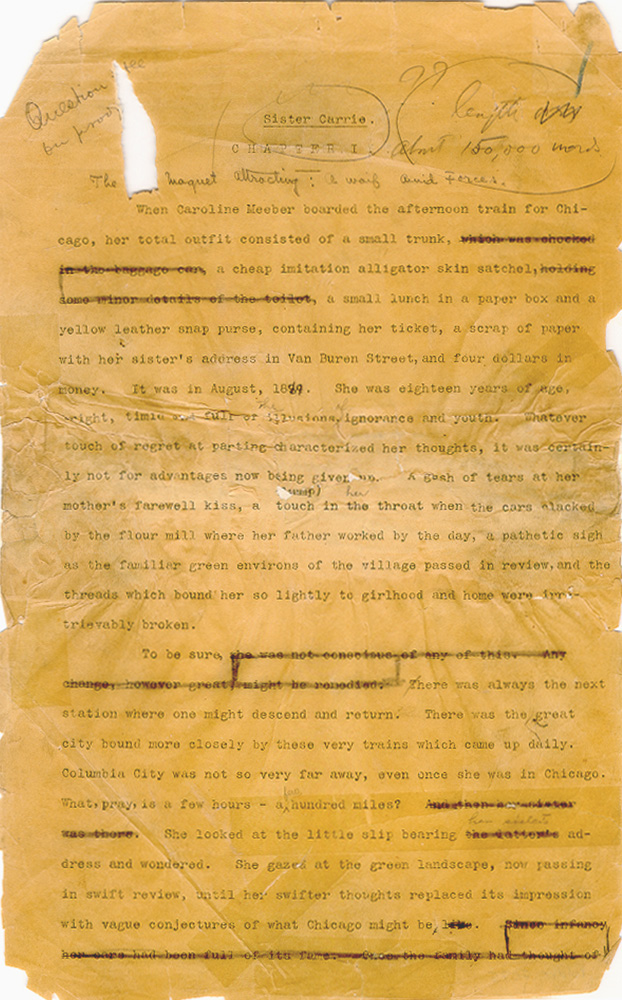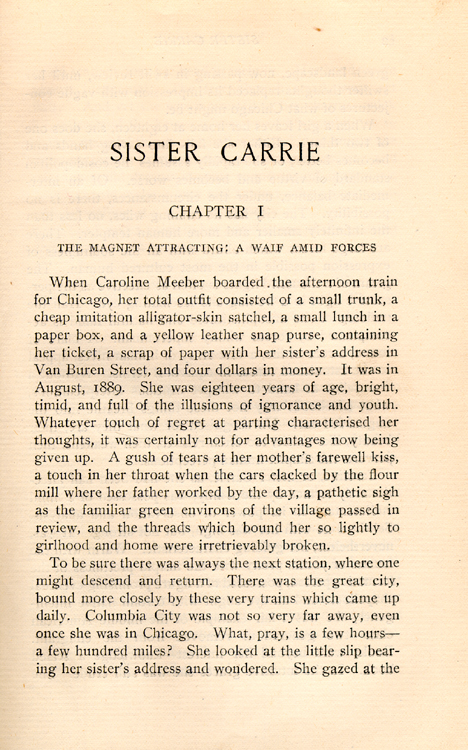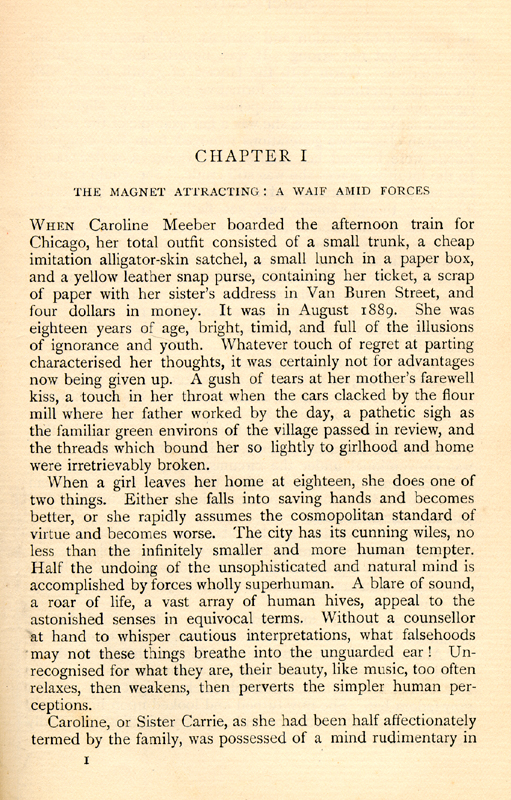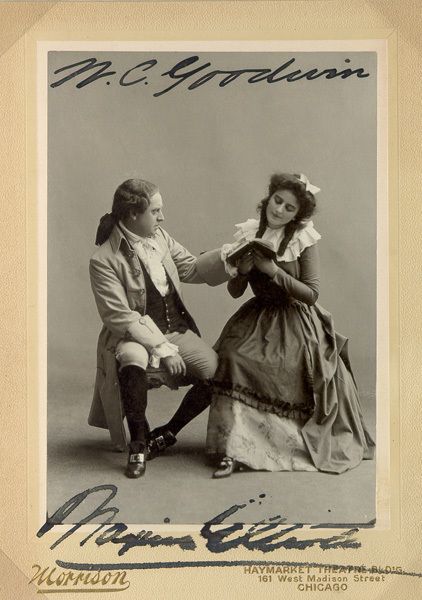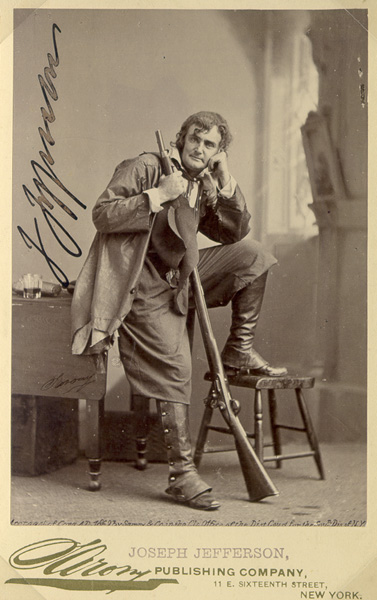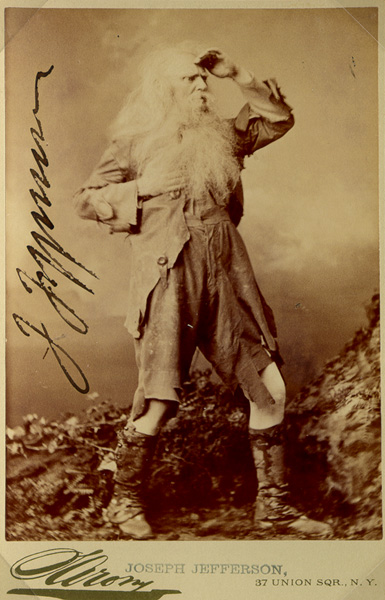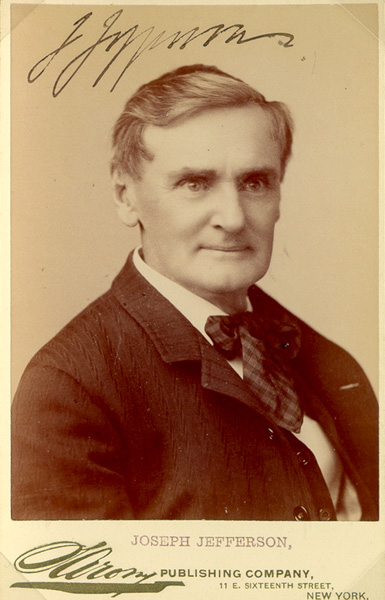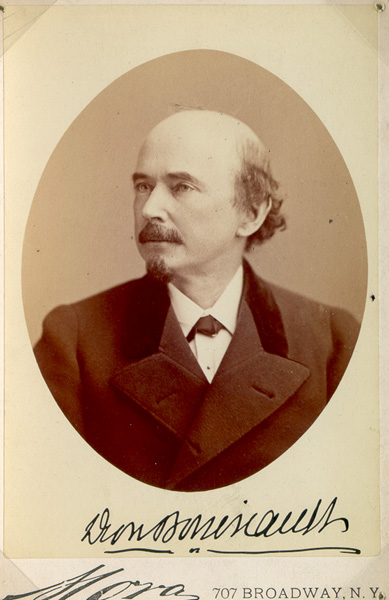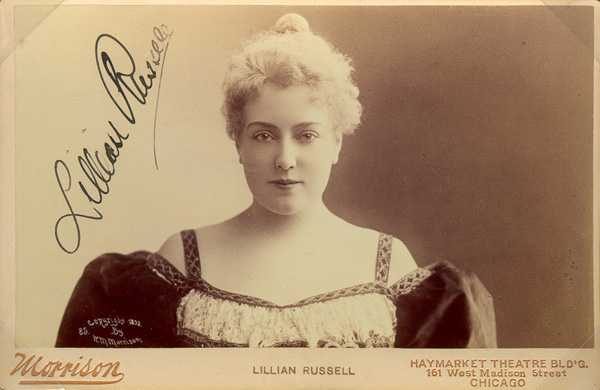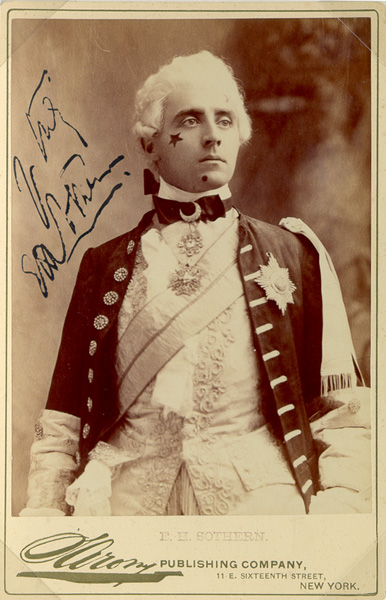Sister Carrie
Sister Emma
Sister Emma
Sister Emma
Dreiser's Apprenticeship
Dreiser's Apprenticeship
Dreiser's Apprenticeship
Sister Carrie in Search of a Publisher
Sister Carrie in Search of a Publisher
Sister Carrie in Search of a Publisher
Too Many Cooks?
Too Many Cooks?
Too Many Cooks?
Stage-Struck
Stage-Struck
Stage-Struck
Brother Paul
Brother Paul
Brother Paul
The Enablers - Sara Osbourne White and Arthur Henry
The Enablers - Sara Osbourne White and Arthur Henry
The Enablers - Sara Osbourne White and Arthur Henry
Doubleday, Page and Co. and Beyond
Doubleday, Page and Co. and Beyond
Doubleday, Page and Co. and Beyond
The Last Word
The Last Word
The Last Word
The Hollywoodization of Carrie
The Hollywoodization of Carrie
The Hollywoodization of Carrie
Theodore Dreiser Ex Libris
Theodore Dreiser Ex Libris
Theodore Dreiser Ex Libris
Additional Images
Additional Images
Additional Images

Introduction
One hundred years ago the first novel by American journalist and editor Theodore Dreiser was issued by Doubleday, Page & Co. At the outset the work was primarily distributed to and read by book reviewers. Among the mixed reactions printed in the initial year of publication came a prophetic analysis by William Marion Reedy in the St. Louis Mirror; it was entitled "Sister Carrie: A Strangely Strong Novel in a Queer Milieu" (3 January 1901). Although he admits that the novel is neither "nice" nor "nasty," Reedy identifies one of the enduring powers of Dreiser's tale: "the strong hint of the pathetic in banale situations which is more frequent than often imagined." In a review dominated by plot summary and frequently acknowledging Dreiser's uneven craft, Reedy always returns to his own captivation with Dreiser's remarkable blend of veritism and art: "at times the whole thing is impossible, and then again it is as absolute as life itself."
Sister Carrie remains vital for many reasons: as an historical marker for the turn away from sentimentality, romance, and moral rectitude in the American novel at the brink of the twentieth century; as a text that influenced--pro and con--succeeding American novelists over the next several decades; and as a conundrum that never ceases to provoke debate for readers both general and professional. While the first half of the twentieth century produced a diverse range of critical opinion on Sister Carrie by reviewers and essayists, the second half has been witness to an abiding argument within academia regarding the quality, value, importance, and interpretation of this signature text.
Fig. 1: First edition of the book that Frank Doubleday never wanted to publish and did nothing to promote.
Fig. 2: First edition of Masters' book of poems inscribed by Masters to Theodore Dreiser: "For Theodore Dreiser/ artist and master/ Edgar Lee Masters/ Dec 10-'15"
Fig. 3: Edgar Lee Masters was a Chicago lawyer who composed poetry (which he published himself) when he wrote Dreiser in 1912 to praise a recent Dreiser publication, The Financier. In the first page of his letter, he notes that he had followed Dreiser's novels from the beginning, when he found himself absorbed by Sister Carrie. He continues: "You have such a capacity for detail and for the pure fact from which truth is secreted that you pile up in tireless fashion the evidence for your argument."
Fig. 5: This caricature of the two American novelists mocks their realist style, which was often found too frank and unrelenting for popular taste. The drawing was used in the Book Review section of the New York Times on 5 September 1926 with the title "Merciless Realism" and the caption "Theodore Dreiser and Sherwood Anderson Watching People Suffer."
Fig. 1: First edition of the book that Frank Doubleday never wanted to publish and did nothing to promote.
Fig. 2: First edition of Masters' book of poems inscribed by Masters to Theodore Dreiser: "For Theodore Dreiser/ artist and master/ Edgar Lee Masters/ Dec 10-'15"
Fig. 3: Edgar Lee Masters was a Chicago lawyer who composed poetry (which he published himself) when he wrote Dreiser in 1912 to praise a recent Dreiser publication, The Financier. In the first page of his letter, he notes that he had followed Dreiser's novels from the beginning, when he found himself absorbed by Sister Carrie. He continues: "You have such a capacity for detail and for the pure fact from which truth is secreted that you pile up in tireless fashion the evidence for your argument."
Fig. 5: This caricature of the two American novelists mocks their realist style, which was often found too frank and unrelenting for popular taste. The drawing was used in the Book Review section of the New York Times on 5 September 1926 with the title "Merciless Realism" and the caption "Theodore Dreiser and Sherwood Anderson Watching People Suffer."
Fig. 1: First edition of the book that Frank Doubleday never wanted to publish and did nothing to promote.
Fig. 2: First edition of Masters' book of poems inscribed by Masters to Theodore Dreiser: "For Theodore Dreiser/ artist and master/ Edgar Lee Masters/ Dec 10-'15"
Fig. 3: Edgar Lee Masters was a Chicago lawyer who composed poetry (which he published himself) when he wrote Dreiser in 1912 to praise a recent Dreiser publication, The Financier. In the first page of his letter, he notes that he had followed Dreiser's novels from the beginning, when he found himself absorbed by Sister Carrie. He continues: "You have such a capacity for detail and for the pure fact from which truth is secreted that you pile up in tireless fashion the evidence for your argument."
Fig. 5: This caricature of the two American novelists mocks their realist style, which was often found too frank and unrelenting for popular taste. The drawing was used in the Book Review section of the New York Times on 5 September 1926 with the title "Merciless Realism" and the caption "Theodore Dreiser and Sherwood Anderson Watching People Suffer."
Fig. 1: First edition of the book that Frank Doubleday never wanted to publish and did nothing to promote.
Fig. 2: First edition of Masters' book of poems inscribed by Masters to Theodore Dreiser: "For Theodore Dreiser/ artist and master/ Edgar Lee Masters/ Dec 10-'15"
Fig. 3: Edgar Lee Masters was a Chicago lawyer who composed poetry (which he published himself) when he wrote Dreiser in 1912 to praise a recent Dreiser publication, The Financier. In the first page of his letter, he notes that he had followed Dreiser's novels from the beginning, when he found himself absorbed by Sister Carrie. He continues: "You have such a capacity for detail and for the pure fact from which truth is secreted that you pile up in tireless fashion the evidence for your argument."
Fig. 5: This caricature of the two American novelists mocks their realist style, which was often found too frank and unrelenting for popular taste. The drawing was used in the Book Review section of the New York Times on 5 September 1926 with the title "Merciless Realism" and the caption "Theodore Dreiser and Sherwood Anderson Watching People Suffer."
Fig. 1: First edition of the book that Frank Doubleday never wanted to publish and did nothing to promote.
Fig. 2: First edition of Masters' book of poems inscribed by Masters to Theodore Dreiser: "For Theodore Dreiser/ artist and master/ Edgar Lee Masters/ Dec 10-'15"
Fig. 3: Edgar Lee Masters was a Chicago lawyer who composed poetry (which he published himself) when he wrote Dreiser in 1912 to praise a recent Dreiser publication, The Financier. In the first page of his letter, he notes that he had followed Dreiser's novels from the beginning, when he found himself absorbed by Sister Carrie. He continues: "You have such a capacity for detail and for the pure fact from which truth is secreted that you pile up in tireless fashion the evidence for your argument."
Fig. 5: This caricature of the two American novelists mocks their realist style, which was often found too frank and unrelenting for popular taste. The drawing was used in the Book Review section of the New York Times on 5 September 1926 with the title "Merciless Realism" and the caption "Theodore Dreiser and Sherwood Anderson Watching People Suffer."
Before publishing his first novel, Dreiser's apprenticeship in writing comprised a menagerie of short-term assignments and positions with newspapers and magazines from St. Louis to New York. His first reporter's job came in 1892 with the Chicago Daily Globe, considered one of the weakest of the Chicago papers at the time. But the Globe's less-than-premiere status afforded the inexperienced writer the opportunity to prove himself. He parlayed his few months of work at the Chicago Daily Globe into a position at the St. Louis Globe-Democrat, a morning Republican paper that was the biggest in town. At one point Dreiser was assigned the "hotel beat," which meant interviewing visiting celebrities. After returning to the city room one night, having just interviewed the theosophist Annie Besant, he was called away to cover a triple murder. Still dressed in his rented evening clothes, Dreiser arrived at the scene of the crime to find the bloody corpses of a mother and her two children who had been brutally murdered by her husband, the children's father. This dichotomy between wealth and poverty, between appearance and reality, between prospects and hopelessness informs Sister Carrie.
The life of the newspaperman in Dreiser's time was itself filled with poverty, lasciviousness, and corruption, as were many of the events that a reporter covered. At first naïve, Dreiser quickly learned the ropes and the realities of urban America, but invariably his ideals or vision or personal pride created rifts between himself and management. Freedom--or what appeared to be freedom--to write works to his own plan drove Dreiser not only to seek the editorship at Ev'ry Month but also to pursue creative writing, such as poetry. After departing Ev'ry Monthin September 1897, Dreiser wrote scores of articles for all manner of publications, always hoping that he could find a measure of financial freedom to write his first novel. Among these works came material that would latter be incorporated into Sister Carrie, which he began in earnest in the fall of 1899.
Fig. 1: Taken at the time when Dreiser was shuttling among various city papers from Chicago to St. Louis to Pittsburgh to Toledo
Fig. 2: As editor of Ev'ry Month, Dreiser was able to write a column entitled "Reflections," allowing him to expound on current events. The article for the October 1896 issue contrasts the onerous existence of New York's "have-nots" with the city's opulence as experienced by the "haves." It is signed "THE PROPHET."
Fig. 3: The subject matter for this article at least pertained to an American writer--the Pennsylvania-born poet and novelist Bayard Taylor, who died in 1878.
Fig. 4: From munitions to music, no subject was beyond Dreiser's reach as he sought to make a living as a journalist.
Fig. 5: The illustrated monthly Cosmopolitan published several articles by Dreiser in the late 1890s. This one concerns a munitions factory in Bridgeport, Connecticut, that produces special cartridges used by the United States Army and Navy in ordinary rifles.
Fig. 6: Photostat of Dreiser's article on the invention of a thermo-electric generator by H. Barringer Cox
Fig. 7: This article reviews the astonishing statistics surrounding the growth of the fruit industry in the United States. Dreiser concludes by praising the resources and potential inherent yet still unfulfilled in America. "For every ray of sunshine used in perfecting bloom and fruitage, ten thousand left to pass! Man shall perfect himself in the wisdom of these things, and there shall no longer be a cry for food."
Before publishing his first novel, Dreiser's apprenticeship in writing comprised a menagerie of short-term assignments and positions with newspapers and magazines from St. Louis to New York. His first reporter's job came in 1892 with the Chicago Daily Globe, considered one of the weakest of the Chicago papers at the time. But the Globe's less-than-premiere status afforded the inexperienced writer the opportunity to prove himself. He parlayed his few months of work at the Chicago Daily Globe into a position at the St. Louis Globe-Democrat, a morning Republican paper that was the biggest in town. At one point Dreiser was assigned the "hotel beat," which meant interviewing visiting celebrities. After returning to the city room one night, having just interviewed the theosophist Annie Besant, he was called away to cover a triple murder. Still dressed in his rented evening clothes, Dreiser arrived at the scene of the crime to find the bloody corpses of a mother and her two children who had been brutally murdered by her husband, the children's father. This dichotomy between wealth and poverty, between appearance and reality, between prospects and hopelessness informs Sister Carrie.
The life of the newspaperman in Dreiser's time was itself filled with poverty, lasciviousness, and corruption, as were many of the events that a reporter covered. At first naïve, Dreiser quickly learned the ropes and the realities of urban America, but invariably his ideals or vision or personal pride created rifts between himself and management. Freedom--or what appeared to be freedom--to write works to his own plan drove Dreiser not only to seek the editorship at Ev'ry Month but also to pursue creative writing, such as poetry. After departing Ev'ry Monthin September 1897, Dreiser wrote scores of articles for all manner of publications, always hoping that he could find a measure of financial freedom to write his first novel. Among these works came material that would latter be incorporated into Sister Carrie, which he began in earnest in the fall of 1899.
Fig. 1: Taken at the time when Dreiser was shuttling among various city papers from Chicago to St. Louis to Pittsburgh to Toledo
Fig. 2: As editor of Ev'ry Month, Dreiser was able to write a column entitled "Reflections," allowing him to expound on current events. The article for the October 1896 issue contrasts the onerous existence of New York's "have-nots" with the city's opulence as experienced by the "haves." It is signed "THE PROPHET."
Fig. 3: The subject matter for this article at least pertained to an American writer--the Pennsylvania-born poet and novelist Bayard Taylor, who died in 1878.
Fig. 4: From munitions to music, no subject was beyond Dreiser's reach as he sought to make a living as a journalist.
Fig. 5: The illustrated monthly Cosmopolitan published several articles by Dreiser in the late 1890s. This one concerns a munitions factory in Bridgeport, Connecticut, that produces special cartridges used by the United States Army and Navy in ordinary rifles.
Fig. 6: Photostat of Dreiser's article on the invention of a thermo-electric generator by H. Barringer Cox
Fig. 7: This article reviews the astonishing statistics surrounding the growth of the fruit industry in the United States. Dreiser concludes by praising the resources and potential inherent yet still unfulfilled in America. "For every ray of sunshine used in perfecting bloom and fruitage, ten thousand left to pass! Man shall perfect himself in the wisdom of these things, and there shall no longer be a cry for food."
Before publishing his first novel, Dreiser's apprenticeship in writing comprised a menagerie of short-term assignments and positions with newspapers and magazines from St. Louis to New York. His first reporter's job came in 1892 with the Chicago Daily Globe, considered one of the weakest of the Chicago papers at the time. But the Globe's less-than-premiere status afforded the inexperienced writer the opportunity to prove himself. He parlayed his few months of work at the Chicago Daily Globe into a position at the St. Louis Globe-Democrat, a morning Republican paper that was the biggest in town. At one point Dreiser was assigned the "hotel beat," which meant interviewing visiting celebrities. After returning to the city room one night, having just interviewed the theosophist Annie Besant, he was called away to cover a triple murder. Still dressed in his rented evening clothes, Dreiser arrived at the scene of the crime to find the bloody corpses of a mother and her two children who had been brutally murdered by her husband, the children's father. This dichotomy between wealth and poverty, between appearance and reality, between prospects and hopelessness informs Sister Carrie.
The life of the newspaperman in Dreiser's time was itself filled with poverty, lasciviousness, and corruption, as were many of the events that a reporter covered. At first naïve, Dreiser quickly learned the ropes and the realities of urban America, but invariably his ideals or vision or personal pride created rifts between himself and management. Freedom--or what appeared to be freedom--to write works to his own plan drove Dreiser not only to seek the editorship at Ev'ry Month but also to pursue creative writing, such as poetry. After departing Ev'ry Monthin September 1897, Dreiser wrote scores of articles for all manner of publications, always hoping that he could find a measure of financial freedom to write his first novel. Among these works came material that would latter be incorporated into Sister Carrie, which he began in earnest in the fall of 1899.
Fig. 1: Taken at the time when Dreiser was shuttling among various city papers from Chicago to St. Louis to Pittsburgh to Toledo
Fig. 2: As editor of Ev'ry Month, Dreiser was able to write a column entitled "Reflections," allowing him to expound on current events. The article for the October 1896 issue contrasts the onerous existence of New York's "have-nots" with the city's opulence as experienced by the "haves." It is signed "THE PROPHET."
Fig. 3: The subject matter for this article at least pertained to an American writer--the Pennsylvania-born poet and novelist Bayard Taylor, who died in 1878.
Fig. 4: From munitions to music, no subject was beyond Dreiser's reach as he sought to make a living as a journalist.
Fig. 5: The illustrated monthly Cosmopolitan published several articles by Dreiser in the late 1890s. This one concerns a munitions factory in Bridgeport, Connecticut, that produces special cartridges used by the United States Army and Navy in ordinary rifles.
Fig. 6: Photostat of Dreiser's article on the invention of a thermo-electric generator by H. Barringer Cox
Fig. 7: This article reviews the astonishing statistics surrounding the growth of the fruit industry in the United States. Dreiser concludes by praising the resources and potential inherent yet still unfulfilled in America. "For every ray of sunshine used in perfecting bloom and fruitage, ten thousand left to pass! Man shall perfect himself in the wisdom of these things, and there shall no longer be a cry for food."
Before publishing his first novel, Dreiser's apprenticeship in writing comprised a menagerie of short-term assignments and positions with newspapers and magazines from St. Louis to New York. His first reporter's job came in 1892 with the Chicago Daily Globe, considered one of the weakest of the Chicago papers at the time. But the Globe's less-than-premiere status afforded the inexperienced writer the opportunity to prove himself. He parlayed his few months of work at the Chicago Daily Globe into a position at the St. Louis Globe-Democrat, a morning Republican paper that was the biggest in town. At one point Dreiser was assigned the "hotel beat," which meant interviewing visiting celebrities. After returning to the city room one night, having just interviewed the theosophist Annie Besant, he was called away to cover a triple murder. Still dressed in his rented evening clothes, Dreiser arrived at the scene of the crime to find the bloody corpses of a mother and her two children who had been brutally murdered by her husband, the children's father. This dichotomy between wealth and poverty, between appearance and reality, between prospects and hopelessness informs Sister Carrie.
The life of the newspaperman in Dreiser's time was itself filled with poverty, lasciviousness, and corruption, as were many of the events that a reporter covered. At first naïve, Dreiser quickly learned the ropes and the realities of urban America, but invariably his ideals or vision or personal pride created rifts between himself and management. Freedom--or what appeared to be freedom--to write works to his own plan drove Dreiser not only to seek the editorship at Ev'ry Month but also to pursue creative writing, such as poetry. After departing Ev'ry Monthin September 1897, Dreiser wrote scores of articles for all manner of publications, always hoping that he could find a measure of financial freedom to write his first novel. Among these works came material that would latter be incorporated into Sister Carrie, which he began in earnest in the fall of 1899.
Fig. 1: Taken at the time when Dreiser was shuttling among various city papers from Chicago to St. Louis to Pittsburgh to Toledo
Fig. 2: As editor of Ev'ry Month, Dreiser was able to write a column entitled "Reflections," allowing him to expound on current events. The article for the October 1896 issue contrasts the onerous existence of New York's "have-nots" with the city's opulence as experienced by the "haves." It is signed "THE PROPHET."
Fig. 3: The subject matter for this article at least pertained to an American writer--the Pennsylvania-born poet and novelist Bayard Taylor, who died in 1878.
Fig. 4: From munitions to music, no subject was beyond Dreiser's reach as he sought to make a living as a journalist.
Fig. 5: The illustrated monthly Cosmopolitan published several articles by Dreiser in the late 1890s. This one concerns a munitions factory in Bridgeport, Connecticut, that produces special cartridges used by the United States Army and Navy in ordinary rifles.
Fig. 6: Photostat of Dreiser's article on the invention of a thermo-electric generator by H. Barringer Cox
Fig. 7: This article reviews the astonishing statistics surrounding the growth of the fruit industry in the United States. Dreiser concludes by praising the resources and potential inherent yet still unfulfilled in America. "For every ray of sunshine used in perfecting bloom and fruitage, ten thousand left to pass! Man shall perfect himself in the wisdom of these things, and there shall no longer be a cry for food."
Before publishing his first novel, Dreiser's apprenticeship in writing comprised a menagerie of short-term assignments and positions with newspapers and magazines from St. Louis to New York. His first reporter's job came in 1892 with the Chicago Daily Globe, considered one of the weakest of the Chicago papers at the time. But the Globe's less-than-premiere status afforded the inexperienced writer the opportunity to prove himself. He parlayed his few months of work at the Chicago Daily Globe into a position at the St. Louis Globe-Democrat, a morning Republican paper that was the biggest in town. At one point Dreiser was assigned the "hotel beat," which meant interviewing visiting celebrities. After returning to the city room one night, having just interviewed the theosophist Annie Besant, he was called away to cover a triple murder. Still dressed in his rented evening clothes, Dreiser arrived at the scene of the crime to find the bloody corpses of a mother and her two children who had been brutally murdered by her husband, the children's father. This dichotomy between wealth and poverty, between appearance and reality, between prospects and hopelessness informs Sister Carrie.
The life of the newspaperman in Dreiser's time was itself filled with poverty, lasciviousness, and corruption, as were many of the events that a reporter covered. At first naïve, Dreiser quickly learned the ropes and the realities of urban America, but invariably his ideals or vision or personal pride created rifts between himself and management. Freedom--or what appeared to be freedom--to write works to his own plan drove Dreiser not only to seek the editorship at Ev'ry Month but also to pursue creative writing, such as poetry. After departing Ev'ry Monthin September 1897, Dreiser wrote scores of articles for all manner of publications, always hoping that he could find a measure of financial freedom to write his first novel. Among these works came material that would latter be incorporated into Sister Carrie, which he began in earnest in the fall of 1899.
Fig. 1: Taken at the time when Dreiser was shuttling among various city papers from Chicago to St. Louis to Pittsburgh to Toledo
Fig. 2: As editor of Ev'ry Month, Dreiser was able to write a column entitled "Reflections," allowing him to expound on current events. The article for the October 1896 issue contrasts the onerous existence of New York's "have-nots" with the city's opulence as experienced by the "haves." It is signed "THE PROPHET."
Fig. 3: The subject matter for this article at least pertained to an American writer--the Pennsylvania-born poet and novelist Bayard Taylor, who died in 1878.
Fig. 4: From munitions to music, no subject was beyond Dreiser's reach as he sought to make a living as a journalist.
Fig. 5: The illustrated monthly Cosmopolitan published several articles by Dreiser in the late 1890s. This one concerns a munitions factory in Bridgeport, Connecticut, that produces special cartridges used by the United States Army and Navy in ordinary rifles.
Fig. 6: Photostat of Dreiser's article on the invention of a thermo-electric generator by H. Barringer Cox
Fig. 7: This article reviews the astonishing statistics surrounding the growth of the fruit industry in the United States. Dreiser concludes by praising the resources and potential inherent yet still unfulfilled in America. "For every ray of sunshine used in perfecting bloom and fruitage, ten thousand left to pass! Man shall perfect himself in the wisdom of these things, and there shall no longer be a cry for food."
Before publishing his first novel, Dreiser's apprenticeship in writing comprised a menagerie of short-term assignments and positions with newspapers and magazines from St. Louis to New York. His first reporter's job came in 1892 with the Chicago Daily Globe, considered one of the weakest of the Chicago papers at the time. But the Globe's less-than-premiere status afforded the inexperienced writer the opportunity to prove himself. He parlayed his few months of work at the Chicago Daily Globe into a position at the St. Louis Globe-Democrat, a morning Republican paper that was the biggest in town. At one point Dreiser was assigned the "hotel beat," which meant interviewing visiting celebrities. After returning to the city room one night, having just interviewed the theosophist Annie Besant, he was called away to cover a triple murder. Still dressed in his rented evening clothes, Dreiser arrived at the scene of the crime to find the bloody corpses of a mother and her two children who had been brutally murdered by her husband, the children's father. This dichotomy between wealth and poverty, between appearance and reality, between prospects and hopelessness informs Sister Carrie.
The life of the newspaperman in Dreiser's time was itself filled with poverty, lasciviousness, and corruption, as were many of the events that a reporter covered. At first naïve, Dreiser quickly learned the ropes and the realities of urban America, but invariably his ideals or vision or personal pride created rifts between himself and management. Freedom--or what appeared to be freedom--to write works to his own plan drove Dreiser not only to seek the editorship at Ev'ry Month but also to pursue creative writing, such as poetry. After departing Ev'ry Monthin September 1897, Dreiser wrote scores of articles for all manner of publications, always hoping that he could find a measure of financial freedom to write his first novel. Among these works came material that would latter be incorporated into Sister Carrie, which he began in earnest in the fall of 1899.
Fig. 1: Taken at the time when Dreiser was shuttling among various city papers from Chicago to St. Louis to Pittsburgh to Toledo
Fig. 2: As editor of Ev'ry Month, Dreiser was able to write a column entitled "Reflections," allowing him to expound on current events. The article for the October 1896 issue contrasts the onerous existence of New York's "have-nots" with the city's opulence as experienced by the "haves." It is signed "THE PROPHET."
Fig. 3: The subject matter for this article at least pertained to an American writer--the Pennsylvania-born poet and novelist Bayard Taylor, who died in 1878.
Fig. 4: From munitions to music, no subject was beyond Dreiser's reach as he sought to make a living as a journalist.
Fig. 5: The illustrated monthly Cosmopolitan published several articles by Dreiser in the late 1890s. This one concerns a munitions factory in Bridgeport, Connecticut, that produces special cartridges used by the United States Army and Navy in ordinary rifles.
Fig. 6: Photostat of Dreiser's article on the invention of a thermo-electric generator by H. Barringer Cox
Fig. 7: This article reviews the astonishing statistics surrounding the growth of the fruit industry in the United States. Dreiser concludes by praising the resources and potential inherent yet still unfulfilled in America. "For every ray of sunshine used in perfecting bloom and fruitage, ten thousand left to pass! Man shall perfect himself in the wisdom of these things, and there shall no longer be a cry for food."
Before publishing his first novel, Dreiser's apprenticeship in writing comprised a menagerie of short-term assignments and positions with newspapers and magazines from St. Louis to New York. His first reporter's job came in 1892 with the Chicago Daily Globe, considered one of the weakest of the Chicago papers at the time. But the Globe's less-than-premiere status afforded the inexperienced writer the opportunity to prove himself. He parlayed his few months of work at the Chicago Daily Globe into a position at the St. Louis Globe-Democrat, a morning Republican paper that was the biggest in town. At one point Dreiser was assigned the "hotel beat," which meant interviewing visiting celebrities. After returning to the city room one night, having just interviewed the theosophist Annie Besant, he was called away to cover a triple murder. Still dressed in his rented evening clothes, Dreiser arrived at the scene of the crime to find the bloody corpses of a mother and her two children who had been brutally murdered by her husband, the children's father. This dichotomy between wealth and poverty, between appearance and reality, between prospects and hopelessness informs Sister Carrie.
The life of the newspaperman in Dreiser's time was itself filled with poverty, lasciviousness, and corruption, as were many of the events that a reporter covered. At first naïve, Dreiser quickly learned the ropes and the realities of urban America, but invariably his ideals or vision or personal pride created rifts between himself and management. Freedom--or what appeared to be freedom--to write works to his own plan drove Dreiser not only to seek the editorship at Ev'ry Month but also to pursue creative writing, such as poetry. After departing Ev'ry Monthin September 1897, Dreiser wrote scores of articles for all manner of publications, always hoping that he could find a measure of financial freedom to write his first novel. Among these works came material that would latter be incorporated into Sister Carrie, which he began in earnest in the fall of 1899.
Fig. 1: Taken at the time when Dreiser was shuttling among various city papers from Chicago to St. Louis to Pittsburgh to Toledo
Fig. 2: As editor of Ev'ry Month, Dreiser was able to write a column entitled "Reflections," allowing him to expound on current events. The article for the October 1896 issue contrasts the onerous existence of New York's "have-nots" with the city's opulence as experienced by the "haves." It is signed "THE PROPHET."
Fig. 3: The subject matter for this article at least pertained to an American writer--the Pennsylvania-born poet and novelist Bayard Taylor, who died in 1878.
Fig. 4: From munitions to music, no subject was beyond Dreiser's reach as he sought to make a living as a journalist.
Fig. 5: The illustrated monthly Cosmopolitan published several articles by Dreiser in the late 1890s. This one concerns a munitions factory in Bridgeport, Connecticut, that produces special cartridges used by the United States Army and Navy in ordinary rifles.
Fig. 6: Photostat of Dreiser's article on the invention of a thermo-electric generator by H. Barringer Cox
Fig. 7: This article reviews the astonishing statistics surrounding the growth of the fruit industry in the United States. Dreiser concludes by praising the resources and potential inherent yet still unfulfilled in America. "For every ray of sunshine used in perfecting bloom and fruitage, ten thousand left to pass! Man shall perfect himself in the wisdom of these things, and there shall no longer be a cry for food."
Born in 1857, John Paul Dreiser, Jr., eldest son of John Paul and Sarah Dreiser, was quick to flee the family, in particular, his stern father and the conventionality of small-town America. High-spirited and mischievous, Paul Dresser--the professional name that he adopted--was musically gifted. As a composer of popular songs, he enjoyed--at times--enormous financial success. In 1895 and in 1897, for example, he published his two biggest-selling hits, " Just Tell Them That You Saw Me" and "On the Banks of the Wabash," yielding for Paul an income of $80,000 (each title sold over a half million copies). Paul frequently came to the financial rescue of his family, and his connections with music publishers Howley-Haviland & Co. gave Dreiser the entree to propose a new journal--with him as editor--entitled Ev'ry Month, a large format magazine comprising four songs per issue and an array of fiction, poetry, interviews, book reviews, photographs, and advice for women.
The influences of Paul Dresser are manifold in Sister Carrie. Upon arriving in Chicago, Carrie is immediately drawn to the excitement and gaiety of popular entertainment. The theatrical world becomes her means to improve her financial life and free herself not only from the dreariness of working-class employment typical for young women of her background but also from the dependency on male companions to underwrite her room and board. Dreiser had an intimate view of this world through his brother Paul. In addition, many scholars have noted that the characters Charlie Drouet and George Hurstwood resemble Paul Dresser--not in terms of occupation but in terms of personality: tremendously affable but shallow, ultimately weak regarding their vanity and sensual appetites. On 30 January 1906 Paul Dresser, forty-eight years old, died of a heart attack at the home of his sister Emma; he was financially destitute and had been abandoned by most of his friends.
Fig. 2: Inscription: "For Tom Nelson my boyhood friend & schoolmate. Paul Dresser, Sept. 14th/1901"
Fig. 3: Combining as it did both music and written articles and stories, this publishing venture briefly united brothers Paul and Ted professionally. The first issue of Ev'ry Month was published in October 1895, but the September 1897 issue was Dreiser's last. The freedom of expression and selection that he thought was now his as conceiver and editor of Ev'ry Month proved hollow. Dreiser quarreled with his brother and demanded more money and editorial license from the publisher Howley, and they parted company.
Fig. 4 - Fig. 5: In 1897 Ted was with his brother Paul in the offices of Howley, Haviland & Co. While improvising on the piano, Paul urged Ted for a idea for a song. The resulting conversation led to "On the Banks of the Wabash"; Ted, in fact, wrote the first verse and chorus. In 1913 the State Assembly of Indiana adopted "On the Banks of the Wabash, Far Away" as the official state song.
Fig. 6: Beginning with "Dear Tedarino" and closing with "I am as ever the same old brother," this letter conveys the loyalty, camaraderie, and high spirits of Dreiser's eldest brother. Paul cautions Ted not to worry, claiming in his postscript that "The pen is mightier than the sword.' bigosh." This was at a particularly low time for Dreiser, who was suffering a nervous breakdown as a result of the suppression of Sister Carrie. Per usual, Paul shared his financial resources with his family, while also respecting Ted's pride by stating that he owed Dreiser royalties for "On the Banks of the Wabash."
Fig. 7: In 1919 Boni & Liveright published Dreiser's Twelve Men, personality sketches that illustrated the author's notion that goodness can be found in unconventional lives. Some of the essays were reworked material written as early as 1902, but "My Brother Paul" was a new piece that afforded Dreiser the opportunity to remember fondly the tender-hearted man whom he characterized as "generous to the point of self-destruction." Although reviews were generally favorable for Twelve Men, sales stagnated, with less than 2,000 copies sold in the first year. In 1924 publishers Haldeman-Julius reprinted two of the portraits from Twelve Men as Little Blue Book No. 660.
Fig. 8: Dreiser was summoned by his brother Ed to their sister Emma's apartment in New York on 30 January 1906, the night that Paul Dresser died.
Fig. 9 - Fig. 10: he first page of the sheet music, whose title became the focus of the 1942 motion picture about the life and career of Paul Dresser, imparts a sentimental lyric set to ukulele music. Sal was, in fact, Sallie Walker, Paul's former mistress, who operated a highly successful house of prostitution on Main Street in Evansville, Illinois. It was a combination of Paul's success as a composer and Sallie's success as a madam that allowed Paul to move his then-destitute mother into a small home in Evansville in the early 1880s
Fig. 11 - Fig. 12: After decades of false starts and tangled negotiations, a cinematic version of Paul Dresser's life story was finally produced by Twentieth Century-Fox in 1942. The Hollywood musical starred Victor Mature as Dresser and Rita Hayworth as Sally (Sal) Elliot; it was loosely based on Dreiser's essay "My Brother Paul" and included many of Dresser's songs. The rights for the movie and for the songs were sold for between $35,000 and $50,000, and the proceeds were divided among Dresser's surviving siblings (Theodore, Ed, Mame, and Sylvia).
Fig. 13: In this letter to his former secretary, sometimes literary agent, and loyal friend and supporter, Dreiser urges Lengel to see My Gal Sal and offers his reaction to the Hollywood biography--so long in the making--of his brother Paul.
"I was surprised and pleased at the skilful way the Fox Company developed Paul's life story as well as the gay nineties, and particularly his Gal Sal. It's truly charming and gay."
Born in 1857, John Paul Dreiser, Jr., eldest son of John Paul and Sarah Dreiser, was quick to flee the family, in particular, his stern father and the conventionality of small-town America. High-spirited and mischievous, Paul Dresser--the professional name that he adopted--was musically gifted. As a composer of popular songs, he enjoyed--at times--enormous financial success. In 1895 and in 1897, for example, he published his two biggest-selling hits, " Just Tell Them That You Saw Me" and "On the Banks of the Wabash," yielding for Paul an income of $80,000 (each title sold over a half million copies). Paul frequently came to the financial rescue of his family, and his connections with music publishers Howley-Haviland & Co. gave Dreiser the entree to propose a new journal--with him as editor--entitled Ev'ry Month, a large format magazine comprising four songs per issue and an array of fiction, poetry, interviews, book reviews, photographs, and advice for women.
The influences of Paul Dresser are manifold in Sister Carrie. Upon arriving in Chicago, Carrie is immediately drawn to the excitement and gaiety of popular entertainment. The theatrical world becomes her means to improve her financial life and free herself not only from the dreariness of working-class employment typical for young women of her background but also from the dependency on male companions to underwrite her room and board. Dreiser had an intimate view of this world through his brother Paul. In addition, many scholars have noted that the characters Charlie Drouet and George Hurstwood resemble Paul Dresser--not in terms of occupation but in terms of personality: tremendously affable but shallow, ultimately weak regarding their vanity and sensual appetites. On 30 January 1906 Paul Dresser, forty-eight years old, died of a heart attack at the home of his sister Emma; he was financially destitute and had been abandoned by most of his friends.
Fig. 2: Inscription: "For Tom Nelson my boyhood friend & schoolmate. Paul Dresser, Sept. 14th/1901"
Fig. 3: Combining as it did both music and written articles and stories, this publishing venture briefly united brothers Paul and Ted professionally. The first issue of Ev'ry Month was published in October 1895, but the September 1897 issue was Dreiser's last. The freedom of expression and selection that he thought was now his as conceiver and editor of Ev'ry Month proved hollow. Dreiser quarreled with his brother and demanded more money and editorial license from the publisher Howley, and they parted company.
Fig. 4 - Fig. 5: In 1897 Ted was with his brother Paul in the offices of Howley, Haviland & Co. While improvising on the piano, Paul urged Ted for a idea for a song. The resulting conversation led to "On the Banks of the Wabash"; Ted, in fact, wrote the first verse and chorus. In 1913 the State Assembly of Indiana adopted "On the Banks of the Wabash, Far Away" as the official state song.
Fig. 6: Beginning with "Dear Tedarino" and closing with "I am as ever the same old brother," this letter conveys the loyalty, camaraderie, and high spirits of Dreiser's eldest brother. Paul cautions Ted not to worry, claiming in his postscript that "The pen is mightier than the sword.' bigosh." This was at a particularly low time for Dreiser, who was suffering a nervous breakdown as a result of the suppression of Sister Carrie. Per usual, Paul shared his financial resources with his family, while also respecting Ted's pride by stating that he owed Dreiser royalties for "On the Banks of the Wabash."
Fig. 7: In 1919 Boni & Liveright published Dreiser's Twelve Men, personality sketches that illustrated the author's notion that goodness can be found in unconventional lives. Some of the essays were reworked material written as early as 1902, but "My Brother Paul" was a new piece that afforded Dreiser the opportunity to remember fondly the tender-hearted man whom he characterized as "generous to the point of self-destruction." Although reviews were generally favorable for Twelve Men, sales stagnated, with less than 2,000 copies sold in the first year. In 1924 publishers Haldeman-Julius reprinted two of the portraits from Twelve Men as Little Blue Book No. 660.
Fig. 8: Dreiser was summoned by his brother Ed to their sister Emma's apartment in New York on 30 January 1906, the night that Paul Dresser died.
Fig. 9 - Fig. 10: he first page of the sheet music, whose title became the focus of the 1942 motion picture about the life and career of Paul Dresser, imparts a sentimental lyric set to ukulele music. Sal was, in fact, Sallie Walker, Paul's former mistress, who operated a highly successful house of prostitution on Main Street in Evansville, Illinois. It was a combination of Paul's success as a composer and Sallie's success as a madam that allowed Paul to move his then-destitute mother into a small home in Evansville in the early 1880s
Fig. 11 - Fig. 12: After decades of false starts and tangled negotiations, a cinematic version of Paul Dresser's life story was finally produced by Twentieth Century-Fox in 1942. The Hollywood musical starred Victor Mature as Dresser and Rita Hayworth as Sally (Sal) Elliot; it was loosely based on Dreiser's essay "My Brother Paul" and included many of Dresser's songs. The rights for the movie and for the songs were sold for between $35,000 and $50,000, and the proceeds were divided among Dresser's surviving siblings (Theodore, Ed, Mame, and Sylvia).
Fig. 13: In this letter to his former secretary, sometimes literary agent, and loyal friend and supporter, Dreiser urges Lengel to see My Gal Sal and offers his reaction to the Hollywood biography--so long in the making--of his brother Paul.
"I was surprised and pleased at the skilful way the Fox Company developed Paul's life story as well as the gay nineties, and particularly his Gal Sal. It's truly charming and gay."
Born in 1857, John Paul Dreiser, Jr., eldest son of John Paul and Sarah Dreiser, was quick to flee the family, in particular, his stern father and the conventionality of small-town America. High-spirited and mischievous, Paul Dresser--the professional name that he adopted--was musically gifted. As a composer of popular songs, he enjoyed--at times--enormous financial success. In 1895 and in 1897, for example, he published his two biggest-selling hits, " Just Tell Them That You Saw Me" and "On the Banks of the Wabash," yielding for Paul an income of $80,000 (each title sold over a half million copies). Paul frequently came to the financial rescue of his family, and his connections with music publishers Howley-Haviland & Co. gave Dreiser the entree to propose a new journal--with him as editor--entitled Ev'ry Month, a large format magazine comprising four songs per issue and an array of fiction, poetry, interviews, book reviews, photographs, and advice for women.
The influences of Paul Dresser are manifold in Sister Carrie. Upon arriving in Chicago, Carrie is immediately drawn to the excitement and gaiety of popular entertainment. The theatrical world becomes her means to improve her financial life and free herself not only from the dreariness of working-class employment typical for young women of her background but also from the dependency on male companions to underwrite her room and board. Dreiser had an intimate view of this world through his brother Paul. In addition, many scholars have noted that the characters Charlie Drouet and George Hurstwood resemble Paul Dresser--not in terms of occupation but in terms of personality: tremendously affable but shallow, ultimately weak regarding their vanity and sensual appetites. On 30 January 1906 Paul Dresser, forty-eight years old, died of a heart attack at the home of his sister Emma; he was financially destitute and had been abandoned by most of his friends.
Fig. 2: Inscription: "For Tom Nelson my boyhood friend & schoolmate. Paul Dresser, Sept. 14th/1901"
Fig. 3: Combining as it did both music and written articles and stories, this publishing venture briefly united brothers Paul and Ted professionally. The first issue of Ev'ry Month was published in October 1895, but the September 1897 issue was Dreiser's last. The freedom of expression and selection that he thought was now his as conceiver and editor of Ev'ry Month proved hollow. Dreiser quarreled with his brother and demanded more money and editorial license from the publisher Howley, and they parted company.
Fig. 4 - Fig. 5: In 1897 Ted was with his brother Paul in the offices of Howley, Haviland & Co. While improvising on the piano, Paul urged Ted for a idea for a song. The resulting conversation led to "On the Banks of the Wabash"; Ted, in fact, wrote the first verse and chorus. In 1913 the State Assembly of Indiana adopted "On the Banks of the Wabash, Far Away" as the official state song.
Fig. 6: Beginning with "Dear Tedarino" and closing with "I am as ever the same old brother," this letter conveys the loyalty, camaraderie, and high spirits of Dreiser's eldest brother. Paul cautions Ted not to worry, claiming in his postscript that "The pen is mightier than the sword.' bigosh." This was at a particularly low time for Dreiser, who was suffering a nervous breakdown as a result of the suppression of Sister Carrie. Per usual, Paul shared his financial resources with his family, while also respecting Ted's pride by stating that he owed Dreiser royalties for "On the Banks of the Wabash."
Fig. 7: In 1919 Boni & Liveright published Dreiser's Twelve Men, personality sketches that illustrated the author's notion that goodness can be found in unconventional lives. Some of the essays were reworked material written as early as 1902, but "My Brother Paul" was a new piece that afforded Dreiser the opportunity to remember fondly the tender-hearted man whom he characterized as "generous to the point of self-destruction." Although reviews were generally favorable for Twelve Men, sales stagnated, with less than 2,000 copies sold in the first year. In 1924 publishers Haldeman-Julius reprinted two of the portraits from Twelve Men as Little Blue Book No. 660.
Fig. 8: Dreiser was summoned by his brother Ed to their sister Emma's apartment in New York on 30 January 1906, the night that Paul Dresser died.
Fig. 9 - Fig. 10: he first page of the sheet music, whose title became the focus of the 1942 motion picture about the life and career of Paul Dresser, imparts a sentimental lyric set to ukulele music. Sal was, in fact, Sallie Walker, Paul's former mistress, who operated a highly successful house of prostitution on Main Street in Evansville, Illinois. It was a combination of Paul's success as a composer and Sallie's success as a madam that allowed Paul to move his then-destitute mother into a small home in Evansville in the early 1880s
Fig. 11 - Fig. 12: After decades of false starts and tangled negotiations, a cinematic version of Paul Dresser's life story was finally produced by Twentieth Century-Fox in 1942. The Hollywood musical starred Victor Mature as Dresser and Rita Hayworth as Sally (Sal) Elliot; it was loosely based on Dreiser's essay "My Brother Paul" and included many of Dresser's songs. The rights for the movie and for the songs were sold for between $35,000 and $50,000, and the proceeds were divided among Dresser's surviving siblings (Theodore, Ed, Mame, and Sylvia).
Fig. 13: In this letter to his former secretary, sometimes literary agent, and loyal friend and supporter, Dreiser urges Lengel to see My Gal Sal and offers his reaction to the Hollywood biography--so long in the making--of his brother Paul.
"I was surprised and pleased at the skilful way the Fox Company developed Paul's life story as well as the gay nineties, and particularly his Gal Sal. It's truly charming and gay."
Born in 1857, John Paul Dreiser, Jr., eldest son of John Paul and Sarah Dreiser, was quick to flee the family, in particular, his stern father and the conventionality of small-town America. High-spirited and mischievous, Paul Dresser--the professional name that he adopted--was musically gifted. As a composer of popular songs, he enjoyed--at times--enormous financial success. In 1895 and in 1897, for example, he published his two biggest-selling hits, " Just Tell Them That You Saw Me" and "On the Banks of the Wabash," yielding for Paul an income of $80,000 (each title sold over a half million copies). Paul frequently came to the financial rescue of his family, and his connections with music publishers Howley-Haviland & Co. gave Dreiser the entree to propose a new journal--with him as editor--entitled Ev'ry Month, a large format magazine comprising four songs per issue and an array of fiction, poetry, interviews, book reviews, photographs, and advice for women.
The influences of Paul Dresser are manifold in Sister Carrie. Upon arriving in Chicago, Carrie is immediately drawn to the excitement and gaiety of popular entertainment. The theatrical world becomes her means to improve her financial life and free herself not only from the dreariness of working-class employment typical for young women of her background but also from the dependency on male companions to underwrite her room and board. Dreiser had an intimate view of this world through his brother Paul. In addition, many scholars have noted that the characters Charlie Drouet and George Hurstwood resemble Paul Dresser--not in terms of occupation but in terms of personality: tremendously affable but shallow, ultimately weak regarding their vanity and sensual appetites. On 30 January 1906 Paul Dresser, forty-eight years old, died of a heart attack at the home of his sister Emma; he was financially destitute and had been abandoned by most of his friends.
Fig. 2: Inscription: "For Tom Nelson my boyhood friend & schoolmate. Paul Dresser, Sept. 14th/1901"
Fig. 3: Combining as it did both music and written articles and stories, this publishing venture briefly united brothers Paul and Ted professionally. The first issue of Ev'ry Month was published in October 1895, but the September 1897 issue was Dreiser's last. The freedom of expression and selection that he thought was now his as conceiver and editor of Ev'ry Month proved hollow. Dreiser quarreled with his brother and demanded more money and editorial license from the publisher Howley, and they parted company.
Fig. 4 - Fig. 5: In 1897 Ted was with his brother Paul in the offices of Howley, Haviland & Co. While improvising on the piano, Paul urged Ted for a idea for a song. The resulting conversation led to "On the Banks of the Wabash"; Ted, in fact, wrote the first verse and chorus. In 1913 the State Assembly of Indiana adopted "On the Banks of the Wabash, Far Away" as the official state song.
Fig. 6: Beginning with "Dear Tedarino" and closing with "I am as ever the same old brother," this letter conveys the loyalty, camaraderie, and high spirits of Dreiser's eldest brother. Paul cautions Ted not to worry, claiming in his postscript that "The pen is mightier than the sword.' bigosh." This was at a particularly low time for Dreiser, who was suffering a nervous breakdown as a result of the suppression of Sister Carrie. Per usual, Paul shared his financial resources with his family, while also respecting Ted's pride by stating that he owed Dreiser royalties for "On the Banks of the Wabash."
Fig. 7: In 1919 Boni & Liveright published Dreiser's Twelve Men, personality sketches that illustrated the author's notion that goodness can be found in unconventional lives. Some of the essays were reworked material written as early as 1902, but "My Brother Paul" was a new piece that afforded Dreiser the opportunity to remember fondly the tender-hearted man whom he characterized as "generous to the point of self-destruction." Although reviews were generally favorable for Twelve Men, sales stagnated, with less than 2,000 copies sold in the first year. In 1924 publishers Haldeman-Julius reprinted two of the portraits from Twelve Men as Little Blue Book No. 660.
Fig. 8: Dreiser was summoned by his brother Ed to their sister Emma's apartment in New York on 30 January 1906, the night that Paul Dresser died.
Fig. 9 - Fig. 10: he first page of the sheet music, whose title became the focus of the 1942 motion picture about the life and career of Paul Dresser, imparts a sentimental lyric set to ukulele music. Sal was, in fact, Sallie Walker, Paul's former mistress, who operated a highly successful house of prostitution on Main Street in Evansville, Illinois. It was a combination of Paul's success as a composer and Sallie's success as a madam that allowed Paul to move his then-destitute mother into a small home in Evansville in the early 1880s
Fig. 11 - Fig. 12: After decades of false starts and tangled negotiations, a cinematic version of Paul Dresser's life story was finally produced by Twentieth Century-Fox in 1942. The Hollywood musical starred Victor Mature as Dresser and Rita Hayworth as Sally (Sal) Elliot; it was loosely based on Dreiser's essay "My Brother Paul" and included many of Dresser's songs. The rights for the movie and for the songs were sold for between $35,000 and $50,000, and the proceeds were divided among Dresser's surviving siblings (Theodore, Ed, Mame, and Sylvia).
Fig. 13: In this letter to his former secretary, sometimes literary agent, and loyal friend and supporter, Dreiser urges Lengel to see My Gal Sal and offers his reaction to the Hollywood biography--so long in the making--of his brother Paul.
"I was surprised and pleased at the skilful way the Fox Company developed Paul's life story as well as the gay nineties, and particularly his Gal Sal. It's truly charming and gay."
Born in 1857, John Paul Dreiser, Jr., eldest son of John Paul and Sarah Dreiser, was quick to flee the family, in particular, his stern father and the conventionality of small-town America. High-spirited and mischievous, Paul Dresser--the professional name that he adopted--was musically gifted. As a composer of popular songs, he enjoyed--at times--enormous financial success. In 1895 and in 1897, for example, he published his two biggest-selling hits, " Just Tell Them That You Saw Me" and "On the Banks of the Wabash," yielding for Paul an income of $80,000 (each title sold over a half million copies). Paul frequently came to the financial rescue of his family, and his connections with music publishers Howley-Haviland & Co. gave Dreiser the entree to propose a new journal--with him as editor--entitled Ev'ry Month, a large format magazine comprising four songs per issue and an array of fiction, poetry, interviews, book reviews, photographs, and advice for women.
The influences of Paul Dresser are manifold in Sister Carrie. Upon arriving in Chicago, Carrie is immediately drawn to the excitement and gaiety of popular entertainment. The theatrical world becomes her means to improve her financial life and free herself not only from the dreariness of working-class employment typical for young women of her background but also from the dependency on male companions to underwrite her room and board. Dreiser had an intimate view of this world through his brother Paul. In addition, many scholars have noted that the characters Charlie Drouet and George Hurstwood resemble Paul Dresser--not in terms of occupation but in terms of personality: tremendously affable but shallow, ultimately weak regarding their vanity and sensual appetites. On 30 January 1906 Paul Dresser, forty-eight years old, died of a heart attack at the home of his sister Emma; he was financially destitute and had been abandoned by most of his friends.
Fig. 2: Inscription: "For Tom Nelson my boyhood friend & schoolmate. Paul Dresser, Sept. 14th/1901"
Fig. 3: Combining as it did both music and written articles and stories, this publishing venture briefly united brothers Paul and Ted professionally. The first issue of Ev'ry Month was published in October 1895, but the September 1897 issue was Dreiser's last. The freedom of expression and selection that he thought was now his as conceiver and editor of Ev'ry Month proved hollow. Dreiser quarreled with his brother and demanded more money and editorial license from the publisher Howley, and they parted company.
Fig. 4 - Fig. 5: In 1897 Ted was with his brother Paul in the offices of Howley, Haviland & Co. While improvising on the piano, Paul urged Ted for a idea for a song. The resulting conversation led to "On the Banks of the Wabash"; Ted, in fact, wrote the first verse and chorus. In 1913 the State Assembly of Indiana adopted "On the Banks of the Wabash, Far Away" as the official state song.
Fig. 6: Beginning with "Dear Tedarino" and closing with "I am as ever the same old brother," this letter conveys the loyalty, camaraderie, and high spirits of Dreiser's eldest brother. Paul cautions Ted not to worry, claiming in his postscript that "The pen is mightier than the sword.' bigosh." This was at a particularly low time for Dreiser, who was suffering a nervous breakdown as a result of the suppression of Sister Carrie. Per usual, Paul shared his financial resources with his family, while also respecting Ted's pride by stating that he owed Dreiser royalties for "On the Banks of the Wabash."
Fig. 7: In 1919 Boni & Liveright published Dreiser's Twelve Men, personality sketches that illustrated the author's notion that goodness can be found in unconventional lives. Some of the essays were reworked material written as early as 1902, but "My Brother Paul" was a new piece that afforded Dreiser the opportunity to remember fondly the tender-hearted man whom he characterized as "generous to the point of self-destruction." Although reviews were generally favorable for Twelve Men, sales stagnated, with less than 2,000 copies sold in the first year. In 1924 publishers Haldeman-Julius reprinted two of the portraits from Twelve Men as Little Blue Book No. 660.
Fig. 8: Dreiser was summoned by his brother Ed to their sister Emma's apartment in New York on 30 January 1906, the night that Paul Dresser died.
Fig. 9 - Fig. 10: he first page of the sheet music, whose title became the focus of the 1942 motion picture about the life and career of Paul Dresser, imparts a sentimental lyric set to ukulele music. Sal was, in fact, Sallie Walker, Paul's former mistress, who operated a highly successful house of prostitution on Main Street in Evansville, Illinois. It was a combination of Paul's success as a composer and Sallie's success as a madam that allowed Paul to move his then-destitute mother into a small home in Evansville in the early 1880s
Fig. 11 - Fig. 12: After decades of false starts and tangled negotiations, a cinematic version of Paul Dresser's life story was finally produced by Twentieth Century-Fox in 1942. The Hollywood musical starred Victor Mature as Dresser and Rita Hayworth as Sally (Sal) Elliot; it was loosely based on Dreiser's essay "My Brother Paul" and included many of Dresser's songs. The rights for the movie and for the songs were sold for between $35,000 and $50,000, and the proceeds were divided among Dresser's surviving siblings (Theodore, Ed, Mame, and Sylvia).
Fig. 13: In this letter to his former secretary, sometimes literary agent, and loyal friend and supporter, Dreiser urges Lengel to see My Gal Sal and offers his reaction to the Hollywood biography--so long in the making--of his brother Paul.
"I was surprised and pleased at the skilful way the Fox Company developed Paul's life story as well as the gay nineties, and particularly his Gal Sal. It's truly charming and gay."
Born in 1857, John Paul Dreiser, Jr., eldest son of John Paul and Sarah Dreiser, was quick to flee the family, in particular, his stern father and the conventionality of small-town America. High-spirited and mischievous, Paul Dresser--the professional name that he adopted--was musically gifted. As a composer of popular songs, he enjoyed--at times--enormous financial success. In 1895 and in 1897, for example, he published his two biggest-selling hits, " Just Tell Them That You Saw Me" and "On the Banks of the Wabash," yielding for Paul an income of $80,000 (each title sold over a half million copies). Paul frequently came to the financial rescue of his family, and his connections with music publishers Howley-Haviland & Co. gave Dreiser the entree to propose a new journal--with him as editor--entitled Ev'ry Month, a large format magazine comprising four songs per issue and an array of fiction, poetry, interviews, book reviews, photographs, and advice for women.
The influences of Paul Dresser are manifold in Sister Carrie. Upon arriving in Chicago, Carrie is immediately drawn to the excitement and gaiety of popular entertainment. The theatrical world becomes her means to improve her financial life and free herself not only from the dreariness of working-class employment typical for young women of her background but also from the dependency on male companions to underwrite her room and board. Dreiser had an intimate view of this world through his brother Paul. In addition, many scholars have noted that the characters Charlie Drouet and George Hurstwood resemble Paul Dresser--not in terms of occupation but in terms of personality: tremendously affable but shallow, ultimately weak regarding their vanity and sensual appetites. On 30 January 1906 Paul Dresser, forty-eight years old, died of a heart attack at the home of his sister Emma; he was financially destitute and had been abandoned by most of his friends.
Fig. 2: Inscription: "For Tom Nelson my boyhood friend & schoolmate. Paul Dresser, Sept. 14th/1901"
Fig. 3: Combining as it did both music and written articles and stories, this publishing venture briefly united brothers Paul and Ted professionally. The first issue of Ev'ry Month was published in October 1895, but the September 1897 issue was Dreiser's last. The freedom of expression and selection that he thought was now his as conceiver and editor of Ev'ry Month proved hollow. Dreiser quarreled with his brother and demanded more money and editorial license from the publisher Howley, and they parted company.
Fig. 4 - Fig. 5: In 1897 Ted was with his brother Paul in the offices of Howley, Haviland & Co. While improvising on the piano, Paul urged Ted for a idea for a song. The resulting conversation led to "On the Banks of the Wabash"; Ted, in fact, wrote the first verse and chorus. In 1913 the State Assembly of Indiana adopted "On the Banks of the Wabash, Far Away" as the official state song.
Fig. 6: Beginning with "Dear Tedarino" and closing with "I am as ever the same old brother," this letter conveys the loyalty, camaraderie, and high spirits of Dreiser's eldest brother. Paul cautions Ted not to worry, claiming in his postscript that "The pen is mightier than the sword.' bigosh." This was at a particularly low time for Dreiser, who was suffering a nervous breakdown as a result of the suppression of Sister Carrie. Per usual, Paul shared his financial resources with his family, while also respecting Ted's pride by stating that he owed Dreiser royalties for "On the Banks of the Wabash."
Fig. 7: In 1919 Boni & Liveright published Dreiser's Twelve Men, personality sketches that illustrated the author's notion that goodness can be found in unconventional lives. Some of the essays were reworked material written as early as 1902, but "My Brother Paul" was a new piece that afforded Dreiser the opportunity to remember fondly the tender-hearted man whom he characterized as "generous to the point of self-destruction." Although reviews were generally favorable for Twelve Men, sales stagnated, with less than 2,000 copies sold in the first year. In 1924 publishers Haldeman-Julius reprinted two of the portraits from Twelve Men as Little Blue Book No. 660.
Fig. 8: Dreiser was summoned by his brother Ed to their sister Emma's apartment in New York on 30 January 1906, the night that Paul Dresser died.
Fig. 9 - Fig. 10: he first page of the sheet music, whose title became the focus of the 1942 motion picture about the life and career of Paul Dresser, imparts a sentimental lyric set to ukulele music. Sal was, in fact, Sallie Walker, Paul's former mistress, who operated a highly successful house of prostitution on Main Street in Evansville, Illinois. It was a combination of Paul's success as a composer and Sallie's success as a madam that allowed Paul to move his then-destitute mother into a small home in Evansville in the early 1880s
Fig. 11 - Fig. 12: After decades of false starts and tangled negotiations, a cinematic version of Paul Dresser's life story was finally produced by Twentieth Century-Fox in 1942. The Hollywood musical starred Victor Mature as Dresser and Rita Hayworth as Sally (Sal) Elliot; it was loosely based on Dreiser's essay "My Brother Paul" and included many of Dresser's songs. The rights for the movie and for the songs were sold for between $35,000 and $50,000, and the proceeds were divided among Dresser's surviving siblings (Theodore, Ed, Mame, and Sylvia).
Fig. 13: In this letter to his former secretary, sometimes literary agent, and loyal friend and supporter, Dreiser urges Lengel to see My Gal Sal and offers his reaction to the Hollywood biography--so long in the making--of his brother Paul.
"I was surprised and pleased at the skilful way the Fox Company developed Paul's life story as well as the gay nineties, and particularly his Gal Sal. It's truly charming and gay."
Born in 1857, John Paul Dreiser, Jr., eldest son of John Paul and Sarah Dreiser, was quick to flee the family, in particular, his stern father and the conventionality of small-town America. High-spirited and mischievous, Paul Dresser--the professional name that he adopted--was musically gifted. As a composer of popular songs, he enjoyed--at times--enormous financial success. In 1895 and in 1897, for example, he published his two biggest-selling hits, " Just Tell Them That You Saw Me" and "On the Banks of the Wabash," yielding for Paul an income of $80,000 (each title sold over a half million copies). Paul frequently came to the financial rescue of his family, and his connections with music publishers Howley-Haviland & Co. gave Dreiser the entree to propose a new journal--with him as editor--entitled Ev'ry Month, a large format magazine comprising four songs per issue and an array of fiction, poetry, interviews, book reviews, photographs, and advice for women.
The influences of Paul Dresser are manifold in Sister Carrie. Upon arriving in Chicago, Carrie is immediately drawn to the excitement and gaiety of popular entertainment. The theatrical world becomes her means to improve her financial life and free herself not only from the dreariness of working-class employment typical for young women of her background but also from the dependency on male companions to underwrite her room and board. Dreiser had an intimate view of this world through his brother Paul. In addition, many scholars have noted that the characters Charlie Drouet and George Hurstwood resemble Paul Dresser--not in terms of occupation but in terms of personality: tremendously affable but shallow, ultimately weak regarding their vanity and sensual appetites. On 30 January 1906 Paul Dresser, forty-eight years old, died of a heart attack at the home of his sister Emma; he was financially destitute and had been abandoned by most of his friends.
Fig. 2: Inscription: "For Tom Nelson my boyhood friend & schoolmate. Paul Dresser, Sept. 14th/1901"
Fig. 3: Combining as it did both music and written articles and stories, this publishing venture briefly united brothers Paul and Ted professionally. The first issue of Ev'ry Month was published in October 1895, but the September 1897 issue was Dreiser's last. The freedom of expression and selection that he thought was now his as conceiver and editor of Ev'ry Month proved hollow. Dreiser quarreled with his brother and demanded more money and editorial license from the publisher Howley, and they parted company.
Fig. 4 - Fig. 5: In 1897 Ted was with his brother Paul in the offices of Howley, Haviland & Co. While improvising on the piano, Paul urged Ted for a idea for a song. The resulting conversation led to "On the Banks of the Wabash"; Ted, in fact, wrote the first verse and chorus. In 1913 the State Assembly of Indiana adopted "On the Banks of the Wabash, Far Away" as the official state song.
Fig. 6: Beginning with "Dear Tedarino" and closing with "I am as ever the same old brother," this letter conveys the loyalty, camaraderie, and high spirits of Dreiser's eldest brother. Paul cautions Ted not to worry, claiming in his postscript that "The pen is mightier than the sword.' bigosh." This was at a particularly low time for Dreiser, who was suffering a nervous breakdown as a result of the suppression of Sister Carrie. Per usual, Paul shared his financial resources with his family, while also respecting Ted's pride by stating that he owed Dreiser royalties for "On the Banks of the Wabash."
Fig. 7: In 1919 Boni & Liveright published Dreiser's Twelve Men, personality sketches that illustrated the author's notion that goodness can be found in unconventional lives. Some of the essays were reworked material written as early as 1902, but "My Brother Paul" was a new piece that afforded Dreiser the opportunity to remember fondly the tender-hearted man whom he characterized as "generous to the point of self-destruction." Although reviews were generally favorable for Twelve Men, sales stagnated, with less than 2,000 copies sold in the first year. In 1924 publishers Haldeman-Julius reprinted two of the portraits from Twelve Men as Little Blue Book No. 660.
Fig. 8: Dreiser was summoned by his brother Ed to their sister Emma's apartment in New York on 30 January 1906, the night that Paul Dresser died.
Fig. 9 - Fig. 10: he first page of the sheet music, whose title became the focus of the 1942 motion picture about the life and career of Paul Dresser, imparts a sentimental lyric set to ukulele music. Sal was, in fact, Sallie Walker, Paul's former mistress, who operated a highly successful house of prostitution on Main Street in Evansville, Illinois. It was a combination of Paul's success as a composer and Sallie's success as a madam that allowed Paul to move his then-destitute mother into a small home in Evansville in the early 1880s
Fig. 11 - Fig. 12: After decades of false starts and tangled negotiations, a cinematic version of Paul Dresser's life story was finally produced by Twentieth Century-Fox in 1942. The Hollywood musical starred Victor Mature as Dresser and Rita Hayworth as Sally (Sal) Elliot; it was loosely based on Dreiser's essay "My Brother Paul" and included many of Dresser's songs. The rights for the movie and for the songs were sold for between $35,000 and $50,000, and the proceeds were divided among Dresser's surviving siblings (Theodore, Ed, Mame, and Sylvia).
Fig. 13: In this letter to his former secretary, sometimes literary agent, and loyal friend and supporter, Dreiser urges Lengel to see My Gal Sal and offers his reaction to the Hollywood biography--so long in the making--of his brother Paul.
"I was surprised and pleased at the skilful way the Fox Company developed Paul's life story as well as the gay nineties, and particularly his Gal Sal. It's truly charming and gay."
Born in 1857, John Paul Dreiser, Jr., eldest son of John Paul and Sarah Dreiser, was quick to flee the family, in particular, his stern father and the conventionality of small-town America. High-spirited and mischievous, Paul Dresser--the professional name that he adopted--was musically gifted. As a composer of popular songs, he enjoyed--at times--enormous financial success. In 1895 and in 1897, for example, he published his two biggest-selling hits, " Just Tell Them That You Saw Me" and "On the Banks of the Wabash," yielding for Paul an income of $80,000 (each title sold over a half million copies). Paul frequently came to the financial rescue of his family, and his connections with music publishers Howley-Haviland & Co. gave Dreiser the entree to propose a new journal--with him as editor--entitled Ev'ry Month, a large format magazine comprising four songs per issue and an array of fiction, poetry, interviews, book reviews, photographs, and advice for women.
The influences of Paul Dresser are manifold in Sister Carrie. Upon arriving in Chicago, Carrie is immediately drawn to the excitement and gaiety of popular entertainment. The theatrical world becomes her means to improve her financial life and free herself not only from the dreariness of working-class employment typical for young women of her background but also from the dependency on male companions to underwrite her room and board. Dreiser had an intimate view of this world through his brother Paul. In addition, many scholars have noted that the characters Charlie Drouet and George Hurstwood resemble Paul Dresser--not in terms of occupation but in terms of personality: tremendously affable but shallow, ultimately weak regarding their vanity and sensual appetites. On 30 January 1906 Paul Dresser, forty-eight years old, died of a heart attack at the home of his sister Emma; he was financially destitute and had been abandoned by most of his friends.
Fig. 2: Inscription: "For Tom Nelson my boyhood friend & schoolmate. Paul Dresser, Sept. 14th/1901"
Fig. 3: Combining as it did both music and written articles and stories, this publishing venture briefly united brothers Paul and Ted professionally. The first issue of Ev'ry Month was published in October 1895, but the September 1897 issue was Dreiser's last. The freedom of expression and selection that he thought was now his as conceiver and editor of Ev'ry Month proved hollow. Dreiser quarreled with his brother and demanded more money and editorial license from the publisher Howley, and they parted company.
Fig. 4 - Fig. 5: In 1897 Ted was with his brother Paul in the offices of Howley, Haviland & Co. While improvising on the piano, Paul urged Ted for a idea for a song. The resulting conversation led to "On the Banks of the Wabash"; Ted, in fact, wrote the first verse and chorus. In 1913 the State Assembly of Indiana adopted "On the Banks of the Wabash, Far Away" as the official state song.
Fig. 6: Beginning with "Dear Tedarino" and closing with "I am as ever the same old brother," this letter conveys the loyalty, camaraderie, and high spirits of Dreiser's eldest brother. Paul cautions Ted not to worry, claiming in his postscript that "The pen is mightier than the sword.' bigosh." This was at a particularly low time for Dreiser, who was suffering a nervous breakdown as a result of the suppression of Sister Carrie. Per usual, Paul shared his financial resources with his family, while also respecting Ted's pride by stating that he owed Dreiser royalties for "On the Banks of the Wabash."
Fig. 7: In 1919 Boni & Liveright published Dreiser's Twelve Men, personality sketches that illustrated the author's notion that goodness can be found in unconventional lives. Some of the essays were reworked material written as early as 1902, but "My Brother Paul" was a new piece that afforded Dreiser the opportunity to remember fondly the tender-hearted man whom he characterized as "generous to the point of self-destruction." Although reviews were generally favorable for Twelve Men, sales stagnated, with less than 2,000 copies sold in the first year. In 1924 publishers Haldeman-Julius reprinted two of the portraits from Twelve Men as Little Blue Book No. 660.
Fig. 8: Dreiser was summoned by his brother Ed to their sister Emma's apartment in New York on 30 January 1906, the night that Paul Dresser died.
Fig. 9 - Fig. 10: he first page of the sheet music, whose title became the focus of the 1942 motion picture about the life and career of Paul Dresser, imparts a sentimental lyric set to ukulele music. Sal was, in fact, Sallie Walker, Paul's former mistress, who operated a highly successful house of prostitution on Main Street in Evansville, Illinois. It was a combination of Paul's success as a composer and Sallie's success as a madam that allowed Paul to move his then-destitute mother into a small home in Evansville in the early 1880s
Fig. 11 - Fig. 12: After decades of false starts and tangled negotiations, a cinematic version of Paul Dresser's life story was finally produced by Twentieth Century-Fox in 1942. The Hollywood musical starred Victor Mature as Dresser and Rita Hayworth as Sally (Sal) Elliot; it was loosely based on Dreiser's essay "My Brother Paul" and included many of Dresser's songs. The rights for the movie and for the songs were sold for between $35,000 and $50,000, and the proceeds were divided among Dresser's surviving siblings (Theodore, Ed, Mame, and Sylvia).
Fig. 13: In this letter to his former secretary, sometimes literary agent, and loyal friend and supporter, Dreiser urges Lengel to see My Gal Sal and offers his reaction to the Hollywood biography--so long in the making--of his brother Paul.
"I was surprised and pleased at the skilful way the Fox Company developed Paul's life story as well as the gay nineties, and particularly his Gal Sal. It's truly charming and gay."
Born in 1857, John Paul Dreiser, Jr., eldest son of John Paul and Sarah Dreiser, was quick to flee the family, in particular, his stern father and the conventionality of small-town America. High-spirited and mischievous, Paul Dresser--the professional name that he adopted--was musically gifted. As a composer of popular songs, he enjoyed--at times--enormous financial success. In 1895 and in 1897, for example, he published his two biggest-selling hits, " Just Tell Them That You Saw Me" and "On the Banks of the Wabash," yielding for Paul an income of $80,000 (each title sold over a half million copies). Paul frequently came to the financial rescue of his family, and his connections with music publishers Howley-Haviland & Co. gave Dreiser the entree to propose a new journal--with him as editor--entitled Ev'ry Month, a large format magazine comprising four songs per issue and an array of fiction, poetry, interviews, book reviews, photographs, and advice for women.
The influences of Paul Dresser are manifold in Sister Carrie. Upon arriving in Chicago, Carrie is immediately drawn to the excitement and gaiety of popular entertainment. The theatrical world becomes her means to improve her financial life and free herself not only from the dreariness of working-class employment typical for young women of her background but also from the dependency on male companions to underwrite her room and board. Dreiser had an intimate view of this world through his brother Paul. In addition, many scholars have noted that the characters Charlie Drouet and George Hurstwood resemble Paul Dresser--not in terms of occupation but in terms of personality: tremendously affable but shallow, ultimately weak regarding their vanity and sensual appetites. On 30 January 1906 Paul Dresser, forty-eight years old, died of a heart attack at the home of his sister Emma; he was financially destitute and had been abandoned by most of his friends.
Fig. 2: Inscription: "For Tom Nelson my boyhood friend & schoolmate. Paul Dresser, Sept. 14th/1901"
Fig. 3: Combining as it did both music and written articles and stories, this publishing venture briefly united brothers Paul and Ted professionally. The first issue of Ev'ry Month was published in October 1895, but the September 1897 issue was Dreiser's last. The freedom of expression and selection that he thought was now his as conceiver and editor of Ev'ry Month proved hollow. Dreiser quarreled with his brother and demanded more money and editorial license from the publisher Howley, and they parted company.
Fig. 4 - Fig. 5: In 1897 Ted was with his brother Paul in the offices of Howley, Haviland & Co. While improvising on the piano, Paul urged Ted for a idea for a song. The resulting conversation led to "On the Banks of the Wabash"; Ted, in fact, wrote the first verse and chorus. In 1913 the State Assembly of Indiana adopted "On the Banks of the Wabash, Far Away" as the official state song.
Fig. 6: Beginning with "Dear Tedarino" and closing with "I am as ever the same old brother," this letter conveys the loyalty, camaraderie, and high spirits of Dreiser's eldest brother. Paul cautions Ted not to worry, claiming in his postscript that "The pen is mightier than the sword.' bigosh." This was at a particularly low time for Dreiser, who was suffering a nervous breakdown as a result of the suppression of Sister Carrie. Per usual, Paul shared his financial resources with his family, while also respecting Ted's pride by stating that he owed Dreiser royalties for "On the Banks of the Wabash."
Fig. 7: In 1919 Boni & Liveright published Dreiser's Twelve Men, personality sketches that illustrated the author's notion that goodness can be found in unconventional lives. Some of the essays were reworked material written as early as 1902, but "My Brother Paul" was a new piece that afforded Dreiser the opportunity to remember fondly the tender-hearted man whom he characterized as "generous to the point of self-destruction." Although reviews were generally favorable for Twelve Men, sales stagnated, with less than 2,000 copies sold in the first year. In 1924 publishers Haldeman-Julius reprinted two of the portraits from Twelve Men as Little Blue Book No. 660.
Fig. 8: Dreiser was summoned by his brother Ed to their sister Emma's apartment in New York on 30 January 1906, the night that Paul Dresser died.
Fig. 9 - Fig. 10: he first page of the sheet music, whose title became the focus of the 1942 motion picture about the life and career of Paul Dresser, imparts a sentimental lyric set to ukulele music. Sal was, in fact, Sallie Walker, Paul's former mistress, who operated a highly successful house of prostitution on Main Street in Evansville, Illinois. It was a combination of Paul's success as a composer and Sallie's success as a madam that allowed Paul to move his then-destitute mother into a small home in Evansville in the early 1880s
Fig. 11 - Fig. 12: After decades of false starts and tangled negotiations, a cinematic version of Paul Dresser's life story was finally produced by Twentieth Century-Fox in 1942. The Hollywood musical starred Victor Mature as Dresser and Rita Hayworth as Sally (Sal) Elliot; it was loosely based on Dreiser's essay "My Brother Paul" and included many of Dresser's songs. The rights for the movie and for the songs were sold for between $35,000 and $50,000, and the proceeds were divided among Dresser's surviving siblings (Theodore, Ed, Mame, and Sylvia).
Fig. 13: In this letter to his former secretary, sometimes literary agent, and loyal friend and supporter, Dreiser urges Lengel to see My Gal Sal and offers his reaction to the Hollywood biography--so long in the making--of his brother Paul.
"I was surprised and pleased at the skilful way the Fox Company developed Paul's life story as well as the gay nineties, and particularly his Gal Sal. It's truly charming and gay."
Born in 1857, John Paul Dreiser, Jr., eldest son of John Paul and Sarah Dreiser, was quick to flee the family, in particular, his stern father and the conventionality of small-town America. High-spirited and mischievous, Paul Dresser--the professional name that he adopted--was musically gifted. As a composer of popular songs, he enjoyed--at times--enormous financial success. In 1895 and in 1897, for example, he published his two biggest-selling hits, " Just Tell Them That You Saw Me" and "On the Banks of the Wabash," yielding for Paul an income of $80,000 (each title sold over a half million copies). Paul frequently came to the financial rescue of his family, and his connections with music publishers Howley-Haviland & Co. gave Dreiser the entree to propose a new journal--with him as editor--entitled Ev'ry Month, a large format magazine comprising four songs per issue and an array of fiction, poetry, interviews, book reviews, photographs, and advice for women.
The influences of Paul Dresser are manifold in Sister Carrie. Upon arriving in Chicago, Carrie is immediately drawn to the excitement and gaiety of popular entertainment. The theatrical world becomes her means to improve her financial life and free herself not only from the dreariness of working-class employment typical for young women of her background but also from the dependency on male companions to underwrite her room and board. Dreiser had an intimate view of this world through his brother Paul. In addition, many scholars have noted that the characters Charlie Drouet and George Hurstwood resemble Paul Dresser--not in terms of occupation but in terms of personality: tremendously affable but shallow, ultimately weak regarding their vanity and sensual appetites. On 30 January 1906 Paul Dresser, forty-eight years old, died of a heart attack at the home of his sister Emma; he was financially destitute and had been abandoned by most of his friends.
Fig. 2: Inscription: "For Tom Nelson my boyhood friend & schoolmate. Paul Dresser, Sept. 14th/1901"
Fig. 3: Combining as it did both music and written articles and stories, this publishing venture briefly united brothers Paul and Ted professionally. The first issue of Ev'ry Month was published in October 1895, but the September 1897 issue was Dreiser's last. The freedom of expression and selection that he thought was now his as conceiver and editor of Ev'ry Month proved hollow. Dreiser quarreled with his brother and demanded more money and editorial license from the publisher Howley, and they parted company.
Fig. 4 - Fig. 5: In 1897 Ted was with his brother Paul in the offices of Howley, Haviland & Co. While improvising on the piano, Paul urged Ted for a idea for a song. The resulting conversation led to "On the Banks of the Wabash"; Ted, in fact, wrote the first verse and chorus. In 1913 the State Assembly of Indiana adopted "On the Banks of the Wabash, Far Away" as the official state song.
Fig. 6: Beginning with "Dear Tedarino" and closing with "I am as ever the same old brother," this letter conveys the loyalty, camaraderie, and high spirits of Dreiser's eldest brother. Paul cautions Ted not to worry, claiming in his postscript that "The pen is mightier than the sword.' bigosh." This was at a particularly low time for Dreiser, who was suffering a nervous breakdown as a result of the suppression of Sister Carrie. Per usual, Paul shared his financial resources with his family, while also respecting Ted's pride by stating that he owed Dreiser royalties for "On the Banks of the Wabash."
Fig. 7: In 1919 Boni & Liveright published Dreiser's Twelve Men, personality sketches that illustrated the author's notion that goodness can be found in unconventional lives. Some of the essays were reworked material written as early as 1902, but "My Brother Paul" was a new piece that afforded Dreiser the opportunity to remember fondly the tender-hearted man whom he characterized as "generous to the point of self-destruction." Although reviews were generally favorable for Twelve Men, sales stagnated, with less than 2,000 copies sold in the first year. In 1924 publishers Haldeman-Julius reprinted two of the portraits from Twelve Men as Little Blue Book No. 660.
Fig. 8: Dreiser was summoned by his brother Ed to their sister Emma's apartment in New York on 30 January 1906, the night that Paul Dresser died.
Fig. 9 - Fig. 10: he first page of the sheet music, whose title became the focus of the 1942 motion picture about the life and career of Paul Dresser, imparts a sentimental lyric set to ukulele music. Sal was, in fact, Sallie Walker, Paul's former mistress, who operated a highly successful house of prostitution on Main Street in Evansville, Illinois. It was a combination of Paul's success as a composer and Sallie's success as a madam that allowed Paul to move his then-destitute mother into a small home in Evansville in the early 1880s
Fig. 11 - Fig. 12: After decades of false starts and tangled negotiations, a cinematic version of Paul Dresser's life story was finally produced by Twentieth Century-Fox in 1942. The Hollywood musical starred Victor Mature as Dresser and Rita Hayworth as Sally (Sal) Elliot; it was loosely based on Dreiser's essay "My Brother Paul" and included many of Dresser's songs. The rights for the movie and for the songs were sold for between $35,000 and $50,000, and the proceeds were divided among Dresser's surviving siblings (Theodore, Ed, Mame, and Sylvia).
Fig. 13: In this letter to his former secretary, sometimes literary agent, and loyal friend and supporter, Dreiser urges Lengel to see My Gal Sal and offers his reaction to the Hollywood biography--so long in the making--of his brother Paul.
"I was surprised and pleased at the skilful way the Fox Company developed Paul's life story as well as the gay nineties, and particularly his Gal Sal. It's truly charming and gay."
Born in 1857, John Paul Dreiser, Jr., eldest son of John Paul and Sarah Dreiser, was quick to flee the family, in particular, his stern father and the conventionality of small-town America. High-spirited and mischievous, Paul Dresser--the professional name that he adopted--was musically gifted. As a composer of popular songs, he enjoyed--at times--enormous financial success. In 1895 and in 1897, for example, he published his two biggest-selling hits, " Just Tell Them That You Saw Me" and "On the Banks of the Wabash," yielding for Paul an income of $80,000 (each title sold over a half million copies). Paul frequently came to the financial rescue of his family, and his connections with music publishers Howley-Haviland & Co. gave Dreiser the entree to propose a new journal--with him as editor--entitled Ev'ry Month, a large format magazine comprising four songs per issue and an array of fiction, poetry, interviews, book reviews, photographs, and advice for women.
The influences of Paul Dresser are manifold in Sister Carrie. Upon arriving in Chicago, Carrie is immediately drawn to the excitement and gaiety of popular entertainment. The theatrical world becomes her means to improve her financial life and free herself not only from the dreariness of working-class employment typical for young women of her background but also from the dependency on male companions to underwrite her room and board. Dreiser had an intimate view of this world through his brother Paul. In addition, many scholars have noted that the characters Charlie Drouet and George Hurstwood resemble Paul Dresser--not in terms of occupation but in terms of personality: tremendously affable but shallow, ultimately weak regarding their vanity and sensual appetites. On 30 January 1906 Paul Dresser, forty-eight years old, died of a heart attack at the home of his sister Emma; he was financially destitute and had been abandoned by most of his friends.
Fig. 2: Inscription: "For Tom Nelson my boyhood friend & schoolmate. Paul Dresser, Sept. 14th/1901"
Fig. 3: Combining as it did both music and written articles and stories, this publishing venture briefly united brothers Paul and Ted professionally. The first issue of Ev'ry Month was published in October 1895, but the September 1897 issue was Dreiser's last. The freedom of expression and selection that he thought was now his as conceiver and editor of Ev'ry Month proved hollow. Dreiser quarreled with his brother and demanded more money and editorial license from the publisher Howley, and they parted company.
Fig. 4 - Fig. 5: In 1897 Ted was with his brother Paul in the offices of Howley, Haviland & Co. While improvising on the piano, Paul urged Ted for a idea for a song. The resulting conversation led to "On the Banks of the Wabash"; Ted, in fact, wrote the first verse and chorus. In 1913 the State Assembly of Indiana adopted "On the Banks of the Wabash, Far Away" as the official state song.
Fig. 6: Beginning with "Dear Tedarino" and closing with "I am as ever the same old brother," this letter conveys the loyalty, camaraderie, and high spirits of Dreiser's eldest brother. Paul cautions Ted not to worry, claiming in his postscript that "The pen is mightier than the sword.' bigosh." This was at a particularly low time for Dreiser, who was suffering a nervous breakdown as a result of the suppression of Sister Carrie. Per usual, Paul shared his financial resources with his family, while also respecting Ted's pride by stating that he owed Dreiser royalties for "On the Banks of the Wabash."
Fig. 7: In 1919 Boni & Liveright published Dreiser's Twelve Men, personality sketches that illustrated the author's notion that goodness can be found in unconventional lives. Some of the essays were reworked material written as early as 1902, but "My Brother Paul" was a new piece that afforded Dreiser the opportunity to remember fondly the tender-hearted man whom he characterized as "generous to the point of self-destruction." Although reviews were generally favorable for Twelve Men, sales stagnated, with less than 2,000 copies sold in the first year. In 1924 publishers Haldeman-Julius reprinted two of the portraits from Twelve Men as Little Blue Book No. 660.
Fig. 8: Dreiser was summoned by his brother Ed to their sister Emma's apartment in New York on 30 January 1906, the night that Paul Dresser died.
Fig. 9 - Fig. 10: he first page of the sheet music, whose title became the focus of the 1942 motion picture about the life and career of Paul Dresser, imparts a sentimental lyric set to ukulele music. Sal was, in fact, Sallie Walker, Paul's former mistress, who operated a highly successful house of prostitution on Main Street in Evansville, Illinois. It was a combination of Paul's success as a composer and Sallie's success as a madam that allowed Paul to move his then-destitute mother into a small home in Evansville in the early 1880s
Fig. 11 - Fig. 12: After decades of false starts and tangled negotiations, a cinematic version of Paul Dresser's life story was finally produced by Twentieth Century-Fox in 1942. The Hollywood musical starred Victor Mature as Dresser and Rita Hayworth as Sally (Sal) Elliot; it was loosely based on Dreiser's essay "My Brother Paul" and included many of Dresser's songs. The rights for the movie and for the songs were sold for between $35,000 and $50,000, and the proceeds were divided among Dresser's surviving siblings (Theodore, Ed, Mame, and Sylvia).
Fig. 13: In this letter to his former secretary, sometimes literary agent, and loyal friend and supporter, Dreiser urges Lengel to see My Gal Sal and offers his reaction to the Hollywood biography--so long in the making--of his brother Paul.
"I was surprised and pleased at the skilful way the Fox Company developed Paul's life story as well as the gay nineties, and particularly his Gal Sal. It's truly charming and gay."
Born in 1857, John Paul Dreiser, Jr., eldest son of John Paul and Sarah Dreiser, was quick to flee the family, in particular, his stern father and the conventionality of small-town America. High-spirited and mischievous, Paul Dresser--the professional name that he adopted--was musically gifted. As a composer of popular songs, he enjoyed--at times--enormous financial success. In 1895 and in 1897, for example, he published his two biggest-selling hits, " Just Tell Them That You Saw Me" and "On the Banks of the Wabash," yielding for Paul an income of $80,000 (each title sold over a half million copies). Paul frequently came to the financial rescue of his family, and his connections with music publishers Howley-Haviland & Co. gave Dreiser the entree to propose a new journal--with him as editor--entitled Ev'ry Month, a large format magazine comprising four songs per issue and an array of fiction, poetry, interviews, book reviews, photographs, and advice for women.
The influences of Paul Dresser are manifold in Sister Carrie. Upon arriving in Chicago, Carrie is immediately drawn to the excitement and gaiety of popular entertainment. The theatrical world becomes her means to improve her financial life and free herself not only from the dreariness of working-class employment typical for young women of her background but also from the dependency on male companions to underwrite her room and board. Dreiser had an intimate view of this world through his brother Paul. In addition, many scholars have noted that the characters Charlie Drouet and George Hurstwood resemble Paul Dresser--not in terms of occupation but in terms of personality: tremendously affable but shallow, ultimately weak regarding their vanity and sensual appetites. On 30 January 1906 Paul Dresser, forty-eight years old, died of a heart attack at the home of his sister Emma; he was financially destitute and had been abandoned by most of his friends.
Fig. 2: Inscription: "For Tom Nelson my boyhood friend & schoolmate. Paul Dresser, Sept. 14th/1901"
Fig. 3: Combining as it did both music and written articles and stories, this publishing venture briefly united brothers Paul and Ted professionally. The first issue of Ev'ry Month was published in October 1895, but the September 1897 issue was Dreiser's last. The freedom of expression and selection that he thought was now his as conceiver and editor of Ev'ry Month proved hollow. Dreiser quarreled with his brother and demanded more money and editorial license from the publisher Howley, and they parted company.
Fig. 4 - Fig. 5: In 1897 Ted was with his brother Paul in the offices of Howley, Haviland & Co. While improvising on the piano, Paul urged Ted for a idea for a song. The resulting conversation led to "On the Banks of the Wabash"; Ted, in fact, wrote the first verse and chorus. In 1913 the State Assembly of Indiana adopted "On the Banks of the Wabash, Far Away" as the official state song.
Fig. 6: Beginning with "Dear Tedarino" and closing with "I am as ever the same old brother," this letter conveys the loyalty, camaraderie, and high spirits of Dreiser's eldest brother. Paul cautions Ted not to worry, claiming in his postscript that "The pen is mightier than the sword.' bigosh." This was at a particularly low time for Dreiser, who was suffering a nervous breakdown as a result of the suppression of Sister Carrie. Per usual, Paul shared his financial resources with his family, while also respecting Ted's pride by stating that he owed Dreiser royalties for "On the Banks of the Wabash."
Fig. 7: In 1919 Boni & Liveright published Dreiser's Twelve Men, personality sketches that illustrated the author's notion that goodness can be found in unconventional lives. Some of the essays were reworked material written as early as 1902, but "My Brother Paul" was a new piece that afforded Dreiser the opportunity to remember fondly the tender-hearted man whom he characterized as "generous to the point of self-destruction." Although reviews were generally favorable for Twelve Men, sales stagnated, with less than 2,000 copies sold in the first year. In 1924 publishers Haldeman-Julius reprinted two of the portraits from Twelve Men as Little Blue Book No. 660.
Fig. 8: Dreiser was summoned by his brother Ed to their sister Emma's apartment in New York on 30 January 1906, the night that Paul Dresser died.
Fig. 9 - Fig. 10: he first page of the sheet music, whose title became the focus of the 1942 motion picture about the life and career of Paul Dresser, imparts a sentimental lyric set to ukulele music. Sal was, in fact, Sallie Walker, Paul's former mistress, who operated a highly successful house of prostitution on Main Street in Evansville, Illinois. It was a combination of Paul's success as a composer and Sallie's success as a madam that allowed Paul to move his then-destitute mother into a small home in Evansville in the early 1880s
Fig. 11 - Fig. 12: After decades of false starts and tangled negotiations, a cinematic version of Paul Dresser's life story was finally produced by Twentieth Century-Fox in 1942. The Hollywood musical starred Victor Mature as Dresser and Rita Hayworth as Sally (Sal) Elliot; it was loosely based on Dreiser's essay "My Brother Paul" and included many of Dresser's songs. The rights for the movie and for the songs were sold for between $35,000 and $50,000, and the proceeds were divided among Dresser's surviving siblings (Theodore, Ed, Mame, and Sylvia).
Fig. 13: In this letter to his former secretary, sometimes literary agent, and loyal friend and supporter, Dreiser urges Lengel to see My Gal Sal and offers his reaction to the Hollywood biography--so long in the making--of his brother Paul.
"I was surprised and pleased at the skilful way the Fox Company developed Paul's life story as well as the gay nineties, and particularly his Gal Sal. It's truly charming and gay."
Born in 1857, John Paul Dreiser, Jr., eldest son of John Paul and Sarah Dreiser, was quick to flee the family, in particular, his stern father and the conventionality of small-town America. High-spirited and mischievous, Paul Dresser--the professional name that he adopted--was musically gifted. As a composer of popular songs, he enjoyed--at times--enormous financial success. In 1895 and in 1897, for example, he published his two biggest-selling hits, " Just Tell Them That You Saw Me" and "On the Banks of the Wabash," yielding for Paul an income of $80,000 (each title sold over a half million copies). Paul frequently came to the financial rescue of his family, and his connections with music publishers Howley-Haviland & Co. gave Dreiser the entree to propose a new journal--with him as editor--entitled Ev'ry Month, a large format magazine comprising four songs per issue and an array of fiction, poetry, interviews, book reviews, photographs, and advice for women.
The influences of Paul Dresser are manifold in Sister Carrie. Upon arriving in Chicago, Carrie is immediately drawn to the excitement and gaiety of popular entertainment. The theatrical world becomes her means to improve her financial life and free herself not only from the dreariness of working-class employment typical for young women of her background but also from the dependency on male companions to underwrite her room and board. Dreiser had an intimate view of this world through his brother Paul. In addition, many scholars have noted that the characters Charlie Drouet and George Hurstwood resemble Paul Dresser--not in terms of occupation but in terms of personality: tremendously affable but shallow, ultimately weak regarding their vanity and sensual appetites. On 30 January 1906 Paul Dresser, forty-eight years old, died of a heart attack at the home of his sister Emma; he was financially destitute and had been abandoned by most of his friends.
Fig. 2: Inscription: "For Tom Nelson my boyhood friend & schoolmate. Paul Dresser, Sept. 14th/1901"
Fig. 3: Combining as it did both music and written articles and stories, this publishing venture briefly united brothers Paul and Ted professionally. The first issue of Ev'ry Month was published in October 1895, but the September 1897 issue was Dreiser's last. The freedom of expression and selection that he thought was now his as conceiver and editor of Ev'ry Month proved hollow. Dreiser quarreled with his brother and demanded more money and editorial license from the publisher Howley, and they parted company.
Fig. 4 - Fig. 5: In 1897 Ted was with his brother Paul in the offices of Howley, Haviland & Co. While improvising on the piano, Paul urged Ted for a idea for a song. The resulting conversation led to "On the Banks of the Wabash"; Ted, in fact, wrote the first verse and chorus. In 1913 the State Assembly of Indiana adopted "On the Banks of the Wabash, Far Away" as the official state song.
Fig. 6: Beginning with "Dear Tedarino" and closing with "I am as ever the same old brother," this letter conveys the loyalty, camaraderie, and high spirits of Dreiser's eldest brother. Paul cautions Ted not to worry, claiming in his postscript that "The pen is mightier than the sword.' bigosh." This was at a particularly low time for Dreiser, who was suffering a nervous breakdown as a result of the suppression of Sister Carrie. Per usual, Paul shared his financial resources with his family, while also respecting Ted's pride by stating that he owed Dreiser royalties for "On the Banks of the Wabash."
Fig. 7: In 1919 Boni & Liveright published Dreiser's Twelve Men, personality sketches that illustrated the author's notion that goodness can be found in unconventional lives. Some of the essays were reworked material written as early as 1902, but "My Brother Paul" was a new piece that afforded Dreiser the opportunity to remember fondly the tender-hearted man whom he characterized as "generous to the point of self-destruction." Although reviews were generally favorable for Twelve Men, sales stagnated, with less than 2,000 copies sold in the first year. In 1924 publishers Haldeman-Julius reprinted two of the portraits from Twelve Men as Little Blue Book No. 660.
Fig. 8: Dreiser was summoned by his brother Ed to their sister Emma's apartment in New York on 30 January 1906, the night that Paul Dresser died.
Fig. 9 - Fig. 10: he first page of the sheet music, whose title became the focus of the 1942 motion picture about the life and career of Paul Dresser, imparts a sentimental lyric set to ukulele music. Sal was, in fact, Sallie Walker, Paul's former mistress, who operated a highly successful house of prostitution on Main Street in Evansville, Illinois. It was a combination of Paul's success as a composer and Sallie's success as a madam that allowed Paul to move his then-destitute mother into a small home in Evansville in the early 1880s
Fig. 11 - Fig. 12: After decades of false starts and tangled negotiations, a cinematic version of Paul Dresser's life story was finally produced by Twentieth Century-Fox in 1942. The Hollywood musical starred Victor Mature as Dresser and Rita Hayworth as Sally (Sal) Elliot; it was loosely based on Dreiser's essay "My Brother Paul" and included many of Dresser's songs. The rights for the movie and for the songs were sold for between $35,000 and $50,000, and the proceeds were divided among Dresser's surviving siblings (Theodore, Ed, Mame, and Sylvia).
Fig. 13: In this letter to his former secretary, sometimes literary agent, and loyal friend and supporter, Dreiser urges Lengel to see My Gal Sal and offers his reaction to the Hollywood biography--so long in the making--of his brother Paul.
"I was surprised and pleased at the skilful way the Fox Company developed Paul's life story as well as the gay nineties, and particularly his Gal Sal. It's truly charming and gay."
After a round of blue-pencilling meant to remove the last objectionable features from the text, Sister Carrie was published on 8 November 1900. Frank Norris sent out some 127 review copies; the notices were mixed. Some reviewers complained about the unpleasantness of the story, calling it depressing and pessimistic, but others praised the skillful realism and noted the power of the themes and characters. Without support from its publisher, however, Sister Carrie was a flop. Only 456 copies were sold, netting Dreiser a paltry $68.40 in royalties.
A British edition appeared in 1901 from the firm of Heinemann; this text was abbreviated by Arthur Henry in order to make the book conform to the length restrictions of Heinemann's "Dollar Library of American Fiction." Reviews in the British press were generally favorable, though not as positive as Dreiser would later claim. In 1907 Dreiser himself arranged for a reprint of Sister Carrie by the firm of B. W. Dodge and Co., a remainder house in which he had a financial stake. This republication brought the novel to the attention of new readers and reviewers and prepared the way for a second reprint, this one by Harper and Brothers in 1912--an irony, since Harpers had rejected the novel originally in 1900. In the years after 1912, as Dreiser published more fiction and rose to a prominent position in American letters, Sister Carrie became a famous novel. The story of its suppression by Doubleday was a rallying point for forward-looking intellectuals and a paradigm for the suppression of artistic freedom by the forces of puritanism and Comstockery.
Fig. 1: The British publisher received a copy of Sister Carrie from Frank Norris. Impressed with the novel, Heinemann wanted to publish the work for his Dollar Library of American Fiction, whose price per volume was fixed at four shillings (equivalent to the American dollar). The current length of the novel was too long to print and sell at that price, so Arthur Henry was enlisted to "abridge" Sister Carrie for this edition.
Fig. 2: Doubleday finally agrees to leave the title as is but demands that "all the names of real persons should be changed."
Fig. 3: The first report compiled shows 558 copies received from the bindery with only 97 still on hand. Copies sold equaled 334; editor's copies equaled 127. The second report reveals that 100 more copies were bound since the last report but only 117 were sold (an additional 2 were editor's copies). The third is a final report indicating the sale of all remaining copies of Sister Carrie to the publisher J. F. Taylor, which was considering reissuing the novel.
Fig. 4: This letter informs Dreiser that Heinemann wants to publish Sister Carrie, if it can be significantly shortened.
Fig. 5: Although very interested in publishing Sister Carrie and marketing the book in England, publisher William Heinemann needed the work to "fit" within the printing confines of his series, "The Dollar Library of American Fiction." Over one hundred pages-worth of text were excised from the narrative. On the first page, for example, the entire second paragraph of the Doubleday edition is simply removed.
Fig. 6: In 1907 Ben W. Dodge, formerly of Dodd, Mead, wanted to start his own publishing house; at the same time Dreiser was looking for a way to reissue Sister Carrie. Whether to insure that the new publishing company of B. W. Dodge & Company got off the ground or to insure that the corporation would do right by its reissue of Sister Carrie, Dreiser invested $5,000 of his own money into the business, becoming secretary and editor at the firm.
Fig. 7 - Fig. 8: In the typed addendum to this agreement to publish Jennie Gerhardt, Harper & Brothers agree to publish a "new edition of the work [Sister Carrie] upon the same terms as those herein mentioned for "JENNIE GERHARDT."
Fig. 9: As part of Dreiser's contract with Harper & Brothers, the firm agreed to reissue Sister Carrie, assuming that copyright would be transferred from Doubleday and the original plates safely delivered.
Fig. 10: Having first passed on Sister Carrie in 1900, Harper & Brothers ultimately entered into a multi-book agreement with Dreiser: it included the publication of his second novel, Jennie Gerhardt, and the re-issue of the Doubleday-version of Sister Carrie.
Fig. 11: Sister Carrie was ultimately vindicated critically and commercially, and the story of its troubled publication history took on new interest. In 1931 Dreiser published an essay meant to address that interest and set the record straight.
Fig. 12: In response to a published comment by Rascoe about "The Early Adventures of Sister Carrie," Dreiser iterates the accuracy of his statements and repeats that "Doubleday Page & Co. never sold any copies or, if they did, I never received any check or money of any kind from them."
After a round of blue-pencilling meant to remove the last objectionable features from the text, Sister Carrie was published on 8 November 1900. Frank Norris sent out some 127 review copies; the notices were mixed. Some reviewers complained about the unpleasantness of the story, calling it depressing and pessimistic, but others praised the skillful realism and noted the power of the themes and characters. Without support from its publisher, however, Sister Carrie was a flop. Only 456 copies were sold, netting Dreiser a paltry $68.40 in royalties.
A British edition appeared in 1901 from the firm of Heinemann; this text was abbreviated by Arthur Henry in order to make the book conform to the length restrictions of Heinemann's "Dollar Library of American Fiction." Reviews in the British press were generally favorable, though not as positive as Dreiser would later claim. In 1907 Dreiser himself arranged for a reprint of Sister Carrie by the firm of B. W. Dodge and Co., a remainder house in which he had a financial stake. This republication brought the novel to the attention of new readers and reviewers and prepared the way for a second reprint, this one by Harper and Brothers in 1912--an irony, since Harpers had rejected the novel originally in 1900. In the years after 1912, as Dreiser published more fiction and rose to a prominent position in American letters, Sister Carrie became a famous novel. The story of its suppression by Doubleday was a rallying point for forward-looking intellectuals and a paradigm for the suppression of artistic freedom by the forces of puritanism and Comstockery.
Fig. 1: The British publisher received a copy of Sister Carrie from Frank Norris. Impressed with the novel, Heinemann wanted to publish the work for his Dollar Library of American Fiction, whose price per volume was fixed at four shillings (equivalent to the American dollar). The current length of the novel was too long to print and sell at that price, so Arthur Henry was enlisted to "abridge" Sister Carrie for this edition.
Fig. 2: Doubleday finally agrees to leave the title as is but demands that "all the names of real persons should be changed."
Fig. 3: The first report compiled shows 558 copies received from the bindery with only 97 still on hand. Copies sold equaled 334; editor's copies equaled 127. The second report reveals that 100 more copies were bound since the last report but only 117 were sold (an additional 2 were editor's copies). The third is a final report indicating the sale of all remaining copies of Sister Carrie to the publisher J. F. Taylor, which was considering reissuing the novel.
Fig. 4: This letter informs Dreiser that Heinemann wants to publish Sister Carrie, if it can be significantly shortened.
Fig. 5: Although very interested in publishing Sister Carrie and marketing the book in England, publisher William Heinemann needed the work to "fit" within the printing confines of his series, "The Dollar Library of American Fiction." Over one hundred pages-worth of text were excised from the narrative. On the first page, for example, the entire second paragraph of the Doubleday edition is simply removed.
Fig. 6: In 1907 Ben W. Dodge, formerly of Dodd, Mead, wanted to start his own publishing house; at the same time Dreiser was looking for a way to reissue Sister Carrie. Whether to insure that the new publishing company of B. W. Dodge & Company got off the ground or to insure that the corporation would do right by its reissue of Sister Carrie, Dreiser invested $5,000 of his own money into the business, becoming secretary and editor at the firm.
Fig. 7 - Fig. 8: In the typed addendum to this agreement to publish Jennie Gerhardt, Harper & Brothers agree to publish a "new edition of the work [Sister Carrie] upon the same terms as those herein mentioned for "JENNIE GERHARDT."
Fig. 9: As part of Dreiser's contract with Harper & Brothers, the firm agreed to reissue Sister Carrie, assuming that copyright would be transferred from Doubleday and the original plates safely delivered.
Fig. 10: Having first passed on Sister Carrie in 1900, Harper & Brothers ultimately entered into a multi-book agreement with Dreiser: it included the publication of his second novel, Jennie Gerhardt, and the re-issue of the Doubleday-version of Sister Carrie.
Fig. 11: Sister Carrie was ultimately vindicated critically and commercially, and the story of its troubled publication history took on new interest. In 1931 Dreiser published an essay meant to address that interest and set the record straight.
Fig. 12: In response to a published comment by Rascoe about "The Early Adventures of Sister Carrie," Dreiser iterates the accuracy of his statements and repeats that "Doubleday Page & Co. never sold any copies or, if they did, I never received any check or money of any kind from them."
After a round of blue-pencilling meant to remove the last objectionable features from the text, Sister Carrie was published on 8 November 1900. Frank Norris sent out some 127 review copies; the notices were mixed. Some reviewers complained about the unpleasantness of the story, calling it depressing and pessimistic, but others praised the skillful realism and noted the power of the themes and characters. Without support from its publisher, however, Sister Carrie was a flop. Only 456 copies were sold, netting Dreiser a paltry $68.40 in royalties.
A British edition appeared in 1901 from the firm of Heinemann; this text was abbreviated by Arthur Henry in order to make the book conform to the length restrictions of Heinemann's "Dollar Library of American Fiction." Reviews in the British press were generally favorable, though not as positive as Dreiser would later claim. In 1907 Dreiser himself arranged for a reprint of Sister Carrie by the firm of B. W. Dodge and Co., a remainder house in which he had a financial stake. This republication brought the novel to the attention of new readers and reviewers and prepared the way for a second reprint, this one by Harper and Brothers in 1912--an irony, since Harpers had rejected the novel originally in 1900. In the years after 1912, as Dreiser published more fiction and rose to a prominent position in American letters, Sister Carrie became a famous novel. The story of its suppression by Doubleday was a rallying point for forward-looking intellectuals and a paradigm for the suppression of artistic freedom by the forces of puritanism and Comstockery.
Fig. 1: The British publisher received a copy of Sister Carrie from Frank Norris. Impressed with the novel, Heinemann wanted to publish the work for his Dollar Library of American Fiction, whose price per volume was fixed at four shillings (equivalent to the American dollar). The current length of the novel was too long to print and sell at that price, so Arthur Henry was enlisted to "abridge" Sister Carrie for this edition.
Fig. 2: Doubleday finally agrees to leave the title as is but demands that "all the names of real persons should be changed."
Fig. 3: The first report compiled shows 558 copies received from the bindery with only 97 still on hand. Copies sold equaled 334; editor's copies equaled 127. The second report reveals that 100 more copies were bound since the last report but only 117 were sold (an additional 2 were editor's copies). The third is a final report indicating the sale of all remaining copies of Sister Carrie to the publisher J. F. Taylor, which was considering reissuing the novel.
Fig. 4: This letter informs Dreiser that Heinemann wants to publish Sister Carrie, if it can be significantly shortened.
Fig. 5: Although very interested in publishing Sister Carrie and marketing the book in England, publisher William Heinemann needed the work to "fit" within the printing confines of his series, "The Dollar Library of American Fiction." Over one hundred pages-worth of text were excised from the narrative. On the first page, for example, the entire second paragraph of the Doubleday edition is simply removed.
Fig. 6: In 1907 Ben W. Dodge, formerly of Dodd, Mead, wanted to start his own publishing house; at the same time Dreiser was looking for a way to reissue Sister Carrie. Whether to insure that the new publishing company of B. W. Dodge & Company got off the ground or to insure that the corporation would do right by its reissue of Sister Carrie, Dreiser invested $5,000 of his own money into the business, becoming secretary and editor at the firm.
Fig. 7 - Fig. 8: In the typed addendum to this agreement to publish Jennie Gerhardt, Harper & Brothers agree to publish a "new edition of the work [Sister Carrie] upon the same terms as those herein mentioned for "JENNIE GERHARDT."
Fig. 9: As part of Dreiser's contract with Harper & Brothers, the firm agreed to reissue Sister Carrie, assuming that copyright would be transferred from Doubleday and the original plates safely delivered.
Fig. 10: Having first passed on Sister Carrie in 1900, Harper & Brothers ultimately entered into a multi-book agreement with Dreiser: it included the publication of his second novel, Jennie Gerhardt, and the re-issue of the Doubleday-version of Sister Carrie.
Fig. 11: Sister Carrie was ultimately vindicated critically and commercially, and the story of its troubled publication history took on new interest. In 1931 Dreiser published an essay meant to address that interest and set the record straight.
Fig. 12: In response to a published comment by Rascoe about "The Early Adventures of Sister Carrie," Dreiser iterates the accuracy of his statements and repeats that "Doubleday Page & Co. never sold any copies or, if they did, I never received any check or money of any kind from them."
After a round of blue-pencilling meant to remove the last objectionable features from the text, Sister Carrie was published on 8 November 1900. Frank Norris sent out some 127 review copies; the notices were mixed. Some reviewers complained about the unpleasantness of the story, calling it depressing and pessimistic, but others praised the skillful realism and noted the power of the themes and characters. Without support from its publisher, however, Sister Carrie was a flop. Only 456 copies were sold, netting Dreiser a paltry $68.40 in royalties.
A British edition appeared in 1901 from the firm of Heinemann; this text was abbreviated by Arthur Henry in order to make the book conform to the length restrictions of Heinemann's "Dollar Library of American Fiction." Reviews in the British press were generally favorable, though not as positive as Dreiser would later claim. In 1907 Dreiser himself arranged for a reprint of Sister Carrie by the firm of B. W. Dodge and Co., a remainder house in which he had a financial stake. This republication brought the novel to the attention of new readers and reviewers and prepared the way for a second reprint, this one by Harper and Brothers in 1912--an irony, since Harpers had rejected the novel originally in 1900. In the years after 1912, as Dreiser published more fiction and rose to a prominent position in American letters, Sister Carrie became a famous novel. The story of its suppression by Doubleday was a rallying point for forward-looking intellectuals and a paradigm for the suppression of artistic freedom by the forces of puritanism and Comstockery.
Fig. 1: The British publisher received a copy of Sister Carrie from Frank Norris. Impressed with the novel, Heinemann wanted to publish the work for his Dollar Library of American Fiction, whose price per volume was fixed at four shillings (equivalent to the American dollar). The current length of the novel was too long to print and sell at that price, so Arthur Henry was enlisted to "abridge" Sister Carrie for this edition.
Fig. 2: Doubleday finally agrees to leave the title as is but demands that "all the names of real persons should be changed."
Fig. 3: The first report compiled shows 558 copies received from the bindery with only 97 still on hand. Copies sold equaled 334; editor's copies equaled 127. The second report reveals that 100 more copies were bound since the last report but only 117 were sold (an additional 2 were editor's copies). The third is a final report indicating the sale of all remaining copies of Sister Carrie to the publisher J. F. Taylor, which was considering reissuing the novel.
Fig. 4: This letter informs Dreiser that Heinemann wants to publish Sister Carrie, if it can be significantly shortened.
Fig. 5: Although very interested in publishing Sister Carrie and marketing the book in England, publisher William Heinemann needed the work to "fit" within the printing confines of his series, "The Dollar Library of American Fiction." Over one hundred pages-worth of text were excised from the narrative. On the first page, for example, the entire second paragraph of the Doubleday edition is simply removed.
Fig. 6: In 1907 Ben W. Dodge, formerly of Dodd, Mead, wanted to start his own publishing house; at the same time Dreiser was looking for a way to reissue Sister Carrie. Whether to insure that the new publishing company of B. W. Dodge & Company got off the ground or to insure that the corporation would do right by its reissue of Sister Carrie, Dreiser invested $5,000 of his own money into the business, becoming secretary and editor at the firm.
Fig. 7 - Fig. 8: In the typed addendum to this agreement to publish Jennie Gerhardt, Harper & Brothers agree to publish a "new edition of the work [Sister Carrie] upon the same terms as those herein mentioned for "JENNIE GERHARDT."
Fig. 9: As part of Dreiser's contract with Harper & Brothers, the firm agreed to reissue Sister Carrie, assuming that copyright would be transferred from Doubleday and the original plates safely delivered.
Fig. 10: Having first passed on Sister Carrie in 1900, Harper & Brothers ultimately entered into a multi-book agreement with Dreiser: it included the publication of his second novel, Jennie Gerhardt, and the re-issue of the Doubleday-version of Sister Carrie.
Fig. 11: Sister Carrie was ultimately vindicated critically and commercially, and the story of its troubled publication history took on new interest. In 1931 Dreiser published an essay meant to address that interest and set the record straight.
Fig. 12: In response to a published comment by Rascoe about "The Early Adventures of Sister Carrie," Dreiser iterates the accuracy of his statements and repeats that "Doubleday Page & Co. never sold any copies or, if they did, I never received any check or money of any kind from them."
After a round of blue-pencilling meant to remove the last objectionable features from the text, Sister Carrie was published on 8 November 1900. Frank Norris sent out some 127 review copies; the notices were mixed. Some reviewers complained about the unpleasantness of the story, calling it depressing and pessimistic, but others praised the skillful realism and noted the power of the themes and characters. Without support from its publisher, however, Sister Carrie was a flop. Only 456 copies were sold, netting Dreiser a paltry $68.40 in royalties.
A British edition appeared in 1901 from the firm of Heinemann; this text was abbreviated by Arthur Henry in order to make the book conform to the length restrictions of Heinemann's "Dollar Library of American Fiction." Reviews in the British press were generally favorable, though not as positive as Dreiser would later claim. In 1907 Dreiser himself arranged for a reprint of Sister Carrie by the firm of B. W. Dodge and Co., a remainder house in which he had a financial stake. This republication brought the novel to the attention of new readers and reviewers and prepared the way for a second reprint, this one by Harper and Brothers in 1912--an irony, since Harpers had rejected the novel originally in 1900. In the years after 1912, as Dreiser published more fiction and rose to a prominent position in American letters, Sister Carrie became a famous novel. The story of its suppression by Doubleday was a rallying point for forward-looking intellectuals and a paradigm for the suppression of artistic freedom by the forces of puritanism and Comstockery.
Fig. 1: The British publisher received a copy of Sister Carrie from Frank Norris. Impressed with the novel, Heinemann wanted to publish the work for his Dollar Library of American Fiction, whose price per volume was fixed at four shillings (equivalent to the American dollar). The current length of the novel was too long to print and sell at that price, so Arthur Henry was enlisted to "abridge" Sister Carrie for this edition.
Fig. 2: Doubleday finally agrees to leave the title as is but demands that "all the names of real persons should be changed."
Fig. 3: The first report compiled shows 558 copies received from the bindery with only 97 still on hand. Copies sold equaled 334; editor's copies equaled 127. The second report reveals that 100 more copies were bound since the last report but only 117 were sold (an additional 2 were editor's copies). The third is a final report indicating the sale of all remaining copies of Sister Carrie to the publisher J. F. Taylor, which was considering reissuing the novel.
Fig. 4: This letter informs Dreiser that Heinemann wants to publish Sister Carrie, if it can be significantly shortened.
Fig. 5: Although very interested in publishing Sister Carrie and marketing the book in England, publisher William Heinemann needed the work to "fit" within the printing confines of his series, "The Dollar Library of American Fiction." Over one hundred pages-worth of text were excised from the narrative. On the first page, for example, the entire second paragraph of the Doubleday edition is simply removed.
Fig. 6: In 1907 Ben W. Dodge, formerly of Dodd, Mead, wanted to start his own publishing house; at the same time Dreiser was looking for a way to reissue Sister Carrie. Whether to insure that the new publishing company of B. W. Dodge & Company got off the ground or to insure that the corporation would do right by its reissue of Sister Carrie, Dreiser invested $5,000 of his own money into the business, becoming secretary and editor at the firm.
Fig. 7 - Fig. 8: In the typed addendum to this agreement to publish Jennie Gerhardt, Harper & Brothers agree to publish a "new edition of the work [Sister Carrie] upon the same terms as those herein mentioned for "JENNIE GERHARDT."
Fig. 9: As part of Dreiser's contract with Harper & Brothers, the firm agreed to reissue Sister Carrie, assuming that copyright would be transferred from Doubleday and the original plates safely delivered.
Fig. 10: Having first passed on Sister Carrie in 1900, Harper & Brothers ultimately entered into a multi-book agreement with Dreiser: it included the publication of his second novel, Jennie Gerhardt, and the re-issue of the Doubleday-version of Sister Carrie.
Fig. 11: Sister Carrie was ultimately vindicated critically and commercially, and the story of its troubled publication history took on new interest. In 1931 Dreiser published an essay meant to address that interest and set the record straight.
Fig. 12: In response to a published comment by Rascoe about "The Early Adventures of Sister Carrie," Dreiser iterates the accuracy of his statements and repeats that "Doubleday Page & Co. never sold any copies or, if they did, I never received any check or money of any kind from them."
After a round of blue-pencilling meant to remove the last objectionable features from the text, Sister Carrie was published on 8 November 1900. Frank Norris sent out some 127 review copies; the notices were mixed. Some reviewers complained about the unpleasantness of the story, calling it depressing and pessimistic, but others praised the skillful realism and noted the power of the themes and characters. Without support from its publisher, however, Sister Carrie was a flop. Only 456 copies were sold, netting Dreiser a paltry $68.40 in royalties.
A British edition appeared in 1901 from the firm of Heinemann; this text was abbreviated by Arthur Henry in order to make the book conform to the length restrictions of Heinemann's "Dollar Library of American Fiction." Reviews in the British press were generally favorable, though not as positive as Dreiser would later claim. In 1907 Dreiser himself arranged for a reprint of Sister Carrie by the firm of B. W. Dodge and Co., a remainder house in which he had a financial stake. This republication brought the novel to the attention of new readers and reviewers and prepared the way for a second reprint, this one by Harper and Brothers in 1912--an irony, since Harpers had rejected the novel originally in 1900. In the years after 1912, as Dreiser published more fiction and rose to a prominent position in American letters, Sister Carrie became a famous novel. The story of its suppression by Doubleday was a rallying point for forward-looking intellectuals and a paradigm for the suppression of artistic freedom by the forces of puritanism and Comstockery.
Fig. 1: The British publisher received a copy of Sister Carrie from Frank Norris. Impressed with the novel, Heinemann wanted to publish the work for his Dollar Library of American Fiction, whose price per volume was fixed at four shillings (equivalent to the American dollar). The current length of the novel was too long to print and sell at that price, so Arthur Henry was enlisted to "abridge" Sister Carrie for this edition.
Fig. 2: Doubleday finally agrees to leave the title as is but demands that "all the names of real persons should be changed."
Fig. 3: The first report compiled shows 558 copies received from the bindery with only 97 still on hand. Copies sold equaled 334; editor's copies equaled 127. The second report reveals that 100 more copies were bound since the last report but only 117 were sold (an additional 2 were editor's copies). The third is a final report indicating the sale of all remaining copies of Sister Carrie to the publisher J. F. Taylor, which was considering reissuing the novel.
Fig. 4: This letter informs Dreiser that Heinemann wants to publish Sister Carrie, if it can be significantly shortened.
Fig. 5: Although very interested in publishing Sister Carrie and marketing the book in England, publisher William Heinemann needed the work to "fit" within the printing confines of his series, "The Dollar Library of American Fiction." Over one hundred pages-worth of text were excised from the narrative. On the first page, for example, the entire second paragraph of the Doubleday edition is simply removed.
Fig. 6: In 1907 Ben W. Dodge, formerly of Dodd, Mead, wanted to start his own publishing house; at the same time Dreiser was looking for a way to reissue Sister Carrie. Whether to insure that the new publishing company of B. W. Dodge & Company got off the ground or to insure that the corporation would do right by its reissue of Sister Carrie, Dreiser invested $5,000 of his own money into the business, becoming secretary and editor at the firm.
Fig. 7 - Fig. 8: In the typed addendum to this agreement to publish Jennie Gerhardt, Harper & Brothers agree to publish a "new edition of the work [Sister Carrie] upon the same terms as those herein mentioned for "JENNIE GERHARDT."
Fig. 9: As part of Dreiser's contract with Harper & Brothers, the firm agreed to reissue Sister Carrie, assuming that copyright would be transferred from Doubleday and the original plates safely delivered.
Fig. 10: Having first passed on Sister Carrie in 1900, Harper & Brothers ultimately entered into a multi-book agreement with Dreiser: it included the publication of his second novel, Jennie Gerhardt, and the re-issue of the Doubleday-version of Sister Carrie.
Fig. 11: Sister Carrie was ultimately vindicated critically and commercially, and the story of its troubled publication history took on new interest. In 1931 Dreiser published an essay meant to address that interest and set the record straight.
Fig. 12: In response to a published comment by Rascoe about "The Early Adventures of Sister Carrie," Dreiser iterates the accuracy of his statements and repeats that "Doubleday Page & Co. never sold any copies or, if they did, I never received any check or money of any kind from them."
After a round of blue-pencilling meant to remove the last objectionable features from the text, Sister Carrie was published on 8 November 1900. Frank Norris sent out some 127 review copies; the notices were mixed. Some reviewers complained about the unpleasantness of the story, calling it depressing and pessimistic, but others praised the skillful realism and noted the power of the themes and characters. Without support from its publisher, however, Sister Carrie was a flop. Only 456 copies were sold, netting Dreiser a paltry $68.40 in royalties.
A British edition appeared in 1901 from the firm of Heinemann; this text was abbreviated by Arthur Henry in order to make the book conform to the length restrictions of Heinemann's "Dollar Library of American Fiction." Reviews in the British press were generally favorable, though not as positive as Dreiser would later claim. In 1907 Dreiser himself arranged for a reprint of Sister Carrie by the firm of B. W. Dodge and Co., a remainder house in which he had a financial stake. This republication brought the novel to the attention of new readers and reviewers and prepared the way for a second reprint, this one by Harper and Brothers in 1912--an irony, since Harpers had rejected the novel originally in 1900. In the years after 1912, as Dreiser published more fiction and rose to a prominent position in American letters, Sister Carrie became a famous novel. The story of its suppression by Doubleday was a rallying point for forward-looking intellectuals and a paradigm for the suppression of artistic freedom by the forces of puritanism and Comstockery.
Fig. 1: The British publisher received a copy of Sister Carrie from Frank Norris. Impressed with the novel, Heinemann wanted to publish the work for his Dollar Library of American Fiction, whose price per volume was fixed at four shillings (equivalent to the American dollar). The current length of the novel was too long to print and sell at that price, so Arthur Henry was enlisted to "abridge" Sister Carrie for this edition.
Fig. 2: Doubleday finally agrees to leave the title as is but demands that "all the names of real persons should be changed."
Fig. 3: The first report compiled shows 558 copies received from the bindery with only 97 still on hand. Copies sold equaled 334; editor's copies equaled 127. The second report reveals that 100 more copies were bound since the last report but only 117 were sold (an additional 2 were editor's copies). The third is a final report indicating the sale of all remaining copies of Sister Carrie to the publisher J. F. Taylor, which was considering reissuing the novel.
Fig. 4: This letter informs Dreiser that Heinemann wants to publish Sister Carrie, if it can be significantly shortened.
Fig. 5: Although very interested in publishing Sister Carrie and marketing the book in England, publisher William Heinemann needed the work to "fit" within the printing confines of his series, "The Dollar Library of American Fiction." Over one hundred pages-worth of text were excised from the narrative. On the first page, for example, the entire second paragraph of the Doubleday edition is simply removed.
Fig. 6: In 1907 Ben W. Dodge, formerly of Dodd, Mead, wanted to start his own publishing house; at the same time Dreiser was looking for a way to reissue Sister Carrie. Whether to insure that the new publishing company of B. W. Dodge & Company got off the ground or to insure that the corporation would do right by its reissue of Sister Carrie, Dreiser invested $5,000 of his own money into the business, becoming secretary and editor at the firm.
Fig. 7 - Fig. 8: In the typed addendum to this agreement to publish Jennie Gerhardt, Harper & Brothers agree to publish a "new edition of the work [Sister Carrie] upon the same terms as those herein mentioned for "JENNIE GERHARDT."
Fig. 9: As part of Dreiser's contract with Harper & Brothers, the firm agreed to reissue Sister Carrie, assuming that copyright would be transferred from Doubleday and the original plates safely delivered.
Fig. 10: Having first passed on Sister Carrie in 1900, Harper & Brothers ultimately entered into a multi-book agreement with Dreiser: it included the publication of his second novel, Jennie Gerhardt, and the re-issue of the Doubleday-version of Sister Carrie.
Fig. 11: Sister Carrie was ultimately vindicated critically and commercially, and the story of its troubled publication history took on new interest. In 1931 Dreiser published an essay meant to address that interest and set the record straight.
Fig. 12: In response to a published comment by Rascoe about "The Early Adventures of Sister Carrie," Dreiser iterates the accuracy of his statements and repeats that "Doubleday Page & Co. never sold any copies or, if they did, I never received any check or money of any kind from them."
After a round of blue-pencilling meant to remove the last objectionable features from the text, Sister Carrie was published on 8 November 1900. Frank Norris sent out some 127 review copies; the notices were mixed. Some reviewers complained about the unpleasantness of the story, calling it depressing and pessimistic, but others praised the skillful realism and noted the power of the themes and characters. Without support from its publisher, however, Sister Carrie was a flop. Only 456 copies were sold, netting Dreiser a paltry $68.40 in royalties.
A British edition appeared in 1901 from the firm of Heinemann; this text was abbreviated by Arthur Henry in order to make the book conform to the length restrictions of Heinemann's "Dollar Library of American Fiction." Reviews in the British press were generally favorable, though not as positive as Dreiser would later claim. In 1907 Dreiser himself arranged for a reprint of Sister Carrie by the firm of B. W. Dodge and Co., a remainder house in which he had a financial stake. This republication brought the novel to the attention of new readers and reviewers and prepared the way for a second reprint, this one by Harper and Brothers in 1912--an irony, since Harpers had rejected the novel originally in 1900. In the years after 1912, as Dreiser published more fiction and rose to a prominent position in American letters, Sister Carrie became a famous novel. The story of its suppression by Doubleday was a rallying point for forward-looking intellectuals and a paradigm for the suppression of artistic freedom by the forces of puritanism and Comstockery.
Fig. 1: The British publisher received a copy of Sister Carrie from Frank Norris. Impressed with the novel, Heinemann wanted to publish the work for his Dollar Library of American Fiction, whose price per volume was fixed at four shillings (equivalent to the American dollar). The current length of the novel was too long to print and sell at that price, so Arthur Henry was enlisted to "abridge" Sister Carrie for this edition.
Fig. 2: Doubleday finally agrees to leave the title as is but demands that "all the names of real persons should be changed."
Fig. 3: The first report compiled shows 558 copies received from the bindery with only 97 still on hand. Copies sold equaled 334; editor's copies equaled 127. The second report reveals that 100 more copies were bound since the last report but only 117 were sold (an additional 2 were editor's copies). The third is a final report indicating the sale of all remaining copies of Sister Carrie to the publisher J. F. Taylor, which was considering reissuing the novel.
Fig. 4: This letter informs Dreiser that Heinemann wants to publish Sister Carrie, if it can be significantly shortened.
Fig. 5: Although very interested in publishing Sister Carrie and marketing the book in England, publisher William Heinemann needed the work to "fit" within the printing confines of his series, "The Dollar Library of American Fiction." Over one hundred pages-worth of text were excised from the narrative. On the first page, for example, the entire second paragraph of the Doubleday edition is simply removed.
Fig. 6: In 1907 Ben W. Dodge, formerly of Dodd, Mead, wanted to start his own publishing house; at the same time Dreiser was looking for a way to reissue Sister Carrie. Whether to insure that the new publishing company of B. W. Dodge & Company got off the ground or to insure that the corporation would do right by its reissue of Sister Carrie, Dreiser invested $5,000 of his own money into the business, becoming secretary and editor at the firm.
Fig. 7 - Fig. 8: In the typed addendum to this agreement to publish Jennie Gerhardt, Harper & Brothers agree to publish a "new edition of the work [Sister Carrie] upon the same terms as those herein mentioned for "JENNIE GERHARDT."
Fig. 9: As part of Dreiser's contract with Harper & Brothers, the firm agreed to reissue Sister Carrie, assuming that copyright would be transferred from Doubleday and the original plates safely delivered.
Fig. 10: Having first passed on Sister Carrie in 1900, Harper & Brothers ultimately entered into a multi-book agreement with Dreiser: it included the publication of his second novel, Jennie Gerhardt, and the re-issue of the Doubleday-version of Sister Carrie.
Fig. 11: Sister Carrie was ultimately vindicated critically and commercially, and the story of its troubled publication history took on new interest. In 1931 Dreiser published an essay meant to address that interest and set the record straight.
Fig. 12: In response to a published comment by Rascoe about "The Early Adventures of Sister Carrie," Dreiser iterates the accuracy of his statements and repeats that "Doubleday Page & Co. never sold any copies or, if they did, I never received any check or money of any kind from them."
After a round of blue-pencilling meant to remove the last objectionable features from the text, Sister Carrie was published on 8 November 1900. Frank Norris sent out some 127 review copies; the notices were mixed. Some reviewers complained about the unpleasantness of the story, calling it depressing and pessimistic, but others praised the skillful realism and noted the power of the themes and characters. Without support from its publisher, however, Sister Carrie was a flop. Only 456 copies were sold, netting Dreiser a paltry $68.40 in royalties.
A British edition appeared in 1901 from the firm of Heinemann; this text was abbreviated by Arthur Henry in order to make the book conform to the length restrictions of Heinemann's "Dollar Library of American Fiction." Reviews in the British press were generally favorable, though not as positive as Dreiser would later claim. In 1907 Dreiser himself arranged for a reprint of Sister Carrie by the firm of B. W. Dodge and Co., a remainder house in which he had a financial stake. This republication brought the novel to the attention of new readers and reviewers and prepared the way for a second reprint, this one by Harper and Brothers in 1912--an irony, since Harpers had rejected the novel originally in 1900. In the years after 1912, as Dreiser published more fiction and rose to a prominent position in American letters, Sister Carrie became a famous novel. The story of its suppression by Doubleday was a rallying point for forward-looking intellectuals and a paradigm for the suppression of artistic freedom by the forces of puritanism and Comstockery.
Fig. 1: The British publisher received a copy of Sister Carrie from Frank Norris. Impressed with the novel, Heinemann wanted to publish the work for his Dollar Library of American Fiction, whose price per volume was fixed at four shillings (equivalent to the American dollar). The current length of the novel was too long to print and sell at that price, so Arthur Henry was enlisted to "abridge" Sister Carrie for this edition.
Fig. 2: Doubleday finally agrees to leave the title as is but demands that "all the names of real persons should be changed."
Fig. 3: The first report compiled shows 558 copies received from the bindery with only 97 still on hand. Copies sold equaled 334; editor's copies equaled 127. The second report reveals that 100 more copies were bound since the last report but only 117 were sold (an additional 2 were editor's copies). The third is a final report indicating the sale of all remaining copies of Sister Carrie to the publisher J. F. Taylor, which was considering reissuing the novel.
Fig. 4: This letter informs Dreiser that Heinemann wants to publish Sister Carrie, if it can be significantly shortened.
Fig. 5: Although very interested in publishing Sister Carrie and marketing the book in England, publisher William Heinemann needed the work to "fit" within the printing confines of his series, "The Dollar Library of American Fiction." Over one hundred pages-worth of text were excised from the narrative. On the first page, for example, the entire second paragraph of the Doubleday edition is simply removed.
Fig. 6: In 1907 Ben W. Dodge, formerly of Dodd, Mead, wanted to start his own publishing house; at the same time Dreiser was looking for a way to reissue Sister Carrie. Whether to insure that the new publishing company of B. W. Dodge & Company got off the ground or to insure that the corporation would do right by its reissue of Sister Carrie, Dreiser invested $5,000 of his own money into the business, becoming secretary and editor at the firm.
Fig. 7 - Fig. 8: In the typed addendum to this agreement to publish Jennie Gerhardt, Harper & Brothers agree to publish a "new edition of the work [Sister Carrie] upon the same terms as those herein mentioned for "JENNIE GERHARDT."
Fig. 9: As part of Dreiser's contract with Harper & Brothers, the firm agreed to reissue Sister Carrie, assuming that copyright would be transferred from Doubleday and the original plates safely delivered.
Fig. 10: Having first passed on Sister Carrie in 1900, Harper & Brothers ultimately entered into a multi-book agreement with Dreiser: it included the publication of his second novel, Jennie Gerhardt, and the re-issue of the Doubleday-version of Sister Carrie.
Fig. 11: Sister Carrie was ultimately vindicated critically and commercially, and the story of its troubled publication history took on new interest. In 1931 Dreiser published an essay meant to address that interest and set the record straight.
Fig. 12: In response to a published comment by Rascoe about "The Early Adventures of Sister Carrie," Dreiser iterates the accuracy of his statements and repeats that "Doubleday Page & Co. never sold any copies or, if they did, I never received any check or money of any kind from them."
After a round of blue-pencilling meant to remove the last objectionable features from the text, Sister Carrie was published on 8 November 1900. Frank Norris sent out some 127 review copies; the notices were mixed. Some reviewers complained about the unpleasantness of the story, calling it depressing and pessimistic, but others praised the skillful realism and noted the power of the themes and characters. Without support from its publisher, however, Sister Carrie was a flop. Only 456 copies were sold, netting Dreiser a paltry $68.40 in royalties.
A British edition appeared in 1901 from the firm of Heinemann; this text was abbreviated by Arthur Henry in order to make the book conform to the length restrictions of Heinemann's "Dollar Library of American Fiction." Reviews in the British press were generally favorable, though not as positive as Dreiser would later claim. In 1907 Dreiser himself arranged for a reprint of Sister Carrie by the firm of B. W. Dodge and Co., a remainder house in which he had a financial stake. This republication brought the novel to the attention of new readers and reviewers and prepared the way for a second reprint, this one by Harper and Brothers in 1912--an irony, since Harpers had rejected the novel originally in 1900. In the years after 1912, as Dreiser published more fiction and rose to a prominent position in American letters, Sister Carrie became a famous novel. The story of its suppression by Doubleday was a rallying point for forward-looking intellectuals and a paradigm for the suppression of artistic freedom by the forces of puritanism and Comstockery.
Fig. 1: The British publisher received a copy of Sister Carrie from Frank Norris. Impressed with the novel, Heinemann wanted to publish the work for his Dollar Library of American Fiction, whose price per volume was fixed at four shillings (equivalent to the American dollar). The current length of the novel was too long to print and sell at that price, so Arthur Henry was enlisted to "abridge" Sister Carrie for this edition.
Fig. 2: Doubleday finally agrees to leave the title as is but demands that "all the names of real persons should be changed."
Fig. 3: The first report compiled shows 558 copies received from the bindery with only 97 still on hand. Copies sold equaled 334; editor's copies equaled 127. The second report reveals that 100 more copies were bound since the last report but only 117 were sold (an additional 2 were editor's copies). The third is a final report indicating the sale of all remaining copies of Sister Carrie to the publisher J. F. Taylor, which was considering reissuing the novel.
Fig. 4: This letter informs Dreiser that Heinemann wants to publish Sister Carrie, if it can be significantly shortened.
Fig. 5: Although very interested in publishing Sister Carrie and marketing the book in England, publisher William Heinemann needed the work to "fit" within the printing confines of his series, "The Dollar Library of American Fiction." Over one hundred pages-worth of text were excised from the narrative. On the first page, for example, the entire second paragraph of the Doubleday edition is simply removed.
Fig. 6: In 1907 Ben W. Dodge, formerly of Dodd, Mead, wanted to start his own publishing house; at the same time Dreiser was looking for a way to reissue Sister Carrie. Whether to insure that the new publishing company of B. W. Dodge & Company got off the ground or to insure that the corporation would do right by its reissue of Sister Carrie, Dreiser invested $5,000 of his own money into the business, becoming secretary and editor at the firm.
Fig. 7 - Fig. 8: In the typed addendum to this agreement to publish Jennie Gerhardt, Harper & Brothers agree to publish a "new edition of the work [Sister Carrie] upon the same terms as those herein mentioned for "JENNIE GERHARDT."
Fig. 9: As part of Dreiser's contract with Harper & Brothers, the firm agreed to reissue Sister Carrie, assuming that copyright would be transferred from Doubleday and the original plates safely delivered.
Fig. 10: Having first passed on Sister Carrie in 1900, Harper & Brothers ultimately entered into a multi-book agreement with Dreiser: it included the publication of his second novel, Jennie Gerhardt, and the re-issue of the Doubleday-version of Sister Carrie.
Fig. 11: Sister Carrie was ultimately vindicated critically and commercially, and the story of its troubled publication history took on new interest. In 1931 Dreiser published an essay meant to address that interest and set the record straight.
Fig. 12: In response to a published comment by Rascoe about "The Early Adventures of Sister Carrie," Dreiser iterates the accuracy of his statements and repeats that "Doubleday Page & Co. never sold any copies or, if they did, I never received any check or money of any kind from them."
After a round of blue-pencilling meant to remove the last objectionable features from the text, Sister Carrie was published on 8 November 1900. Frank Norris sent out some 127 review copies; the notices were mixed. Some reviewers complained about the unpleasantness of the story, calling it depressing and pessimistic, but others praised the skillful realism and noted the power of the themes and characters. Without support from its publisher, however, Sister Carrie was a flop. Only 456 copies were sold, netting Dreiser a paltry $68.40 in royalties.
A British edition appeared in 1901 from the firm of Heinemann; this text was abbreviated by Arthur Henry in order to make the book conform to the length restrictions of Heinemann's "Dollar Library of American Fiction." Reviews in the British press were generally favorable, though not as positive as Dreiser would later claim. In 1907 Dreiser himself arranged for a reprint of Sister Carrie by the firm of B. W. Dodge and Co., a remainder house in which he had a financial stake. This republication brought the novel to the attention of new readers and reviewers and prepared the way for a second reprint, this one by Harper and Brothers in 1912--an irony, since Harpers had rejected the novel originally in 1900. In the years after 1912, as Dreiser published more fiction and rose to a prominent position in American letters, Sister Carrie became a famous novel. The story of its suppression by Doubleday was a rallying point for forward-looking intellectuals and a paradigm for the suppression of artistic freedom by the forces of puritanism and Comstockery.
Fig. 1: The British publisher received a copy of Sister Carrie from Frank Norris. Impressed with the novel, Heinemann wanted to publish the work for his Dollar Library of American Fiction, whose price per volume was fixed at four shillings (equivalent to the American dollar). The current length of the novel was too long to print and sell at that price, so Arthur Henry was enlisted to "abridge" Sister Carrie for this edition.
Fig. 2: Doubleday finally agrees to leave the title as is but demands that "all the names of real persons should be changed."
Fig. 3: The first report compiled shows 558 copies received from the bindery with only 97 still on hand. Copies sold equaled 334; editor's copies equaled 127. The second report reveals that 100 more copies were bound since the last report but only 117 were sold (an additional 2 were editor's copies). The third is a final report indicating the sale of all remaining copies of Sister Carrie to the publisher J. F. Taylor, which was considering reissuing the novel.
Fig. 4: This letter informs Dreiser that Heinemann wants to publish Sister Carrie, if it can be significantly shortened.
Fig. 5: Although very interested in publishing Sister Carrie and marketing the book in England, publisher William Heinemann needed the work to "fit" within the printing confines of his series, "The Dollar Library of American Fiction." Over one hundred pages-worth of text were excised from the narrative. On the first page, for example, the entire second paragraph of the Doubleday edition is simply removed.
Fig. 6: In 1907 Ben W. Dodge, formerly of Dodd, Mead, wanted to start his own publishing house; at the same time Dreiser was looking for a way to reissue Sister Carrie. Whether to insure that the new publishing company of B. W. Dodge & Company got off the ground or to insure that the corporation would do right by its reissue of Sister Carrie, Dreiser invested $5,000 of his own money into the business, becoming secretary and editor at the firm.
Fig. 7 - Fig. 8: In the typed addendum to this agreement to publish Jennie Gerhardt, Harper & Brothers agree to publish a "new edition of the work [Sister Carrie] upon the same terms as those herein mentioned for "JENNIE GERHARDT."
Fig. 9: As part of Dreiser's contract with Harper & Brothers, the firm agreed to reissue Sister Carrie, assuming that copyright would be transferred from Doubleday and the original plates safely delivered.
Fig. 10: Having first passed on Sister Carrie in 1900, Harper & Brothers ultimately entered into a multi-book agreement with Dreiser: it included the publication of his second novel, Jennie Gerhardt, and the re-issue of the Doubleday-version of Sister Carrie.
Fig. 11: Sister Carrie was ultimately vindicated critically and commercially, and the story of its troubled publication history took on new interest. In 1931 Dreiser published an essay meant to address that interest and set the record straight.
Fig. 12: In response to a published comment by Rascoe about "The Early Adventures of Sister Carrie," Dreiser iterates the accuracy of his statements and repeats that "Doubleday Page & Co. never sold any copies or, if they did, I never received any check or money of any kind from them."
After a round of blue-pencilling meant to remove the last objectionable features from the text, Sister Carrie was published on 8 November 1900. Frank Norris sent out some 127 review copies; the notices were mixed. Some reviewers complained about the unpleasantness of the story, calling it depressing and pessimistic, but others praised the skillful realism and noted the power of the themes and characters. Without support from its publisher, however, Sister Carrie was a flop. Only 456 copies were sold, netting Dreiser a paltry $68.40 in royalties.
A British edition appeared in 1901 from the firm of Heinemann; this text was abbreviated by Arthur Henry in order to make the book conform to the length restrictions of Heinemann's "Dollar Library of American Fiction." Reviews in the British press were generally favorable, though not as positive as Dreiser would later claim. In 1907 Dreiser himself arranged for a reprint of Sister Carrie by the firm of B. W. Dodge and Co., a remainder house in which he had a financial stake. This republication brought the novel to the attention of new readers and reviewers and prepared the way for a second reprint, this one by Harper and Brothers in 1912--an irony, since Harpers had rejected the novel originally in 1900. In the years after 1912, as Dreiser published more fiction and rose to a prominent position in American letters, Sister Carrie became a famous novel. The story of its suppression by Doubleday was a rallying point for forward-looking intellectuals and a paradigm for the suppression of artistic freedom by the forces of puritanism and Comstockery.
Fig. 1: The British publisher received a copy of Sister Carrie from Frank Norris. Impressed with the novel, Heinemann wanted to publish the work for his Dollar Library of American Fiction, whose price per volume was fixed at four shillings (equivalent to the American dollar). The current length of the novel was too long to print and sell at that price, so Arthur Henry was enlisted to "abridge" Sister Carrie for this edition.
Fig. 2: Doubleday finally agrees to leave the title as is but demands that "all the names of real persons should be changed."
Fig. 3: The first report compiled shows 558 copies received from the bindery with only 97 still on hand. Copies sold equaled 334; editor's copies equaled 127. The second report reveals that 100 more copies were bound since the last report but only 117 were sold (an additional 2 were editor's copies). The third is a final report indicating the sale of all remaining copies of Sister Carrie to the publisher J. F. Taylor, which was considering reissuing the novel.
Fig. 4: This letter informs Dreiser that Heinemann wants to publish Sister Carrie, if it can be significantly shortened.
Fig. 5: Although very interested in publishing Sister Carrie and marketing the book in England, publisher William Heinemann needed the work to "fit" within the printing confines of his series, "The Dollar Library of American Fiction." Over one hundred pages-worth of text were excised from the narrative. On the first page, for example, the entire second paragraph of the Doubleday edition is simply removed.
Fig. 6: In 1907 Ben W. Dodge, formerly of Dodd, Mead, wanted to start his own publishing house; at the same time Dreiser was looking for a way to reissue Sister Carrie. Whether to insure that the new publishing company of B. W. Dodge & Company got off the ground or to insure that the corporation would do right by its reissue of Sister Carrie, Dreiser invested $5,000 of his own money into the business, becoming secretary and editor at the firm.
Fig. 7 - Fig. 8: In the typed addendum to this agreement to publish Jennie Gerhardt, Harper & Brothers agree to publish a "new edition of the work [Sister Carrie] upon the same terms as those herein mentioned for "JENNIE GERHARDT."
Fig. 9: As part of Dreiser's contract with Harper & Brothers, the firm agreed to reissue Sister Carrie, assuming that copyright would be transferred from Doubleday and the original plates safely delivered.
Fig. 10: Having first passed on Sister Carrie in 1900, Harper & Brothers ultimately entered into a multi-book agreement with Dreiser: it included the publication of his second novel, Jennie Gerhardt, and the re-issue of the Doubleday-version of Sister Carrie.
Fig. 11: Sister Carrie was ultimately vindicated critically and commercially, and the story of its troubled publication history took on new interest. In 1931 Dreiser published an essay meant to address that interest and set the record straight.
Fig. 12: In response to a published comment by Rascoe about "The Early Adventures of Sister Carrie," Dreiser iterates the accuracy of his statements and repeats that "Doubleday Page & Co. never sold any copies or, if they did, I never received any check or money of any kind from them."
After faking a group of theatrical reviews for the St. Louis Globe-Democrat (Dreiser wrote them without attending the performances, unaware that the shows had not yet arrived because of a train delay), Dreiser resigned his position at the Globe-Democrat and ultimately presented himself to the inferior morning daily, Republic. To promote circulation, the paper sponsored a contest to select the most popular Missouri schoolteachers; Dreiser was assigned to cover the trip to the Chicago World's Fair for the twenty who received the most votes. On the train he met his future wife, Sara Osborne White, one of the contest's finalists: she was two and a quarter years Dreiser's senior. Married in Washington, D.C., on 28 December 1898--more than five years after first meeting--the couple initially settled in New York. As Dreiser began his first novel in earnest in the fall of 1899, it was Sara (known as Jug)--the schoolteacher--who corrected grammar and improved sentence structure. Her misgivings about the immorality of some of the characters proved prophetic in the turmoil that ensued with the publication of Sister Carrie.
In March 1894 Dreiser, still an itinerant newspaperman, came to Toledo, Ohio, in search of a job. There he met Arthur Henry, the then twenty-six-year-old city editor at the Toledo Blade, for whom Dreiser wrote an account of the Toledo streetcar strike. The two men felt an immediate rapport, and although Henry could not offer Dreiser a permanent position, they agreed to keep in touch, particularly regarding their shared literary ambitions. By 1899 Dreiser, his wife Jug, and Henry were all in New York. Henry convinced his friend to begin work on a novel, suggesting, in fact, that they spend the summer of 1899 at Henry's home in Ohio, where both would devote time to their literary endeavors, offering each other advice and encouragement and even sharing their incomes. Dreiser never did begin a novel during this summer retreat, although he did work on several short stories. Upon their return to New York, Dreiser and Henry continued their tandem pursuit of becoming novelists: Henry produced A Princess of Arcady and Dreiser began and completed Sister Carrie. Both texts were published by Doubleday, Page & Co. in 1900.
Fig. 3: The first edition of Henry's first novel was published in the same year and by the same publisher as Sister Carrie. The latter, however, received a plain-red binding with plain-black lettering, described by one of Dreiser's biographers as "an assassin's binding." Sister Carrie was not even listed in the Doubleday, Page & Co. catalogue, while A Princess of Arcady was described as a "charming idyll," "a delicate romance," and a "striking contrast to the strenuous and often unpleasant fiction which is so common today."
Fig. 4: These are the first two pages of one of four short stories that Dreiser wrote while he and Jug spent the summer of 1899 with Arthur Henry and his wife at the latter's home in Maumee, Ohio. The story appeared in the January 1901 issue of Pearson's Magazine and takes place in 1801 in Manhattan. In this historical romance the reader follows a well-to-do young merchant during the course of a spring day, which ends in his successful marriage proposal to a young woman.
Fig. 5: This reproduction of a manuscript held by the The New York Public Library displays the questions that Jug had regarding historical accuracy after reading the first three chapters of her husband's manuscript of Sister Carrie.
Fig. 8: Throughout his literary career Dreiser relied on the support and advice of others. Henry was one of many who not only encouraged Dreiser but also acted as his editor, even agent. Referring to a recent trip to the offices of Ainslee's Magazine, Henry writes: I was in there a few days ago and the things I said to them about you and Carrie made them white with amazement."
Fig. 9: This letter begins with business--a reckoning of accounts in their agreement to share incomes fifty-fifty--and ends with empathy and encouragement regarding their literary endeavors.
After faking a group of theatrical reviews for the St. Louis Globe-Democrat (Dreiser wrote them without attending the performances, unaware that the shows had not yet arrived because of a train delay), Dreiser resigned his position at the Globe-Democrat and ultimately presented himself to the inferior morning daily, Republic. To promote circulation, the paper sponsored a contest to select the most popular Missouri schoolteachers; Dreiser was assigned to cover the trip to the Chicago World's Fair for the twenty who received the most votes. On the train he met his future wife, Sara Osborne White, one of the contest's finalists: she was two and a quarter years Dreiser's senior. Married in Washington, D.C., on 28 December 1898--more than five years after first meeting--the couple initially settled in New York. As Dreiser began his first novel in earnest in the fall of 1899, it was Sara (known as Jug)--the schoolteacher--who corrected grammar and improved sentence structure. Her misgivings about the immorality of some of the characters proved prophetic in the turmoil that ensued with the publication of Sister Carrie.
In March 1894 Dreiser, still an itinerant newspaperman, came to Toledo, Ohio, in search of a job. There he met Arthur Henry, the then twenty-six-year-old city editor at the Toledo Blade, for whom Dreiser wrote an account of the Toledo streetcar strike. The two men felt an immediate rapport, and although Henry could not offer Dreiser a permanent position, they agreed to keep in touch, particularly regarding their shared literary ambitions. By 1899 Dreiser, his wife Jug, and Henry were all in New York. Henry convinced his friend to begin work on a novel, suggesting, in fact, that they spend the summer of 1899 at Henry's home in Ohio, where both would devote time to their literary endeavors, offering each other advice and encouragement and even sharing their incomes. Dreiser never did begin a novel during this summer retreat, although he did work on several short stories. Upon their return to New York, Dreiser and Henry continued their tandem pursuit of becoming novelists: Henry produced A Princess of Arcady and Dreiser began and completed Sister Carrie. Both texts were published by Doubleday, Page & Co. in 1900.
Fig. 3: The first edition of Henry's first novel was published in the same year and by the same publisher as Sister Carrie. The latter, however, received a plain-red binding with plain-black lettering, described by one of Dreiser's biographers as "an assassin's binding." Sister Carrie was not even listed in the Doubleday, Page & Co. catalogue, while A Princess of Arcady was described as a "charming idyll," "a delicate romance," and a "striking contrast to the strenuous and often unpleasant fiction which is so common today."
Fig. 4: These are the first two pages of one of four short stories that Dreiser wrote while he and Jug spent the summer of 1899 with Arthur Henry and his wife at the latter's home in Maumee, Ohio. The story appeared in the January 1901 issue of Pearson's Magazine and takes place in 1801 in Manhattan. In this historical romance the reader follows a well-to-do young merchant during the course of a spring day, which ends in his successful marriage proposal to a young woman.
Fig. 5: This reproduction of a manuscript held by the The New York Public Library displays the questions that Jug had regarding historical accuracy after reading the first three chapters of her husband's manuscript of Sister Carrie.
Fig. 8: Throughout his literary career Dreiser relied on the support and advice of others. Henry was one of many who not only encouraged Dreiser but also acted as his editor, even agent. Referring to a recent trip to the offices of Ainslee's Magazine, Henry writes: I was in there a few days ago and the things I said to them about you and Carrie made them white with amazement."
Fig. 9: This letter begins with business--a reckoning of accounts in their agreement to share incomes fifty-fifty--and ends with empathy and encouragement regarding their literary endeavors.
After faking a group of theatrical reviews for the St. Louis Globe-Democrat (Dreiser wrote them without attending the performances, unaware that the shows had not yet arrived because of a train delay), Dreiser resigned his position at the Globe-Democrat and ultimately presented himself to the inferior morning daily, Republic. To promote circulation, the paper sponsored a contest to select the most popular Missouri schoolteachers; Dreiser was assigned to cover the trip to the Chicago World's Fair for the twenty who received the most votes. On the train he met his future wife, Sara Osborne White, one of the contest's finalists: she was two and a quarter years Dreiser's senior. Married in Washington, D.C., on 28 December 1898--more than five years after first meeting--the couple initially settled in New York. As Dreiser began his first novel in earnest in the fall of 1899, it was Sara (known as Jug)--the schoolteacher--who corrected grammar and improved sentence structure. Her misgivings about the immorality of some of the characters proved prophetic in the turmoil that ensued with the publication of Sister Carrie.
In March 1894 Dreiser, still an itinerant newspaperman, came to Toledo, Ohio, in search of a job. There he met Arthur Henry, the then twenty-six-year-old city editor at the Toledo Blade, for whom Dreiser wrote an account of the Toledo streetcar strike. The two men felt an immediate rapport, and although Henry could not offer Dreiser a permanent position, they agreed to keep in touch, particularly regarding their shared literary ambitions. By 1899 Dreiser, his wife Jug, and Henry were all in New York. Henry convinced his friend to begin work on a novel, suggesting, in fact, that they spend the summer of 1899 at Henry's home in Ohio, where both would devote time to their literary endeavors, offering each other advice and encouragement and even sharing their incomes. Dreiser never did begin a novel during this summer retreat, although he did work on several short stories. Upon their return to New York, Dreiser and Henry continued their tandem pursuit of becoming novelists: Henry produced A Princess of Arcady and Dreiser began and completed Sister Carrie. Both texts were published by Doubleday, Page & Co. in 1900.
Fig. 3: The first edition of Henry's first novel was published in the same year and by the same publisher as Sister Carrie. The latter, however, received a plain-red binding with plain-black lettering, described by one of Dreiser's biographers as "an assassin's binding." Sister Carrie was not even listed in the Doubleday, Page & Co. catalogue, while A Princess of Arcady was described as a "charming idyll," "a delicate romance," and a "striking contrast to the strenuous and often unpleasant fiction which is so common today."
Fig. 4: These are the first two pages of one of four short stories that Dreiser wrote while he and Jug spent the summer of 1899 with Arthur Henry and his wife at the latter's home in Maumee, Ohio. The story appeared in the January 1901 issue of Pearson's Magazine and takes place in 1801 in Manhattan. In this historical romance the reader follows a well-to-do young merchant during the course of a spring day, which ends in his successful marriage proposal to a young woman.
Fig. 5: This reproduction of a manuscript held by the The New York Public Library displays the questions that Jug had regarding historical accuracy after reading the first three chapters of her husband's manuscript of Sister Carrie.
Fig. 8: Throughout his literary career Dreiser relied on the support and advice of others. Henry was one of many who not only encouraged Dreiser but also acted as his editor, even agent. Referring to a recent trip to the offices of Ainslee's Magazine, Henry writes: I was in there a few days ago and the things I said to them about you and Carrie made them white with amazement."
Fig. 9: This letter begins with business--a reckoning of accounts in their agreement to share incomes fifty-fifty--and ends with empathy and encouragement regarding their literary endeavors.
After faking a group of theatrical reviews for the St. Louis Globe-Democrat (Dreiser wrote them without attending the performances, unaware that the shows had not yet arrived because of a train delay), Dreiser resigned his position at the Globe-Democrat and ultimately presented himself to the inferior morning daily, Republic. To promote circulation, the paper sponsored a contest to select the most popular Missouri schoolteachers; Dreiser was assigned to cover the trip to the Chicago World's Fair for the twenty who received the most votes. On the train he met his future wife, Sara Osborne White, one of the contest's finalists: she was two and a quarter years Dreiser's senior. Married in Washington, D.C., on 28 December 1898--more than five years after first meeting--the couple initially settled in New York. As Dreiser began his first novel in earnest in the fall of 1899, it was Sara (known as Jug)--the schoolteacher--who corrected grammar and improved sentence structure. Her misgivings about the immorality of some of the characters proved prophetic in the turmoil that ensued with the publication of Sister Carrie.
In March 1894 Dreiser, still an itinerant newspaperman, came to Toledo, Ohio, in search of a job. There he met Arthur Henry, the then twenty-six-year-old city editor at the Toledo Blade, for whom Dreiser wrote an account of the Toledo streetcar strike. The two men felt an immediate rapport, and although Henry could not offer Dreiser a permanent position, they agreed to keep in touch, particularly regarding their shared literary ambitions. By 1899 Dreiser, his wife Jug, and Henry were all in New York. Henry convinced his friend to begin work on a novel, suggesting, in fact, that they spend the summer of 1899 at Henry's home in Ohio, where both would devote time to their literary endeavors, offering each other advice and encouragement and even sharing their incomes. Dreiser never did begin a novel during this summer retreat, although he did work on several short stories. Upon their return to New York, Dreiser and Henry continued their tandem pursuit of becoming novelists: Henry produced A Princess of Arcady and Dreiser began and completed Sister Carrie. Both texts were published by Doubleday, Page & Co. in 1900.
Fig. 3: The first edition of Henry's first novel was published in the same year and by the same publisher as Sister Carrie. The latter, however, received a plain-red binding with plain-black lettering, described by one of Dreiser's biographers as "an assassin's binding." Sister Carrie was not even listed in the Doubleday, Page & Co. catalogue, while A Princess of Arcady was described as a "charming idyll," "a delicate romance," and a "striking contrast to the strenuous and often unpleasant fiction which is so common today."
Fig. 4: These are the first two pages of one of four short stories that Dreiser wrote while he and Jug spent the summer of 1899 with Arthur Henry and his wife at the latter's home in Maumee, Ohio. The story appeared in the January 1901 issue of Pearson's Magazine and takes place in 1801 in Manhattan. In this historical romance the reader follows a well-to-do young merchant during the course of a spring day, which ends in his successful marriage proposal to a young woman.
Fig. 5: This reproduction of a manuscript held by the The New York Public Library displays the questions that Jug had regarding historical accuracy after reading the first three chapters of her husband's manuscript of Sister Carrie.
Fig. 8: Throughout his literary career Dreiser relied on the support and advice of others. Henry was one of many who not only encouraged Dreiser but also acted as his editor, even agent. Referring to a recent trip to the offices of Ainslee's Magazine, Henry writes: I was in there a few days ago and the things I said to them about you and Carrie made them white with amazement."
Fig. 9: This letter begins with business--a reckoning of accounts in their agreement to share incomes fifty-fifty--and ends with empathy and encouragement regarding their literary endeavors.
After faking a group of theatrical reviews for the St. Louis Globe-Democrat (Dreiser wrote them without attending the performances, unaware that the shows had not yet arrived because of a train delay), Dreiser resigned his position at the Globe-Democrat and ultimately presented himself to the inferior morning daily, Republic. To promote circulation, the paper sponsored a contest to select the most popular Missouri schoolteachers; Dreiser was assigned to cover the trip to the Chicago World's Fair for the twenty who received the most votes. On the train he met his future wife, Sara Osborne White, one of the contest's finalists: she was two and a quarter years Dreiser's senior. Married in Washington, D.C., on 28 December 1898--more than five years after first meeting--the couple initially settled in New York. As Dreiser began his first novel in earnest in the fall of 1899, it was Sara (known as Jug)--the schoolteacher--who corrected grammar and improved sentence structure. Her misgivings about the immorality of some of the characters proved prophetic in the turmoil that ensued with the publication of Sister Carrie.
In March 1894 Dreiser, still an itinerant newspaperman, came to Toledo, Ohio, in search of a job. There he met Arthur Henry, the then twenty-six-year-old city editor at the Toledo Blade, for whom Dreiser wrote an account of the Toledo streetcar strike. The two men felt an immediate rapport, and although Henry could not offer Dreiser a permanent position, they agreed to keep in touch, particularly regarding their shared literary ambitions. By 1899 Dreiser, his wife Jug, and Henry were all in New York. Henry convinced his friend to begin work on a novel, suggesting, in fact, that they spend the summer of 1899 at Henry's home in Ohio, where both would devote time to their literary endeavors, offering each other advice and encouragement and even sharing their incomes. Dreiser never did begin a novel during this summer retreat, although he did work on several short stories. Upon their return to New York, Dreiser and Henry continued their tandem pursuit of becoming novelists: Henry produced A Princess of Arcady and Dreiser began and completed Sister Carrie. Both texts were published by Doubleday, Page & Co. in 1900.
Fig. 3: The first edition of Henry's first novel was published in the same year and by the same publisher as Sister Carrie. The latter, however, received a plain-red binding with plain-black lettering, described by one of Dreiser's biographers as "an assassin's binding." Sister Carrie was not even listed in the Doubleday, Page & Co. catalogue, while A Princess of Arcady was described as a "charming idyll," "a delicate romance," and a "striking contrast to the strenuous and often unpleasant fiction which is so common today."
Fig. 4: These are the first two pages of one of four short stories that Dreiser wrote while he and Jug spent the summer of 1899 with Arthur Henry and his wife at the latter's home in Maumee, Ohio. The story appeared in the January 1901 issue of Pearson's Magazine and takes place in 1801 in Manhattan. In this historical romance the reader follows a well-to-do young merchant during the course of a spring day, which ends in his successful marriage proposal to a young woman.
Fig. 5: This reproduction of a manuscript held by the The New York Public Library displays the questions that Jug had regarding historical accuracy after reading the first three chapters of her husband's manuscript of Sister Carrie.
Fig. 8: Throughout his literary career Dreiser relied on the support and advice of others. Henry was one of many who not only encouraged Dreiser but also acted as his editor, even agent. Referring to a recent trip to the offices of Ainslee's Magazine, Henry writes: I was in there a few days ago and the things I said to them about you and Carrie made them white with amazement."
Fig. 9: This letter begins with business--a reckoning of accounts in their agreement to share incomes fifty-fifty--and ends with empathy and encouragement regarding their literary endeavors.
After faking a group of theatrical reviews for the St. Louis Globe-Democrat (Dreiser wrote them without attending the performances, unaware that the shows had not yet arrived because of a train delay), Dreiser resigned his position at the Globe-Democrat and ultimately presented himself to the inferior morning daily, Republic. To promote circulation, the paper sponsored a contest to select the most popular Missouri schoolteachers; Dreiser was assigned to cover the trip to the Chicago World's Fair for the twenty who received the most votes. On the train he met his future wife, Sara Osborne White, one of the contest's finalists: she was two and a quarter years Dreiser's senior. Married in Washington, D.C., on 28 December 1898--more than five years after first meeting--the couple initially settled in New York. As Dreiser began his first novel in earnest in the fall of 1899, it was Sara (known as Jug)--the schoolteacher--who corrected grammar and improved sentence structure. Her misgivings about the immorality of some of the characters proved prophetic in the turmoil that ensued with the publication of Sister Carrie.
In March 1894 Dreiser, still an itinerant newspaperman, came to Toledo, Ohio, in search of a job. There he met Arthur Henry, the then twenty-six-year-old city editor at the Toledo Blade, for whom Dreiser wrote an account of the Toledo streetcar strike. The two men felt an immediate rapport, and although Henry could not offer Dreiser a permanent position, they agreed to keep in touch, particularly regarding their shared literary ambitions. By 1899 Dreiser, his wife Jug, and Henry were all in New York. Henry convinced his friend to begin work on a novel, suggesting, in fact, that they spend the summer of 1899 at Henry's home in Ohio, where both would devote time to their literary endeavors, offering each other advice and encouragement and even sharing their incomes. Dreiser never did begin a novel during this summer retreat, although he did work on several short stories. Upon their return to New York, Dreiser and Henry continued their tandem pursuit of becoming novelists: Henry produced A Princess of Arcady and Dreiser began and completed Sister Carrie. Both texts were published by Doubleday, Page & Co. in 1900.
Fig. 3: The first edition of Henry's first novel was published in the same year and by the same publisher as Sister Carrie. The latter, however, received a plain-red binding with plain-black lettering, described by one of Dreiser's biographers as "an assassin's binding." Sister Carrie was not even listed in the Doubleday, Page & Co. catalogue, while A Princess of Arcady was described as a "charming idyll," "a delicate romance," and a "striking contrast to the strenuous and often unpleasant fiction which is so common today."
Fig. 4: These are the first two pages of one of four short stories that Dreiser wrote while he and Jug spent the summer of 1899 with Arthur Henry and his wife at the latter's home in Maumee, Ohio. The story appeared in the January 1901 issue of Pearson's Magazine and takes place in 1801 in Manhattan. In this historical romance the reader follows a well-to-do young merchant during the course of a spring day, which ends in his successful marriage proposal to a young woman.
Fig. 5: This reproduction of a manuscript held by the The New York Public Library displays the questions that Jug had regarding historical accuracy after reading the first three chapters of her husband's manuscript of Sister Carrie.
Fig. 8: Throughout his literary career Dreiser relied on the support and advice of others. Henry was one of many who not only encouraged Dreiser but also acted as his editor, even agent. Referring to a recent trip to the offices of Ainslee's Magazine, Henry writes: I was in there a few days ago and the things I said to them about you and Carrie made them white with amazement."
Fig. 9: This letter begins with business--a reckoning of accounts in their agreement to share incomes fifty-fifty--and ends with empathy and encouragement regarding their literary endeavors.
After faking a group of theatrical reviews for the St. Louis Globe-Democrat (Dreiser wrote them without attending the performances, unaware that the shows had not yet arrived because of a train delay), Dreiser resigned his position at the Globe-Democrat and ultimately presented himself to the inferior morning daily, Republic. To promote circulation, the paper sponsored a contest to select the most popular Missouri schoolteachers; Dreiser was assigned to cover the trip to the Chicago World's Fair for the twenty who received the most votes. On the train he met his future wife, Sara Osborne White, one of the contest's finalists: she was two and a quarter years Dreiser's senior. Married in Washington, D.C., on 28 December 1898--more than five years after first meeting--the couple initially settled in New York. As Dreiser began his first novel in earnest in the fall of 1899, it was Sara (known as Jug)--the schoolteacher--who corrected grammar and improved sentence structure. Her misgivings about the immorality of some of the characters proved prophetic in the turmoil that ensued with the publication of Sister Carrie.
In March 1894 Dreiser, still an itinerant newspaperman, came to Toledo, Ohio, in search of a job. There he met Arthur Henry, the then twenty-six-year-old city editor at the Toledo Blade, for whom Dreiser wrote an account of the Toledo streetcar strike. The two men felt an immediate rapport, and although Henry could not offer Dreiser a permanent position, they agreed to keep in touch, particularly regarding their shared literary ambitions. By 1899 Dreiser, his wife Jug, and Henry were all in New York. Henry convinced his friend to begin work on a novel, suggesting, in fact, that they spend the summer of 1899 at Henry's home in Ohio, where both would devote time to their literary endeavors, offering each other advice and encouragement and even sharing their incomes. Dreiser never did begin a novel during this summer retreat, although he did work on several short stories. Upon their return to New York, Dreiser and Henry continued their tandem pursuit of becoming novelists: Henry produced A Princess of Arcady and Dreiser began and completed Sister Carrie. Both texts were published by Doubleday, Page & Co. in 1900.
Fig. 3: The first edition of Henry's first novel was published in the same year and by the same publisher as Sister Carrie. The latter, however, received a plain-red binding with plain-black lettering, described by one of Dreiser's biographers as "an assassin's binding." Sister Carrie was not even listed in the Doubleday, Page & Co. catalogue, while A Princess of Arcady was described as a "charming idyll," "a delicate romance," and a "striking contrast to the strenuous and often unpleasant fiction which is so common today."
Fig. 4: These are the first two pages of one of four short stories that Dreiser wrote while he and Jug spent the summer of 1899 with Arthur Henry and his wife at the latter's home in Maumee, Ohio. The story appeared in the January 1901 issue of Pearson's Magazine and takes place in 1801 in Manhattan. In this historical romance the reader follows a well-to-do young merchant during the course of a spring day, which ends in his successful marriage proposal to a young woman.
Fig. 5: This reproduction of a manuscript held by the The New York Public Library displays the questions that Jug had regarding historical accuracy after reading the first three chapters of her husband's manuscript of Sister Carrie.
Fig. 8: Throughout his literary career Dreiser relied on the support and advice of others. Henry was one of many who not only encouraged Dreiser but also acted as his editor, even agent. Referring to a recent trip to the offices of Ainslee's Magazine, Henry writes: I was in there a few days ago and the things I said to them about you and Carrie made them white with amazement."
Fig. 9: This letter begins with business--a reckoning of accounts in their agreement to share incomes fifty-fifty--and ends with empathy and encouragement regarding their literary endeavors.
After faking a group of theatrical reviews for the St. Louis Globe-Democrat (Dreiser wrote them without attending the performances, unaware that the shows had not yet arrived because of a train delay), Dreiser resigned his position at the Globe-Democrat and ultimately presented himself to the inferior morning daily, Republic. To promote circulation, the paper sponsored a contest to select the most popular Missouri schoolteachers; Dreiser was assigned to cover the trip to the Chicago World's Fair for the twenty who received the most votes. On the train he met his future wife, Sara Osborne White, one of the contest's finalists: she was two and a quarter years Dreiser's senior. Married in Washington, D.C., on 28 December 1898--more than five years after first meeting--the couple initially settled in New York. As Dreiser began his first novel in earnest in the fall of 1899, it was Sara (known as Jug)--the schoolteacher--who corrected grammar and improved sentence structure. Her misgivings about the immorality of some of the characters proved prophetic in the turmoil that ensued with the publication of Sister Carrie.
In March 1894 Dreiser, still an itinerant newspaperman, came to Toledo, Ohio, in search of a job. There he met Arthur Henry, the then twenty-six-year-old city editor at the Toledo Blade, for whom Dreiser wrote an account of the Toledo streetcar strike. The two men felt an immediate rapport, and although Henry could not offer Dreiser a permanent position, they agreed to keep in touch, particularly regarding their shared literary ambitions. By 1899 Dreiser, his wife Jug, and Henry were all in New York. Henry convinced his friend to begin work on a novel, suggesting, in fact, that they spend the summer of 1899 at Henry's home in Ohio, where both would devote time to their literary endeavors, offering each other advice and encouragement and even sharing their incomes. Dreiser never did begin a novel during this summer retreat, although he did work on several short stories. Upon their return to New York, Dreiser and Henry continued their tandem pursuit of becoming novelists: Henry produced A Princess of Arcady and Dreiser began and completed Sister Carrie. Both texts were published by Doubleday, Page & Co. in 1900.
Fig. 3: The first edition of Henry's first novel was published in the same year and by the same publisher as Sister Carrie. The latter, however, received a plain-red binding with plain-black lettering, described by one of Dreiser's biographers as "an assassin's binding." Sister Carrie was not even listed in the Doubleday, Page & Co. catalogue, while A Princess of Arcady was described as a "charming idyll," "a delicate romance," and a "striking contrast to the strenuous and often unpleasant fiction which is so common today."
Fig. 4: These are the first two pages of one of four short stories that Dreiser wrote while he and Jug spent the summer of 1899 with Arthur Henry and his wife at the latter's home in Maumee, Ohio. The story appeared in the January 1901 issue of Pearson's Magazine and takes place in 1801 in Manhattan. In this historical romance the reader follows a well-to-do young merchant during the course of a spring day, which ends in his successful marriage proposal to a young woman.
Fig. 5: This reproduction of a manuscript held by the The New York Public Library displays the questions that Jug had regarding historical accuracy after reading the first three chapters of her husband's manuscript of Sister Carrie.
Fig. 8: Throughout his literary career Dreiser relied on the support and advice of others. Henry was one of many who not only encouraged Dreiser but also acted as his editor, even agent. Referring to a recent trip to the offices of Ainslee's Magazine, Henry writes: I was in there a few days ago and the things I said to them about you and Carrie made them white with amazement."
Fig. 9: This letter begins with business--a reckoning of accounts in their agreement to share incomes fifty-fifty--and ends with empathy and encouragement regarding their literary endeavors.
After faking a group of theatrical reviews for the St. Louis Globe-Democrat (Dreiser wrote them without attending the performances, unaware that the shows had not yet arrived because of a train delay), Dreiser resigned his position at the Globe-Democrat and ultimately presented himself to the inferior morning daily, Republic. To promote circulation, the paper sponsored a contest to select the most popular Missouri schoolteachers; Dreiser was assigned to cover the trip to the Chicago World's Fair for the twenty who received the most votes. On the train he met his future wife, Sara Osborne White, one of the contest's finalists: she was two and a quarter years Dreiser's senior. Married in Washington, D.C., on 28 December 1898--more than five years after first meeting--the couple initially settled in New York. As Dreiser began his first novel in earnest in the fall of 1899, it was Sara (known as Jug)--the schoolteacher--who corrected grammar and improved sentence structure. Her misgivings about the immorality of some of the characters proved prophetic in the turmoil that ensued with the publication of Sister Carrie.
In March 1894 Dreiser, still an itinerant newspaperman, came to Toledo, Ohio, in search of a job. There he met Arthur Henry, the then twenty-six-year-old city editor at the Toledo Blade, for whom Dreiser wrote an account of the Toledo streetcar strike. The two men felt an immediate rapport, and although Henry could not offer Dreiser a permanent position, they agreed to keep in touch, particularly regarding their shared literary ambitions. By 1899 Dreiser, his wife Jug, and Henry were all in New York. Henry convinced his friend to begin work on a novel, suggesting, in fact, that they spend the summer of 1899 at Henry's home in Ohio, where both would devote time to their literary endeavors, offering each other advice and encouragement and even sharing their incomes. Dreiser never did begin a novel during this summer retreat, although he did work on several short stories. Upon their return to New York, Dreiser and Henry continued their tandem pursuit of becoming novelists: Henry produced A Princess of Arcady and Dreiser began and completed Sister Carrie. Both texts were published by Doubleday, Page & Co. in 1900.
Fig. 3: The first edition of Henry's first novel was published in the same year and by the same publisher as Sister Carrie. The latter, however, received a plain-red binding with plain-black lettering, described by one of Dreiser's biographers as "an assassin's binding." Sister Carrie was not even listed in the Doubleday, Page & Co. catalogue, while A Princess of Arcady was described as a "charming idyll," "a delicate romance," and a "striking contrast to the strenuous and often unpleasant fiction which is so common today."
Fig. 4: These are the first two pages of one of four short stories that Dreiser wrote while he and Jug spent the summer of 1899 with Arthur Henry and his wife at the latter's home in Maumee, Ohio. The story appeared in the January 1901 issue of Pearson's Magazine and takes place in 1801 in Manhattan. In this historical romance the reader follows a well-to-do young merchant during the course of a spring day, which ends in his successful marriage proposal to a young woman.
Fig. 5: This reproduction of a manuscript held by the The New York Public Library displays the questions that Jug had regarding historical accuracy after reading the first three chapters of her husband's manuscript of Sister Carrie.
Fig. 8: Throughout his literary career Dreiser relied on the support and advice of others. Henry was one of many who not only encouraged Dreiser but also acted as his editor, even agent. Referring to a recent trip to the offices of Ainslee's Magazine, Henry writes: I was in there a few days ago and the things I said to them about you and Carrie made them white with amazement."
Fig. 9: This letter begins with business--a reckoning of accounts in their agreement to share incomes fifty-fifty--and ends with empathy and encouragement regarding their literary endeavors.
In Dreiser's lifetime an adaptation of Sister Carrie never reached the stage nor the silver screen. Scenarios, scripts, and plans, however, were developed with Dreiser's full knowledge and support. In 1922, for example, Lionel Barrymore telegramed Dreiser about being "enormously interested in possibility of playing Heirstwend [sic] it would make a great play." In the late 1920s Dreiser met the New York theatrical producer, H. S. Kraft, who proposed dramatizing Sister Carrie with Paul Muni as George Hurstwood. Kraft engaged the successful playwright John Howard Lawson, who completed a script. Dreiser, however, rejected his work and the project was abandoned. By 1939 Dreiser was intently seeking to sell the motion picture rights to Sister Carrie. In 1940 they were sold to RKO for $40,000, although it was not until 1952 that a cinematic version was produced--not by RKO--but by Paramount Pictures.
Fig. 1: RKO never produced a movie based on Sister Carrie, but in 1952 Paramount Pictures premiered the first and only screen adaptation. It was titled Carrie and starred Jennifer Jones as Carrie, Laurence Olivier as Hurstwood, and Eddie Albert as Drouet. Produced and directed by William Wyler, the screenplay was written by Ruth and Augustus Goetz.
Fig. 2: When Helen Patges Richardson met Dreiser in 1919, it was her dream to become a Hollywood actress. Her desire coincided with Dreiser's interest to experience Hollywood first-hand. Helen enjoyed moderate success as a film extra and secondary actor, enough to maintain at times their California existence. Dreiser, however, eventually decided he missed New York and must return in order to write productively. In 1922 Helen gave up her screen career to follow Dreiser back East. In this photograph she appears at right, Mabel Normand at left.
Fig. 3: Perhaps Helen's Hollywood experience as an actor contributed to her ability to draft a screenplay for Sister Carrie. Not only does the typescript present the dialogue and setting, it carefully articulates the camera shots that provide visual background or introduction to the story. Unlike many of the adaptations for the stage in which the first scene takes places in Hurstwood's saloon, Helen's screenplay begins with Carrie and Drouet en route by train to Chicago.
Fig. 4: In a letter to Michel Kraile dated 1 November 1938, which was written in response to Columbia Pictures's request for his report on the screen adaptation of Sister Carrie, Breen enclosed a copy of his letter to J. L. Warner in which Breen had evaluated the plot with regard to the Production Code of the Hays Office. Among the problems with Dreiser's story are (1) Carrie's immorality as evidenced by her sexual relations without being married and (2) the suicide of Hurstwood.
Fig. 5: Although his long-time friend and supporter William Lengel had been working as his agent, Dreiser decided to engage another representative, A. Dorian Otvos, to negotiate contracts with motion picture studios in the United States and Great Britain. This contract was ultimately changed by Dreiser to read fifteen percent instead of ten percent: it yielded the RKO deal concerning the film rights to Sister Carrie.
Fig. 6: This forty-day option for the purchase of the motion picture rights to Sister Carrie would have culminated in a $40,000 return for Dreiser.
Fig. 7: Edington asks for Dreiser's patience as RKO tries to compile a storyboard for the adaptation of Sister Carrie to the screen that does not require a million-dollar budget. In a letter dated the very next day, Edington asks if Dreiser would be willing to take $2,500 for the ninety-day option rather than $5,000.
Fig. 8: On pages two and four of this four-page letter, Dreiser discusses the movie-version of Sister Carrie, noting, for example, that RKO has "slated Ginger Rogers for Carrie." For Hurstwood, "Barrymore" had been spoken of "but he is out," and Edward Arnold is now being considered. In his postscript Dreiser claims that Columbia Pictures contacted him to buy the motion picture rights to Sister Carrie and would even exceed any other offer by $5,000.
Fig. 9: Lengel congratulates Dreiser on finally selling the motion picture rights to Sister Carrie. He also offers his opinions about casting, indicating that Irene Dunne had always been his first choice for Carrie. He disagrees about Edward Arnold in the rôle of Hurstwood, opting instead for Charles Laughton.
In Dreiser's lifetime an adaptation of Sister Carrie never reached the stage nor the silver screen. Scenarios, scripts, and plans, however, were developed with Dreiser's full knowledge and support. In 1922, for example, Lionel Barrymore telegramed Dreiser about being "enormously interested in possibility of playing Heirstwend [sic] it would make a great play." In the late 1920s Dreiser met the New York theatrical producer, H. S. Kraft, who proposed dramatizing Sister Carrie with Paul Muni as George Hurstwood. Kraft engaged the successful playwright John Howard Lawson, who completed a script. Dreiser, however, rejected his work and the project was abandoned. By 1939 Dreiser was intently seeking to sell the motion picture rights to Sister Carrie. In 1940 they were sold to RKO for $40,000, although it was not until 1952 that a cinematic version was produced--not by RKO--but by Paramount Pictures.
Fig. 1: RKO never produced a movie based on Sister Carrie, but in 1952 Paramount Pictures premiered the first and only screen adaptation. It was titled Carrie and starred Jennifer Jones as Carrie, Laurence Olivier as Hurstwood, and Eddie Albert as Drouet. Produced and directed by William Wyler, the screenplay was written by Ruth and Augustus Goetz.
Fig. 2: When Helen Patges Richardson met Dreiser in 1919, it was her dream to become a Hollywood actress. Her desire coincided with Dreiser's interest to experience Hollywood first-hand. Helen enjoyed moderate success as a film extra and secondary actor, enough to maintain at times their California existence. Dreiser, however, eventually decided he missed New York and must return in order to write productively. In 1922 Helen gave up her screen career to follow Dreiser back East. In this photograph she appears at right, Mabel Normand at left.
Fig. 3: Perhaps Helen's Hollywood experience as an actor contributed to her ability to draft a screenplay for Sister Carrie. Not only does the typescript present the dialogue and setting, it carefully articulates the camera shots that provide visual background or introduction to the story. Unlike many of the adaptations for the stage in which the first scene takes places in Hurstwood's saloon, Helen's screenplay begins with Carrie and Drouet en route by train to Chicago.
Fig. 4: In a letter to Michel Kraile dated 1 November 1938, which was written in response to Columbia Pictures's request for his report on the screen adaptation of Sister Carrie, Breen enclosed a copy of his letter to J. L. Warner in which Breen had evaluated the plot with regard to the Production Code of the Hays Office. Among the problems with Dreiser's story are (1) Carrie's immorality as evidenced by her sexual relations without being married and (2) the suicide of Hurstwood.
Fig. 5: Although his long-time friend and supporter William Lengel had been working as his agent, Dreiser decided to engage another representative, A. Dorian Otvos, to negotiate contracts with motion picture studios in the United States and Great Britain. This contract was ultimately changed by Dreiser to read fifteen percent instead of ten percent: it yielded the RKO deal concerning the film rights to Sister Carrie.
Fig. 6: This forty-day option for the purchase of the motion picture rights to Sister Carrie would have culminated in a $40,000 return for Dreiser.
Fig. 7: Edington asks for Dreiser's patience as RKO tries to compile a storyboard for the adaptation of Sister Carrie to the screen that does not require a million-dollar budget. In a letter dated the very next day, Edington asks if Dreiser would be willing to take $2,500 for the ninety-day option rather than $5,000.
Fig. 8: On pages two and four of this four-page letter, Dreiser discusses the movie-version of Sister Carrie, noting, for example, that RKO has "slated Ginger Rogers for Carrie." For Hurstwood, "Barrymore" had been spoken of "but he is out," and Edward Arnold is now being considered. In his postscript Dreiser claims that Columbia Pictures contacted him to buy the motion picture rights to Sister Carrie and would even exceed any other offer by $5,000.
Fig. 9: Lengel congratulates Dreiser on finally selling the motion picture rights to Sister Carrie. He also offers his opinions about casting, indicating that Irene Dunne had always been his first choice for Carrie. He disagrees about Edward Arnold in the rôle of Hurstwood, opting instead for Charles Laughton.
In Dreiser's lifetime an adaptation of Sister Carrie never reached the stage nor the silver screen. Scenarios, scripts, and plans, however, were developed with Dreiser's full knowledge and support. In 1922, for example, Lionel Barrymore telegramed Dreiser about being "enormously interested in possibility of playing Heirstwend [sic] it would make a great play." In the late 1920s Dreiser met the New York theatrical producer, H. S. Kraft, who proposed dramatizing Sister Carrie with Paul Muni as George Hurstwood. Kraft engaged the successful playwright John Howard Lawson, who completed a script. Dreiser, however, rejected his work and the project was abandoned. By 1939 Dreiser was intently seeking to sell the motion picture rights to Sister Carrie. In 1940 they were sold to RKO for $40,000, although it was not until 1952 that a cinematic version was produced--not by RKO--but by Paramount Pictures.
Fig. 1: RKO never produced a movie based on Sister Carrie, but in 1952 Paramount Pictures premiered the first and only screen adaptation. It was titled Carrie and starred Jennifer Jones as Carrie, Laurence Olivier as Hurstwood, and Eddie Albert as Drouet. Produced and directed by William Wyler, the screenplay was written by Ruth and Augustus Goetz.
Fig. 2: When Helen Patges Richardson met Dreiser in 1919, it was her dream to become a Hollywood actress. Her desire coincided with Dreiser's interest to experience Hollywood first-hand. Helen enjoyed moderate success as a film extra and secondary actor, enough to maintain at times their California existence. Dreiser, however, eventually decided he missed New York and must return in order to write productively. In 1922 Helen gave up her screen career to follow Dreiser back East. In this photograph she appears at right, Mabel Normand at left.
Fig. 3: Perhaps Helen's Hollywood experience as an actor contributed to her ability to draft a screenplay for Sister Carrie. Not only does the typescript present the dialogue and setting, it carefully articulates the camera shots that provide visual background or introduction to the story. Unlike many of the adaptations for the stage in which the first scene takes places in Hurstwood's saloon, Helen's screenplay begins with Carrie and Drouet en route by train to Chicago.
Fig. 4: In a letter to Michel Kraile dated 1 November 1938, which was written in response to Columbia Pictures's request for his report on the screen adaptation of Sister Carrie, Breen enclosed a copy of his letter to J. L. Warner in which Breen had evaluated the plot with regard to the Production Code of the Hays Office. Among the problems with Dreiser's story are (1) Carrie's immorality as evidenced by her sexual relations without being married and (2) the suicide of Hurstwood.
Fig. 5: Although his long-time friend and supporter William Lengel had been working as his agent, Dreiser decided to engage another representative, A. Dorian Otvos, to negotiate contracts with motion picture studios in the United States and Great Britain. This contract was ultimately changed by Dreiser to read fifteen percent instead of ten percent: it yielded the RKO deal concerning the film rights to Sister Carrie.
Fig. 6: This forty-day option for the purchase of the motion picture rights to Sister Carrie would have culminated in a $40,000 return for Dreiser.
Fig. 7: Edington asks for Dreiser's patience as RKO tries to compile a storyboard for the adaptation of Sister Carrie to the screen that does not require a million-dollar budget. In a letter dated the very next day, Edington asks if Dreiser would be willing to take $2,500 for the ninety-day option rather than $5,000.
Fig. 8: On pages two and four of this four-page letter, Dreiser discusses the movie-version of Sister Carrie, noting, for example, that RKO has "slated Ginger Rogers for Carrie." For Hurstwood, "Barrymore" had been spoken of "but he is out," and Edward Arnold is now being considered. In his postscript Dreiser claims that Columbia Pictures contacted him to buy the motion picture rights to Sister Carrie and would even exceed any other offer by $5,000.
Fig. 9: Lengel congratulates Dreiser on finally selling the motion picture rights to Sister Carrie. He also offers his opinions about casting, indicating that Irene Dunne had always been his first choice for Carrie. He disagrees about Edward Arnold in the rôle of Hurstwood, opting instead for Charles Laughton.
In Dreiser's lifetime an adaptation of Sister Carrie never reached the stage nor the silver screen. Scenarios, scripts, and plans, however, were developed with Dreiser's full knowledge and support. In 1922, for example, Lionel Barrymore telegramed Dreiser about being "enormously interested in possibility of playing Heirstwend [sic] it would make a great play." In the late 1920s Dreiser met the New York theatrical producer, H. S. Kraft, who proposed dramatizing Sister Carrie with Paul Muni as George Hurstwood. Kraft engaged the successful playwright John Howard Lawson, who completed a script. Dreiser, however, rejected his work and the project was abandoned. By 1939 Dreiser was intently seeking to sell the motion picture rights to Sister Carrie. In 1940 they were sold to RKO for $40,000, although it was not until 1952 that a cinematic version was produced--not by RKO--but by Paramount Pictures.
Fig. 1: RKO never produced a movie based on Sister Carrie, but in 1952 Paramount Pictures premiered the first and only screen adaptation. It was titled Carrie and starred Jennifer Jones as Carrie, Laurence Olivier as Hurstwood, and Eddie Albert as Drouet. Produced and directed by William Wyler, the screenplay was written by Ruth and Augustus Goetz.
Fig. 2: When Helen Patges Richardson met Dreiser in 1919, it was her dream to become a Hollywood actress. Her desire coincided with Dreiser's interest to experience Hollywood first-hand. Helen enjoyed moderate success as a film extra and secondary actor, enough to maintain at times their California existence. Dreiser, however, eventually decided he missed New York and must return in order to write productively. In 1922 Helen gave up her screen career to follow Dreiser back East. In this photograph she appears at right, Mabel Normand at left.
Fig. 3: Perhaps Helen's Hollywood experience as an actor contributed to her ability to draft a screenplay for Sister Carrie. Not only does the typescript present the dialogue and setting, it carefully articulates the camera shots that provide visual background or introduction to the story. Unlike many of the adaptations for the stage in which the first scene takes places in Hurstwood's saloon, Helen's screenplay begins with Carrie and Drouet en route by train to Chicago.
Fig. 4: In a letter to Michel Kraile dated 1 November 1938, which was written in response to Columbia Pictures's request for his report on the screen adaptation of Sister Carrie, Breen enclosed a copy of his letter to J. L. Warner in which Breen had evaluated the plot with regard to the Production Code of the Hays Office. Among the problems with Dreiser's story are (1) Carrie's immorality as evidenced by her sexual relations without being married and (2) the suicide of Hurstwood.
Fig. 5: Although his long-time friend and supporter William Lengel had been working as his agent, Dreiser decided to engage another representative, A. Dorian Otvos, to negotiate contracts with motion picture studios in the United States and Great Britain. This contract was ultimately changed by Dreiser to read fifteen percent instead of ten percent: it yielded the RKO deal concerning the film rights to Sister Carrie.
Fig. 6: This forty-day option for the purchase of the motion picture rights to Sister Carrie would have culminated in a $40,000 return for Dreiser.
Fig. 7: Edington asks for Dreiser's patience as RKO tries to compile a storyboard for the adaptation of Sister Carrie to the screen that does not require a million-dollar budget. In a letter dated the very next day, Edington asks if Dreiser would be willing to take $2,500 for the ninety-day option rather than $5,000.
Fig. 8: On pages two and four of this four-page letter, Dreiser discusses the movie-version of Sister Carrie, noting, for example, that RKO has "slated Ginger Rogers for Carrie." For Hurstwood, "Barrymore" had been spoken of "but he is out," and Edward Arnold is now being considered. In his postscript Dreiser claims that Columbia Pictures contacted him to buy the motion picture rights to Sister Carrie and would even exceed any other offer by $5,000.
Fig. 9: Lengel congratulates Dreiser on finally selling the motion picture rights to Sister Carrie. He also offers his opinions about casting, indicating that Irene Dunne had always been his first choice for Carrie. He disagrees about Edward Arnold in the rôle of Hurstwood, opting instead for Charles Laughton.
In Dreiser's lifetime an adaptation of Sister Carrie never reached the stage nor the silver screen. Scenarios, scripts, and plans, however, were developed with Dreiser's full knowledge and support. In 1922, for example, Lionel Barrymore telegramed Dreiser about being "enormously interested in possibility of playing Heirstwend [sic] it would make a great play." In the late 1920s Dreiser met the New York theatrical producer, H. S. Kraft, who proposed dramatizing Sister Carrie with Paul Muni as George Hurstwood. Kraft engaged the successful playwright John Howard Lawson, who completed a script. Dreiser, however, rejected his work and the project was abandoned. By 1939 Dreiser was intently seeking to sell the motion picture rights to Sister Carrie. In 1940 they were sold to RKO for $40,000, although it was not until 1952 that a cinematic version was produced--not by RKO--but by Paramount Pictures.
Fig. 1: RKO never produced a movie based on Sister Carrie, but in 1952 Paramount Pictures premiered the first and only screen adaptation. It was titled Carrie and starred Jennifer Jones as Carrie, Laurence Olivier as Hurstwood, and Eddie Albert as Drouet. Produced and directed by William Wyler, the screenplay was written by Ruth and Augustus Goetz.
Fig. 2: When Helen Patges Richardson met Dreiser in 1919, it was her dream to become a Hollywood actress. Her desire coincided with Dreiser's interest to experience Hollywood first-hand. Helen enjoyed moderate success as a film extra and secondary actor, enough to maintain at times their California existence. Dreiser, however, eventually decided he missed New York and must return in order to write productively. In 1922 Helen gave up her screen career to follow Dreiser back East. In this photograph she appears at right, Mabel Normand at left.
Fig. 3: Perhaps Helen's Hollywood experience as an actor contributed to her ability to draft a screenplay for Sister Carrie. Not only does the typescript present the dialogue and setting, it carefully articulates the camera shots that provide visual background or introduction to the story. Unlike many of the adaptations for the stage in which the first scene takes places in Hurstwood's saloon, Helen's screenplay begins with Carrie and Drouet en route by train to Chicago.
Fig. 4: In a letter to Michel Kraile dated 1 November 1938, which was written in response to Columbia Pictures's request for his report on the screen adaptation of Sister Carrie, Breen enclosed a copy of his letter to J. L. Warner in which Breen had evaluated the plot with regard to the Production Code of the Hays Office. Among the problems with Dreiser's story are (1) Carrie's immorality as evidenced by her sexual relations without being married and (2) the suicide of Hurstwood.
Fig. 5: Although his long-time friend and supporter William Lengel had been working as his agent, Dreiser decided to engage another representative, A. Dorian Otvos, to negotiate contracts with motion picture studios in the United States and Great Britain. This contract was ultimately changed by Dreiser to read fifteen percent instead of ten percent: it yielded the RKO deal concerning the film rights to Sister Carrie.
Fig. 6: This forty-day option for the purchase of the motion picture rights to Sister Carrie would have culminated in a $40,000 return for Dreiser.
Fig. 7: Edington asks for Dreiser's patience as RKO tries to compile a storyboard for the adaptation of Sister Carrie to the screen that does not require a million-dollar budget. In a letter dated the very next day, Edington asks if Dreiser would be willing to take $2,500 for the ninety-day option rather than $5,000.
Fig. 8: On pages two and four of this four-page letter, Dreiser discusses the movie-version of Sister Carrie, noting, for example, that RKO has "slated Ginger Rogers for Carrie." For Hurstwood, "Barrymore" had been spoken of "but he is out," and Edward Arnold is now being considered. In his postscript Dreiser claims that Columbia Pictures contacted him to buy the motion picture rights to Sister Carrie and would even exceed any other offer by $5,000.
Fig. 9: Lengel congratulates Dreiser on finally selling the motion picture rights to Sister Carrie. He also offers his opinions about casting, indicating that Irene Dunne had always been his first choice for Carrie. He disagrees about Edward Arnold in the rôle of Hurstwood, opting instead for Charles Laughton.
In Dreiser's lifetime an adaptation of Sister Carrie never reached the stage nor the silver screen. Scenarios, scripts, and plans, however, were developed with Dreiser's full knowledge and support. In 1922, for example, Lionel Barrymore telegramed Dreiser about being "enormously interested in possibility of playing Heirstwend [sic] it would make a great play." In the late 1920s Dreiser met the New York theatrical producer, H. S. Kraft, who proposed dramatizing Sister Carrie with Paul Muni as George Hurstwood. Kraft engaged the successful playwright John Howard Lawson, who completed a script. Dreiser, however, rejected his work and the project was abandoned. By 1939 Dreiser was intently seeking to sell the motion picture rights to Sister Carrie. In 1940 they were sold to RKO for $40,000, although it was not until 1952 that a cinematic version was produced--not by RKO--but by Paramount Pictures.
Fig. 1: RKO never produced a movie based on Sister Carrie, but in 1952 Paramount Pictures premiered the first and only screen adaptation. It was titled Carrie and starred Jennifer Jones as Carrie, Laurence Olivier as Hurstwood, and Eddie Albert as Drouet. Produced and directed by William Wyler, the screenplay was written by Ruth and Augustus Goetz.
Fig. 2: When Helen Patges Richardson met Dreiser in 1919, it was her dream to become a Hollywood actress. Her desire coincided with Dreiser's interest to experience Hollywood first-hand. Helen enjoyed moderate success as a film extra and secondary actor, enough to maintain at times their California existence. Dreiser, however, eventually decided he missed New York and must return in order to write productively. In 1922 Helen gave up her screen career to follow Dreiser back East. In this photograph she appears at right, Mabel Normand at left.
Fig. 3: Perhaps Helen's Hollywood experience as an actor contributed to her ability to draft a screenplay for Sister Carrie. Not only does the typescript present the dialogue and setting, it carefully articulates the camera shots that provide visual background or introduction to the story. Unlike many of the adaptations for the stage in which the first scene takes places in Hurstwood's saloon, Helen's screenplay begins with Carrie and Drouet en route by train to Chicago.
Fig. 4: In a letter to Michel Kraile dated 1 November 1938, which was written in response to Columbia Pictures's request for his report on the screen adaptation of Sister Carrie, Breen enclosed a copy of his letter to J. L. Warner in which Breen had evaluated the plot with regard to the Production Code of the Hays Office. Among the problems with Dreiser's story are (1) Carrie's immorality as evidenced by her sexual relations without being married and (2) the suicide of Hurstwood.
Fig. 5: Although his long-time friend and supporter William Lengel had been working as his agent, Dreiser decided to engage another representative, A. Dorian Otvos, to negotiate contracts with motion picture studios in the United States and Great Britain. This contract was ultimately changed by Dreiser to read fifteen percent instead of ten percent: it yielded the RKO deal concerning the film rights to Sister Carrie.
Fig. 6: This forty-day option for the purchase of the motion picture rights to Sister Carrie would have culminated in a $40,000 return for Dreiser.
Fig. 7: Edington asks for Dreiser's patience as RKO tries to compile a storyboard for the adaptation of Sister Carrie to the screen that does not require a million-dollar budget. In a letter dated the very next day, Edington asks if Dreiser would be willing to take $2,500 for the ninety-day option rather than $5,000.
Fig. 8: On pages two and four of this four-page letter, Dreiser discusses the movie-version of Sister Carrie, noting, for example, that RKO has "slated Ginger Rogers for Carrie." For Hurstwood, "Barrymore" had been spoken of "but he is out," and Edward Arnold is now being considered. In his postscript Dreiser claims that Columbia Pictures contacted him to buy the motion picture rights to Sister Carrie and would even exceed any other offer by $5,000.
Fig. 9: Lengel congratulates Dreiser on finally selling the motion picture rights to Sister Carrie. He also offers his opinions about casting, indicating that Irene Dunne had always been his first choice for Carrie. He disagrees about Edward Arnold in the rôle of Hurstwood, opting instead for Charles Laughton.
In Dreiser's lifetime an adaptation of Sister Carrie never reached the stage nor the silver screen. Scenarios, scripts, and plans, however, were developed with Dreiser's full knowledge and support. In 1922, for example, Lionel Barrymore telegramed Dreiser about being "enormously interested in possibility of playing Heirstwend [sic] it would make a great play." In the late 1920s Dreiser met the New York theatrical producer, H. S. Kraft, who proposed dramatizing Sister Carrie with Paul Muni as George Hurstwood. Kraft engaged the successful playwright John Howard Lawson, who completed a script. Dreiser, however, rejected his work and the project was abandoned. By 1939 Dreiser was intently seeking to sell the motion picture rights to Sister Carrie. In 1940 they were sold to RKO for $40,000, although it was not until 1952 that a cinematic version was produced--not by RKO--but by Paramount Pictures.
Fig. 1: RKO never produced a movie based on Sister Carrie, but in 1952 Paramount Pictures premiered the first and only screen adaptation. It was titled Carrie and starred Jennifer Jones as Carrie, Laurence Olivier as Hurstwood, and Eddie Albert as Drouet. Produced and directed by William Wyler, the screenplay was written by Ruth and Augustus Goetz.
Fig. 2: When Helen Patges Richardson met Dreiser in 1919, it was her dream to become a Hollywood actress. Her desire coincided with Dreiser's interest to experience Hollywood first-hand. Helen enjoyed moderate success as a film extra and secondary actor, enough to maintain at times their California existence. Dreiser, however, eventually decided he missed New York and must return in order to write productively. In 1922 Helen gave up her screen career to follow Dreiser back East. In this photograph she appears at right, Mabel Normand at left.
Fig. 3: Perhaps Helen's Hollywood experience as an actor contributed to her ability to draft a screenplay for Sister Carrie. Not only does the typescript present the dialogue and setting, it carefully articulates the camera shots that provide visual background or introduction to the story. Unlike many of the adaptations for the stage in which the first scene takes places in Hurstwood's saloon, Helen's screenplay begins with Carrie and Drouet en route by train to Chicago.
Fig. 4: In a letter to Michel Kraile dated 1 November 1938, which was written in response to Columbia Pictures's request for his report on the screen adaptation of Sister Carrie, Breen enclosed a copy of his letter to J. L. Warner in which Breen had evaluated the plot with regard to the Production Code of the Hays Office. Among the problems with Dreiser's story are (1) Carrie's immorality as evidenced by her sexual relations without being married and (2) the suicide of Hurstwood.
Fig. 5: Although his long-time friend and supporter William Lengel had been working as his agent, Dreiser decided to engage another representative, A. Dorian Otvos, to negotiate contracts with motion picture studios in the United States and Great Britain. This contract was ultimately changed by Dreiser to read fifteen percent instead of ten percent: it yielded the RKO deal concerning the film rights to Sister Carrie.
Fig. 6: This forty-day option for the purchase of the motion picture rights to Sister Carrie would have culminated in a $40,000 return for Dreiser.
Fig. 7: Edington asks for Dreiser's patience as RKO tries to compile a storyboard for the adaptation of Sister Carrie to the screen that does not require a million-dollar budget. In a letter dated the very next day, Edington asks if Dreiser would be willing to take $2,500 for the ninety-day option rather than $5,000.
Fig. 8: On pages two and four of this four-page letter, Dreiser discusses the movie-version of Sister Carrie, noting, for example, that RKO has "slated Ginger Rogers for Carrie." For Hurstwood, "Barrymore" had been spoken of "but he is out," and Edward Arnold is now being considered. In his postscript Dreiser claims that Columbia Pictures contacted him to buy the motion picture rights to Sister Carrie and would even exceed any other offer by $5,000.
Fig. 9: Lengel congratulates Dreiser on finally selling the motion picture rights to Sister Carrie. He also offers his opinions about casting, indicating that Irene Dunne had always been his first choice for Carrie. He disagrees about Edward Arnold in the rôle of Hurstwood, opting instead for Charles Laughton.
In Dreiser's lifetime an adaptation of Sister Carrie never reached the stage nor the silver screen. Scenarios, scripts, and plans, however, were developed with Dreiser's full knowledge and support. In 1922, for example, Lionel Barrymore telegramed Dreiser about being "enormously interested in possibility of playing Heirstwend [sic] it would make a great play." In the late 1920s Dreiser met the New York theatrical producer, H. S. Kraft, who proposed dramatizing Sister Carrie with Paul Muni as George Hurstwood. Kraft engaged the successful playwright John Howard Lawson, who completed a script. Dreiser, however, rejected his work and the project was abandoned. By 1939 Dreiser was intently seeking to sell the motion picture rights to Sister Carrie. In 1940 they were sold to RKO for $40,000, although it was not until 1952 that a cinematic version was produced--not by RKO--but by Paramount Pictures.
Fig. 1: RKO never produced a movie based on Sister Carrie, but in 1952 Paramount Pictures premiered the first and only screen adaptation. It was titled Carrie and starred Jennifer Jones as Carrie, Laurence Olivier as Hurstwood, and Eddie Albert as Drouet. Produced and directed by William Wyler, the screenplay was written by Ruth and Augustus Goetz.
Fig. 2: When Helen Patges Richardson met Dreiser in 1919, it was her dream to become a Hollywood actress. Her desire coincided with Dreiser's interest to experience Hollywood first-hand. Helen enjoyed moderate success as a film extra and secondary actor, enough to maintain at times their California existence. Dreiser, however, eventually decided he missed New York and must return in order to write productively. In 1922 Helen gave up her screen career to follow Dreiser back East. In this photograph she appears at right, Mabel Normand at left.
Fig. 3: Perhaps Helen's Hollywood experience as an actor contributed to her ability to draft a screenplay for Sister Carrie. Not only does the typescript present the dialogue and setting, it carefully articulates the camera shots that provide visual background or introduction to the story. Unlike many of the adaptations for the stage in which the first scene takes places in Hurstwood's saloon, Helen's screenplay begins with Carrie and Drouet en route by train to Chicago.
Fig. 4: In a letter to Michel Kraile dated 1 November 1938, which was written in response to Columbia Pictures's request for his report on the screen adaptation of Sister Carrie, Breen enclosed a copy of his letter to J. L. Warner in which Breen had evaluated the plot with regard to the Production Code of the Hays Office. Among the problems with Dreiser's story are (1) Carrie's immorality as evidenced by her sexual relations without being married and (2) the suicide of Hurstwood.
Fig. 5: Although his long-time friend and supporter William Lengel had been working as his agent, Dreiser decided to engage another representative, A. Dorian Otvos, to negotiate contracts with motion picture studios in the United States and Great Britain. This contract was ultimately changed by Dreiser to read fifteen percent instead of ten percent: it yielded the RKO deal concerning the film rights to Sister Carrie.
Fig. 6: This forty-day option for the purchase of the motion picture rights to Sister Carrie would have culminated in a $40,000 return for Dreiser.
Fig. 7: Edington asks for Dreiser's patience as RKO tries to compile a storyboard for the adaptation of Sister Carrie to the screen that does not require a million-dollar budget. In a letter dated the very next day, Edington asks if Dreiser would be willing to take $2,500 for the ninety-day option rather than $5,000.
Fig. 8: On pages two and four of this four-page letter, Dreiser discusses the movie-version of Sister Carrie, noting, for example, that RKO has "slated Ginger Rogers for Carrie." For Hurstwood, "Barrymore" had been spoken of "but he is out," and Edward Arnold is now being considered. In his postscript Dreiser claims that Columbia Pictures contacted him to buy the motion picture rights to Sister Carrie and would even exceed any other offer by $5,000.
Fig. 9: Lengel congratulates Dreiser on finally selling the motion picture rights to Sister Carrie. He also offers his opinions about casting, indicating that Irene Dunne had always been his first choice for Carrie. He disagrees about Edward Arnold in the rôle of Hurstwood, opting instead for Charles Laughton.
In Dreiser's lifetime an adaptation of Sister Carrie never reached the stage nor the silver screen. Scenarios, scripts, and plans, however, were developed with Dreiser's full knowledge and support. In 1922, for example, Lionel Barrymore telegramed Dreiser about being "enormously interested in possibility of playing Heirstwend [sic] it would make a great play." In the late 1920s Dreiser met the New York theatrical producer, H. S. Kraft, who proposed dramatizing Sister Carrie with Paul Muni as George Hurstwood. Kraft engaged the successful playwright John Howard Lawson, who completed a script. Dreiser, however, rejected his work and the project was abandoned. By 1939 Dreiser was intently seeking to sell the motion picture rights to Sister Carrie. In 1940 they were sold to RKO for $40,000, although it was not until 1952 that a cinematic version was produced--not by RKO--but by Paramount Pictures.
Fig. 1: RKO never produced a movie based on Sister Carrie, but in 1952 Paramount Pictures premiered the first and only screen adaptation. It was titled Carrie and starred Jennifer Jones as Carrie, Laurence Olivier as Hurstwood, and Eddie Albert as Drouet. Produced and directed by William Wyler, the screenplay was written by Ruth and Augustus Goetz.
Fig. 2: When Helen Patges Richardson met Dreiser in 1919, it was her dream to become a Hollywood actress. Her desire coincided with Dreiser's interest to experience Hollywood first-hand. Helen enjoyed moderate success as a film extra and secondary actor, enough to maintain at times their California existence. Dreiser, however, eventually decided he missed New York and must return in order to write productively. In 1922 Helen gave up her screen career to follow Dreiser back East. In this photograph she appears at right, Mabel Normand at left.
Fig. 3: Perhaps Helen's Hollywood experience as an actor contributed to her ability to draft a screenplay for Sister Carrie. Not only does the typescript present the dialogue and setting, it carefully articulates the camera shots that provide visual background or introduction to the story. Unlike many of the adaptations for the stage in which the first scene takes places in Hurstwood's saloon, Helen's screenplay begins with Carrie and Drouet en route by train to Chicago.
Fig. 4: In a letter to Michel Kraile dated 1 November 1938, which was written in response to Columbia Pictures's request for his report on the screen adaptation of Sister Carrie, Breen enclosed a copy of his letter to J. L. Warner in which Breen had evaluated the plot with regard to the Production Code of the Hays Office. Among the problems with Dreiser's story are (1) Carrie's immorality as evidenced by her sexual relations without being married and (2) the suicide of Hurstwood.
Fig. 5: Although his long-time friend and supporter William Lengel had been working as his agent, Dreiser decided to engage another representative, A. Dorian Otvos, to negotiate contracts with motion picture studios in the United States and Great Britain. This contract was ultimately changed by Dreiser to read fifteen percent instead of ten percent: it yielded the RKO deal concerning the film rights to Sister Carrie.
Fig. 6: This forty-day option for the purchase of the motion picture rights to Sister Carrie would have culminated in a $40,000 return for Dreiser.
Fig. 7: Edington asks for Dreiser's patience as RKO tries to compile a storyboard for the adaptation of Sister Carrie to the screen that does not require a million-dollar budget. In a letter dated the very next day, Edington asks if Dreiser would be willing to take $2,500 for the ninety-day option rather than $5,000.
Fig. 8: On pages two and four of this four-page letter, Dreiser discusses the movie-version of Sister Carrie, noting, for example, that RKO has "slated Ginger Rogers for Carrie." For Hurstwood, "Barrymore" had been spoken of "but he is out," and Edward Arnold is now being considered. In his postscript Dreiser claims that Columbia Pictures contacted him to buy the motion picture rights to Sister Carrie and would even exceed any other offer by $5,000.
Fig. 9: Lengel congratulates Dreiser on finally selling the motion picture rights to Sister Carrie. He also offers his opinions about casting, indicating that Irene Dunne had always been his first choice for Carrie. He disagrees about Edward Arnold in the rôle of Hurstwood, opting instead for Charles Laughton.
In seeking a publisher for his novel, Dreiser first submitted his manuscript to Harper & Brothers, where an influential friend named Henry Mills Alden served on the editorial staff, but it was rejected within a few weeks. The reasons for rejection, however, appear to have prompted a major revision of the text. Some 40,000 words were removed, partly to quicken the pace, partly to do away with references to sex, partly to blunt the force of the naturalistic thinking. Much of the remaining prose was revised, trimmed, and buffed. What emerged was a different novel, less sexually frank and philosophically bleak. This revised typescript was then submitted to Doubleday, Page & Co., because it had published the writings of Frank Norris, a promising young naturalistic writer, whose novel McTeague had recently caused a stir.
Working as an advisor for Doubleday, Norris was the one who read the Sister Carrie typescript in May 1900 and pronounced judgment on it. He was much taken by the narrative, later calling it "the best novel I had read in M.S. since I had been reading for the firm." Acting on Norris's enthusiasm, the junior partner, Walter Hines Page, promised Dreiser that Sister Carrie would appear under the Doubleday imprint. No contract was signed, but a gentlemen's understanding was reached. In July 1900 Frank Doubleday, the senior partner of Doubleday, Page & Co., returned from a vacation and read Sister Carrie in typescript. Doubleday, however, expressed a strong dislike for the narrative, calling it "immoral" and urging that his firm not publish it. Working through Page, he attempted to persuade Dreiser to withdraw the book, but Dreiser (probably with counsel from Arthur Henry) stood firm and demanded publication. After consulting with a lawyer, Doubleday found that indeed he was committed to putting Sister Carrie into print, but that he was under no obligation to market it strongly.
Fig. 1: Doubleday's distaste for Sister Carrienever waned.
Fig. 2: The influential editor at Harper & Brothers, to whom Dreiser submitted the first version of Sister Carrie, thought favorably of the novel but knew that its subject matter was too frank for the firm.
Fig. 3: A copy of the report from Harper's reader concerning the first submitted draft of Sister Carrie: "His [Dreiser's] touch is neither firm enough nor sufficiently delicate to depict without offense to the reader the continued illicit relations of the heroine."
Fig. 4: Born in Chicago in 1870, Benjamin Frank Norris died far too young in 1902, following an appendix operation. Journalist, publisher's reader, and novelist, Norris produced three novels in his lifetime--McTeague: A Story San Francisco (1899), A Man's Woman (1900), and The Octopus(1901)--and one posthumously--The Pitt (1903).
Fig. 5: This two-page letter offers a summary of Norris' positive assessment of Sister Carrie and indicates that he has passed the work up to Henry Lanier, senior editor at Doubleday, Page & Co.
Fig. 6: The contract had been filled out by Doubleday as an agreement to publish a novel entitled "The Flesh and the Spirit." Next to that Dreiser wrote: "or Sister Carrie."
Fig. 7: Junior partner at Doubleday, Page & Co., Page served as the editor of Atlantic Monthly and later became the United States ambassor to Great Britain from 1913 to 1918.
Fig. 8: Before Frank Doubleday ever had a chance to read Sister Carrie, his junior partner had written Dreiser that the company was "very pleased with your novel."
Fig. 9 - Fig. 10: This three-page letter, originally sent to Dreiser in New York but forwarded to Missouri, attempts to convince Dreiser to release the firm from its verbal commitment to publish Sister Carrie.
Fig. 11: First page of a two-page letter in which Henry summarizes the events that have transpired at the offices of Doubleday, Page & Co. regardingSister Carrie. Among the problems or changes being asked of Dreiser are the names of characters and places, as well as the title of the book.
Fig. 12: First page of an eight-page letter in which Henry reports that he had called on Frank Norris who "blurted out the news [of Doubleday's not wanting to publish Sister Carrie] as if he were stunned by it." Henry writes that Norris told him that Doubleday "thinks the story is immoral and badly written."
Fig. 13: First page of a five-page letter in which Henry urges Dreiser to make Doubleday stick to their contract to publish Sister Carrie.
In seeking a publisher for his novel, Dreiser first submitted his manuscript to Harper & Brothers, where an influential friend named Henry Mills Alden served on the editorial staff, but it was rejected within a few weeks. The reasons for rejection, however, appear to have prompted a major revision of the text. Some 40,000 words were removed, partly to quicken the pace, partly to do away with references to sex, partly to blunt the force of the naturalistic thinking. Much of the remaining prose was revised, trimmed, and buffed. What emerged was a different novel, less sexually frank and philosophically bleak. This revised typescript was then submitted to Doubleday, Page & Co., because it had published the writings of Frank Norris, a promising young naturalistic writer, whose novel McTeague had recently caused a stir.
Working as an advisor for Doubleday, Norris was the one who read the Sister Carrie typescript in May 1900 and pronounced judgment on it. He was much taken by the narrative, later calling it "the best novel I had read in M.S. since I had been reading for the firm." Acting on Norris's enthusiasm, the junior partner, Walter Hines Page, promised Dreiser that Sister Carrie would appear under the Doubleday imprint. No contract was signed, but a gentlemen's understanding was reached. In July 1900 Frank Doubleday, the senior partner of Doubleday, Page & Co., returned from a vacation and read Sister Carrie in typescript. Doubleday, however, expressed a strong dislike for the narrative, calling it "immoral" and urging that his firm not publish it. Working through Page, he attempted to persuade Dreiser to withdraw the book, but Dreiser (probably with counsel from Arthur Henry) stood firm and demanded publication. After consulting with a lawyer, Doubleday found that indeed he was committed to putting Sister Carrie into print, but that he was under no obligation to market it strongly.
Fig. 1: Doubleday's distaste for Sister Carrienever waned.
Fig. 2: The influential editor at Harper & Brothers, to whom Dreiser submitted the first version of Sister Carrie, thought favorably of the novel but knew that its subject matter was too frank for the firm.
Fig. 3: A copy of the report from Harper's reader concerning the first submitted draft of Sister Carrie: "His [Dreiser's] touch is neither firm enough nor sufficiently delicate to depict without offense to the reader the continued illicit relations of the heroine."
Fig. 4: Born in Chicago in 1870, Benjamin Frank Norris died far too young in 1902, following an appendix operation. Journalist, publisher's reader, and novelist, Norris produced three novels in his lifetime--McTeague: A Story San Francisco (1899), A Man's Woman (1900), and The Octopus(1901)--and one posthumously--The Pitt (1903).
Fig. 5: This two-page letter offers a summary of Norris' positive assessment of Sister Carrie and indicates that he has passed the work up to Henry Lanier, senior editor at Doubleday, Page & Co.
Fig. 6: The contract had been filled out by Doubleday as an agreement to publish a novel entitled "The Flesh and the Spirit." Next to that Dreiser wrote: "or Sister Carrie."
Fig. 7: Junior partner at Doubleday, Page & Co., Page served as the editor of Atlantic Monthly and later became the United States ambassor to Great Britain from 1913 to 1918.
Fig. 8: Before Frank Doubleday ever had a chance to read Sister Carrie, his junior partner had written Dreiser that the company was "very pleased with your novel."
Fig. 9 - Fig. 10: This three-page letter, originally sent to Dreiser in New York but forwarded to Missouri, attempts to convince Dreiser to release the firm from its verbal commitment to publish Sister Carrie.
Fig. 11: First page of a two-page letter in which Henry summarizes the events that have transpired at the offices of Doubleday, Page & Co. regardingSister Carrie. Among the problems or changes being asked of Dreiser are the names of characters and places, as well as the title of the book.
Fig. 12: First page of an eight-page letter in which Henry reports that he had called on Frank Norris who "blurted out the news [of Doubleday's not wanting to publish Sister Carrie] as if he were stunned by it." Henry writes that Norris told him that Doubleday "thinks the story is immoral and badly written."
Fig. 13: First page of a five-page letter in which Henry urges Dreiser to make Doubleday stick to their contract to publish Sister Carrie.
In seeking a publisher for his novel, Dreiser first submitted his manuscript to Harper & Brothers, where an influential friend named Henry Mills Alden served on the editorial staff, but it was rejected within a few weeks. The reasons for rejection, however, appear to have prompted a major revision of the text. Some 40,000 words were removed, partly to quicken the pace, partly to do away with references to sex, partly to blunt the force of the naturalistic thinking. Much of the remaining prose was revised, trimmed, and buffed. What emerged was a different novel, less sexually frank and philosophically bleak. This revised typescript was then submitted to Doubleday, Page & Co., because it had published the writings of Frank Norris, a promising young naturalistic writer, whose novel McTeague had recently caused a stir.
Working as an advisor for Doubleday, Norris was the one who read the Sister Carrie typescript in May 1900 and pronounced judgment on it. He was much taken by the narrative, later calling it "the best novel I had read in M.S. since I had been reading for the firm." Acting on Norris's enthusiasm, the junior partner, Walter Hines Page, promised Dreiser that Sister Carrie would appear under the Doubleday imprint. No contract was signed, but a gentlemen's understanding was reached. In July 1900 Frank Doubleday, the senior partner of Doubleday, Page & Co., returned from a vacation and read Sister Carrie in typescript. Doubleday, however, expressed a strong dislike for the narrative, calling it "immoral" and urging that his firm not publish it. Working through Page, he attempted to persuade Dreiser to withdraw the book, but Dreiser (probably with counsel from Arthur Henry) stood firm and demanded publication. After consulting with a lawyer, Doubleday found that indeed he was committed to putting Sister Carrie into print, but that he was under no obligation to market it strongly.
Fig. 1: Doubleday's distaste for Sister Carrienever waned.
Fig. 2: The influential editor at Harper & Brothers, to whom Dreiser submitted the first version of Sister Carrie, thought favorably of the novel but knew that its subject matter was too frank for the firm.
Fig. 3: A copy of the report from Harper's reader concerning the first submitted draft of Sister Carrie: "His [Dreiser's] touch is neither firm enough nor sufficiently delicate to depict without offense to the reader the continued illicit relations of the heroine."
Fig. 4: Born in Chicago in 1870, Benjamin Frank Norris died far too young in 1902, following an appendix operation. Journalist, publisher's reader, and novelist, Norris produced three novels in his lifetime--McTeague: A Story San Francisco (1899), A Man's Woman (1900), and The Octopus(1901)--and one posthumously--The Pitt (1903).
Fig. 5: This two-page letter offers a summary of Norris' positive assessment of Sister Carrie and indicates that he has passed the work up to Henry Lanier, senior editor at Doubleday, Page & Co.
Fig. 6: The contract had been filled out by Doubleday as an agreement to publish a novel entitled "The Flesh and the Spirit." Next to that Dreiser wrote: "or Sister Carrie."
Fig. 7: Junior partner at Doubleday, Page & Co., Page served as the editor of Atlantic Monthly and later became the United States ambassor to Great Britain from 1913 to 1918.
Fig. 8: Before Frank Doubleday ever had a chance to read Sister Carrie, his junior partner had written Dreiser that the company was "very pleased with your novel."
Fig. 9 - Fig. 10: This three-page letter, originally sent to Dreiser in New York but forwarded to Missouri, attempts to convince Dreiser to release the firm from its verbal commitment to publish Sister Carrie.
Fig. 11: First page of a two-page letter in which Henry summarizes the events that have transpired at the offices of Doubleday, Page & Co. regardingSister Carrie. Among the problems or changes being asked of Dreiser are the names of characters and places, as well as the title of the book.
Fig. 12: First page of an eight-page letter in which Henry reports that he had called on Frank Norris who "blurted out the news [of Doubleday's not wanting to publish Sister Carrie] as if he were stunned by it." Henry writes that Norris told him that Doubleday "thinks the story is immoral and badly written."
Fig. 13: First page of a five-page letter in which Henry urges Dreiser to make Doubleday stick to their contract to publish Sister Carrie.
In seeking a publisher for his novel, Dreiser first submitted his manuscript to Harper & Brothers, where an influential friend named Henry Mills Alden served on the editorial staff, but it was rejected within a few weeks. The reasons for rejection, however, appear to have prompted a major revision of the text. Some 40,000 words were removed, partly to quicken the pace, partly to do away with references to sex, partly to blunt the force of the naturalistic thinking. Much of the remaining prose was revised, trimmed, and buffed. What emerged was a different novel, less sexually frank and philosophically bleak. This revised typescript was then submitted to Doubleday, Page & Co., because it had published the writings of Frank Norris, a promising young naturalistic writer, whose novel McTeague had recently caused a stir.
Working as an advisor for Doubleday, Norris was the one who read the Sister Carrie typescript in May 1900 and pronounced judgment on it. He was much taken by the narrative, later calling it "the best novel I had read in M.S. since I had been reading for the firm." Acting on Norris's enthusiasm, the junior partner, Walter Hines Page, promised Dreiser that Sister Carrie would appear under the Doubleday imprint. No contract was signed, but a gentlemen's understanding was reached. In July 1900 Frank Doubleday, the senior partner of Doubleday, Page & Co., returned from a vacation and read Sister Carrie in typescript. Doubleday, however, expressed a strong dislike for the narrative, calling it "immoral" and urging that his firm not publish it. Working through Page, he attempted to persuade Dreiser to withdraw the book, but Dreiser (probably with counsel from Arthur Henry) stood firm and demanded publication. After consulting with a lawyer, Doubleday found that indeed he was committed to putting Sister Carrie into print, but that he was under no obligation to market it strongly.
Fig. 1: Doubleday's distaste for Sister Carrienever waned.
Fig. 2: The influential editor at Harper & Brothers, to whom Dreiser submitted the first version of Sister Carrie, thought favorably of the novel but knew that its subject matter was too frank for the firm.
Fig. 3: A copy of the report from Harper's reader concerning the first submitted draft of Sister Carrie: "His [Dreiser's] touch is neither firm enough nor sufficiently delicate to depict without offense to the reader the continued illicit relations of the heroine."
Fig. 4: Born in Chicago in 1870, Benjamin Frank Norris died far too young in 1902, following an appendix operation. Journalist, publisher's reader, and novelist, Norris produced three novels in his lifetime--McTeague: A Story San Francisco (1899), A Man's Woman (1900), and The Octopus(1901)--and one posthumously--The Pitt (1903).
Fig. 5: This two-page letter offers a summary of Norris' positive assessment of Sister Carrie and indicates that he has passed the work up to Henry Lanier, senior editor at Doubleday, Page & Co.
Fig. 6: The contract had been filled out by Doubleday as an agreement to publish a novel entitled "The Flesh and the Spirit." Next to that Dreiser wrote: "or Sister Carrie."
Fig. 7: Junior partner at Doubleday, Page & Co., Page served as the editor of Atlantic Monthly and later became the United States ambassor to Great Britain from 1913 to 1918.
Fig. 8: Before Frank Doubleday ever had a chance to read Sister Carrie, his junior partner had written Dreiser that the company was "very pleased with your novel."
Fig. 9 - Fig. 10: This three-page letter, originally sent to Dreiser in New York but forwarded to Missouri, attempts to convince Dreiser to release the firm from its verbal commitment to publish Sister Carrie.
Fig. 11: First page of a two-page letter in which Henry summarizes the events that have transpired at the offices of Doubleday, Page & Co. regardingSister Carrie. Among the problems or changes being asked of Dreiser are the names of characters and places, as well as the title of the book.
Fig. 12: First page of an eight-page letter in which Henry reports that he had called on Frank Norris who "blurted out the news [of Doubleday's not wanting to publish Sister Carrie] as if he were stunned by it." Henry writes that Norris told him that Doubleday "thinks the story is immoral and badly written."
Fig. 13: First page of a five-page letter in which Henry urges Dreiser to make Doubleday stick to their contract to publish Sister Carrie.
In seeking a publisher for his novel, Dreiser first submitted his manuscript to Harper & Brothers, where an influential friend named Henry Mills Alden served on the editorial staff, but it was rejected within a few weeks. The reasons for rejection, however, appear to have prompted a major revision of the text. Some 40,000 words were removed, partly to quicken the pace, partly to do away with references to sex, partly to blunt the force of the naturalistic thinking. Much of the remaining prose was revised, trimmed, and buffed. What emerged was a different novel, less sexually frank and philosophically bleak. This revised typescript was then submitted to Doubleday, Page & Co., because it had published the writings of Frank Norris, a promising young naturalistic writer, whose novel McTeague had recently caused a stir.
Working as an advisor for Doubleday, Norris was the one who read the Sister Carrie typescript in May 1900 and pronounced judgment on it. He was much taken by the narrative, later calling it "the best novel I had read in M.S. since I had been reading for the firm." Acting on Norris's enthusiasm, the junior partner, Walter Hines Page, promised Dreiser that Sister Carrie would appear under the Doubleday imprint. No contract was signed, but a gentlemen's understanding was reached. In July 1900 Frank Doubleday, the senior partner of Doubleday, Page & Co., returned from a vacation and read Sister Carrie in typescript. Doubleday, however, expressed a strong dislike for the narrative, calling it "immoral" and urging that his firm not publish it. Working through Page, he attempted to persuade Dreiser to withdraw the book, but Dreiser (probably with counsel from Arthur Henry) stood firm and demanded publication. After consulting with a lawyer, Doubleday found that indeed he was committed to putting Sister Carrie into print, but that he was under no obligation to market it strongly.
Fig. 1: Doubleday's distaste for Sister Carrienever waned.
Fig. 2: The influential editor at Harper & Brothers, to whom Dreiser submitted the first version of Sister Carrie, thought favorably of the novel but knew that its subject matter was too frank for the firm.
Fig. 3: A copy of the report from Harper's reader concerning the first submitted draft of Sister Carrie: "His [Dreiser's] touch is neither firm enough nor sufficiently delicate to depict without offense to the reader the continued illicit relations of the heroine."
Fig. 4: Born in Chicago in 1870, Benjamin Frank Norris died far too young in 1902, following an appendix operation. Journalist, publisher's reader, and novelist, Norris produced three novels in his lifetime--McTeague: A Story San Francisco (1899), A Man's Woman (1900), and The Octopus(1901)--and one posthumously--The Pitt (1903).
Fig. 5: This two-page letter offers a summary of Norris' positive assessment of Sister Carrie and indicates that he has passed the work up to Henry Lanier, senior editor at Doubleday, Page & Co.
Fig. 6: The contract had been filled out by Doubleday as an agreement to publish a novel entitled "The Flesh and the Spirit." Next to that Dreiser wrote: "or Sister Carrie."
Fig. 7: Junior partner at Doubleday, Page & Co., Page served as the editor of Atlantic Monthly and later became the United States ambassor to Great Britain from 1913 to 1918.
Fig. 8: Before Frank Doubleday ever had a chance to read Sister Carrie, his junior partner had written Dreiser that the company was "very pleased with your novel."
Fig. 9 - Fig. 10: This three-page letter, originally sent to Dreiser in New York but forwarded to Missouri, attempts to convince Dreiser to release the firm from its verbal commitment to publish Sister Carrie.
Fig. 11: First page of a two-page letter in which Henry summarizes the events that have transpired at the offices of Doubleday, Page & Co. regardingSister Carrie. Among the problems or changes being asked of Dreiser are the names of characters and places, as well as the title of the book.
Fig. 12: First page of an eight-page letter in which Henry reports that he had called on Frank Norris who "blurted out the news [of Doubleday's not wanting to publish Sister Carrie] as if he were stunned by it." Henry writes that Norris told him that Doubleday "thinks the story is immoral and badly written."
Fig. 13: First page of a five-page letter in which Henry urges Dreiser to make Doubleday stick to their contract to publish Sister Carrie.
In seeking a publisher for his novel, Dreiser first submitted his manuscript to Harper & Brothers, where an influential friend named Henry Mills Alden served on the editorial staff, but it was rejected within a few weeks. The reasons for rejection, however, appear to have prompted a major revision of the text. Some 40,000 words were removed, partly to quicken the pace, partly to do away with references to sex, partly to blunt the force of the naturalistic thinking. Much of the remaining prose was revised, trimmed, and buffed. What emerged was a different novel, less sexually frank and philosophically bleak. This revised typescript was then submitted to Doubleday, Page & Co., because it had published the writings of Frank Norris, a promising young naturalistic writer, whose novel McTeague had recently caused a stir.
Working as an advisor for Doubleday, Norris was the one who read the Sister Carrie typescript in May 1900 and pronounced judgment on it. He was much taken by the narrative, later calling it "the best novel I had read in M.S. since I had been reading for the firm." Acting on Norris's enthusiasm, the junior partner, Walter Hines Page, promised Dreiser that Sister Carrie would appear under the Doubleday imprint. No contract was signed, but a gentlemen's understanding was reached. In July 1900 Frank Doubleday, the senior partner of Doubleday, Page & Co., returned from a vacation and read Sister Carrie in typescript. Doubleday, however, expressed a strong dislike for the narrative, calling it "immoral" and urging that his firm not publish it. Working through Page, he attempted to persuade Dreiser to withdraw the book, but Dreiser (probably with counsel from Arthur Henry) stood firm and demanded publication. After consulting with a lawyer, Doubleday found that indeed he was committed to putting Sister Carrie into print, but that he was under no obligation to market it strongly.
Fig. 1: Doubleday's distaste for Sister Carrienever waned.
Fig. 2: The influential editor at Harper & Brothers, to whom Dreiser submitted the first version of Sister Carrie, thought favorably of the novel but knew that its subject matter was too frank for the firm.
Fig. 3: A copy of the report from Harper's reader concerning the first submitted draft of Sister Carrie: "His [Dreiser's] touch is neither firm enough nor sufficiently delicate to depict without offense to the reader the continued illicit relations of the heroine."
Fig. 4: Born in Chicago in 1870, Benjamin Frank Norris died far too young in 1902, following an appendix operation. Journalist, publisher's reader, and novelist, Norris produced three novels in his lifetime--McTeague: A Story San Francisco (1899), A Man's Woman (1900), and The Octopus(1901)--and one posthumously--The Pitt (1903).
Fig. 5: This two-page letter offers a summary of Norris' positive assessment of Sister Carrie and indicates that he has passed the work up to Henry Lanier, senior editor at Doubleday, Page & Co.
Fig. 6: The contract had been filled out by Doubleday as an agreement to publish a novel entitled "The Flesh and the Spirit." Next to that Dreiser wrote: "or Sister Carrie."
Fig. 7: Junior partner at Doubleday, Page & Co., Page served as the editor of Atlantic Monthly and later became the United States ambassor to Great Britain from 1913 to 1918.
Fig. 8: Before Frank Doubleday ever had a chance to read Sister Carrie, his junior partner had written Dreiser that the company was "very pleased with your novel."
Fig. 9 - Fig. 10: This three-page letter, originally sent to Dreiser in New York but forwarded to Missouri, attempts to convince Dreiser to release the firm from its verbal commitment to publish Sister Carrie.
Fig. 11: First page of a two-page letter in which Henry summarizes the events that have transpired at the offices of Doubleday, Page & Co. regardingSister Carrie. Among the problems or changes being asked of Dreiser are the names of characters and places, as well as the title of the book.
Fig. 12: First page of an eight-page letter in which Henry reports that he had called on Frank Norris who "blurted out the news [of Doubleday's not wanting to publish Sister Carrie] as if he were stunned by it." Henry writes that Norris told him that Doubleday "thinks the story is immoral and badly written."
Fig. 13: First page of a five-page letter in which Henry urges Dreiser to make Doubleday stick to their contract to publish Sister Carrie.
In seeking a publisher for his novel, Dreiser first submitted his manuscript to Harper & Brothers, where an influential friend named Henry Mills Alden served on the editorial staff, but it was rejected within a few weeks. The reasons for rejection, however, appear to have prompted a major revision of the text. Some 40,000 words were removed, partly to quicken the pace, partly to do away with references to sex, partly to blunt the force of the naturalistic thinking. Much of the remaining prose was revised, trimmed, and buffed. What emerged was a different novel, less sexually frank and philosophically bleak. This revised typescript was then submitted to Doubleday, Page & Co., because it had published the writings of Frank Norris, a promising young naturalistic writer, whose novel McTeague had recently caused a stir.
Working as an advisor for Doubleday, Norris was the one who read the Sister Carrie typescript in May 1900 and pronounced judgment on it. He was much taken by the narrative, later calling it "the best novel I had read in M.S. since I had been reading for the firm." Acting on Norris's enthusiasm, the junior partner, Walter Hines Page, promised Dreiser that Sister Carrie would appear under the Doubleday imprint. No contract was signed, but a gentlemen's understanding was reached. In July 1900 Frank Doubleday, the senior partner of Doubleday, Page & Co., returned from a vacation and read Sister Carrie in typescript. Doubleday, however, expressed a strong dislike for the narrative, calling it "immoral" and urging that his firm not publish it. Working through Page, he attempted to persuade Dreiser to withdraw the book, but Dreiser (probably with counsel from Arthur Henry) stood firm and demanded publication. After consulting with a lawyer, Doubleday found that indeed he was committed to putting Sister Carrie into print, but that he was under no obligation to market it strongly.
Fig. 1: Doubleday's distaste for Sister Carrienever waned.
Fig. 2: The influential editor at Harper & Brothers, to whom Dreiser submitted the first version of Sister Carrie, thought favorably of the novel but knew that its subject matter was too frank for the firm.
Fig. 3: A copy of the report from Harper's reader concerning the first submitted draft of Sister Carrie: "His [Dreiser's] touch is neither firm enough nor sufficiently delicate to depict without offense to the reader the continued illicit relations of the heroine."
Fig. 4: Born in Chicago in 1870, Benjamin Frank Norris died far too young in 1902, following an appendix operation. Journalist, publisher's reader, and novelist, Norris produced three novels in his lifetime--McTeague: A Story San Francisco (1899), A Man's Woman (1900), and The Octopus(1901)--and one posthumously--The Pitt (1903).
Fig. 5: This two-page letter offers a summary of Norris' positive assessment of Sister Carrie and indicates that he has passed the work up to Henry Lanier, senior editor at Doubleday, Page & Co.
Fig. 6: The contract had been filled out by Doubleday as an agreement to publish a novel entitled "The Flesh and the Spirit." Next to that Dreiser wrote: "or Sister Carrie."
Fig. 7: Junior partner at Doubleday, Page & Co., Page served as the editor of Atlantic Monthly and later became the United States ambassor to Great Britain from 1913 to 1918.
Fig. 8: Before Frank Doubleday ever had a chance to read Sister Carrie, his junior partner had written Dreiser that the company was "very pleased with your novel."
Fig. 9 - Fig. 10: This three-page letter, originally sent to Dreiser in New York but forwarded to Missouri, attempts to convince Dreiser to release the firm from its verbal commitment to publish Sister Carrie.
Fig. 11: First page of a two-page letter in which Henry summarizes the events that have transpired at the offices of Doubleday, Page & Co. regardingSister Carrie. Among the problems or changes being asked of Dreiser are the names of characters and places, as well as the title of the book.
Fig. 12: First page of an eight-page letter in which Henry reports that he had called on Frank Norris who "blurted out the news [of Doubleday's not wanting to publish Sister Carrie] as if he were stunned by it." Henry writes that Norris told him that Doubleday "thinks the story is immoral and badly written."
Fig. 13: First page of a five-page letter in which Henry urges Dreiser to make Doubleday stick to their contract to publish Sister Carrie.
In seeking a publisher for his novel, Dreiser first submitted his manuscript to Harper & Brothers, where an influential friend named Henry Mills Alden served on the editorial staff, but it was rejected within a few weeks. The reasons for rejection, however, appear to have prompted a major revision of the text. Some 40,000 words were removed, partly to quicken the pace, partly to do away with references to sex, partly to blunt the force of the naturalistic thinking. Much of the remaining prose was revised, trimmed, and buffed. What emerged was a different novel, less sexually frank and philosophically bleak. This revised typescript was then submitted to Doubleday, Page & Co., because it had published the writings of Frank Norris, a promising young naturalistic writer, whose novel McTeague had recently caused a stir.
Working as an advisor for Doubleday, Norris was the one who read the Sister Carrie typescript in May 1900 and pronounced judgment on it. He was much taken by the narrative, later calling it "the best novel I had read in M.S. since I had been reading for the firm." Acting on Norris's enthusiasm, the junior partner, Walter Hines Page, promised Dreiser that Sister Carrie would appear under the Doubleday imprint. No contract was signed, but a gentlemen's understanding was reached. In July 1900 Frank Doubleday, the senior partner of Doubleday, Page & Co., returned from a vacation and read Sister Carrie in typescript. Doubleday, however, expressed a strong dislike for the narrative, calling it "immoral" and urging that his firm not publish it. Working through Page, he attempted to persuade Dreiser to withdraw the book, but Dreiser (probably with counsel from Arthur Henry) stood firm and demanded publication. After consulting with a lawyer, Doubleday found that indeed he was committed to putting Sister Carrie into print, but that he was under no obligation to market it strongly.
Fig. 1: Doubleday's distaste for Sister Carrienever waned.
Fig. 2: The influential editor at Harper & Brothers, to whom Dreiser submitted the first version of Sister Carrie, thought favorably of the novel but knew that its subject matter was too frank for the firm.
Fig. 3: A copy of the report from Harper's reader concerning the first submitted draft of Sister Carrie: "His [Dreiser's] touch is neither firm enough nor sufficiently delicate to depict without offense to the reader the continued illicit relations of the heroine."
Fig. 4: Born in Chicago in 1870, Benjamin Frank Norris died far too young in 1902, following an appendix operation. Journalist, publisher's reader, and novelist, Norris produced three novels in his lifetime--McTeague: A Story San Francisco (1899), A Man's Woman (1900), and The Octopus(1901)--and one posthumously--The Pitt (1903).
Fig. 5: This two-page letter offers a summary of Norris' positive assessment of Sister Carrie and indicates that he has passed the work up to Henry Lanier, senior editor at Doubleday, Page & Co.
Fig. 6: The contract had been filled out by Doubleday as an agreement to publish a novel entitled "The Flesh and the Spirit." Next to that Dreiser wrote: "or Sister Carrie."
Fig. 7: Junior partner at Doubleday, Page & Co., Page served as the editor of Atlantic Monthly and later became the United States ambassor to Great Britain from 1913 to 1918.
Fig. 8: Before Frank Doubleday ever had a chance to read Sister Carrie, his junior partner had written Dreiser that the company was "very pleased with your novel."
Fig. 9 - Fig. 10: This three-page letter, originally sent to Dreiser in New York but forwarded to Missouri, attempts to convince Dreiser to release the firm from its verbal commitment to publish Sister Carrie.
Fig. 11: First page of a two-page letter in which Henry summarizes the events that have transpired at the offices of Doubleday, Page & Co. regardingSister Carrie. Among the problems or changes being asked of Dreiser are the names of characters and places, as well as the title of the book.
Fig. 12: First page of an eight-page letter in which Henry reports that he had called on Frank Norris who "blurted out the news [of Doubleday's not wanting to publish Sister Carrie] as if he were stunned by it." Henry writes that Norris told him that Doubleday "thinks the story is immoral and badly written."
Fig. 13: First page of a five-page letter in which Henry urges Dreiser to make Doubleday stick to their contract to publish Sister Carrie.
In seeking a publisher for his novel, Dreiser first submitted his manuscript to Harper & Brothers, where an influential friend named Henry Mills Alden served on the editorial staff, but it was rejected within a few weeks. The reasons for rejection, however, appear to have prompted a major revision of the text. Some 40,000 words were removed, partly to quicken the pace, partly to do away with references to sex, partly to blunt the force of the naturalistic thinking. Much of the remaining prose was revised, trimmed, and buffed. What emerged was a different novel, less sexually frank and philosophically bleak. This revised typescript was then submitted to Doubleday, Page & Co., because it had published the writings of Frank Norris, a promising young naturalistic writer, whose novel McTeague had recently caused a stir.
Working as an advisor for Doubleday, Norris was the one who read the Sister Carrie typescript in May 1900 and pronounced judgment on it. He was much taken by the narrative, later calling it "the best novel I had read in M.S. since I had been reading for the firm." Acting on Norris's enthusiasm, the junior partner, Walter Hines Page, promised Dreiser that Sister Carrie would appear under the Doubleday imprint. No contract was signed, but a gentlemen's understanding was reached. In July 1900 Frank Doubleday, the senior partner of Doubleday, Page & Co., returned from a vacation and read Sister Carrie in typescript. Doubleday, however, expressed a strong dislike for the narrative, calling it "immoral" and urging that his firm not publish it. Working through Page, he attempted to persuade Dreiser to withdraw the book, but Dreiser (probably with counsel from Arthur Henry) stood firm and demanded publication. After consulting with a lawyer, Doubleday found that indeed he was committed to putting Sister Carrie into print, but that he was under no obligation to market it strongly.
Fig. 1: Doubleday's distaste for Sister Carrienever waned.
Fig. 2: The influential editor at Harper & Brothers, to whom Dreiser submitted the first version of Sister Carrie, thought favorably of the novel but knew that its subject matter was too frank for the firm.
Fig. 3: A copy of the report from Harper's reader concerning the first submitted draft of Sister Carrie: "His [Dreiser's] touch is neither firm enough nor sufficiently delicate to depict without offense to the reader the continued illicit relations of the heroine."
Fig. 4: Born in Chicago in 1870, Benjamin Frank Norris died far too young in 1902, following an appendix operation. Journalist, publisher's reader, and novelist, Norris produced three novels in his lifetime--McTeague: A Story San Francisco (1899), A Man's Woman (1900), and The Octopus(1901)--and one posthumously--The Pitt (1903).
Fig. 5: This two-page letter offers a summary of Norris' positive assessment of Sister Carrie and indicates that he has passed the work up to Henry Lanier, senior editor at Doubleday, Page & Co.
Fig. 6: The contract had been filled out by Doubleday as an agreement to publish a novel entitled "The Flesh and the Spirit." Next to that Dreiser wrote: "or Sister Carrie."
Fig. 7: Junior partner at Doubleday, Page & Co., Page served as the editor of Atlantic Monthly and later became the United States ambassor to Great Britain from 1913 to 1918.
Fig. 8: Before Frank Doubleday ever had a chance to read Sister Carrie, his junior partner had written Dreiser that the company was "very pleased with your novel."
Fig. 9 - Fig. 10: This three-page letter, originally sent to Dreiser in New York but forwarded to Missouri, attempts to convince Dreiser to release the firm from its verbal commitment to publish Sister Carrie.
Fig. 11: First page of a two-page letter in which Henry summarizes the events that have transpired at the offices of Doubleday, Page & Co. regardingSister Carrie. Among the problems or changes being asked of Dreiser are the names of characters and places, as well as the title of the book.
Fig. 12: First page of an eight-page letter in which Henry reports that he had called on Frank Norris who "blurted out the news [of Doubleday's not wanting to publish Sister Carrie] as if he were stunned by it." Henry writes that Norris told him that Doubleday "thinks the story is immoral and badly written."
Fig. 13: First page of a five-page letter in which Henry urges Dreiser to make Doubleday stick to their contract to publish Sister Carrie.
In seeking a publisher for his novel, Dreiser first submitted his manuscript to Harper & Brothers, where an influential friend named Henry Mills Alden served on the editorial staff, but it was rejected within a few weeks. The reasons for rejection, however, appear to have prompted a major revision of the text. Some 40,000 words were removed, partly to quicken the pace, partly to do away with references to sex, partly to blunt the force of the naturalistic thinking. Much of the remaining prose was revised, trimmed, and buffed. What emerged was a different novel, less sexually frank and philosophically bleak. This revised typescript was then submitted to Doubleday, Page & Co., because it had published the writings of Frank Norris, a promising young naturalistic writer, whose novel McTeague had recently caused a stir.
Working as an advisor for Doubleday, Norris was the one who read the Sister Carrie typescript in May 1900 and pronounced judgment on it. He was much taken by the narrative, later calling it "the best novel I had read in M.S. since I had been reading for the firm." Acting on Norris's enthusiasm, the junior partner, Walter Hines Page, promised Dreiser that Sister Carrie would appear under the Doubleday imprint. No contract was signed, but a gentlemen's understanding was reached. In July 1900 Frank Doubleday, the senior partner of Doubleday, Page & Co., returned from a vacation and read Sister Carrie in typescript. Doubleday, however, expressed a strong dislike for the narrative, calling it "immoral" and urging that his firm not publish it. Working through Page, he attempted to persuade Dreiser to withdraw the book, but Dreiser (probably with counsel from Arthur Henry) stood firm and demanded publication. After consulting with a lawyer, Doubleday found that indeed he was committed to putting Sister Carrie into print, but that he was under no obligation to market it strongly.
Fig. 1: Doubleday's distaste for Sister Carrienever waned.
Fig. 2: The influential editor at Harper & Brothers, to whom Dreiser submitted the first version of Sister Carrie, thought favorably of the novel but knew that its subject matter was too frank for the firm.
Fig. 3: A copy of the report from Harper's reader concerning the first submitted draft of Sister Carrie: "His [Dreiser's] touch is neither firm enough nor sufficiently delicate to depict without offense to the reader the continued illicit relations of the heroine."
Fig. 4: Born in Chicago in 1870, Benjamin Frank Norris died far too young in 1902, following an appendix operation. Journalist, publisher's reader, and novelist, Norris produced three novels in his lifetime--McTeague: A Story San Francisco (1899), A Man's Woman (1900), and The Octopus(1901)--and one posthumously--The Pitt (1903).
Fig. 5: This two-page letter offers a summary of Norris' positive assessment of Sister Carrie and indicates that he has passed the work up to Henry Lanier, senior editor at Doubleday, Page & Co.
Fig. 6: The contract had been filled out by Doubleday as an agreement to publish a novel entitled "The Flesh and the Spirit." Next to that Dreiser wrote: "or Sister Carrie."
Fig. 7: Junior partner at Doubleday, Page & Co., Page served as the editor of Atlantic Monthly and later became the United States ambassor to Great Britain from 1913 to 1918.
Fig. 8: Before Frank Doubleday ever had a chance to read Sister Carrie, his junior partner had written Dreiser that the company was "very pleased with your novel."
Fig. 9 - Fig. 10: This three-page letter, originally sent to Dreiser in New York but forwarded to Missouri, attempts to convince Dreiser to release the firm from its verbal commitment to publish Sister Carrie.
Fig. 11: First page of a two-page letter in which Henry summarizes the events that have transpired at the offices of Doubleday, Page & Co. regardingSister Carrie. Among the problems or changes being asked of Dreiser are the names of characters and places, as well as the title of the book.
Fig. 12: First page of an eight-page letter in which Henry reports that he had called on Frank Norris who "blurted out the news [of Doubleday's not wanting to publish Sister Carrie] as if he were stunned by it." Henry writes that Norris told him that Doubleday "thinks the story is immoral and badly written."
Fig. 13: First page of a five-page letter in which Henry urges Dreiser to make Doubleday stick to their contract to publish Sister Carrie.
In seeking a publisher for his novel, Dreiser first submitted his manuscript to Harper & Brothers, where an influential friend named Henry Mills Alden served on the editorial staff, but it was rejected within a few weeks. The reasons for rejection, however, appear to have prompted a major revision of the text. Some 40,000 words were removed, partly to quicken the pace, partly to do away with references to sex, partly to blunt the force of the naturalistic thinking. Much of the remaining prose was revised, trimmed, and buffed. What emerged was a different novel, less sexually frank and philosophically bleak. This revised typescript was then submitted to Doubleday, Page & Co., because it had published the writings of Frank Norris, a promising young naturalistic writer, whose novel McTeague had recently caused a stir.
Working as an advisor for Doubleday, Norris was the one who read the Sister Carrie typescript in May 1900 and pronounced judgment on it. He was much taken by the narrative, later calling it "the best novel I had read in M.S. since I had been reading for the firm." Acting on Norris's enthusiasm, the junior partner, Walter Hines Page, promised Dreiser that Sister Carrie would appear under the Doubleday imprint. No contract was signed, but a gentlemen's understanding was reached. In July 1900 Frank Doubleday, the senior partner of Doubleday, Page & Co., returned from a vacation and read Sister Carrie in typescript. Doubleday, however, expressed a strong dislike for the narrative, calling it "immoral" and urging that his firm not publish it. Working through Page, he attempted to persuade Dreiser to withdraw the book, but Dreiser (probably with counsel from Arthur Henry) stood firm and demanded publication. After consulting with a lawyer, Doubleday found that indeed he was committed to putting Sister Carrie into print, but that he was under no obligation to market it strongly.
Fig. 1: Doubleday's distaste for Sister Carrienever waned.
Fig. 2: The influential editor at Harper & Brothers, to whom Dreiser submitted the first version of Sister Carrie, thought favorably of the novel but knew that its subject matter was too frank for the firm.
Fig. 3: A copy of the report from Harper's reader concerning the first submitted draft of Sister Carrie: "His [Dreiser's] touch is neither firm enough nor sufficiently delicate to depict without offense to the reader the continued illicit relations of the heroine."
Fig. 4: Born in Chicago in 1870, Benjamin Frank Norris died far too young in 1902, following an appendix operation. Journalist, publisher's reader, and novelist, Norris produced three novels in his lifetime--McTeague: A Story San Francisco (1899), A Man's Woman (1900), and The Octopus(1901)--and one posthumously--The Pitt (1903).
Fig. 5: This two-page letter offers a summary of Norris' positive assessment of Sister Carrie and indicates that he has passed the work up to Henry Lanier, senior editor at Doubleday, Page & Co.
Fig. 6: The contract had been filled out by Doubleday as an agreement to publish a novel entitled "The Flesh and the Spirit." Next to that Dreiser wrote: "or Sister Carrie."
Fig. 7: Junior partner at Doubleday, Page & Co., Page served as the editor of Atlantic Monthly and later became the United States ambassor to Great Britain from 1913 to 1918.
Fig. 8: Before Frank Doubleday ever had a chance to read Sister Carrie, his junior partner had written Dreiser that the company was "very pleased with your novel."
Fig. 9 - Fig. 10: This three-page letter, originally sent to Dreiser in New York but forwarded to Missouri, attempts to convince Dreiser to release the firm from its verbal commitment to publish Sister Carrie.
Fig. 11: First page of a two-page letter in which Henry summarizes the events that have transpired at the offices of Doubleday, Page & Co. regardingSister Carrie. Among the problems or changes being asked of Dreiser are the names of characters and places, as well as the title of the book.
Fig. 12: First page of an eight-page letter in which Henry reports that he had called on Frank Norris who "blurted out the news [of Doubleday's not wanting to publish Sister Carrie] as if he were stunned by it." Henry writes that Norris told him that Doubleday "thinks the story is immoral and badly written."
Fig. 13: First page of a five-page letter in which Henry urges Dreiser to make Doubleday stick to their contract to publish Sister Carrie.
In seeking a publisher for his novel, Dreiser first submitted his manuscript to Harper & Brothers, where an influential friend named Henry Mills Alden served on the editorial staff, but it was rejected within a few weeks. The reasons for rejection, however, appear to have prompted a major revision of the text. Some 40,000 words were removed, partly to quicken the pace, partly to do away with references to sex, partly to blunt the force of the naturalistic thinking. Much of the remaining prose was revised, trimmed, and buffed. What emerged was a different novel, less sexually frank and philosophically bleak. This revised typescript was then submitted to Doubleday, Page & Co., because it had published the writings of Frank Norris, a promising young naturalistic writer, whose novel McTeague had recently caused a stir.
Working as an advisor for Doubleday, Norris was the one who read the Sister Carrie typescript in May 1900 and pronounced judgment on it. He was much taken by the narrative, later calling it "the best novel I had read in M.S. since I had been reading for the firm." Acting on Norris's enthusiasm, the junior partner, Walter Hines Page, promised Dreiser that Sister Carrie would appear under the Doubleday imprint. No contract was signed, but a gentlemen's understanding was reached. In July 1900 Frank Doubleday, the senior partner of Doubleday, Page & Co., returned from a vacation and read Sister Carrie in typescript. Doubleday, however, expressed a strong dislike for the narrative, calling it "immoral" and urging that his firm not publish it. Working through Page, he attempted to persuade Dreiser to withdraw the book, but Dreiser (probably with counsel from Arthur Henry) stood firm and demanded publication. After consulting with a lawyer, Doubleday found that indeed he was committed to putting Sister Carrie into print, but that he was under no obligation to market it strongly.
Fig. 1: Doubleday's distaste for Sister Carrienever waned.
Fig. 2: The influential editor at Harper & Brothers, to whom Dreiser submitted the first version of Sister Carrie, thought favorably of the novel but knew that its subject matter was too frank for the firm.
Fig. 3: A copy of the report from Harper's reader concerning the first submitted draft of Sister Carrie: "His [Dreiser's] touch is neither firm enough nor sufficiently delicate to depict without offense to the reader the continued illicit relations of the heroine."
Fig. 4: Born in Chicago in 1870, Benjamin Frank Norris died far too young in 1902, following an appendix operation. Journalist, publisher's reader, and novelist, Norris produced three novels in his lifetime--McTeague: A Story San Francisco (1899), A Man's Woman (1900), and The Octopus(1901)--and one posthumously--The Pitt (1903).
Fig. 5: This two-page letter offers a summary of Norris' positive assessment of Sister Carrie and indicates that he has passed the work up to Henry Lanier, senior editor at Doubleday, Page & Co.
Fig. 6: The contract had been filled out by Doubleday as an agreement to publish a novel entitled "The Flesh and the Spirit." Next to that Dreiser wrote: "or Sister Carrie."
Fig. 7: Junior partner at Doubleday, Page & Co., Page served as the editor of Atlantic Monthly and later became the United States ambassor to Great Britain from 1913 to 1918.
Fig. 8: Before Frank Doubleday ever had a chance to read Sister Carrie, his junior partner had written Dreiser that the company was "very pleased with your novel."
Fig. 9 - Fig. 10: This three-page letter, originally sent to Dreiser in New York but forwarded to Missouri, attempts to convince Dreiser to release the firm from its verbal commitment to publish Sister Carrie.
Fig. 11: First page of a two-page letter in which Henry summarizes the events that have transpired at the offices of Doubleday, Page & Co. regardingSister Carrie. Among the problems or changes being asked of Dreiser are the names of characters and places, as well as the title of the book.
Fig. 12: First page of an eight-page letter in which Henry reports that he had called on Frank Norris who "blurted out the news [of Doubleday's not wanting to publish Sister Carrie] as if he were stunned by it." Henry writes that Norris told him that Doubleday "thinks the story is immoral and badly written."
Fig. 13: First page of a five-page letter in which Henry urges Dreiser to make Doubleday stick to their contract to publish Sister Carrie.
In seeking a publisher for his novel, Dreiser first submitted his manuscript to Harper & Brothers, where an influential friend named Henry Mills Alden served on the editorial staff, but it was rejected within a few weeks. The reasons for rejection, however, appear to have prompted a major revision of the text. Some 40,000 words were removed, partly to quicken the pace, partly to do away with references to sex, partly to blunt the force of the naturalistic thinking. Much of the remaining prose was revised, trimmed, and buffed. What emerged was a different novel, less sexually frank and philosophically bleak. This revised typescript was then submitted to Doubleday, Page & Co., because it had published the writings of Frank Norris, a promising young naturalistic writer, whose novel McTeague had recently caused a stir.
Working as an advisor for Doubleday, Norris was the one who read the Sister Carrie typescript in May 1900 and pronounced judgment on it. He was much taken by the narrative, later calling it "the best novel I had read in M.S. since I had been reading for the firm." Acting on Norris's enthusiasm, the junior partner, Walter Hines Page, promised Dreiser that Sister Carrie would appear under the Doubleday imprint. No contract was signed, but a gentlemen's understanding was reached. In July 1900 Frank Doubleday, the senior partner of Doubleday, Page & Co., returned from a vacation and read Sister Carrie in typescript. Doubleday, however, expressed a strong dislike for the narrative, calling it "immoral" and urging that his firm not publish it. Working through Page, he attempted to persuade Dreiser to withdraw the book, but Dreiser (probably with counsel from Arthur Henry) stood firm and demanded publication. After consulting with a lawyer, Doubleday found that indeed he was committed to putting Sister Carrie into print, but that he was under no obligation to market it strongly.
Fig. 1: Doubleday's distaste for Sister Carrienever waned.
Fig. 2: The influential editor at Harper & Brothers, to whom Dreiser submitted the first version of Sister Carrie, thought favorably of the novel but knew that its subject matter was too frank for the firm.
Fig. 3: A copy of the report from Harper's reader concerning the first submitted draft of Sister Carrie: "His [Dreiser's] touch is neither firm enough nor sufficiently delicate to depict without offense to the reader the continued illicit relations of the heroine."
Fig. 4: Born in Chicago in 1870, Benjamin Frank Norris died far too young in 1902, following an appendix operation. Journalist, publisher's reader, and novelist, Norris produced three novels in his lifetime--McTeague: A Story San Francisco (1899), A Man's Woman (1900), and The Octopus(1901)--and one posthumously--The Pitt (1903).
Fig. 5: This two-page letter offers a summary of Norris' positive assessment of Sister Carrie and indicates that he has passed the work up to Henry Lanier, senior editor at Doubleday, Page & Co.
Fig. 6: The contract had been filled out by Doubleday as an agreement to publish a novel entitled "The Flesh and the Spirit." Next to that Dreiser wrote: "or Sister Carrie."
Fig. 7: Junior partner at Doubleday, Page & Co., Page served as the editor of Atlantic Monthly and later became the United States ambassor to Great Britain from 1913 to 1918.
Fig. 8: Before Frank Doubleday ever had a chance to read Sister Carrie, his junior partner had written Dreiser that the company was "very pleased with your novel."
Fig. 9 - Fig. 10: This three-page letter, originally sent to Dreiser in New York but forwarded to Missouri, attempts to convince Dreiser to release the firm from its verbal commitment to publish Sister Carrie.
Fig. 11: First page of a two-page letter in which Henry summarizes the events that have transpired at the offices of Doubleday, Page & Co. regardingSister Carrie. Among the problems or changes being asked of Dreiser are the names of characters and places, as well as the title of the book.
Fig. 12: First page of an eight-page letter in which Henry reports that he had called on Frank Norris who "blurted out the news [of Doubleday's not wanting to publish Sister Carrie] as if he were stunned by it." Henry writes that Norris told him that Doubleday "thinks the story is immoral and badly written."
Fig. 13: First page of a five-page letter in which Henry urges Dreiser to make Doubleday stick to their contract to publish Sister Carrie.
The edit of Sister Carrie by Arthur Henry for the 1901 Heinemann edition condensed the first 200 pages down to eighty but kept the ending as published in the 1900 Doubleday edition. Until the 1981 Pennsylvania Edition, all published editions ofSister Carrie concluded with eleven paragraphs summarizing and editorializing about Carrie and her life--a Carrie who "had attained that which in the beginning semed [sic] life's object" but who is described by the narrator in the final paragraph as "neither surfeit nor content. In your rocking-chair, by your window dreaming, shall you long, alone."
The ending was revised by Dreiser sometime after he received the original typescript from Anna T. Mallon & Co. His manuscript clearly indicates that his first intention was to end the novel with Hurstwood's death and his final words, "What's the use?" But in revising the typescript, Dreiser rewrote the endings of Chapters XLIX and L, precluding any reading that would assume Ames and Carrie might marry and returning the plot to where it began--with Carrie.
But the last word--in 1900--went to Sara White Dreiser, for although Dreiser himself composed in manuscript a revised ending to Sister Carrie, his wife made a "fair copy" for the typist. In the process, she made significant changes in the text. Her version was transcribed by the typist, set by the typesetter, and published in the first edition of Sister Carrie.
Although Dreiser revised the ending for Sister Carrie sometime after receipt of the typescript, it was his wife Jug who revised his revision. The final paragraph in Dreiser's manuscript revision begins "Carrie! O, Carrie" but reveals subtle differences from the published, that is Jug's, ending. Dreiser writes: "In your rocking chair, by your window, dreaming, shall you long for beauty." Jug's alteration to "shall you long alone" chastens the image and questions the potential for Carrie to find a measure of happiness in the future. Jug's revision of the last line of the novel indicates that Carrie "may never feel" the happiness of which she dreams; Dreiser had originally written: "shall you still know such happiness as you may ever feel."
Fig. 1: Caricature of Theodore Dreiser, which begs the question: are the women Dreiser's characters or lovers?
The edit of Sister Carrie by Arthur Henry for the 1901 Heinemann edition condensed the first 200 pages down to eighty but kept the ending as published in the 1900 Doubleday edition. Until the 1981 Pennsylvania Edition, all published editions ofSister Carrie concluded with eleven paragraphs summarizing and editorializing about Carrie and her life--a Carrie who "had attained that which in the beginning semed [sic] life's object" but who is described by the narrator in the final paragraph as "neither surfeit nor content. In your rocking-chair, by your window dreaming, shall you long, alone."
The ending was revised by Dreiser sometime after he received the original typescript from Anna T. Mallon & Co. His manuscript clearly indicates that his first intention was to end the novel with Hurstwood's death and his final words, "What's the use?" But in revising the typescript, Dreiser rewrote the endings of Chapters XLIX and L, precluding any reading that would assume Ames and Carrie might marry and returning the plot to where it began--with Carrie.
But the last word--in 1900--went to Sara White Dreiser, for although Dreiser himself composed in manuscript a revised ending to Sister Carrie, his wife made a "fair copy" for the typist. In the process, she made significant changes in the text. Her version was transcribed by the typist, set by the typesetter, and published in the first edition of Sister Carrie.
Although Dreiser revised the ending for Sister Carrie sometime after receipt of the typescript, it was his wife Jug who revised his revision. The final paragraph in Dreiser's manuscript revision begins "Carrie! O, Carrie" but reveals subtle differences from the published, that is Jug's, ending. Dreiser writes: "In your rocking chair, by your window, dreaming, shall you long for beauty." Jug's alteration to "shall you long alone" chastens the image and questions the potential for Carrie to find a measure of happiness in the future. Jug's revision of the last line of the novel indicates that Carrie "may never feel" the happiness of which she dreams; Dreiser had originally written: "shall you still know such happiness as you may ever feel."
Fig. 1: Caricature of Theodore Dreiser, which begs the question: are the women Dreiser's characters or lovers?
The edit of Sister Carrie by Arthur Henry for the 1901 Heinemann edition condensed the first 200 pages down to eighty but kept the ending as published in the 1900 Doubleday edition. Until the 1981 Pennsylvania Edition, all published editions ofSister Carrie concluded with eleven paragraphs summarizing and editorializing about Carrie and her life--a Carrie who "had attained that which in the beginning semed [sic] life's object" but who is described by the narrator in the final paragraph as "neither surfeit nor content. In your rocking-chair, by your window dreaming, shall you long, alone."
The ending was revised by Dreiser sometime after he received the original typescript from Anna T. Mallon & Co. His manuscript clearly indicates that his first intention was to end the novel with Hurstwood's death and his final words, "What's the use?" But in revising the typescript, Dreiser rewrote the endings of Chapters XLIX and L, precluding any reading that would assume Ames and Carrie might marry and returning the plot to where it began--with Carrie.
But the last word--in 1900--went to Sara White Dreiser, for although Dreiser himself composed in manuscript a revised ending to Sister Carrie, his wife made a "fair copy" for the typist. In the process, she made significant changes in the text. Her version was transcribed by the typist, set by the typesetter, and published in the first edition of Sister Carrie.
Although Dreiser revised the ending for Sister Carrie sometime after receipt of the typescript, it was his wife Jug who revised his revision. The final paragraph in Dreiser's manuscript revision begins "Carrie! O, Carrie" but reveals subtle differences from the published, that is Jug's, ending. Dreiser writes: "In your rocking chair, by your window, dreaming, shall you long for beauty." Jug's alteration to "shall you long alone" chastens the image and questions the potential for Carrie to find a measure of happiness in the future. Jug's revision of the last line of the novel indicates that Carrie "may never feel" the happiness of which she dreams; Dreiser had originally written: "shall you still know such happiness as you may ever feel."
Fig. 1: Caricature of Theodore Dreiser, which begs the question: are the women Dreiser's characters or lovers?
The edit of Sister Carrie by Arthur Henry for the 1901 Heinemann edition condensed the first 200 pages down to eighty but kept the ending as published in the 1900 Doubleday edition. Until the 1981 Pennsylvania Edition, all published editions ofSister Carrie concluded with eleven paragraphs summarizing and editorializing about Carrie and her life--a Carrie who "had attained that which in the beginning semed [sic] life's object" but who is described by the narrator in the final paragraph as "neither surfeit nor content. In your rocking-chair, by your window dreaming, shall you long, alone."
The ending was revised by Dreiser sometime after he received the original typescript from Anna T. Mallon & Co. His manuscript clearly indicates that his first intention was to end the novel with Hurstwood's death and his final words, "What's the use?" But in revising the typescript, Dreiser rewrote the endings of Chapters XLIX and L, precluding any reading that would assume Ames and Carrie might marry and returning the plot to where it began--with Carrie.
But the last word--in 1900--went to Sara White Dreiser, for although Dreiser himself composed in manuscript a revised ending to Sister Carrie, his wife made a "fair copy" for the typist. In the process, she made significant changes in the text. Her version was transcribed by the typist, set by the typesetter, and published in the first edition of Sister Carrie.
Although Dreiser revised the ending for Sister Carrie sometime after receipt of the typescript, it was his wife Jug who revised his revision. The final paragraph in Dreiser's manuscript revision begins "Carrie! O, Carrie" but reveals subtle differences from the published, that is Jug's, ending. Dreiser writes: "In your rocking chair, by your window, dreaming, shall you long for beauty." Jug's alteration to "shall you long alone" chastens the image and questions the potential for Carrie to find a measure of happiness in the future. Jug's revision of the last line of the novel indicates that Carrie "may never feel" the happiness of which she dreams; Dreiser had originally written: "shall you still know such happiness as you may ever feel."
Fig. 1: Caricature of Theodore Dreiser, which begs the question: are the women Dreiser's characters or lovers?
The edit of Sister Carrie by Arthur Henry for the 1901 Heinemann edition condensed the first 200 pages down to eighty but kept the ending as published in the 1900 Doubleday edition. Until the 1981 Pennsylvania Edition, all published editions ofSister Carrie concluded with eleven paragraphs summarizing and editorializing about Carrie and her life--a Carrie who "had attained that which in the beginning semed [sic] life's object" but who is described by the narrator in the final paragraph as "neither surfeit nor content. In your rocking-chair, by your window dreaming, shall you long, alone."
The ending was revised by Dreiser sometime after he received the original typescript from Anna T. Mallon & Co. His manuscript clearly indicates that his first intention was to end the novel with Hurstwood's death and his final words, "What's the use?" But in revising the typescript, Dreiser rewrote the endings of Chapters XLIX and L, precluding any reading that would assume Ames and Carrie might marry and returning the plot to where it began--with Carrie.
But the last word--in 1900--went to Sara White Dreiser, for although Dreiser himself composed in manuscript a revised ending to Sister Carrie, his wife made a "fair copy" for the typist. In the process, she made significant changes in the text. Her version was transcribed by the typist, set by the typesetter, and published in the first edition of Sister Carrie.
Although Dreiser revised the ending for Sister Carrie sometime after receipt of the typescript, it was his wife Jug who revised his revision. The final paragraph in Dreiser's manuscript revision begins "Carrie! O, Carrie" but reveals subtle differences from the published, that is Jug's, ending. Dreiser writes: "In your rocking chair, by your window, dreaming, shall you long for beauty." Jug's alteration to "shall you long alone" chastens the image and questions the potential for Carrie to find a measure of happiness in the future. Jug's revision of the last line of the novel indicates that Carrie "may never feel" the happiness of which she dreams; Dreiser had originally written: "shall you still know such happiness as you may ever feel."
Fig. 1: Caricature of Theodore Dreiser, which begs the question: are the women Dreiser's characters or lovers?
The edit of Sister Carrie by Arthur Henry for the 1901 Heinemann edition condensed the first 200 pages down to eighty but kept the ending as published in the 1900 Doubleday edition. Until the 1981 Pennsylvania Edition, all published editions ofSister Carrie concluded with eleven paragraphs summarizing and editorializing about Carrie and her life--a Carrie who "had attained that which in the beginning semed [sic] life's object" but who is described by the narrator in the final paragraph as "neither surfeit nor content. In your rocking-chair, by your window dreaming, shall you long, alone."
The ending was revised by Dreiser sometime after he received the original typescript from Anna T. Mallon & Co. His manuscript clearly indicates that his first intention was to end the novel with Hurstwood's death and his final words, "What's the use?" But in revising the typescript, Dreiser rewrote the endings of Chapters XLIX and L, precluding any reading that would assume Ames and Carrie might marry and returning the plot to where it began--with Carrie.
But the last word--in 1900--went to Sara White Dreiser, for although Dreiser himself composed in manuscript a revised ending to Sister Carrie, his wife made a "fair copy" for the typist. In the process, she made significant changes in the text. Her version was transcribed by the typist, set by the typesetter, and published in the first edition of Sister Carrie.
Although Dreiser revised the ending for Sister Carrie sometime after receipt of the typescript, it was his wife Jug who revised his revision. The final paragraph in Dreiser's manuscript revision begins "Carrie! O, Carrie" but reveals subtle differences from the published, that is Jug's, ending. Dreiser writes: "In your rocking chair, by your window, dreaming, shall you long for beauty." Jug's alteration to "shall you long alone" chastens the image and questions the potential for Carrie to find a measure of happiness in the future. Jug's revision of the last line of the novel indicates that Carrie "may never feel" the happiness of which she dreams; Dreiser had originally written: "shall you still know such happiness as you may ever feel."
Fig. 1: Caricature of Theodore Dreiser, which begs the question: are the women Dreiser's characters or lovers?
The edit of Sister Carrie by Arthur Henry for the 1901 Heinemann edition condensed the first 200 pages down to eighty but kept the ending as published in the 1900 Doubleday edition. Until the 1981 Pennsylvania Edition, all published editions ofSister Carrie concluded with eleven paragraphs summarizing and editorializing about Carrie and her life--a Carrie who "had attained that which in the beginning semed [sic] life's object" but who is described by the narrator in the final paragraph as "neither surfeit nor content. In your rocking-chair, by your window dreaming, shall you long, alone."
The ending was revised by Dreiser sometime after he received the original typescript from Anna T. Mallon & Co. His manuscript clearly indicates that his first intention was to end the novel with Hurstwood's death and his final words, "What's the use?" But in revising the typescript, Dreiser rewrote the endings of Chapters XLIX and L, precluding any reading that would assume Ames and Carrie might marry and returning the plot to where it began--with Carrie.
But the last word--in 1900--went to Sara White Dreiser, for although Dreiser himself composed in manuscript a revised ending to Sister Carrie, his wife made a "fair copy" for the typist. In the process, she made significant changes in the text. Her version was transcribed by the typist, set by the typesetter, and published in the first edition of Sister Carrie.
Although Dreiser revised the ending for Sister Carrie sometime after receipt of the typescript, it was his wife Jug who revised his revision. The final paragraph in Dreiser's manuscript revision begins "Carrie! O, Carrie" but reveals subtle differences from the published, that is Jug's, ending. Dreiser writes: "In your rocking chair, by your window, dreaming, shall you long for beauty." Jug's alteration to "shall you long alone" chastens the image and questions the potential for Carrie to find a measure of happiness in the future. Jug's revision of the last line of the novel indicates that Carrie "may never feel" the happiness of which she dreams; Dreiser had originally written: "shall you still know such happiness as you may ever feel."
Fig. 1: Caricature of Theodore Dreiser, which begs the question: are the women Dreiser's characters or lovers?
Before there was a sister Carrie, there was Theodore Dreiser's sister Emma. Born 27 August 1871, Dreiser was the ninth child amid a clan that comprised ten surviving siblings. Among his five older sisters were Mame, Emma, Sylvia, and Theresa, young women who bristled under their father's strict moral demands as well as the economic and social limitations resulting from his business failures. In the mid-1880s, when Dreiser was a teenager and his family had left Chicago to live in Warsaw, Indiana, not only did the unwed Sylvia become pregnant by the son of a wealthy family in town, but Emma had also lived the events that would form an essential aspect of the plot for the novel Sister Carrie. Having left her Chicago lover, who was an architect, Emma took up with L. A. Hopkins, the urbane cashier of Chapin & Gore, a fashionable bar in downtown Chicago. Although initially unaware that Hopkins was already married, she nevertheless agreed to elope with him to Montreal, only to learn once they arrived that he had stolen $3,500 from the safe at Chapin & Gore and they were fugitives. Eventually he returned the money, save $800, with the hope that he would not be prosecuted, and the couple fled to New York.
Dreiser's coming of age in a family on hard economic times, which entailed frequent moves and even the splitting up of the family, left an indelible imprint: the social embarrassment and alienation felt by Dreiser, as well as the unfairness of it all, haunted him for the rest of his life. Yet it also provided him with the sensibility as a novelist to present his characters honestly but not necessarily judge them. Their strengths and weaknesses receive equal treatment and the social and economic conditions that shape their lives remain at the center of his re-creation of their stories and milieu. Dreiser was torn by the actions of his sisters: on the one hand, he agreed with his father that their behavior was shameful (if for no other reason than the public scandal and gossiping it engendered), but he was also the one who "rescued" Emma from Hopkins years later in New York (the two were still together but Hopkins was unemployed and urging Emma to rent rooms to prostitutes). Through a pretext that he was leaving New York for Pittsburgh, Dreiser invited Emma to join him there. She told Hopkins that she was accepting her brother's offer; she moved, however, into a small apartment only a few blocks away in Manhattan.
Fig. 1: Despite the melodramas of her youth and young adulthood, which provided the raw material for some of Dreiser's tales, Emma Dreiser ultimately tried to live a respectable, middle-class existence, first with Hopkins, then later with her second husband, John Nelson. Dreiser, in fact, published the second volume of his autobiography (entitled A Book About Myself) first, fearing the upset that the first volume would create with Emma, as well as with his other sisters Mame and Sylvia. It appears that the title of Dreiser's first novel derives from the affectionate way that Emma would sign her letters to him: "I remain your/ Sister Emma."
Fig. 2 - Fig. 3: Theodore Dreiser's father was a German immigrant who arrived at Ellis Island in 1844, a weaver and wool-dyer by trade. Although he met with some financial success in the mill business, a series of accidents left Dreiser's father impoverished and reduced to a mere laborer by 1871, the year of Theodore's birth. John Paul Dreiser's religious fanaticism (he was Catholic) only increased as time went on and troubles grew. Superstitious, he imparted this trait to Theodore. In the midst of Dreiser's despair over the woeful promotion and mixed reception of Sister Carrie, his father died on Christmas day, 1900, at the home of Theodore's sister, Mame, in Rochester, New York. John Paul Dreiser was buried in Chicago next to his wife, where son Paul was later to be placed.
Fig. 4: First edition inscribed by Dreiser to "To my dear Father -- with a sort of inheritance provided by which I manage to inscribe it also to Mame and Austin. If any of you fail to read and praise it the book reverts to me. With love (according to precedence) -- Theodore."
Fig. 5: Theodore Dreiser's mother was born in a log cabin on 8 May 1833, just a few miles outside of Dayton, Ohio. The daughter of Mennonites who were vigorously anti-Catholic, Sarah eloped with John Paul Dreiser and was married on 1 January 1851. Their first three children died young, but the couple managed to produce ten who survived to adulthood. Dreiser's unwavering love for his mother is legendary: "I was always a mother child," he wrote, "hanging to her skirts as much as I was permitted until I was seven or eight years old." Supportive of all her children's ambitions, she remained non-judgmental towards them and thereby represented to Dreiser the true ideal of home and shelter.
Fig. 6: The first page of this essay about his mother reveals Dreiser's strained start: "I have often wondered whether it is possible for a son or daughter to present his or her mother truthfully in letters -- to make of her a portrait -- critically & hence detached." In a subsequent section of the tribute, he writes: "to realize, but dimly even then, the nature of the storms that she had weathered, the losses she had endured, the disillusionments she had survived. And yet all this with a faith in the worthwhileness of life that now strikes me as not a little remarkable."
Fig. 7: One of Dreiser's five sisters, Theresa was one of three sisters who had taken an apartment in Chicago, where Theodore moved in the summer of 1884. Although Dreiser loved the city and its vitality, the stay proved short-lived, once his father also relocated there. All three young women in that apartment were involved with suitors in relationships of dubious respectability. Theresa, however, ultimately married Ed Davis, a scenery painter who had once given Theodore a job in hopes of winning favor with her. In October of 1897 she was instantly killed by a train while crossing a track on her bicycle in Chicago: it was only her thirty-second year of life.
Fig. 8: The earliest known photograph of Theodore Dreiser depicts the two youngest children of John Paul and Sarah Dreiser in a studio portrait typical of the time. Inseparable as youngsters, they were dubbed "Frassus" and "Fitus" by eldest brother Paul. Ed and Theodore, though, were quite different in nature: the former athletic, the latter contemplative and an avid reader. Of Theodore and their childhood together, Ed has written: "We talked and talked for hours. It was amazing the way everything and everyone in the world interested him. He wasn't aggressive or anxious in the same way children are. . . . he was interested strongly in people, what they were doing and thinking."
Before there was a sister Carrie, there was Theodore Dreiser's sister Emma. Born 27 August 1871, Dreiser was the ninth child amid a clan that comprised ten surviving siblings. Among his five older sisters were Mame, Emma, Sylvia, and Theresa, young women who bristled under their father's strict moral demands as well as the economic and social limitations resulting from his business failures. In the mid-1880s, when Dreiser was a teenager and his family had left Chicago to live in Warsaw, Indiana, not only did the unwed Sylvia become pregnant by the son of a wealthy family in town, but Emma had also lived the events that would form an essential aspect of the plot for the novel Sister Carrie. Having left her Chicago lover, who was an architect, Emma took up with L. A. Hopkins, the urbane cashier of Chapin & Gore, a fashionable bar in downtown Chicago. Although initially unaware that Hopkins was already married, she nevertheless agreed to elope with him to Montreal, only to learn once they arrived that he had stolen $3,500 from the safe at Chapin & Gore and they were fugitives. Eventually he returned the money, save $800, with the hope that he would not be prosecuted, and the couple fled to New York.
Dreiser's coming of age in a family on hard economic times, which entailed frequent moves and even the splitting up of the family, left an indelible imprint: the social embarrassment and alienation felt by Dreiser, as well as the unfairness of it all, haunted him for the rest of his life. Yet it also provided him with the sensibility as a novelist to present his characters honestly but not necessarily judge them. Their strengths and weaknesses receive equal treatment and the social and economic conditions that shape their lives remain at the center of his re-creation of their stories and milieu. Dreiser was torn by the actions of his sisters: on the one hand, he agreed with his father that their behavior was shameful (if for no other reason than the public scandal and gossiping it engendered), but he was also the one who "rescued" Emma from Hopkins years later in New York (the two were still together but Hopkins was unemployed and urging Emma to rent rooms to prostitutes). Through a pretext that he was leaving New York for Pittsburgh, Dreiser invited Emma to join him there. She told Hopkins that she was accepting her brother's offer; she moved, however, into a small apartment only a few blocks away in Manhattan.
Fig. 1: Despite the melodramas of her youth and young adulthood, which provided the raw material for some of Dreiser's tales, Emma Dreiser ultimately tried to live a respectable, middle-class existence, first with Hopkins, then later with her second husband, John Nelson. Dreiser, in fact, published the second volume of his autobiography (entitled A Book About Myself) first, fearing the upset that the first volume would create with Emma, as well as with his other sisters Mame and Sylvia. It appears that the title of Dreiser's first novel derives from the affectionate way that Emma would sign her letters to him: "I remain your/ Sister Emma."
Fig. 2 - Fig. 3: Theodore Dreiser's father was a German immigrant who arrived at Ellis Island in 1844, a weaver and wool-dyer by trade. Although he met with some financial success in the mill business, a series of accidents left Dreiser's father impoverished and reduced to a mere laborer by 1871, the year of Theodore's birth. John Paul Dreiser's religious fanaticism (he was Catholic) only increased as time went on and troubles grew. Superstitious, he imparted this trait to Theodore. In the midst of Dreiser's despair over the woeful promotion and mixed reception of Sister Carrie, his father died on Christmas day, 1900, at the home of Theodore's sister, Mame, in Rochester, New York. John Paul Dreiser was buried in Chicago next to his wife, where son Paul was later to be placed.
Fig. 4: First edition inscribed by Dreiser to "To my dear Father -- with a sort of inheritance provided by which I manage to inscribe it also to Mame and Austin. If any of you fail to read and praise it the book reverts to me. With love (according to precedence) -- Theodore."
Fig. 5: Theodore Dreiser's mother was born in a log cabin on 8 May 1833, just a few miles outside of Dayton, Ohio. The daughter of Mennonites who were vigorously anti-Catholic, Sarah eloped with John Paul Dreiser and was married on 1 January 1851. Their first three children died young, but the couple managed to produce ten who survived to adulthood. Dreiser's unwavering love for his mother is legendary: "I was always a mother child," he wrote, "hanging to her skirts as much as I was permitted until I was seven or eight years old." Supportive of all her children's ambitions, she remained non-judgmental towards them and thereby represented to Dreiser the true ideal of home and shelter.
Fig. 6: The first page of this essay about his mother reveals Dreiser's strained start: "I have often wondered whether it is possible for a son or daughter to present his or her mother truthfully in letters -- to make of her a portrait -- critically & hence detached." In a subsequent section of the tribute, he writes: "to realize, but dimly even then, the nature of the storms that she had weathered, the losses she had endured, the disillusionments she had survived. And yet all this with a faith in the worthwhileness of life that now strikes me as not a little remarkable."
Fig. 7: One of Dreiser's five sisters, Theresa was one of three sisters who had taken an apartment in Chicago, where Theodore moved in the summer of 1884. Although Dreiser loved the city and its vitality, the stay proved short-lived, once his father also relocated there. All three young women in that apartment were involved with suitors in relationships of dubious respectability. Theresa, however, ultimately married Ed Davis, a scenery painter who had once given Theodore a job in hopes of winning favor with her. In October of 1897 she was instantly killed by a train while crossing a track on her bicycle in Chicago: it was only her thirty-second year of life.
Fig. 8: The earliest known photograph of Theodore Dreiser depicts the two youngest children of John Paul and Sarah Dreiser in a studio portrait typical of the time. Inseparable as youngsters, they were dubbed "Frassus" and "Fitus" by eldest brother Paul. Ed and Theodore, though, were quite different in nature: the former athletic, the latter contemplative and an avid reader. Of Theodore and their childhood together, Ed has written: "We talked and talked for hours. It was amazing the way everything and everyone in the world interested him. He wasn't aggressive or anxious in the same way children are. . . . he was interested strongly in people, what they were doing and thinking."
Before there was a sister Carrie, there was Theodore Dreiser's sister Emma. Born 27 August 1871, Dreiser was the ninth child amid a clan that comprised ten surviving siblings. Among his five older sisters were Mame, Emma, Sylvia, and Theresa, young women who bristled under their father's strict moral demands as well as the economic and social limitations resulting from his business failures. In the mid-1880s, when Dreiser was a teenager and his family had left Chicago to live in Warsaw, Indiana, not only did the unwed Sylvia become pregnant by the son of a wealthy family in town, but Emma had also lived the events that would form an essential aspect of the plot for the novel Sister Carrie. Having left her Chicago lover, who was an architect, Emma took up with L. A. Hopkins, the urbane cashier of Chapin & Gore, a fashionable bar in downtown Chicago. Although initially unaware that Hopkins was already married, she nevertheless agreed to elope with him to Montreal, only to learn once they arrived that he had stolen $3,500 from the safe at Chapin & Gore and they were fugitives. Eventually he returned the money, save $800, with the hope that he would not be prosecuted, and the couple fled to New York.
Dreiser's coming of age in a family on hard economic times, which entailed frequent moves and even the splitting up of the family, left an indelible imprint: the social embarrassment and alienation felt by Dreiser, as well as the unfairness of it all, haunted him for the rest of his life. Yet it also provided him with the sensibility as a novelist to present his characters honestly but not necessarily judge them. Their strengths and weaknesses receive equal treatment and the social and economic conditions that shape their lives remain at the center of his re-creation of their stories and milieu. Dreiser was torn by the actions of his sisters: on the one hand, he agreed with his father that their behavior was shameful (if for no other reason than the public scandal and gossiping it engendered), but he was also the one who "rescued" Emma from Hopkins years later in New York (the two were still together but Hopkins was unemployed and urging Emma to rent rooms to prostitutes). Through a pretext that he was leaving New York for Pittsburgh, Dreiser invited Emma to join him there. She told Hopkins that she was accepting her brother's offer; she moved, however, into a small apartment only a few blocks away in Manhattan.
Fig. 1: Despite the melodramas of her youth and young adulthood, which provided the raw material for some of Dreiser's tales, Emma Dreiser ultimately tried to live a respectable, middle-class existence, first with Hopkins, then later with her second husband, John Nelson. Dreiser, in fact, published the second volume of his autobiography (entitled A Book About Myself) first, fearing the upset that the first volume would create with Emma, as well as with his other sisters Mame and Sylvia. It appears that the title of Dreiser's first novel derives from the affectionate way that Emma would sign her letters to him: "I remain your/ Sister Emma."
Fig. 2 - Fig. 3: Theodore Dreiser's father was a German immigrant who arrived at Ellis Island in 1844, a weaver and wool-dyer by trade. Although he met with some financial success in the mill business, a series of accidents left Dreiser's father impoverished and reduced to a mere laborer by 1871, the year of Theodore's birth. John Paul Dreiser's religious fanaticism (he was Catholic) only increased as time went on and troubles grew. Superstitious, he imparted this trait to Theodore. In the midst of Dreiser's despair over the woeful promotion and mixed reception of Sister Carrie, his father died on Christmas day, 1900, at the home of Theodore's sister, Mame, in Rochester, New York. John Paul Dreiser was buried in Chicago next to his wife, where son Paul was later to be placed.
Fig. 4: First edition inscribed by Dreiser to "To my dear Father -- with a sort of inheritance provided by which I manage to inscribe it also to Mame and Austin. If any of you fail to read and praise it the book reverts to me. With love (according to precedence) -- Theodore."
Fig. 5: Theodore Dreiser's mother was born in a log cabin on 8 May 1833, just a few miles outside of Dayton, Ohio. The daughter of Mennonites who were vigorously anti-Catholic, Sarah eloped with John Paul Dreiser and was married on 1 January 1851. Their first three children died young, but the couple managed to produce ten who survived to adulthood. Dreiser's unwavering love for his mother is legendary: "I was always a mother child," he wrote, "hanging to her skirts as much as I was permitted until I was seven or eight years old." Supportive of all her children's ambitions, she remained non-judgmental towards them and thereby represented to Dreiser the true ideal of home and shelter.
Fig. 6: The first page of this essay about his mother reveals Dreiser's strained start: "I have often wondered whether it is possible for a son or daughter to present his or her mother truthfully in letters -- to make of her a portrait -- critically & hence detached." In a subsequent section of the tribute, he writes: "to realize, but dimly even then, the nature of the storms that she had weathered, the losses she had endured, the disillusionments she had survived. And yet all this with a faith in the worthwhileness of life that now strikes me as not a little remarkable."
Fig. 7: One of Dreiser's five sisters, Theresa was one of three sisters who had taken an apartment in Chicago, where Theodore moved in the summer of 1884. Although Dreiser loved the city and its vitality, the stay proved short-lived, once his father also relocated there. All three young women in that apartment were involved with suitors in relationships of dubious respectability. Theresa, however, ultimately married Ed Davis, a scenery painter who had once given Theodore a job in hopes of winning favor with her. In October of 1897 she was instantly killed by a train while crossing a track on her bicycle in Chicago: it was only her thirty-second year of life.
Fig. 8: The earliest known photograph of Theodore Dreiser depicts the two youngest children of John Paul and Sarah Dreiser in a studio portrait typical of the time. Inseparable as youngsters, they were dubbed "Frassus" and "Fitus" by eldest brother Paul. Ed and Theodore, though, were quite different in nature: the former athletic, the latter contemplative and an avid reader. Of Theodore and their childhood together, Ed has written: "We talked and talked for hours. It was amazing the way everything and everyone in the world interested him. He wasn't aggressive or anxious in the same way children are. . . . he was interested strongly in people, what they were doing and thinking."
Before there was a sister Carrie, there was Theodore Dreiser's sister Emma. Born 27 August 1871, Dreiser was the ninth child amid a clan that comprised ten surviving siblings. Among his five older sisters were Mame, Emma, Sylvia, and Theresa, young women who bristled under their father's strict moral demands as well as the economic and social limitations resulting from his business failures. In the mid-1880s, when Dreiser was a teenager and his family had left Chicago to live in Warsaw, Indiana, not only did the unwed Sylvia become pregnant by the son of a wealthy family in town, but Emma had also lived the events that would form an essential aspect of the plot for the novel Sister Carrie. Having left her Chicago lover, who was an architect, Emma took up with L. A. Hopkins, the urbane cashier of Chapin & Gore, a fashionable bar in downtown Chicago. Although initially unaware that Hopkins was already married, she nevertheless agreed to elope with him to Montreal, only to learn once they arrived that he had stolen $3,500 from the safe at Chapin & Gore and they were fugitives. Eventually he returned the money, save $800, with the hope that he would not be prosecuted, and the couple fled to New York.
Dreiser's coming of age in a family on hard economic times, which entailed frequent moves and even the splitting up of the family, left an indelible imprint: the social embarrassment and alienation felt by Dreiser, as well as the unfairness of it all, haunted him for the rest of his life. Yet it also provided him with the sensibility as a novelist to present his characters honestly but not necessarily judge them. Their strengths and weaknesses receive equal treatment and the social and economic conditions that shape their lives remain at the center of his re-creation of their stories and milieu. Dreiser was torn by the actions of his sisters: on the one hand, he agreed with his father that their behavior was shameful (if for no other reason than the public scandal and gossiping it engendered), but he was also the one who "rescued" Emma from Hopkins years later in New York (the two were still together but Hopkins was unemployed and urging Emma to rent rooms to prostitutes). Through a pretext that he was leaving New York for Pittsburgh, Dreiser invited Emma to join him there. She told Hopkins that she was accepting her brother's offer; she moved, however, into a small apartment only a few blocks away in Manhattan.
Fig. 1: Despite the melodramas of her youth and young adulthood, which provided the raw material for some of Dreiser's tales, Emma Dreiser ultimately tried to live a respectable, middle-class existence, first with Hopkins, then later with her second husband, John Nelson. Dreiser, in fact, published the second volume of his autobiography (entitled A Book About Myself) first, fearing the upset that the first volume would create with Emma, as well as with his other sisters Mame and Sylvia. It appears that the title of Dreiser's first novel derives from the affectionate way that Emma would sign her letters to him: "I remain your/ Sister Emma."
Fig. 2 - Fig. 3: Theodore Dreiser's father was a German immigrant who arrived at Ellis Island in 1844, a weaver and wool-dyer by trade. Although he met with some financial success in the mill business, a series of accidents left Dreiser's father impoverished and reduced to a mere laborer by 1871, the year of Theodore's birth. John Paul Dreiser's religious fanaticism (he was Catholic) only increased as time went on and troubles grew. Superstitious, he imparted this trait to Theodore. In the midst of Dreiser's despair over the woeful promotion and mixed reception of Sister Carrie, his father died on Christmas day, 1900, at the home of Theodore's sister, Mame, in Rochester, New York. John Paul Dreiser was buried in Chicago next to his wife, where son Paul was later to be placed.
Fig. 4: First edition inscribed by Dreiser to "To my dear Father -- with a sort of inheritance provided by which I manage to inscribe it also to Mame and Austin. If any of you fail to read and praise it the book reverts to me. With love (according to precedence) -- Theodore."
Fig. 5: Theodore Dreiser's mother was born in a log cabin on 8 May 1833, just a few miles outside of Dayton, Ohio. The daughter of Mennonites who were vigorously anti-Catholic, Sarah eloped with John Paul Dreiser and was married on 1 January 1851. Their first three children died young, but the couple managed to produce ten who survived to adulthood. Dreiser's unwavering love for his mother is legendary: "I was always a mother child," he wrote, "hanging to her skirts as much as I was permitted until I was seven or eight years old." Supportive of all her children's ambitions, she remained non-judgmental towards them and thereby represented to Dreiser the true ideal of home and shelter.
Fig. 6: The first page of this essay about his mother reveals Dreiser's strained start: "I have often wondered whether it is possible for a son or daughter to present his or her mother truthfully in letters -- to make of her a portrait -- critically & hence detached." In a subsequent section of the tribute, he writes: "to realize, but dimly even then, the nature of the storms that she had weathered, the losses she had endured, the disillusionments she had survived. And yet all this with a faith in the worthwhileness of life that now strikes me as not a little remarkable."
Fig. 7: One of Dreiser's five sisters, Theresa was one of three sisters who had taken an apartment in Chicago, where Theodore moved in the summer of 1884. Although Dreiser loved the city and its vitality, the stay proved short-lived, once his father also relocated there. All three young women in that apartment were involved with suitors in relationships of dubious respectability. Theresa, however, ultimately married Ed Davis, a scenery painter who had once given Theodore a job in hopes of winning favor with her. In October of 1897 she was instantly killed by a train while crossing a track on her bicycle in Chicago: it was only her thirty-second year of life.
Fig. 8: The earliest known photograph of Theodore Dreiser depicts the two youngest children of John Paul and Sarah Dreiser in a studio portrait typical of the time. Inseparable as youngsters, they were dubbed "Frassus" and "Fitus" by eldest brother Paul. Ed and Theodore, though, were quite different in nature: the former athletic, the latter contemplative and an avid reader. Of Theodore and their childhood together, Ed has written: "We talked and talked for hours. It was amazing the way everything and everyone in the world interested him. He wasn't aggressive or anxious in the same way children are. . . . he was interested strongly in people, what they were doing and thinking."
Before there was a sister Carrie, there was Theodore Dreiser's sister Emma. Born 27 August 1871, Dreiser was the ninth child amid a clan that comprised ten surviving siblings. Among his five older sisters were Mame, Emma, Sylvia, and Theresa, young women who bristled under their father's strict moral demands as well as the economic and social limitations resulting from his business failures. In the mid-1880s, when Dreiser was a teenager and his family had left Chicago to live in Warsaw, Indiana, not only did the unwed Sylvia become pregnant by the son of a wealthy family in town, but Emma had also lived the events that would form an essential aspect of the plot for the novel Sister Carrie. Having left her Chicago lover, who was an architect, Emma took up with L. A. Hopkins, the urbane cashier of Chapin & Gore, a fashionable bar in downtown Chicago. Although initially unaware that Hopkins was already married, she nevertheless agreed to elope with him to Montreal, only to learn once they arrived that he had stolen $3,500 from the safe at Chapin & Gore and they were fugitives. Eventually he returned the money, save $800, with the hope that he would not be prosecuted, and the couple fled to New York.
Dreiser's coming of age in a family on hard economic times, which entailed frequent moves and even the splitting up of the family, left an indelible imprint: the social embarrassment and alienation felt by Dreiser, as well as the unfairness of it all, haunted him for the rest of his life. Yet it also provided him with the sensibility as a novelist to present his characters honestly but not necessarily judge them. Their strengths and weaknesses receive equal treatment and the social and economic conditions that shape their lives remain at the center of his re-creation of their stories and milieu. Dreiser was torn by the actions of his sisters: on the one hand, he agreed with his father that their behavior was shameful (if for no other reason than the public scandal and gossiping it engendered), but he was also the one who "rescued" Emma from Hopkins years later in New York (the two were still together but Hopkins was unemployed and urging Emma to rent rooms to prostitutes). Through a pretext that he was leaving New York for Pittsburgh, Dreiser invited Emma to join him there. She told Hopkins that she was accepting her brother's offer; she moved, however, into a small apartment only a few blocks away in Manhattan.
Fig. 1: Despite the melodramas of her youth and young adulthood, which provided the raw material for some of Dreiser's tales, Emma Dreiser ultimately tried to live a respectable, middle-class existence, first with Hopkins, then later with her second husband, John Nelson. Dreiser, in fact, published the second volume of his autobiography (entitled A Book About Myself) first, fearing the upset that the first volume would create with Emma, as well as with his other sisters Mame and Sylvia. It appears that the title of Dreiser's first novel derives from the affectionate way that Emma would sign her letters to him: "I remain your/ Sister Emma."
Fig. 2 - Fig. 3: Theodore Dreiser's father was a German immigrant who arrived at Ellis Island in 1844, a weaver and wool-dyer by trade. Although he met with some financial success in the mill business, a series of accidents left Dreiser's father impoverished and reduced to a mere laborer by 1871, the year of Theodore's birth. John Paul Dreiser's religious fanaticism (he was Catholic) only increased as time went on and troubles grew. Superstitious, he imparted this trait to Theodore. In the midst of Dreiser's despair over the woeful promotion and mixed reception of Sister Carrie, his father died on Christmas day, 1900, at the home of Theodore's sister, Mame, in Rochester, New York. John Paul Dreiser was buried in Chicago next to his wife, where son Paul was later to be placed.
Fig. 4: First edition inscribed by Dreiser to "To my dear Father -- with a sort of inheritance provided by which I manage to inscribe it also to Mame and Austin. If any of you fail to read and praise it the book reverts to me. With love (according to precedence) -- Theodore."
Fig. 5: Theodore Dreiser's mother was born in a log cabin on 8 May 1833, just a few miles outside of Dayton, Ohio. The daughter of Mennonites who were vigorously anti-Catholic, Sarah eloped with John Paul Dreiser and was married on 1 January 1851. Their first three children died young, but the couple managed to produce ten who survived to adulthood. Dreiser's unwavering love for his mother is legendary: "I was always a mother child," he wrote, "hanging to her skirts as much as I was permitted until I was seven or eight years old." Supportive of all her children's ambitions, she remained non-judgmental towards them and thereby represented to Dreiser the true ideal of home and shelter.
Fig. 6: The first page of this essay about his mother reveals Dreiser's strained start: "I have often wondered whether it is possible for a son or daughter to present his or her mother truthfully in letters -- to make of her a portrait -- critically & hence detached." In a subsequent section of the tribute, he writes: "to realize, but dimly even then, the nature of the storms that she had weathered, the losses she had endured, the disillusionments she had survived. And yet all this with a faith in the worthwhileness of life that now strikes me as not a little remarkable."
Fig. 7: One of Dreiser's five sisters, Theresa was one of three sisters who had taken an apartment in Chicago, where Theodore moved in the summer of 1884. Although Dreiser loved the city and its vitality, the stay proved short-lived, once his father also relocated there. All three young women in that apartment were involved with suitors in relationships of dubious respectability. Theresa, however, ultimately married Ed Davis, a scenery painter who had once given Theodore a job in hopes of winning favor with her. In October of 1897 she was instantly killed by a train while crossing a track on her bicycle in Chicago: it was only her thirty-second year of life.
Fig. 8: The earliest known photograph of Theodore Dreiser depicts the two youngest children of John Paul and Sarah Dreiser in a studio portrait typical of the time. Inseparable as youngsters, they were dubbed "Frassus" and "Fitus" by eldest brother Paul. Ed and Theodore, though, were quite different in nature: the former athletic, the latter contemplative and an avid reader. Of Theodore and their childhood together, Ed has written: "We talked and talked for hours. It was amazing the way everything and everyone in the world interested him. He wasn't aggressive or anxious in the same way children are. . . . he was interested strongly in people, what they were doing and thinking."
Before there was a sister Carrie, there was Theodore Dreiser's sister Emma. Born 27 August 1871, Dreiser was the ninth child amid a clan that comprised ten surviving siblings. Among his five older sisters were Mame, Emma, Sylvia, and Theresa, young women who bristled under their father's strict moral demands as well as the economic and social limitations resulting from his business failures. In the mid-1880s, when Dreiser was a teenager and his family had left Chicago to live in Warsaw, Indiana, not only did the unwed Sylvia become pregnant by the son of a wealthy family in town, but Emma had also lived the events that would form an essential aspect of the plot for the novel Sister Carrie. Having left her Chicago lover, who was an architect, Emma took up with L. A. Hopkins, the urbane cashier of Chapin & Gore, a fashionable bar in downtown Chicago. Although initially unaware that Hopkins was already married, she nevertheless agreed to elope with him to Montreal, only to learn once they arrived that he had stolen $3,500 from the safe at Chapin & Gore and they were fugitives. Eventually he returned the money, save $800, with the hope that he would not be prosecuted, and the couple fled to New York.
Dreiser's coming of age in a family on hard economic times, which entailed frequent moves and even the splitting up of the family, left an indelible imprint: the social embarrassment and alienation felt by Dreiser, as well as the unfairness of it all, haunted him for the rest of his life. Yet it also provided him with the sensibility as a novelist to present his characters honestly but not necessarily judge them. Their strengths and weaknesses receive equal treatment and the social and economic conditions that shape their lives remain at the center of his re-creation of their stories and milieu. Dreiser was torn by the actions of his sisters: on the one hand, he agreed with his father that their behavior was shameful (if for no other reason than the public scandal and gossiping it engendered), but he was also the one who "rescued" Emma from Hopkins years later in New York (the two were still together but Hopkins was unemployed and urging Emma to rent rooms to prostitutes). Through a pretext that he was leaving New York for Pittsburgh, Dreiser invited Emma to join him there. She told Hopkins that she was accepting her brother's offer; she moved, however, into a small apartment only a few blocks away in Manhattan.
Fig. 1: Despite the melodramas of her youth and young adulthood, which provided the raw material for some of Dreiser's tales, Emma Dreiser ultimately tried to live a respectable, middle-class existence, first with Hopkins, then later with her second husband, John Nelson. Dreiser, in fact, published the second volume of his autobiography (entitled A Book About Myself) first, fearing the upset that the first volume would create with Emma, as well as with his other sisters Mame and Sylvia. It appears that the title of Dreiser's first novel derives from the affectionate way that Emma would sign her letters to him: "I remain your/ Sister Emma."
Fig. 2 - Fig. 3: Theodore Dreiser's father was a German immigrant who arrived at Ellis Island in 1844, a weaver and wool-dyer by trade. Although he met with some financial success in the mill business, a series of accidents left Dreiser's father impoverished and reduced to a mere laborer by 1871, the year of Theodore's birth. John Paul Dreiser's religious fanaticism (he was Catholic) only increased as time went on and troubles grew. Superstitious, he imparted this trait to Theodore. In the midst of Dreiser's despair over the woeful promotion and mixed reception of Sister Carrie, his father died on Christmas day, 1900, at the home of Theodore's sister, Mame, in Rochester, New York. John Paul Dreiser was buried in Chicago next to his wife, where son Paul was later to be placed.
Fig. 4: First edition inscribed by Dreiser to "To my dear Father -- with a sort of inheritance provided by which I manage to inscribe it also to Mame and Austin. If any of you fail to read and praise it the book reverts to me. With love (according to precedence) -- Theodore."
Fig. 5: Theodore Dreiser's mother was born in a log cabin on 8 May 1833, just a few miles outside of Dayton, Ohio. The daughter of Mennonites who were vigorously anti-Catholic, Sarah eloped with John Paul Dreiser and was married on 1 January 1851. Their first three children died young, but the couple managed to produce ten who survived to adulthood. Dreiser's unwavering love for his mother is legendary: "I was always a mother child," he wrote, "hanging to her skirts as much as I was permitted until I was seven or eight years old." Supportive of all her children's ambitions, she remained non-judgmental towards them and thereby represented to Dreiser the true ideal of home and shelter.
Fig. 6: The first page of this essay about his mother reveals Dreiser's strained start: "I have often wondered whether it is possible for a son or daughter to present his or her mother truthfully in letters -- to make of her a portrait -- critically & hence detached." In a subsequent section of the tribute, he writes: "to realize, but dimly even then, the nature of the storms that she had weathered, the losses she had endured, the disillusionments she had survived. And yet all this with a faith in the worthwhileness of life that now strikes me as not a little remarkable."
Fig. 7: One of Dreiser's five sisters, Theresa was one of three sisters who had taken an apartment in Chicago, where Theodore moved in the summer of 1884. Although Dreiser loved the city and its vitality, the stay proved short-lived, once his father also relocated there. All three young women in that apartment were involved with suitors in relationships of dubious respectability. Theresa, however, ultimately married Ed Davis, a scenery painter who had once given Theodore a job in hopes of winning favor with her. In October of 1897 she was instantly killed by a train while crossing a track on her bicycle in Chicago: it was only her thirty-second year of life.
Fig. 8: The earliest known photograph of Theodore Dreiser depicts the two youngest children of John Paul and Sarah Dreiser in a studio portrait typical of the time. Inseparable as youngsters, they were dubbed "Frassus" and "Fitus" by eldest brother Paul. Ed and Theodore, though, were quite different in nature: the former athletic, the latter contemplative and an avid reader. Of Theodore and their childhood together, Ed has written: "We talked and talked for hours. It was amazing the way everything and everyone in the world interested him. He wasn't aggressive or anxious in the same way children are. . . . he was interested strongly in people, what they were doing and thinking."
Before there was a sister Carrie, there was Theodore Dreiser's sister Emma. Born 27 August 1871, Dreiser was the ninth child amid a clan that comprised ten surviving siblings. Among his five older sisters were Mame, Emma, Sylvia, and Theresa, young women who bristled under their father's strict moral demands as well as the economic and social limitations resulting from his business failures. In the mid-1880s, when Dreiser was a teenager and his family had left Chicago to live in Warsaw, Indiana, not only did the unwed Sylvia become pregnant by the son of a wealthy family in town, but Emma had also lived the events that would form an essential aspect of the plot for the novel Sister Carrie. Having left her Chicago lover, who was an architect, Emma took up with L. A. Hopkins, the urbane cashier of Chapin & Gore, a fashionable bar in downtown Chicago. Although initially unaware that Hopkins was already married, she nevertheless agreed to elope with him to Montreal, only to learn once they arrived that he had stolen $3,500 from the safe at Chapin & Gore and they were fugitives. Eventually he returned the money, save $800, with the hope that he would not be prosecuted, and the couple fled to New York.
Dreiser's coming of age in a family on hard economic times, which entailed frequent moves and even the splitting up of the family, left an indelible imprint: the social embarrassment and alienation felt by Dreiser, as well as the unfairness of it all, haunted him for the rest of his life. Yet it also provided him with the sensibility as a novelist to present his characters honestly but not necessarily judge them. Their strengths and weaknesses receive equal treatment and the social and economic conditions that shape their lives remain at the center of his re-creation of their stories and milieu. Dreiser was torn by the actions of his sisters: on the one hand, he agreed with his father that their behavior was shameful (if for no other reason than the public scandal and gossiping it engendered), but he was also the one who "rescued" Emma from Hopkins years later in New York (the two were still together but Hopkins was unemployed and urging Emma to rent rooms to prostitutes). Through a pretext that he was leaving New York for Pittsburgh, Dreiser invited Emma to join him there. She told Hopkins that she was accepting her brother's offer; she moved, however, into a small apartment only a few blocks away in Manhattan.
Fig. 1: Despite the melodramas of her youth and young adulthood, which provided the raw material for some of Dreiser's tales, Emma Dreiser ultimately tried to live a respectable, middle-class existence, first with Hopkins, then later with her second husband, John Nelson. Dreiser, in fact, published the second volume of his autobiography (entitled A Book About Myself) first, fearing the upset that the first volume would create with Emma, as well as with his other sisters Mame and Sylvia. It appears that the title of Dreiser's first novel derives from the affectionate way that Emma would sign her letters to him: "I remain your/ Sister Emma."
Fig. 2 - Fig. 3: Theodore Dreiser's father was a German immigrant who arrived at Ellis Island in 1844, a weaver and wool-dyer by trade. Although he met with some financial success in the mill business, a series of accidents left Dreiser's father impoverished and reduced to a mere laborer by 1871, the year of Theodore's birth. John Paul Dreiser's religious fanaticism (he was Catholic) only increased as time went on and troubles grew. Superstitious, he imparted this trait to Theodore. In the midst of Dreiser's despair over the woeful promotion and mixed reception of Sister Carrie, his father died on Christmas day, 1900, at the home of Theodore's sister, Mame, in Rochester, New York. John Paul Dreiser was buried in Chicago next to his wife, where son Paul was later to be placed.
Fig. 4: First edition inscribed by Dreiser to "To my dear Father -- with a sort of inheritance provided by which I manage to inscribe it also to Mame and Austin. If any of you fail to read and praise it the book reverts to me. With love (according to precedence) -- Theodore."
Fig. 5: Theodore Dreiser's mother was born in a log cabin on 8 May 1833, just a few miles outside of Dayton, Ohio. The daughter of Mennonites who were vigorously anti-Catholic, Sarah eloped with John Paul Dreiser and was married on 1 January 1851. Their first three children died young, but the couple managed to produce ten who survived to adulthood. Dreiser's unwavering love for his mother is legendary: "I was always a mother child," he wrote, "hanging to her skirts as much as I was permitted until I was seven or eight years old." Supportive of all her children's ambitions, she remained non-judgmental towards them and thereby represented to Dreiser the true ideal of home and shelter.
Fig. 6: The first page of this essay about his mother reveals Dreiser's strained start: "I have often wondered whether it is possible for a son or daughter to present his or her mother truthfully in letters -- to make of her a portrait -- critically & hence detached." In a subsequent section of the tribute, he writes: "to realize, but dimly even then, the nature of the storms that she had weathered, the losses she had endured, the disillusionments she had survived. And yet all this with a faith in the worthwhileness of life that now strikes me as not a little remarkable."
Fig. 7: One of Dreiser's five sisters, Theresa was one of three sisters who had taken an apartment in Chicago, where Theodore moved in the summer of 1884. Although Dreiser loved the city and its vitality, the stay proved short-lived, once his father also relocated there. All three young women in that apartment were involved with suitors in relationships of dubious respectability. Theresa, however, ultimately married Ed Davis, a scenery painter who had once given Theodore a job in hopes of winning favor with her. In October of 1897 she was instantly killed by a train while crossing a track on her bicycle in Chicago: it was only her thirty-second year of life.
Fig. 8: The earliest known photograph of Theodore Dreiser depicts the two youngest children of John Paul and Sarah Dreiser in a studio portrait typical of the time. Inseparable as youngsters, they were dubbed "Frassus" and "Fitus" by eldest brother Paul. Ed and Theodore, though, were quite different in nature: the former athletic, the latter contemplative and an avid reader. Of Theodore and their childhood together, Ed has written: "We talked and talked for hours. It was amazing the way everything and everyone in the world interested him. He wasn't aggressive or anxious in the same way children are. . . . he was interested strongly in people, what they were doing and thinking."
Before there was a sister Carrie, there was Theodore Dreiser's sister Emma. Born 27 August 1871, Dreiser was the ninth child amid a clan that comprised ten surviving siblings. Among his five older sisters were Mame, Emma, Sylvia, and Theresa, young women who bristled under their father's strict moral demands as well as the economic and social limitations resulting from his business failures. In the mid-1880s, when Dreiser was a teenager and his family had left Chicago to live in Warsaw, Indiana, not only did the unwed Sylvia become pregnant by the son of a wealthy family in town, but Emma had also lived the events that would form an essential aspect of the plot for the novel Sister Carrie. Having left her Chicago lover, who was an architect, Emma took up with L. A. Hopkins, the urbane cashier of Chapin & Gore, a fashionable bar in downtown Chicago. Although initially unaware that Hopkins was already married, she nevertheless agreed to elope with him to Montreal, only to learn once they arrived that he had stolen $3,500 from the safe at Chapin & Gore and they were fugitives. Eventually he returned the money, save $800, with the hope that he would not be prosecuted, and the couple fled to New York.
Dreiser's coming of age in a family on hard economic times, which entailed frequent moves and even the splitting up of the family, left an indelible imprint: the social embarrassment and alienation felt by Dreiser, as well as the unfairness of it all, haunted him for the rest of his life. Yet it also provided him with the sensibility as a novelist to present his characters honestly but not necessarily judge them. Their strengths and weaknesses receive equal treatment and the social and economic conditions that shape their lives remain at the center of his re-creation of their stories and milieu. Dreiser was torn by the actions of his sisters: on the one hand, he agreed with his father that their behavior was shameful (if for no other reason than the public scandal and gossiping it engendered), but he was also the one who "rescued" Emma from Hopkins years later in New York (the two were still together but Hopkins was unemployed and urging Emma to rent rooms to prostitutes). Through a pretext that he was leaving New York for Pittsburgh, Dreiser invited Emma to join him there. She told Hopkins that she was accepting her brother's offer; she moved, however, into a small apartment only a few blocks away in Manhattan.
Fig. 1: Despite the melodramas of her youth and young adulthood, which provided the raw material for some of Dreiser's tales, Emma Dreiser ultimately tried to live a respectable, middle-class existence, first with Hopkins, then later with her second husband, John Nelson. Dreiser, in fact, published the second volume of his autobiography (entitled A Book About Myself) first, fearing the upset that the first volume would create with Emma, as well as with his other sisters Mame and Sylvia. It appears that the title of Dreiser's first novel derives from the affectionate way that Emma would sign her letters to him: "I remain your/ Sister Emma."
Fig. 2 - Fig. 3: Theodore Dreiser's father was a German immigrant who arrived at Ellis Island in 1844, a weaver and wool-dyer by trade. Although he met with some financial success in the mill business, a series of accidents left Dreiser's father impoverished and reduced to a mere laborer by 1871, the year of Theodore's birth. John Paul Dreiser's religious fanaticism (he was Catholic) only increased as time went on and troubles grew. Superstitious, he imparted this trait to Theodore. In the midst of Dreiser's despair over the woeful promotion and mixed reception of Sister Carrie, his father died on Christmas day, 1900, at the home of Theodore's sister, Mame, in Rochester, New York. John Paul Dreiser was buried in Chicago next to his wife, where son Paul was later to be placed.
Fig. 4: First edition inscribed by Dreiser to "To my dear Father -- with a sort of inheritance provided by which I manage to inscribe it also to Mame and Austin. If any of you fail to read and praise it the book reverts to me. With love (according to precedence) -- Theodore."
Fig. 5: Theodore Dreiser's mother was born in a log cabin on 8 May 1833, just a few miles outside of Dayton, Ohio. The daughter of Mennonites who were vigorously anti-Catholic, Sarah eloped with John Paul Dreiser and was married on 1 January 1851. Their first three children died young, but the couple managed to produce ten who survived to adulthood. Dreiser's unwavering love for his mother is legendary: "I was always a mother child," he wrote, "hanging to her skirts as much as I was permitted until I was seven or eight years old." Supportive of all her children's ambitions, she remained non-judgmental towards them and thereby represented to Dreiser the true ideal of home and shelter.
Fig. 6: The first page of this essay about his mother reveals Dreiser's strained start: "I have often wondered whether it is possible for a son or daughter to present his or her mother truthfully in letters -- to make of her a portrait -- critically & hence detached." In a subsequent section of the tribute, he writes: "to realize, but dimly even then, the nature of the storms that she had weathered, the losses she had endured, the disillusionments she had survived. And yet all this with a faith in the worthwhileness of life that now strikes me as not a little remarkable."
Fig. 7: One of Dreiser's five sisters, Theresa was one of three sisters who had taken an apartment in Chicago, where Theodore moved in the summer of 1884. Although Dreiser loved the city and its vitality, the stay proved short-lived, once his father also relocated there. All three young women in that apartment were involved with suitors in relationships of dubious respectability. Theresa, however, ultimately married Ed Davis, a scenery painter who had once given Theodore a job in hopes of winning favor with her. In October of 1897 she was instantly killed by a train while crossing a track on her bicycle in Chicago: it was only her thirty-second year of life.
Fig. 8: The earliest known photograph of Theodore Dreiser depicts the two youngest children of John Paul and Sarah Dreiser in a studio portrait typical of the time. Inseparable as youngsters, they were dubbed "Frassus" and "Fitus" by eldest brother Paul. Ed and Theodore, though, were quite different in nature: the former athletic, the latter contemplative and an avid reader. Of Theodore and their childhood together, Ed has written: "We talked and talked for hours. It was amazing the way everything and everyone in the world interested him. He wasn't aggressive or anxious in the same way children are. . . . he was interested strongly in people, what they were doing and thinking."
As much as the elegant shops of Chicago attracted Carrie, it was the theater that captivated her and ultimately provided economic independence. Dreiser was well acquainted with theatrical life in the 1890s, whether it be in Chicago or New York. He incorporated that knowledge into the text of Sister Carrie. The names of real actors, actresses, dramatists, and plays frequently appear in the characters' dialogues as well as in the third-person narration that describes where someone has been or is going.
They dined and went to the theatre. That spectacle pleased Carrie immensely. The colour and grace of it caught her eye. She had vain imaginings about place and power, about far-off lands and magnificent people. When it was over, the clatter of coaches and the throng of fine ladies made her stare.--from Chapter VIII of Sister Carrie
Fig. 1: Located at Broadway and Thirty-Ninth Street in Manhattan, the Casino was one of the largest theaters in New York: it specialized in musicals and was the place where Carrie made her debut as a chorus girl.
Fig. 2: When writing Sister Carrie, Dreiser consulted this edition of the play, from which he incorporated actual dialogue and stage directions into the novel.
"And you want me to get some woman to take a part?" questioned Drouet . . . . "What are you going to play?""Under the Gaslight,'" said Mr. Quincel, mentioning Augustin Daly's famous production, which had worn from a great public success down to an amateur theatrical favourite, with many of the troublesome accessories cut out and the dramatis personae reduced to the smallest possible number.
--From Chapter XVI of Sister Carrie
As much as the elegant shops of Chicago attracted Carrie, it was the theater that captivated her and ultimately provided economic independence. Dreiser was well acquainted with theatrical life in the 1890s, whether it be in Chicago or New York. He incorporated that knowledge into the text of Sister Carrie. The names of real actors, actresses, dramatists, and plays frequently appear in the characters' dialogues as well as in the third-person narration that describes where someone has been or is going.
They dined and went to the theatre. That spectacle pleased Carrie immensely. The colour and grace of it caught her eye. She had vain imaginings about place and power, about far-off lands and magnificent people. When it was over, the clatter of coaches and the throng of fine ladies made her stare.--from Chapter VIII of Sister Carrie
Fig. 1: Located at Broadway and Thirty-Ninth Street in Manhattan, the Casino was one of the largest theaters in New York: it specialized in musicals and was the place where Carrie made her debut as a chorus girl.
Fig. 2: When writing Sister Carrie, Dreiser consulted this edition of the play, from which he incorporated actual dialogue and stage directions into the novel.
"And you want me to get some woman to take a part?" questioned Drouet . . . . "What are you going to play?""Under the Gaslight,'" said Mr. Quincel, mentioning Augustin Daly's famous production, which had worn from a great public success down to an amateur theatrical favourite, with many of the troublesome accessories cut out and the dramatis personae reduced to the smallest possible number.
--From Chapter XVI of Sister Carrie
Theodore Dreiser was a prolific writer and published extensively. Beyond his years of newspaper and magazine articles and in addition to his novels, he published books of autobiography, poetry, plays, and essays. In his lifetime he saw through to publication six novels, including Sister Carrie; two novels, The Bulwark and The Stoic, were published posthumously, within two years of his death.
In his critical study, The Novels of Theodore Dreiser, Donald Pizer writes:
"Throughout his career as a novelist Dreiser was to rely on . . . formulas [derived from sentimental or hackneyed narrative patterns], particularly those of the seduced country girl in Sister Carrie and Jennie Gerhardt and the Horatio Alger myth of success in the Cowperwood trilogy, The "Genius," and An American Tragedy. In most instances, he both used the myth and reversed some of its traditional assumptions. Carrie "rises" not only despite her seduction but also because of it, and Clyde finds neither luck not pluck in his attempt to succeed. Like many major American novelists, Dreiser used the mythic center of American life as a base from which to remold myth into patterns more closely resembling experience as he knew it."
Fig. 1: Booth and Dreiser first met when the former had done illustrations for theDaily News Sunday supplement on which the latter worked. It was Booth who suggested to Dreiser in 1915 that Dreiser accompany him on an automobile trip to Indiana, where Booth maintained a studio (in addition to his atelier in New York) in his hometown of Carmel. Dreiser agreed and proposed that the two collaborate on a book. In 1916 it was published as A Hoosier Holiday with text by Dreiser and illustrations by Booth.
Fig. 2: Although Dreiser began Jennie Gerhardt in January of 1901, it took the remainder of the decade for him to complete it: difficulties over the publication of Sister Carrie had brought on a nervous breakdown. The novel concerns the aftermath of a woman who has transgressed sexually and attempts to convey the notion that such a "sin" need not engender moral condemnation. Because the novel ends tragically, moral critics were not as quick to condemn the plot as was the case with Sister Carrie.
Fig. 3: Dreiser was pleased with Paramount's 1933 screen adaptation of his 1911 work Jennie Gerhardt, which starred Sylvia Sidney as Jennie and Donald Cook as her lover, Lester Kane. After viewing the film, Dreiser wired Paramount executive B. P. Schulberg: "Jennie moving improvisation upon my theme excellently cast beautifully interpreted."
Fig. 4: In Dreiser's desire to write a novel about an American financier, the real-life career and personality of Charles T. Yerkes served as a rich model. A well-known figure in American life from the mid-1880s until his death in 1905, Yerkes rose to fame and fortune in Chicago with gas and traction interests. The details of his life (which received much press attention in the five or six years following his death) were the stuff of melodrama and included a prison term in Philadelphia, divorce, love affairs, immense expenditures on art, and so forth. Frank Algernon Cowperwood is Dreiser's imaginary Yerkes in a saga that Dreiser envisioned as a trilogy.
Fig. 5: Volume 2 of the Cowperwood trilogy offers a more mature and worldly-wise protagonist, one whose business affairs are not simply self-serving but also of benefit to mankind.
Fig. 6: This autobiographical novel reinforces some common romantic notions concerning the artist, such as freedom from social and moral conventionality, as well as the need for the companionship of women without the limitations of monogamy. Although the work sold well when first published, it was suppressed in 1916 by John S. Sumner's Society for the Suppression of Vice. This first edition is inscribed to William Lengel, who was the first to read the work in typescript.
Fig. 7 - Fig. 8: Based on the widely publicized 1906 murder trial of Chester Gillette in upstate New York, An American Tragedy received excellent reviews, one even claiming that it was "the greatest American novel of our generation." In 1926 Boston's District Attorney banned the sale of the work in Boston, and Donald Friede of Boni & Liveright was found guilty of selling literature "manifestly tending to corrupt the morals of youth." The special edition of An American Tragedy was inscribed to Burton Rascoe, an admirer and supporter of Dreiser's work, who published a monograph on him in 1925.
Fig. 9: Dreiser was appalled by Samuel Hoffenstein's proposed screenplay for a film version of An American Tragedy. Despite his characterization of the script as "nothing less than an insult to the book," Dreiser lost his attempt to have the movie suppressed, and it was released in 1931. The film starred Phillips Holmes as Clyde Griffiths, Sylvia Sidney as Roberta Alden [both pictured here], and Frances Dee as Sondra Finchley.
Fig. 10: Dreiser did not live to see the film remake of An American Tragedy. Director George Stevens decided to call his version A Place in the Sun, because the title had "more spiritual uplift" and signified the hero's goal: "the undying love of a beautiful and wealthy girl." Characters were renamed, and the script focused less on the social and familial interests that shaped George Eastman's character (Clyde in the novel) and more on the love story between George and Angela Vickers (Sondra in the novel). Montgomery Clift starred as George, Elizabeth Taylor as Angela, and Shelley Winters played Alice Tripp (Roberta in the novel). The movie had its premiere on 14 August 1951. Reviewers were mostly laudatory, and the film received six Academy Awards.
Fig. 11: Begun in the fall of 1914, The Bulwark was not completed until May 1945. It concerns the financial and moral difficulties faced by a Quaker in light of changing times. The central character is a conservative Philadelphia Quaker who fails to hold back change. The novel speaks to the ever-widening gap created by modern man's abandonment of religion and his increasing dependence on technological and materialistic standards.
Fig. 12: The Stoic is the story of Frank Cowperwood's boldest venture, the building of the London subway system. Together with The Financier and The Titan, it forms parts of Dreiser's trilogy of the nineteenth-century American dream of material power. Dreiser died before he could revise the conclusion, about which he had deep reservations; it was left to his widow Helen, among others, to re-draft and edit the final published version.
Theodore Dreiser was a prolific writer and published extensively. Beyond his years of newspaper and magazine articles and in addition to his novels, he published books of autobiography, poetry, plays, and essays. In his lifetime he saw through to publication six novels, including Sister Carrie; two novels, The Bulwark and The Stoic, were published posthumously, within two years of his death.
In his critical study, The Novels of Theodore Dreiser, Donald Pizer writes:
"Throughout his career as a novelist Dreiser was to rely on . . . formulas [derived from sentimental or hackneyed narrative patterns], particularly those of the seduced country girl in Sister Carrie and Jennie Gerhardt and the Horatio Alger myth of success in the Cowperwood trilogy, The "Genius," and An American Tragedy. In most instances, he both used the myth and reversed some of its traditional assumptions. Carrie "rises" not only despite her seduction but also because of it, and Clyde finds neither luck not pluck in his attempt to succeed. Like many major American novelists, Dreiser used the mythic center of American life as a base from which to remold myth into patterns more closely resembling experience as he knew it."
Fig. 1: Booth and Dreiser first met when the former had done illustrations for theDaily News Sunday supplement on which the latter worked. It was Booth who suggested to Dreiser in 1915 that Dreiser accompany him on an automobile trip to Indiana, where Booth maintained a studio (in addition to his atelier in New York) in his hometown of Carmel. Dreiser agreed and proposed that the two collaborate on a book. In 1916 it was published as A Hoosier Holiday with text by Dreiser and illustrations by Booth.
Fig. 2: Although Dreiser began Jennie Gerhardt in January of 1901, it took the remainder of the decade for him to complete it: difficulties over the publication of Sister Carrie had brought on a nervous breakdown. The novel concerns the aftermath of a woman who has transgressed sexually and attempts to convey the notion that such a "sin" need not engender moral condemnation. Because the novel ends tragically, moral critics were not as quick to condemn the plot as was the case with Sister Carrie.
Fig. 3: Dreiser was pleased with Paramount's 1933 screen adaptation of his 1911 work Jennie Gerhardt, which starred Sylvia Sidney as Jennie and Donald Cook as her lover, Lester Kane. After viewing the film, Dreiser wired Paramount executive B. P. Schulberg: "Jennie moving improvisation upon my theme excellently cast beautifully interpreted."
Fig. 4: In Dreiser's desire to write a novel about an American financier, the real-life career and personality of Charles T. Yerkes served as a rich model. A well-known figure in American life from the mid-1880s until his death in 1905, Yerkes rose to fame and fortune in Chicago with gas and traction interests. The details of his life (which received much press attention in the five or six years following his death) were the stuff of melodrama and included a prison term in Philadelphia, divorce, love affairs, immense expenditures on art, and so forth. Frank Algernon Cowperwood is Dreiser's imaginary Yerkes in a saga that Dreiser envisioned as a trilogy.
Fig. 5: Volume 2 of the Cowperwood trilogy offers a more mature and worldly-wise protagonist, one whose business affairs are not simply self-serving but also of benefit to mankind.
Fig. 6: This autobiographical novel reinforces some common romantic notions concerning the artist, such as freedom from social and moral conventionality, as well as the need for the companionship of women without the limitations of monogamy. Although the work sold well when first published, it was suppressed in 1916 by John S. Sumner's Society for the Suppression of Vice. This first edition is inscribed to William Lengel, who was the first to read the work in typescript.
Fig. 7 - Fig. 8: Based on the widely publicized 1906 murder trial of Chester Gillette in upstate New York, An American Tragedy received excellent reviews, one even claiming that it was "the greatest American novel of our generation." In 1926 Boston's District Attorney banned the sale of the work in Boston, and Donald Friede of Boni & Liveright was found guilty of selling literature "manifestly tending to corrupt the morals of youth." The special edition of An American Tragedy was inscribed to Burton Rascoe, an admirer and supporter of Dreiser's work, who published a monograph on him in 1925.
Fig. 9: Dreiser was appalled by Samuel Hoffenstein's proposed screenplay for a film version of An American Tragedy. Despite his characterization of the script as "nothing less than an insult to the book," Dreiser lost his attempt to have the movie suppressed, and it was released in 1931. The film starred Phillips Holmes as Clyde Griffiths, Sylvia Sidney as Roberta Alden [both pictured here], and Frances Dee as Sondra Finchley.
Fig. 10: Dreiser did not live to see the film remake of An American Tragedy. Director George Stevens decided to call his version A Place in the Sun, because the title had "more spiritual uplift" and signified the hero's goal: "the undying love of a beautiful and wealthy girl." Characters were renamed, and the script focused less on the social and familial interests that shaped George Eastman's character (Clyde in the novel) and more on the love story between George and Angela Vickers (Sondra in the novel). Montgomery Clift starred as George, Elizabeth Taylor as Angela, and Shelley Winters played Alice Tripp (Roberta in the novel). The movie had its premiere on 14 August 1951. Reviewers were mostly laudatory, and the film received six Academy Awards.
Fig. 11: Begun in the fall of 1914, The Bulwark was not completed until May 1945. It concerns the financial and moral difficulties faced by a Quaker in light of changing times. The central character is a conservative Philadelphia Quaker who fails to hold back change. The novel speaks to the ever-widening gap created by modern man's abandonment of religion and his increasing dependence on technological and materialistic standards.
Fig. 12: The Stoic is the story of Frank Cowperwood's boldest venture, the building of the London subway system. Together with The Financier and The Titan, it forms parts of Dreiser's trilogy of the nineteenth-century American dream of material power. Dreiser died before he could revise the conclusion, about which he had deep reservations; it was left to his widow Helen, among others, to re-draft and edit the final published version.
Theodore Dreiser was a prolific writer and published extensively. Beyond his years of newspaper and magazine articles and in addition to his novels, he published books of autobiography, poetry, plays, and essays. In his lifetime he saw through to publication six novels, including Sister Carrie; two novels, The Bulwark and The Stoic, were published posthumously, within two years of his death.
In his critical study, The Novels of Theodore Dreiser, Donald Pizer writes:
"Throughout his career as a novelist Dreiser was to rely on . . . formulas [derived from sentimental or hackneyed narrative patterns], particularly those of the seduced country girl in Sister Carrie and Jennie Gerhardt and the Horatio Alger myth of success in the Cowperwood trilogy, The "Genius," and An American Tragedy. In most instances, he both used the myth and reversed some of its traditional assumptions. Carrie "rises" not only despite her seduction but also because of it, and Clyde finds neither luck not pluck in his attempt to succeed. Like many major American novelists, Dreiser used the mythic center of American life as a base from which to remold myth into patterns more closely resembling experience as he knew it."
Fig. 1: Booth and Dreiser first met when the former had done illustrations for theDaily News Sunday supplement on which the latter worked. It was Booth who suggested to Dreiser in 1915 that Dreiser accompany him on an automobile trip to Indiana, where Booth maintained a studio (in addition to his atelier in New York) in his hometown of Carmel. Dreiser agreed and proposed that the two collaborate on a book. In 1916 it was published as A Hoosier Holiday with text by Dreiser and illustrations by Booth.
Fig. 2: Although Dreiser began Jennie Gerhardt in January of 1901, it took the remainder of the decade for him to complete it: difficulties over the publication of Sister Carrie had brought on a nervous breakdown. The novel concerns the aftermath of a woman who has transgressed sexually and attempts to convey the notion that such a "sin" need not engender moral condemnation. Because the novel ends tragically, moral critics were not as quick to condemn the plot as was the case with Sister Carrie.
Fig. 3: Dreiser was pleased with Paramount's 1933 screen adaptation of his 1911 work Jennie Gerhardt, which starred Sylvia Sidney as Jennie and Donald Cook as her lover, Lester Kane. After viewing the film, Dreiser wired Paramount executive B. P. Schulberg: "Jennie moving improvisation upon my theme excellently cast beautifully interpreted."
Fig. 4: In Dreiser's desire to write a novel about an American financier, the real-life career and personality of Charles T. Yerkes served as a rich model. A well-known figure in American life from the mid-1880s until his death in 1905, Yerkes rose to fame and fortune in Chicago with gas and traction interests. The details of his life (which received much press attention in the five or six years following his death) were the stuff of melodrama and included a prison term in Philadelphia, divorce, love affairs, immense expenditures on art, and so forth. Frank Algernon Cowperwood is Dreiser's imaginary Yerkes in a saga that Dreiser envisioned as a trilogy.
Fig. 5: Volume 2 of the Cowperwood trilogy offers a more mature and worldly-wise protagonist, one whose business affairs are not simply self-serving but also of benefit to mankind.
Fig. 6: This autobiographical novel reinforces some common romantic notions concerning the artist, such as freedom from social and moral conventionality, as well as the need for the companionship of women without the limitations of monogamy. Although the work sold well when first published, it was suppressed in 1916 by John S. Sumner's Society for the Suppression of Vice. This first edition is inscribed to William Lengel, who was the first to read the work in typescript.
Fig. 7 - Fig. 8: Based on the widely publicized 1906 murder trial of Chester Gillette in upstate New York, An American Tragedy received excellent reviews, one even claiming that it was "the greatest American novel of our generation." In 1926 Boston's District Attorney banned the sale of the work in Boston, and Donald Friede of Boni & Liveright was found guilty of selling literature "manifestly tending to corrupt the morals of youth." The special edition of An American Tragedy was inscribed to Burton Rascoe, an admirer and supporter of Dreiser's work, who published a monograph on him in 1925.
Fig. 9: Dreiser was appalled by Samuel Hoffenstein's proposed screenplay for a film version of An American Tragedy. Despite his characterization of the script as "nothing less than an insult to the book," Dreiser lost his attempt to have the movie suppressed, and it was released in 1931. The film starred Phillips Holmes as Clyde Griffiths, Sylvia Sidney as Roberta Alden [both pictured here], and Frances Dee as Sondra Finchley.
Fig. 10: Dreiser did not live to see the film remake of An American Tragedy. Director George Stevens decided to call his version A Place in the Sun, because the title had "more spiritual uplift" and signified the hero's goal: "the undying love of a beautiful and wealthy girl." Characters were renamed, and the script focused less on the social and familial interests that shaped George Eastman's character (Clyde in the novel) and more on the love story between George and Angela Vickers (Sondra in the novel). Montgomery Clift starred as George, Elizabeth Taylor as Angela, and Shelley Winters played Alice Tripp (Roberta in the novel). The movie had its premiere on 14 August 1951. Reviewers were mostly laudatory, and the film received six Academy Awards.
Fig. 11: Begun in the fall of 1914, The Bulwark was not completed until May 1945. It concerns the financial and moral difficulties faced by a Quaker in light of changing times. The central character is a conservative Philadelphia Quaker who fails to hold back change. The novel speaks to the ever-widening gap created by modern man's abandonment of religion and his increasing dependence on technological and materialistic standards.
Fig. 12: The Stoic is the story of Frank Cowperwood's boldest venture, the building of the London subway system. Together with The Financier and The Titan, it forms parts of Dreiser's trilogy of the nineteenth-century American dream of material power. Dreiser died before he could revise the conclusion, about which he had deep reservations; it was left to his widow Helen, among others, to re-draft and edit the final published version.
Theodore Dreiser was a prolific writer and published extensively. Beyond his years of newspaper and magazine articles and in addition to his novels, he published books of autobiography, poetry, plays, and essays. In his lifetime he saw through to publication six novels, including Sister Carrie; two novels, The Bulwark and The Stoic, were published posthumously, within two years of his death.
In his critical study, The Novels of Theodore Dreiser, Donald Pizer writes:
"Throughout his career as a novelist Dreiser was to rely on . . . formulas [derived from sentimental or hackneyed narrative patterns], particularly those of the seduced country girl in Sister Carrie and Jennie Gerhardt and the Horatio Alger myth of success in the Cowperwood trilogy, The "Genius," and An American Tragedy. In most instances, he both used the myth and reversed some of its traditional assumptions. Carrie "rises" not only despite her seduction but also because of it, and Clyde finds neither luck not pluck in his attempt to succeed. Like many major American novelists, Dreiser used the mythic center of American life as a base from which to remold myth into patterns more closely resembling experience as he knew it."
Fig. 1: Booth and Dreiser first met when the former had done illustrations for theDaily News Sunday supplement on which the latter worked. It was Booth who suggested to Dreiser in 1915 that Dreiser accompany him on an automobile trip to Indiana, where Booth maintained a studio (in addition to his atelier in New York) in his hometown of Carmel. Dreiser agreed and proposed that the two collaborate on a book. In 1916 it was published as A Hoosier Holiday with text by Dreiser and illustrations by Booth.
Fig. 2: Although Dreiser began Jennie Gerhardt in January of 1901, it took the remainder of the decade for him to complete it: difficulties over the publication of Sister Carrie had brought on a nervous breakdown. The novel concerns the aftermath of a woman who has transgressed sexually and attempts to convey the notion that such a "sin" need not engender moral condemnation. Because the novel ends tragically, moral critics were not as quick to condemn the plot as was the case with Sister Carrie.
Fig. 3: Dreiser was pleased with Paramount's 1933 screen adaptation of his 1911 work Jennie Gerhardt, which starred Sylvia Sidney as Jennie and Donald Cook as her lover, Lester Kane. After viewing the film, Dreiser wired Paramount executive B. P. Schulberg: "Jennie moving improvisation upon my theme excellently cast beautifully interpreted."
Fig. 4: In Dreiser's desire to write a novel about an American financier, the real-life career and personality of Charles T. Yerkes served as a rich model. A well-known figure in American life from the mid-1880s until his death in 1905, Yerkes rose to fame and fortune in Chicago with gas and traction interests. The details of his life (which received much press attention in the five or six years following his death) were the stuff of melodrama and included a prison term in Philadelphia, divorce, love affairs, immense expenditures on art, and so forth. Frank Algernon Cowperwood is Dreiser's imaginary Yerkes in a saga that Dreiser envisioned as a trilogy.
Fig. 5: Volume 2 of the Cowperwood trilogy offers a more mature and worldly-wise protagonist, one whose business affairs are not simply self-serving but also of benefit to mankind.
Fig. 6: This autobiographical novel reinforces some common romantic notions concerning the artist, such as freedom from social and moral conventionality, as well as the need for the companionship of women without the limitations of monogamy. Although the work sold well when first published, it was suppressed in 1916 by John S. Sumner's Society for the Suppression of Vice. This first edition is inscribed to William Lengel, who was the first to read the work in typescript.
Fig. 7 - Fig. 8: Based on the widely publicized 1906 murder trial of Chester Gillette in upstate New York, An American Tragedy received excellent reviews, one even claiming that it was "the greatest American novel of our generation." In 1926 Boston's District Attorney banned the sale of the work in Boston, and Donald Friede of Boni & Liveright was found guilty of selling literature "manifestly tending to corrupt the morals of youth." The special edition of An American Tragedy was inscribed to Burton Rascoe, an admirer and supporter of Dreiser's work, who published a monograph on him in 1925.
Fig. 9: Dreiser was appalled by Samuel Hoffenstein's proposed screenplay for a film version of An American Tragedy. Despite his characterization of the script as "nothing less than an insult to the book," Dreiser lost his attempt to have the movie suppressed, and it was released in 1931. The film starred Phillips Holmes as Clyde Griffiths, Sylvia Sidney as Roberta Alden [both pictured here], and Frances Dee as Sondra Finchley.
Fig. 10: Dreiser did not live to see the film remake of An American Tragedy. Director George Stevens decided to call his version A Place in the Sun, because the title had "more spiritual uplift" and signified the hero's goal: "the undying love of a beautiful and wealthy girl." Characters were renamed, and the script focused less on the social and familial interests that shaped George Eastman's character (Clyde in the novel) and more on the love story between George and Angela Vickers (Sondra in the novel). Montgomery Clift starred as George, Elizabeth Taylor as Angela, and Shelley Winters played Alice Tripp (Roberta in the novel). The movie had its premiere on 14 August 1951. Reviewers were mostly laudatory, and the film received six Academy Awards.
Fig. 11: Begun in the fall of 1914, The Bulwark was not completed until May 1945. It concerns the financial and moral difficulties faced by a Quaker in light of changing times. The central character is a conservative Philadelphia Quaker who fails to hold back change. The novel speaks to the ever-widening gap created by modern man's abandonment of religion and his increasing dependence on technological and materialistic standards.
Fig. 12: The Stoic is the story of Frank Cowperwood's boldest venture, the building of the London subway system. Together with The Financier and The Titan, it forms parts of Dreiser's trilogy of the nineteenth-century American dream of material power. Dreiser died before he could revise the conclusion, about which he had deep reservations; it was left to his widow Helen, among others, to re-draft and edit the final published version.
Theodore Dreiser was a prolific writer and published extensively. Beyond his years of newspaper and magazine articles and in addition to his novels, he published books of autobiography, poetry, plays, and essays. In his lifetime he saw through to publication six novels, including Sister Carrie; two novels, The Bulwark and The Stoic, were published posthumously, within two years of his death.
In his critical study, The Novels of Theodore Dreiser, Donald Pizer writes:
"Throughout his career as a novelist Dreiser was to rely on . . . formulas [derived from sentimental or hackneyed narrative patterns], particularly those of the seduced country girl in Sister Carrie and Jennie Gerhardt and the Horatio Alger myth of success in the Cowperwood trilogy, The "Genius," and An American Tragedy. In most instances, he both used the myth and reversed some of its traditional assumptions. Carrie "rises" not only despite her seduction but also because of it, and Clyde finds neither luck not pluck in his attempt to succeed. Like many major American novelists, Dreiser used the mythic center of American life as a base from which to remold myth into patterns more closely resembling experience as he knew it."
Fig. 1: Booth and Dreiser first met when the former had done illustrations for theDaily News Sunday supplement on which the latter worked. It was Booth who suggested to Dreiser in 1915 that Dreiser accompany him on an automobile trip to Indiana, where Booth maintained a studio (in addition to his atelier in New York) in his hometown of Carmel. Dreiser agreed and proposed that the two collaborate on a book. In 1916 it was published as A Hoosier Holiday with text by Dreiser and illustrations by Booth.
Fig. 2: Although Dreiser began Jennie Gerhardt in January of 1901, it took the remainder of the decade for him to complete it: difficulties over the publication of Sister Carrie had brought on a nervous breakdown. The novel concerns the aftermath of a woman who has transgressed sexually and attempts to convey the notion that such a "sin" need not engender moral condemnation. Because the novel ends tragically, moral critics were not as quick to condemn the plot as was the case with Sister Carrie.
Fig. 3: Dreiser was pleased with Paramount's 1933 screen adaptation of his 1911 work Jennie Gerhardt, which starred Sylvia Sidney as Jennie and Donald Cook as her lover, Lester Kane. After viewing the film, Dreiser wired Paramount executive B. P. Schulberg: "Jennie moving improvisation upon my theme excellently cast beautifully interpreted."
Fig. 4: In Dreiser's desire to write a novel about an American financier, the real-life career and personality of Charles T. Yerkes served as a rich model. A well-known figure in American life from the mid-1880s until his death in 1905, Yerkes rose to fame and fortune in Chicago with gas and traction interests. The details of his life (which received much press attention in the five or six years following his death) were the stuff of melodrama and included a prison term in Philadelphia, divorce, love affairs, immense expenditures on art, and so forth. Frank Algernon Cowperwood is Dreiser's imaginary Yerkes in a saga that Dreiser envisioned as a trilogy.
Fig. 5: Volume 2 of the Cowperwood trilogy offers a more mature and worldly-wise protagonist, one whose business affairs are not simply self-serving but also of benefit to mankind.
Fig. 6: This autobiographical novel reinforces some common romantic notions concerning the artist, such as freedom from social and moral conventionality, as well as the need for the companionship of women without the limitations of monogamy. Although the work sold well when first published, it was suppressed in 1916 by John S. Sumner's Society for the Suppression of Vice. This first edition is inscribed to William Lengel, who was the first to read the work in typescript.
Fig. 7 - Fig. 8: Based on the widely publicized 1906 murder trial of Chester Gillette in upstate New York, An American Tragedy received excellent reviews, one even claiming that it was "the greatest American novel of our generation." In 1926 Boston's District Attorney banned the sale of the work in Boston, and Donald Friede of Boni & Liveright was found guilty of selling literature "manifestly tending to corrupt the morals of youth." The special edition of An American Tragedy was inscribed to Burton Rascoe, an admirer and supporter of Dreiser's work, who published a monograph on him in 1925.
Fig. 9: Dreiser was appalled by Samuel Hoffenstein's proposed screenplay for a film version of An American Tragedy. Despite his characterization of the script as "nothing less than an insult to the book," Dreiser lost his attempt to have the movie suppressed, and it was released in 1931. The film starred Phillips Holmes as Clyde Griffiths, Sylvia Sidney as Roberta Alden [both pictured here], and Frances Dee as Sondra Finchley.
Fig. 10: Dreiser did not live to see the film remake of An American Tragedy. Director George Stevens decided to call his version A Place in the Sun, because the title had "more spiritual uplift" and signified the hero's goal: "the undying love of a beautiful and wealthy girl." Characters were renamed, and the script focused less on the social and familial interests that shaped George Eastman's character (Clyde in the novel) and more on the love story between George and Angela Vickers (Sondra in the novel). Montgomery Clift starred as George, Elizabeth Taylor as Angela, and Shelley Winters played Alice Tripp (Roberta in the novel). The movie had its premiere on 14 August 1951. Reviewers were mostly laudatory, and the film received six Academy Awards.
Fig. 11: Begun in the fall of 1914, The Bulwark was not completed until May 1945. It concerns the financial and moral difficulties faced by a Quaker in light of changing times. The central character is a conservative Philadelphia Quaker who fails to hold back change. The novel speaks to the ever-widening gap created by modern man's abandonment of religion and his increasing dependence on technological and materialistic standards.
Fig. 12: The Stoic is the story of Frank Cowperwood's boldest venture, the building of the London subway system. Together with The Financier and The Titan, it forms parts of Dreiser's trilogy of the nineteenth-century American dream of material power. Dreiser died before he could revise the conclusion, about which he had deep reservations; it was left to his widow Helen, among others, to re-draft and edit the final published version.
Theodore Dreiser was a prolific writer and published extensively. Beyond his years of newspaper and magazine articles and in addition to his novels, he published books of autobiography, poetry, plays, and essays. In his lifetime he saw through to publication six novels, including Sister Carrie; two novels, The Bulwark and The Stoic, were published posthumously, within two years of his death.
In his critical study, The Novels of Theodore Dreiser, Donald Pizer writes:
"Throughout his career as a novelist Dreiser was to rely on . . . formulas [derived from sentimental or hackneyed narrative patterns], particularly those of the seduced country girl in Sister Carrie and Jennie Gerhardt and the Horatio Alger myth of success in the Cowperwood trilogy, The "Genius," and An American Tragedy. In most instances, he both used the myth and reversed some of its traditional assumptions. Carrie "rises" not only despite her seduction but also because of it, and Clyde finds neither luck not pluck in his attempt to succeed. Like many major American novelists, Dreiser used the mythic center of American life as a base from which to remold myth into patterns more closely resembling experience as he knew it."
Fig. 1: Booth and Dreiser first met when the former had done illustrations for theDaily News Sunday supplement on which the latter worked. It was Booth who suggested to Dreiser in 1915 that Dreiser accompany him on an automobile trip to Indiana, where Booth maintained a studio (in addition to his atelier in New York) in his hometown of Carmel. Dreiser agreed and proposed that the two collaborate on a book. In 1916 it was published as A Hoosier Holiday with text by Dreiser and illustrations by Booth.
Fig. 2: Although Dreiser began Jennie Gerhardt in January of 1901, it took the remainder of the decade for him to complete it: difficulties over the publication of Sister Carrie had brought on a nervous breakdown. The novel concerns the aftermath of a woman who has transgressed sexually and attempts to convey the notion that such a "sin" need not engender moral condemnation. Because the novel ends tragically, moral critics were not as quick to condemn the plot as was the case with Sister Carrie.
Fig. 3: Dreiser was pleased with Paramount's 1933 screen adaptation of his 1911 work Jennie Gerhardt, which starred Sylvia Sidney as Jennie and Donald Cook as her lover, Lester Kane. After viewing the film, Dreiser wired Paramount executive B. P. Schulberg: "Jennie moving improvisation upon my theme excellently cast beautifully interpreted."
Fig. 4: In Dreiser's desire to write a novel about an American financier, the real-life career and personality of Charles T. Yerkes served as a rich model. A well-known figure in American life from the mid-1880s until his death in 1905, Yerkes rose to fame and fortune in Chicago with gas and traction interests. The details of his life (which received much press attention in the five or six years following his death) were the stuff of melodrama and included a prison term in Philadelphia, divorce, love affairs, immense expenditures on art, and so forth. Frank Algernon Cowperwood is Dreiser's imaginary Yerkes in a saga that Dreiser envisioned as a trilogy.
Fig. 5: Volume 2 of the Cowperwood trilogy offers a more mature and worldly-wise protagonist, one whose business affairs are not simply self-serving but also of benefit to mankind.
Fig. 6: This autobiographical novel reinforces some common romantic notions concerning the artist, such as freedom from social and moral conventionality, as well as the need for the companionship of women without the limitations of monogamy. Although the work sold well when first published, it was suppressed in 1916 by John S. Sumner's Society for the Suppression of Vice. This first edition is inscribed to William Lengel, who was the first to read the work in typescript.
Fig. 7 - Fig. 8: Based on the widely publicized 1906 murder trial of Chester Gillette in upstate New York, An American Tragedy received excellent reviews, one even claiming that it was "the greatest American novel of our generation." In 1926 Boston's District Attorney banned the sale of the work in Boston, and Donald Friede of Boni & Liveright was found guilty of selling literature "manifestly tending to corrupt the morals of youth." The special edition of An American Tragedy was inscribed to Burton Rascoe, an admirer and supporter of Dreiser's work, who published a monograph on him in 1925.
Fig. 9: Dreiser was appalled by Samuel Hoffenstein's proposed screenplay for a film version of An American Tragedy. Despite his characterization of the script as "nothing less than an insult to the book," Dreiser lost his attempt to have the movie suppressed, and it was released in 1931. The film starred Phillips Holmes as Clyde Griffiths, Sylvia Sidney as Roberta Alden [both pictured here], and Frances Dee as Sondra Finchley.
Fig. 10: Dreiser did not live to see the film remake of An American Tragedy. Director George Stevens decided to call his version A Place in the Sun, because the title had "more spiritual uplift" and signified the hero's goal: "the undying love of a beautiful and wealthy girl." Characters were renamed, and the script focused less on the social and familial interests that shaped George Eastman's character (Clyde in the novel) and more on the love story between George and Angela Vickers (Sondra in the novel). Montgomery Clift starred as George, Elizabeth Taylor as Angela, and Shelley Winters played Alice Tripp (Roberta in the novel). The movie had its premiere on 14 August 1951. Reviewers were mostly laudatory, and the film received six Academy Awards.
Fig. 11: Begun in the fall of 1914, The Bulwark was not completed until May 1945. It concerns the financial and moral difficulties faced by a Quaker in light of changing times. The central character is a conservative Philadelphia Quaker who fails to hold back change. The novel speaks to the ever-widening gap created by modern man's abandonment of religion and his increasing dependence on technological and materialistic standards.
Fig. 12: The Stoic is the story of Frank Cowperwood's boldest venture, the building of the London subway system. Together with The Financier and The Titan, it forms parts of Dreiser's trilogy of the nineteenth-century American dream of material power. Dreiser died before he could revise the conclusion, about which he had deep reservations; it was left to his widow Helen, among others, to re-draft and edit the final published version.
Theodore Dreiser was a prolific writer and published extensively. Beyond his years of newspaper and magazine articles and in addition to his novels, he published books of autobiography, poetry, plays, and essays. In his lifetime he saw through to publication six novels, including Sister Carrie; two novels, The Bulwark and The Stoic, were published posthumously, within two years of his death.
In his critical study, The Novels of Theodore Dreiser, Donald Pizer writes:
"Throughout his career as a novelist Dreiser was to rely on . . . formulas [derived from sentimental or hackneyed narrative patterns], particularly those of the seduced country girl in Sister Carrie and Jennie Gerhardt and the Horatio Alger myth of success in the Cowperwood trilogy, The "Genius," and An American Tragedy. In most instances, he both used the myth and reversed some of its traditional assumptions. Carrie "rises" not only despite her seduction but also because of it, and Clyde finds neither luck not pluck in his attempt to succeed. Like many major American novelists, Dreiser used the mythic center of American life as a base from which to remold myth into patterns more closely resembling experience as he knew it."
Fig. 1: Booth and Dreiser first met when the former had done illustrations for theDaily News Sunday supplement on which the latter worked. It was Booth who suggested to Dreiser in 1915 that Dreiser accompany him on an automobile trip to Indiana, where Booth maintained a studio (in addition to his atelier in New York) in his hometown of Carmel. Dreiser agreed and proposed that the two collaborate on a book. In 1916 it was published as A Hoosier Holiday with text by Dreiser and illustrations by Booth.
Fig. 2: Although Dreiser began Jennie Gerhardt in January of 1901, it took the remainder of the decade for him to complete it: difficulties over the publication of Sister Carrie had brought on a nervous breakdown. The novel concerns the aftermath of a woman who has transgressed sexually and attempts to convey the notion that such a "sin" need not engender moral condemnation. Because the novel ends tragically, moral critics were not as quick to condemn the plot as was the case with Sister Carrie.
Fig. 3: Dreiser was pleased with Paramount's 1933 screen adaptation of his 1911 work Jennie Gerhardt, which starred Sylvia Sidney as Jennie and Donald Cook as her lover, Lester Kane. After viewing the film, Dreiser wired Paramount executive B. P. Schulberg: "Jennie moving improvisation upon my theme excellently cast beautifully interpreted."
Fig. 4: In Dreiser's desire to write a novel about an American financier, the real-life career and personality of Charles T. Yerkes served as a rich model. A well-known figure in American life from the mid-1880s until his death in 1905, Yerkes rose to fame and fortune in Chicago with gas and traction interests. The details of his life (which received much press attention in the five or six years following his death) were the stuff of melodrama and included a prison term in Philadelphia, divorce, love affairs, immense expenditures on art, and so forth. Frank Algernon Cowperwood is Dreiser's imaginary Yerkes in a saga that Dreiser envisioned as a trilogy.
Fig. 5: Volume 2 of the Cowperwood trilogy offers a more mature and worldly-wise protagonist, one whose business affairs are not simply self-serving but also of benefit to mankind.
Fig. 6: This autobiographical novel reinforces some common romantic notions concerning the artist, such as freedom from social and moral conventionality, as well as the need for the companionship of women without the limitations of monogamy. Although the work sold well when first published, it was suppressed in 1916 by John S. Sumner's Society for the Suppression of Vice. This first edition is inscribed to William Lengel, who was the first to read the work in typescript.
Fig. 7 - Fig. 8: Based on the widely publicized 1906 murder trial of Chester Gillette in upstate New York, An American Tragedy received excellent reviews, one even claiming that it was "the greatest American novel of our generation." In 1926 Boston's District Attorney banned the sale of the work in Boston, and Donald Friede of Boni & Liveright was found guilty of selling literature "manifestly tending to corrupt the morals of youth." The special edition of An American Tragedy was inscribed to Burton Rascoe, an admirer and supporter of Dreiser's work, who published a monograph on him in 1925.
Fig. 9: Dreiser was appalled by Samuel Hoffenstein's proposed screenplay for a film version of An American Tragedy. Despite his characterization of the script as "nothing less than an insult to the book," Dreiser lost his attempt to have the movie suppressed, and it was released in 1931. The film starred Phillips Holmes as Clyde Griffiths, Sylvia Sidney as Roberta Alden [both pictured here], and Frances Dee as Sondra Finchley.
Fig. 10: Dreiser did not live to see the film remake of An American Tragedy. Director George Stevens decided to call his version A Place in the Sun, because the title had "more spiritual uplift" and signified the hero's goal: "the undying love of a beautiful and wealthy girl." Characters were renamed, and the script focused less on the social and familial interests that shaped George Eastman's character (Clyde in the novel) and more on the love story between George and Angela Vickers (Sondra in the novel). Montgomery Clift starred as George, Elizabeth Taylor as Angela, and Shelley Winters played Alice Tripp (Roberta in the novel). The movie had its premiere on 14 August 1951. Reviewers were mostly laudatory, and the film received six Academy Awards.
Fig. 11: Begun in the fall of 1914, The Bulwark was not completed until May 1945. It concerns the financial and moral difficulties faced by a Quaker in light of changing times. The central character is a conservative Philadelphia Quaker who fails to hold back change. The novel speaks to the ever-widening gap created by modern man's abandonment of religion and his increasing dependence on technological and materialistic standards.
Fig. 12: The Stoic is the story of Frank Cowperwood's boldest venture, the building of the London subway system. Together with The Financier and The Titan, it forms parts of Dreiser's trilogy of the nineteenth-century American dream of material power. Dreiser died before he could revise the conclusion, about which he had deep reservations; it was left to his widow Helen, among others, to re-draft and edit the final published version.
Theodore Dreiser was a prolific writer and published extensively. Beyond his years of newspaper and magazine articles and in addition to his novels, he published books of autobiography, poetry, plays, and essays. In his lifetime he saw through to publication six novels, including Sister Carrie; two novels, The Bulwark and The Stoic, were published posthumously, within two years of his death.
In his critical study, The Novels of Theodore Dreiser, Donald Pizer writes:
"Throughout his career as a novelist Dreiser was to rely on . . . formulas [derived from sentimental or hackneyed narrative patterns], particularly those of the seduced country girl in Sister Carrie and Jennie Gerhardt and the Horatio Alger myth of success in the Cowperwood trilogy, The "Genius," and An American Tragedy. In most instances, he both used the myth and reversed some of its traditional assumptions. Carrie "rises" not only despite her seduction but also because of it, and Clyde finds neither luck not pluck in his attempt to succeed. Like many major American novelists, Dreiser used the mythic center of American life as a base from which to remold myth into patterns more closely resembling experience as he knew it."
Fig. 1: Booth and Dreiser first met when the former had done illustrations for theDaily News Sunday supplement on which the latter worked. It was Booth who suggested to Dreiser in 1915 that Dreiser accompany him on an automobile trip to Indiana, where Booth maintained a studio (in addition to his atelier in New York) in his hometown of Carmel. Dreiser agreed and proposed that the two collaborate on a book. In 1916 it was published as A Hoosier Holiday with text by Dreiser and illustrations by Booth.
Fig. 2: Although Dreiser began Jennie Gerhardt in January of 1901, it took the remainder of the decade for him to complete it: difficulties over the publication of Sister Carrie had brought on a nervous breakdown. The novel concerns the aftermath of a woman who has transgressed sexually and attempts to convey the notion that such a "sin" need not engender moral condemnation. Because the novel ends tragically, moral critics were not as quick to condemn the plot as was the case with Sister Carrie.
Fig. 3: Dreiser was pleased with Paramount's 1933 screen adaptation of his 1911 work Jennie Gerhardt, which starred Sylvia Sidney as Jennie and Donald Cook as her lover, Lester Kane. After viewing the film, Dreiser wired Paramount executive B. P. Schulberg: "Jennie moving improvisation upon my theme excellently cast beautifully interpreted."
Fig. 4: In Dreiser's desire to write a novel about an American financier, the real-life career and personality of Charles T. Yerkes served as a rich model. A well-known figure in American life from the mid-1880s until his death in 1905, Yerkes rose to fame and fortune in Chicago with gas and traction interests. The details of his life (which received much press attention in the five or six years following his death) were the stuff of melodrama and included a prison term in Philadelphia, divorce, love affairs, immense expenditures on art, and so forth. Frank Algernon Cowperwood is Dreiser's imaginary Yerkes in a saga that Dreiser envisioned as a trilogy.
Fig. 5: Volume 2 of the Cowperwood trilogy offers a more mature and worldly-wise protagonist, one whose business affairs are not simply self-serving but also of benefit to mankind.
Fig. 6: This autobiographical novel reinforces some common romantic notions concerning the artist, such as freedom from social and moral conventionality, as well as the need for the companionship of women without the limitations of monogamy. Although the work sold well when first published, it was suppressed in 1916 by John S. Sumner's Society for the Suppression of Vice. This first edition is inscribed to William Lengel, who was the first to read the work in typescript.
Fig. 7 - Fig. 8: Based on the widely publicized 1906 murder trial of Chester Gillette in upstate New York, An American Tragedy received excellent reviews, one even claiming that it was "the greatest American novel of our generation." In 1926 Boston's District Attorney banned the sale of the work in Boston, and Donald Friede of Boni & Liveright was found guilty of selling literature "manifestly tending to corrupt the morals of youth." The special edition of An American Tragedy was inscribed to Burton Rascoe, an admirer and supporter of Dreiser's work, who published a monograph on him in 1925.
Fig. 9: Dreiser was appalled by Samuel Hoffenstein's proposed screenplay for a film version of An American Tragedy. Despite his characterization of the script as "nothing less than an insult to the book," Dreiser lost his attempt to have the movie suppressed, and it was released in 1931. The film starred Phillips Holmes as Clyde Griffiths, Sylvia Sidney as Roberta Alden [both pictured here], and Frances Dee as Sondra Finchley.
Fig. 10: Dreiser did not live to see the film remake of An American Tragedy. Director George Stevens decided to call his version A Place in the Sun, because the title had "more spiritual uplift" and signified the hero's goal: "the undying love of a beautiful and wealthy girl." Characters were renamed, and the script focused less on the social and familial interests that shaped George Eastman's character (Clyde in the novel) and more on the love story between George and Angela Vickers (Sondra in the novel). Montgomery Clift starred as George, Elizabeth Taylor as Angela, and Shelley Winters played Alice Tripp (Roberta in the novel). The movie had its premiere on 14 August 1951. Reviewers were mostly laudatory, and the film received six Academy Awards.
Fig. 11: Begun in the fall of 1914, The Bulwark was not completed until May 1945. It concerns the financial and moral difficulties faced by a Quaker in light of changing times. The central character is a conservative Philadelphia Quaker who fails to hold back change. The novel speaks to the ever-widening gap created by modern man's abandonment of religion and his increasing dependence on technological and materialistic standards.
Fig. 12: The Stoic is the story of Frank Cowperwood's boldest venture, the building of the London subway system. Together with The Financier and The Titan, it forms parts of Dreiser's trilogy of the nineteenth-century American dream of material power. Dreiser died before he could revise the conclusion, about which he had deep reservations; it was left to his widow Helen, among others, to re-draft and edit the final published version.
Theodore Dreiser was a prolific writer and published extensively. Beyond his years of newspaper and magazine articles and in addition to his novels, he published books of autobiography, poetry, plays, and essays. In his lifetime he saw through to publication six novels, including Sister Carrie; two novels, The Bulwark and The Stoic, were published posthumously, within two years of his death.
In his critical study, The Novels of Theodore Dreiser, Donald Pizer writes:
"Throughout his career as a novelist Dreiser was to rely on . . . formulas [derived from sentimental or hackneyed narrative patterns], particularly those of the seduced country girl in Sister Carrie and Jennie Gerhardt and the Horatio Alger myth of success in the Cowperwood trilogy, The "Genius," and An American Tragedy. In most instances, he both used the myth and reversed some of its traditional assumptions. Carrie "rises" not only despite her seduction but also because of it, and Clyde finds neither luck not pluck in his attempt to succeed. Like many major American novelists, Dreiser used the mythic center of American life as a base from which to remold myth into patterns more closely resembling experience as he knew it."
Fig. 1: Booth and Dreiser first met when the former had done illustrations for theDaily News Sunday supplement on which the latter worked. It was Booth who suggested to Dreiser in 1915 that Dreiser accompany him on an automobile trip to Indiana, where Booth maintained a studio (in addition to his atelier in New York) in his hometown of Carmel. Dreiser agreed and proposed that the two collaborate on a book. In 1916 it was published as A Hoosier Holiday with text by Dreiser and illustrations by Booth.
Fig. 2: Although Dreiser began Jennie Gerhardt in January of 1901, it took the remainder of the decade for him to complete it: difficulties over the publication of Sister Carrie had brought on a nervous breakdown. The novel concerns the aftermath of a woman who has transgressed sexually and attempts to convey the notion that such a "sin" need not engender moral condemnation. Because the novel ends tragically, moral critics were not as quick to condemn the plot as was the case with Sister Carrie.
Fig. 3: Dreiser was pleased with Paramount's 1933 screen adaptation of his 1911 work Jennie Gerhardt, which starred Sylvia Sidney as Jennie and Donald Cook as her lover, Lester Kane. After viewing the film, Dreiser wired Paramount executive B. P. Schulberg: "Jennie moving improvisation upon my theme excellently cast beautifully interpreted."
Fig. 4: In Dreiser's desire to write a novel about an American financier, the real-life career and personality of Charles T. Yerkes served as a rich model. A well-known figure in American life from the mid-1880s until his death in 1905, Yerkes rose to fame and fortune in Chicago with gas and traction interests. The details of his life (which received much press attention in the five or six years following his death) were the stuff of melodrama and included a prison term in Philadelphia, divorce, love affairs, immense expenditures on art, and so forth. Frank Algernon Cowperwood is Dreiser's imaginary Yerkes in a saga that Dreiser envisioned as a trilogy.
Fig. 5: Volume 2 of the Cowperwood trilogy offers a more mature and worldly-wise protagonist, one whose business affairs are not simply self-serving but also of benefit to mankind.
Fig. 6: This autobiographical novel reinforces some common romantic notions concerning the artist, such as freedom from social and moral conventionality, as well as the need for the companionship of women without the limitations of monogamy. Although the work sold well when first published, it was suppressed in 1916 by John S. Sumner's Society for the Suppression of Vice. This first edition is inscribed to William Lengel, who was the first to read the work in typescript.
Fig. 7 - Fig. 8: Based on the widely publicized 1906 murder trial of Chester Gillette in upstate New York, An American Tragedy received excellent reviews, one even claiming that it was "the greatest American novel of our generation." In 1926 Boston's District Attorney banned the sale of the work in Boston, and Donald Friede of Boni & Liveright was found guilty of selling literature "manifestly tending to corrupt the morals of youth." The special edition of An American Tragedy was inscribed to Burton Rascoe, an admirer and supporter of Dreiser's work, who published a monograph on him in 1925.
Fig. 9: Dreiser was appalled by Samuel Hoffenstein's proposed screenplay for a film version of An American Tragedy. Despite his characterization of the script as "nothing less than an insult to the book," Dreiser lost his attempt to have the movie suppressed, and it was released in 1931. The film starred Phillips Holmes as Clyde Griffiths, Sylvia Sidney as Roberta Alden [both pictured here], and Frances Dee as Sondra Finchley.
Fig. 10: Dreiser did not live to see the film remake of An American Tragedy. Director George Stevens decided to call his version A Place in the Sun, because the title had "more spiritual uplift" and signified the hero's goal: "the undying love of a beautiful and wealthy girl." Characters were renamed, and the script focused less on the social and familial interests that shaped George Eastman's character (Clyde in the novel) and more on the love story between George and Angela Vickers (Sondra in the novel). Montgomery Clift starred as George, Elizabeth Taylor as Angela, and Shelley Winters played Alice Tripp (Roberta in the novel). The movie had its premiere on 14 August 1951. Reviewers were mostly laudatory, and the film received six Academy Awards.
Fig. 11: Begun in the fall of 1914, The Bulwark was not completed until May 1945. It concerns the financial and moral difficulties faced by a Quaker in light of changing times. The central character is a conservative Philadelphia Quaker who fails to hold back change. The novel speaks to the ever-widening gap created by modern man's abandonment of religion and his increasing dependence on technological and materialistic standards.
Fig. 12: The Stoic is the story of Frank Cowperwood's boldest venture, the building of the London subway system. Together with The Financier and The Titan, it forms parts of Dreiser's trilogy of the nineteenth-century American dream of material power. Dreiser died before he could revise the conclusion, about which he had deep reservations; it was left to his widow Helen, among others, to re-draft and edit the final published version.
Theodore Dreiser was a prolific writer and published extensively. Beyond his years of newspaper and magazine articles and in addition to his novels, he published books of autobiography, poetry, plays, and essays. In his lifetime he saw through to publication six novels, including Sister Carrie; two novels, The Bulwark and The Stoic, were published posthumously, within two years of his death.
In his critical study, The Novels of Theodore Dreiser, Donald Pizer writes:
"Throughout his career as a novelist Dreiser was to rely on . . . formulas [derived from sentimental or hackneyed narrative patterns], particularly those of the seduced country girl in Sister Carrie and Jennie Gerhardt and the Horatio Alger myth of success in the Cowperwood trilogy, The "Genius," and An American Tragedy. In most instances, he both used the myth and reversed some of its traditional assumptions. Carrie "rises" not only despite her seduction but also because of it, and Clyde finds neither luck not pluck in his attempt to succeed. Like many major American novelists, Dreiser used the mythic center of American life as a base from which to remold myth into patterns more closely resembling experience as he knew it."
Fig. 1: Booth and Dreiser first met when the former had done illustrations for theDaily News Sunday supplement on which the latter worked. It was Booth who suggested to Dreiser in 1915 that Dreiser accompany him on an automobile trip to Indiana, where Booth maintained a studio (in addition to his atelier in New York) in his hometown of Carmel. Dreiser agreed and proposed that the two collaborate on a book. In 1916 it was published as A Hoosier Holiday with text by Dreiser and illustrations by Booth.
Fig. 2: Although Dreiser began Jennie Gerhardt in January of 1901, it took the remainder of the decade for him to complete it: difficulties over the publication of Sister Carrie had brought on a nervous breakdown. The novel concerns the aftermath of a woman who has transgressed sexually and attempts to convey the notion that such a "sin" need not engender moral condemnation. Because the novel ends tragically, moral critics were not as quick to condemn the plot as was the case with Sister Carrie.
Fig. 3: Dreiser was pleased with Paramount's 1933 screen adaptation of his 1911 work Jennie Gerhardt, which starred Sylvia Sidney as Jennie and Donald Cook as her lover, Lester Kane. After viewing the film, Dreiser wired Paramount executive B. P. Schulberg: "Jennie moving improvisation upon my theme excellently cast beautifully interpreted."
Fig. 4: In Dreiser's desire to write a novel about an American financier, the real-life career and personality of Charles T. Yerkes served as a rich model. A well-known figure in American life from the mid-1880s until his death in 1905, Yerkes rose to fame and fortune in Chicago with gas and traction interests. The details of his life (which received much press attention in the five or six years following his death) were the stuff of melodrama and included a prison term in Philadelphia, divorce, love affairs, immense expenditures on art, and so forth. Frank Algernon Cowperwood is Dreiser's imaginary Yerkes in a saga that Dreiser envisioned as a trilogy.
Fig. 5: Volume 2 of the Cowperwood trilogy offers a more mature and worldly-wise protagonist, one whose business affairs are not simply self-serving but also of benefit to mankind.
Fig. 6: This autobiographical novel reinforces some common romantic notions concerning the artist, such as freedom from social and moral conventionality, as well as the need for the companionship of women without the limitations of monogamy. Although the work sold well when first published, it was suppressed in 1916 by John S. Sumner's Society for the Suppression of Vice. This first edition is inscribed to William Lengel, who was the first to read the work in typescript.
Fig. 7 - Fig. 8: Based on the widely publicized 1906 murder trial of Chester Gillette in upstate New York, An American Tragedy received excellent reviews, one even claiming that it was "the greatest American novel of our generation." In 1926 Boston's District Attorney banned the sale of the work in Boston, and Donald Friede of Boni & Liveright was found guilty of selling literature "manifestly tending to corrupt the morals of youth." The special edition of An American Tragedy was inscribed to Burton Rascoe, an admirer and supporter of Dreiser's work, who published a monograph on him in 1925.
Fig. 9: Dreiser was appalled by Samuel Hoffenstein's proposed screenplay for a film version of An American Tragedy. Despite his characterization of the script as "nothing less than an insult to the book," Dreiser lost his attempt to have the movie suppressed, and it was released in 1931. The film starred Phillips Holmes as Clyde Griffiths, Sylvia Sidney as Roberta Alden [both pictured here], and Frances Dee as Sondra Finchley.
Fig. 10: Dreiser did not live to see the film remake of An American Tragedy. Director George Stevens decided to call his version A Place in the Sun, because the title had "more spiritual uplift" and signified the hero's goal: "the undying love of a beautiful and wealthy girl." Characters were renamed, and the script focused less on the social and familial interests that shaped George Eastman's character (Clyde in the novel) and more on the love story between George and Angela Vickers (Sondra in the novel). Montgomery Clift starred as George, Elizabeth Taylor as Angela, and Shelley Winters played Alice Tripp (Roberta in the novel). The movie had its premiere on 14 August 1951. Reviewers were mostly laudatory, and the film received six Academy Awards.
Fig. 11: Begun in the fall of 1914, The Bulwark was not completed until May 1945. It concerns the financial and moral difficulties faced by a Quaker in light of changing times. The central character is a conservative Philadelphia Quaker who fails to hold back change. The novel speaks to the ever-widening gap created by modern man's abandonment of religion and his increasing dependence on technological and materialistic standards.
Fig. 12: The Stoic is the story of Frank Cowperwood's boldest venture, the building of the London subway system. Together with The Financier and The Titan, it forms parts of Dreiser's trilogy of the nineteenth-century American dream of material power. Dreiser died before he could revise the conclusion, about which he had deep reservations; it was left to his widow Helen, among others, to re-draft and edit the final published version.
Theodore Dreiser was a prolific writer and published extensively. Beyond his years of newspaper and magazine articles and in addition to his novels, he published books of autobiography, poetry, plays, and essays. In his lifetime he saw through to publication six novels, including Sister Carrie; two novels, The Bulwark and The Stoic, were published posthumously, within two years of his death.
In his critical study, The Novels of Theodore Dreiser, Donald Pizer writes:
"Throughout his career as a novelist Dreiser was to rely on . . . formulas [derived from sentimental or hackneyed narrative patterns], particularly those of the seduced country girl in Sister Carrie and Jennie Gerhardt and the Horatio Alger myth of success in the Cowperwood trilogy, The "Genius," and An American Tragedy. In most instances, he both used the myth and reversed some of its traditional assumptions. Carrie "rises" not only despite her seduction but also because of it, and Clyde finds neither luck not pluck in his attempt to succeed. Like many major American novelists, Dreiser used the mythic center of American life as a base from which to remold myth into patterns more closely resembling experience as he knew it."
Fig. 1: Booth and Dreiser first met when the former had done illustrations for theDaily News Sunday supplement on which the latter worked. It was Booth who suggested to Dreiser in 1915 that Dreiser accompany him on an automobile trip to Indiana, where Booth maintained a studio (in addition to his atelier in New York) in his hometown of Carmel. Dreiser agreed and proposed that the two collaborate on a book. In 1916 it was published as A Hoosier Holiday with text by Dreiser and illustrations by Booth.
Fig. 2: Although Dreiser began Jennie Gerhardt in January of 1901, it took the remainder of the decade for him to complete it: difficulties over the publication of Sister Carrie had brought on a nervous breakdown. The novel concerns the aftermath of a woman who has transgressed sexually and attempts to convey the notion that such a "sin" need not engender moral condemnation. Because the novel ends tragically, moral critics were not as quick to condemn the plot as was the case with Sister Carrie.
Fig. 3: Dreiser was pleased with Paramount's 1933 screen adaptation of his 1911 work Jennie Gerhardt, which starred Sylvia Sidney as Jennie and Donald Cook as her lover, Lester Kane. After viewing the film, Dreiser wired Paramount executive B. P. Schulberg: "Jennie moving improvisation upon my theme excellently cast beautifully interpreted."
Fig. 4: In Dreiser's desire to write a novel about an American financier, the real-life career and personality of Charles T. Yerkes served as a rich model. A well-known figure in American life from the mid-1880s until his death in 1905, Yerkes rose to fame and fortune in Chicago with gas and traction interests. The details of his life (which received much press attention in the five or six years following his death) were the stuff of melodrama and included a prison term in Philadelphia, divorce, love affairs, immense expenditures on art, and so forth. Frank Algernon Cowperwood is Dreiser's imaginary Yerkes in a saga that Dreiser envisioned as a trilogy.
Fig. 5: Volume 2 of the Cowperwood trilogy offers a more mature and worldly-wise protagonist, one whose business affairs are not simply self-serving but also of benefit to mankind.
Fig. 6: This autobiographical novel reinforces some common romantic notions concerning the artist, such as freedom from social and moral conventionality, as well as the need for the companionship of women without the limitations of monogamy. Although the work sold well when first published, it was suppressed in 1916 by John S. Sumner's Society for the Suppression of Vice. This first edition is inscribed to William Lengel, who was the first to read the work in typescript.
Fig. 7 - Fig. 8: Based on the widely publicized 1906 murder trial of Chester Gillette in upstate New York, An American Tragedy received excellent reviews, one even claiming that it was "the greatest American novel of our generation." In 1926 Boston's District Attorney banned the sale of the work in Boston, and Donald Friede of Boni & Liveright was found guilty of selling literature "manifestly tending to corrupt the morals of youth." The special edition of An American Tragedy was inscribed to Burton Rascoe, an admirer and supporter of Dreiser's work, who published a monograph on him in 1925.
Fig. 9: Dreiser was appalled by Samuel Hoffenstein's proposed screenplay for a film version of An American Tragedy. Despite his characterization of the script as "nothing less than an insult to the book," Dreiser lost his attempt to have the movie suppressed, and it was released in 1931. The film starred Phillips Holmes as Clyde Griffiths, Sylvia Sidney as Roberta Alden [both pictured here], and Frances Dee as Sondra Finchley.
Fig. 10: Dreiser did not live to see the film remake of An American Tragedy. Director George Stevens decided to call his version A Place in the Sun, because the title had "more spiritual uplift" and signified the hero's goal: "the undying love of a beautiful and wealthy girl." Characters were renamed, and the script focused less on the social and familial interests that shaped George Eastman's character (Clyde in the novel) and more on the love story between George and Angela Vickers (Sondra in the novel). Montgomery Clift starred as George, Elizabeth Taylor as Angela, and Shelley Winters played Alice Tripp (Roberta in the novel). The movie had its premiere on 14 August 1951. Reviewers were mostly laudatory, and the film received six Academy Awards.
Fig. 11: Begun in the fall of 1914, The Bulwark was not completed until May 1945. It concerns the financial and moral difficulties faced by a Quaker in light of changing times. The central character is a conservative Philadelphia Quaker who fails to hold back change. The novel speaks to the ever-widening gap created by modern man's abandonment of religion and his increasing dependence on technological and materialistic standards.
Fig. 12: The Stoic is the story of Frank Cowperwood's boldest venture, the building of the London subway system. Together with The Financier and The Titan, it forms parts of Dreiser's trilogy of the nineteenth-century American dream of material power. Dreiser died before he could revise the conclusion, about which he had deep reservations; it was left to his widow Helen, among others, to re-draft and edit the final published version.
Theodore Dreiser was a prolific writer and published extensively. Beyond his years of newspaper and magazine articles and in addition to his novels, he published books of autobiography, poetry, plays, and essays. In his lifetime he saw through to publication six novels, including Sister Carrie; two novels, The Bulwark and The Stoic, were published posthumously, within two years of his death.
In his critical study, The Novels of Theodore Dreiser, Donald Pizer writes:
"Throughout his career as a novelist Dreiser was to rely on . . . formulas [derived from sentimental or hackneyed narrative patterns], particularly those of the seduced country girl in Sister Carrie and Jennie Gerhardt and the Horatio Alger myth of success in the Cowperwood trilogy, The "Genius," and An American Tragedy. In most instances, he both used the myth and reversed some of its traditional assumptions. Carrie "rises" not only despite her seduction but also because of it, and Clyde finds neither luck not pluck in his attempt to succeed. Like many major American novelists, Dreiser used the mythic center of American life as a base from which to remold myth into patterns more closely resembling experience as he knew it."
Fig. 1: Booth and Dreiser first met when the former had done illustrations for theDaily News Sunday supplement on which the latter worked. It was Booth who suggested to Dreiser in 1915 that Dreiser accompany him on an automobile trip to Indiana, where Booth maintained a studio (in addition to his atelier in New York) in his hometown of Carmel. Dreiser agreed and proposed that the two collaborate on a book. In 1916 it was published as A Hoosier Holiday with text by Dreiser and illustrations by Booth.
Fig. 2: Although Dreiser began Jennie Gerhardt in January of 1901, it took the remainder of the decade for him to complete it: difficulties over the publication of Sister Carrie had brought on a nervous breakdown. The novel concerns the aftermath of a woman who has transgressed sexually and attempts to convey the notion that such a "sin" need not engender moral condemnation. Because the novel ends tragically, moral critics were not as quick to condemn the plot as was the case with Sister Carrie.
Fig. 3: Dreiser was pleased with Paramount's 1933 screen adaptation of his 1911 work Jennie Gerhardt, which starred Sylvia Sidney as Jennie and Donald Cook as her lover, Lester Kane. After viewing the film, Dreiser wired Paramount executive B. P. Schulberg: "Jennie moving improvisation upon my theme excellently cast beautifully interpreted."
Fig. 4: In Dreiser's desire to write a novel about an American financier, the real-life career and personality of Charles T. Yerkes served as a rich model. A well-known figure in American life from the mid-1880s until his death in 1905, Yerkes rose to fame and fortune in Chicago with gas and traction interests. The details of his life (which received much press attention in the five or six years following his death) were the stuff of melodrama and included a prison term in Philadelphia, divorce, love affairs, immense expenditures on art, and so forth. Frank Algernon Cowperwood is Dreiser's imaginary Yerkes in a saga that Dreiser envisioned as a trilogy.
Fig. 5: Volume 2 of the Cowperwood trilogy offers a more mature and worldly-wise protagonist, one whose business affairs are not simply self-serving but also of benefit to mankind.
Fig. 6: This autobiographical novel reinforces some common romantic notions concerning the artist, such as freedom from social and moral conventionality, as well as the need for the companionship of women without the limitations of monogamy. Although the work sold well when first published, it was suppressed in 1916 by John S. Sumner's Society for the Suppression of Vice. This first edition is inscribed to William Lengel, who was the first to read the work in typescript.
Fig. 7 - Fig. 8: Based on the widely publicized 1906 murder trial of Chester Gillette in upstate New York, An American Tragedy received excellent reviews, one even claiming that it was "the greatest American novel of our generation." In 1926 Boston's District Attorney banned the sale of the work in Boston, and Donald Friede of Boni & Liveright was found guilty of selling literature "manifestly tending to corrupt the morals of youth." The special edition of An American Tragedy was inscribed to Burton Rascoe, an admirer and supporter of Dreiser's work, who published a monograph on him in 1925.
Fig. 9: Dreiser was appalled by Samuel Hoffenstein's proposed screenplay for a film version of An American Tragedy. Despite his characterization of the script as "nothing less than an insult to the book," Dreiser lost his attempt to have the movie suppressed, and it was released in 1931. The film starred Phillips Holmes as Clyde Griffiths, Sylvia Sidney as Roberta Alden [both pictured here], and Frances Dee as Sondra Finchley.
Fig. 10: Dreiser did not live to see the film remake of An American Tragedy. Director George Stevens decided to call his version A Place in the Sun, because the title had "more spiritual uplift" and signified the hero's goal: "the undying love of a beautiful and wealthy girl." Characters were renamed, and the script focused less on the social and familial interests that shaped George Eastman's character (Clyde in the novel) and more on the love story between George and Angela Vickers (Sondra in the novel). Montgomery Clift starred as George, Elizabeth Taylor as Angela, and Shelley Winters played Alice Tripp (Roberta in the novel). The movie had its premiere on 14 August 1951. Reviewers were mostly laudatory, and the film received six Academy Awards.
Fig. 11: Begun in the fall of 1914, The Bulwark was not completed until May 1945. It concerns the financial and moral difficulties faced by a Quaker in light of changing times. The central character is a conservative Philadelphia Quaker who fails to hold back change. The novel speaks to the ever-widening gap created by modern man's abandonment of religion and his increasing dependence on technological and materialistic standards.
Fig. 12: The Stoic is the story of Frank Cowperwood's boldest venture, the building of the London subway system. Together with The Financier and The Titan, it forms parts of Dreiser's trilogy of the nineteenth-century American dream of material power. Dreiser died before he could revise the conclusion, about which he had deep reservations; it was left to his widow Helen, among others, to re-draft and edit the final published version.
The text of Sister Carrie has gone through many hands not only before but also since it was first published by Doubleday, Page & Co. in 1900. Among the first to edit the manuscript were Dreiser's wife Jug and his friend Arthur Henry. In the manuscript--which Dreiser gave to H. L. Mencken, who later donated the item to The New York Public Library--Jug's editing tended toward corrections to grammar, spelling, and the like, although she also made changes for the sake of propriety (for example, references to Carrie's "corsets" and "body" were removed in manuscript Chapter XVI). Henry's edits often entailed major revisions (Henry was also responsible for the abridgement of the text for Heinemann Dollar Library of American Fiction). In the typescript, held by the Rare Book & Manuscript Library of the University of Pennsylvania, one finds the hands of Dreiser, Henry, and Jug, together with some marginal blue-pencilling by an editor at Doubleday--though this editor wrote no words on any leaf. Dreiser's hand is most readily identifiable: he writes a backhanded script, not easy to read, with no loop in his p's and with the crosses for his t's inscribed to the right of the downstroke. Henry has a rather sprawling hand with a characteristic turning-down of the terminal stroke on the letter d. Jug's right-slanting letters, on the other hand, are formed conventionally, and her script is smaller and tighter than Henry's.
For the better part of the twentieth century the text of Sister Carrie remained in the compromised form--cut and bowdlerized--in which it had originally been published in 1900. A new British typesetting appeared from Constable in 1927, and a fresh American typesetting was issued by Heritage Press in 1939, but neither edition restored the cut and censored material. Finally in 1981, a scholarly edition of Sister Carrie from the University of Pennsylvania Press returned to Dreiser's manuscript as copy-text and, relying on the evidence of cutting and bleaching from the Penn typescript, restored most of the deleted passages and the unrevised language.
Fig. 1: At the time that Dreiser was working on the manuscript of Sister Carrie in New York, his friend Arthur Henry had become enamored with Anna Mallon, who owned her own stenography and typewriting agency on Broadway. On the one hand, Henry's romantic adventure with Anna (who later became his second wife) kept him unavailable to Dreiser; on the other hand, Anna T. Mallon & Co. provided Dreiser with reasonable rates for preparing a typescript ofSister Carrie from manuscript. The typists found Dreiser's hand difficult to decipher, creating some transcription errors. In addition, there were some "missed" lines, when a typist lifted her eyes off the manuscript only to return to it at the wrong place. Dreiser caught some of these mistakes but rarely corrected them based on his original manuscript. He tended instead to amend "on the spot," creating yet another version of the text.
Napoleon Sarony
Before his death in 1896, Sarony was one of the most prolific theatrical photographers of his day. The three photographs displayed below are examples of his work, while the letter indicates that financial stability did not come easily in his business. In his letter to Ada Rehan, Sarony asks her to intercede for him regarding a payment from the renowned playwright and theatrical manager Augustin Daly, who is mentioned not only in Chapter XVI as the author of Under the Gaslight but also in Chapter XXXV of Sister Carrie: "Daly was producing King Lear.'"
At last her picture appeared in one of the weeklies. She had not known of it, and it took her breath. "Miss Carrie Madenda," it was labelled. "One of the favourites of The Wives of Abdul' company." At Lola's advice she had had some pictures taken by Sarony.
From Chapter XLIII of Sister Carrie
Napoleon Sarony
Before his death in 1896, Sarony was one of the most prolific theatrical photographers of his day. The three photographs displayed below are examples of his work, while the letter indicates that financial stability did not come easily in his business. In his letter to Ada Rehan, Sarony asks her to intercede for him regarding a payment from the renowned playwright and theatrical manager Augustin Daly, who is mentioned not only in Chapter XVI as the author of Under the Gaslight but also in Chapter XXXV of Sister Carrie: "Daly was producing King Lear.'"
At last her picture appeared in one of the weeklies. She had not known of it, and it took her breath. "Miss Carrie Madenda," it was labelled. "One of the favourites of The Wives of Abdul' company." At Lola's advice she had had some pictures taken by Sarony.
From Chapter XLIII of Sister Carrie
Napoleon Sarony
Before his death in 1896, Sarony was one of the most prolific theatrical photographers of his day. The three photographs displayed below are examples of his work, while the letter indicates that financial stability did not come easily in his business. In his letter to Ada Rehan, Sarony asks her to intercede for him regarding a payment from the renowned playwright and theatrical manager Augustin Daly, who is mentioned not only in Chapter XVI as the author of Under the Gaslight but also in Chapter XXXV of Sister Carrie: "Daly was producing King Lear.'"
At last her picture appeared in one of the weeklies. She had not known of it, and it took her breath. "Miss Carrie Madenda," it was labelled. "One of the favourites of The Wives of Abdul' company." At Lola's advice she had had some pictures taken by Sarony.
From Chapter XLIII of Sister Carrie
Napoleon Sarony
Before his death in 1896, Sarony was one of the most prolific theatrical photographers of his day. The three photographs displayed below are examples of his work, while the letter indicates that financial stability did not come easily in his business. In his letter to Ada Rehan, Sarony asks her to intercede for him regarding a payment from the renowned playwright and theatrical manager Augustin Daly, who is mentioned not only in Chapter XVI as the author of Under the Gaslight but also in Chapter XXXV of Sister Carrie: "Daly was producing King Lear.'"
At last her picture appeared in one of the weeklies. She had not known of it, and it took her breath. "Miss Carrie Madenda," it was labelled. "One of the favourites of The Wives of Abdul' company." At Lola's advice she had had some pictures taken by Sarony.
From Chapter XLIII of Sister Carrie
Robert Amick
In 1907 Dreiser accepted an offer to direct the publication of The Designer, The New Idea Woman's Magazine, and The Delineator, all issued primarily to promote Butterick dress patterns. This was the same year that a new publishing firm, B. W. Dodge, reissued Sister Carrie, and once more the American critics took it to task. On the third of July the New York Press reviewer was "shocked by one element in this novel and that was the fashion of the writer's English. We cannot recall such vulgar forms of expression in any book we have ever read. . . . These solecisms are so strangely out of touch with everyday speech that they give the book a character that can be described only as naive."
To which Dreiser responded:
The critics have not really understood what I was trying to do. Here is a book that is close to life. It is intended, not as a piece of literary craftsmanship, but as a picture of conditions done as simply and effectively as the English language will permit. To . . . criticise me for saying "vest" instead of "waistcoat"; to talk about splitting the infinitive and using vulgar commonplaces here and there, when the tragedy of a man's life is being displayed, is silly. More, it is ridiculous. It makes me feel that American criticism is the joke which English literary authorities maintain it to be.
A Slight Case of Plagiarism
Dreiser was not above plagiarizing a good description when he saw one. He pilfered George Ade's characterization of a "masher" from the latter's "The Fable of the Two Violin Players and the Willing Performer" (which Dreiser probably read in the 7 October 1899 issue of the Chicago Record). The manuscript for Chapter I, in which this description is used to depict George Drouet, is literally spliced by Dreiser to add the Ade-supplied detail. In the 1901 Heinemann edition the section was rewritten to eliminate any appearance of plagiarism, but the 1981 Pennsylvania Edition returned to the original splice found in the manuscript and transcribed in the typescript.
A Slight Case of Plagiarism
Dreiser was not above plagiarizing a good description when he saw one. He pilfered George Ade's characterization of a "masher" from the latter's "The Fable of the Two Violin Players and the Willing Performer" (which Dreiser probably read in the 7 October 1899 issue of the Chicago Record). The manuscript for Chapter I, in which this description is used to depict George Drouet, is literally spliced by Dreiser to add the Ade-supplied detail. In the 1901 Heinemann edition the section was rewritten to eliminate any appearance of plagiarism, but the 1981 Pennsylvania Edition returned to the original splice found in the manuscript and transcribed in the typescript.
A Slight Case of Plagiarism
Dreiser was not above plagiarizing a good description when he saw one. He pilfered George Ade's characterization of a "masher" from the latter's "The Fable of the Two Violin Players and the Willing Performer" (which Dreiser probably read in the 7 October 1899 issue of the Chicago Record). The manuscript for Chapter I, in which this description is used to depict George Drouet, is literally spliced by Dreiser to add the Ade-supplied detail. In the 1901 Heinemann edition the section was rewritten to eliminate any appearance of plagiarism, but the 1981 Pennsylvania Edition returned to the original splice found in the manuscript and transcribed in the typescript.
A Slight Case of Plagiarism
Dreiser was not above plagiarizing a good description when he saw one. He pilfered George Ade's characterization of a "masher" from the latter's "The Fable of the Two Violin Players and the Willing Performer" (which Dreiser probably read in the 7 October 1899 issue of the Chicago Record). The manuscript for Chapter I, in which this description is used to depict George Drouet, is literally spliced by Dreiser to add the Ade-supplied detail. In the 1901 Heinemann edition the section was rewritten to eliminate any appearance of plagiarism, but the 1981 Pennsylvania Edition returned to the original splice found in the manuscript and transcribed in the typescript.
A Slight Case of Plagiarism
Dreiser was not above plagiarizing a good description when he saw one. He pilfered George Ade's characterization of a "masher" from the latter's "The Fable of the Two Violin Players and the Willing Performer" (which Dreiser probably read in the 7 October 1899 issue of the Chicago Record). The manuscript for Chapter I, in which this description is used to depict George Drouet, is literally spliced by Dreiser to add the Ade-supplied detail. In the 1901 Heinemann edition the section was rewritten to eliminate any appearance of plagiarism, but the 1981 Pennsylvania Edition returned to the original splice found in the manuscript and transcribed in the typescript.
A Slight Case of Plagiarism
Dreiser was not above plagiarizing a good description when he saw one. He pilfered George Ade's characterization of a "masher" from the latter's "The Fable of the Two Violin Players and the Willing Performer" (which Dreiser probably read in the 7 October 1899 issue of the Chicago Record). The manuscript for Chapter I, in which this description is used to depict George Drouet, is literally spliced by Dreiser to add the Ade-supplied detail. In the 1901 Heinemann edition the section was rewritten to eliminate any appearance of plagiarism, but the 1981 Pennsylvania Edition returned to the original splice found in the manuscript and transcribed in the typescript.
Sarah Bernhardt
Frequently she [Carrie] had considered the stage as a door through which she might enter that gilded state which she had so much craved. Now, as in Chicago, it came as a last resource in distress. Something must be done if he [Hurstwood] did not get work soon. Perhaps she would have to go out and battle again alone. . . .
They were talking at the breakfast table, a morning or two later, when she brought up the dramatic subject by saying that she saw that Sarah Bernhardt was coming to this country. Hurstwood had seen it, too.
--From Chapter XXXVII of Sister Carrie
Fanny Davenport
[Hurstwood] buried himself in his papers and read. Oh, the rest of it--the relief from walking and thinking! What Lethean waters were these floods of telegraphed intelligence! He forgot his troubles, in part. Here was a young, handsome woman, if you might believe the newspaper drawing, suing a rich, fat, candy-making husband in Brooklyn for divorce. Here was another item detailing the wrecking of a vessel in ice and snow off Prince's Bay on Staten Island. A long, bright column told of the doings in the theatrical world--the play produced, the actors appearing, the managers making announcements. Fannie Davenport was just opening at the Fifth Avenue.
--From Chapter XXXV of Sister Carrie
The First Page of Sister Carrie from Manuscript to the Pennsylvania Edition
As both the manuscript and typescript clearly indicate, the chapter titles that were used in both the 1900 and 1901 editions of Sister Carrie were added later. Apparently they were inserted by Dreiser and by Arthur Henry (both hands appear in the typescript) sometime after the contract with Doubleday, Page & Co. had been signed and after Dreiser had received Frank Doubleday's demand for changes in the typescript. The 1901 Heinemann edition eliminated--in its entirety--the second paragraph as found in the manuscript, the typescript, and the 1900 Doubleday edition.
The First Page of Sister Carrie from Manuscript to the Pennsylvania Edition
As both the manuscript and typescript clearly indicate, the chapter titles that were used in both the 1900 and 1901 editions of Sister Carrie were added later. Apparently they were inserted by Dreiser and by Arthur Henry (both hands appear in the typescript) sometime after the contract with Doubleday, Page & Co. had been signed and after Dreiser had received Frank Doubleday's demand for changes in the typescript. The 1901 Heinemann edition eliminated--in its entirety--the second paragraph as found in the manuscript, the typescript, and the 1900 Doubleday edition.
The First Page of Sister Carrie from Manuscript to the Pennsylvania Edition
As both the manuscript and typescript clearly indicate, the chapter titles that were used in both the 1900 and 1901 editions of Sister Carrie were added later. Apparently they were inserted by Dreiser and by Arthur Henry (both hands appear in the typescript) sometime after the contract with Doubleday, Page & Co. had been signed and after Dreiser had received Frank Doubleday's demand for changes in the typescript. The 1901 Heinemann edition eliminated--in its entirety--the second paragraph as found in the manuscript, the typescript, and the 1900 Doubleday edition.
The First Page of Sister Carrie from Manuscript to the Pennsylvania Edition
As both the manuscript and typescript clearly indicate, the chapter titles that were used in both the 1900 and 1901 editions of Sister Carrie were added later. Apparently they were inserted by Dreiser and by Arthur Henry (both hands appear in the typescript) sometime after the contract with Doubleday, Page & Co. had been signed and after Dreiser had received Frank Doubleday's demand for changes in the typescript. The 1901 Heinemann edition eliminated--in its entirety--the second paragraph as found in the manuscript, the typescript, and the 1900 Doubleday edition.
The First Page of Sister Carrie from Manuscript to the Pennsylvania Edition
As both the manuscript and typescript clearly indicate, the chapter titles that were used in both the 1900 and 1901 editions of Sister Carrie were added later. Apparently they were inserted by Dreiser and by Arthur Henry (both hands appear in the typescript) sometime after the contract with Doubleday, Page & Co. had been signed and after Dreiser had received Frank Doubleday's demand for changes in the typescript. The 1901 Heinemann edition eliminated--in its entirety--the second paragraph as found in the manuscript, the typescript, and the 1900 Doubleday edition.
Nat C. Goodwin
"Did you see that in the Herald this morning about Nat Goodwin, Harris?"
"No," said the person addressed. "What was it?"
"Made quite a curtain address at Hooley's last night. Better look it up."--From Chapter XXVI of Sister Carrie
"Let's go to the matinée this afternoon," said Mrs. Vance, who had stepped across into Carrie's flat one morning . . . .
"All right," said Carrie. . . . "What shall we see?"
"Oh, I do want to see Nat Goodwin," said Mrs. Vance. "I do think he is the jolliest actor. The papers say this is such a good play."--From Chapter XXXI of Sister Carrie
Joseph Jefferson and Rip Van Winkle
"Did you ever see Jefferson?" he [Hurstwood] questioned, as he leaned toward Carrie in the box.
"I never did," she returned.
"He's delightful, delightful," he went on, giving the commonplace rendition of approval which such men know. He sent Drouet after a programme, and then discoursed to Carrie concerning Jefferson as he had heard of him. The former was pleased beyond expression, and was really hypnotised by the environment, the trappings of the box, the elegance of her companion.--From Chapter XI of Sister Carrie
Along with Dion Boucicault, Joseph Jefferson adapted Rip Van Winkle by Washington Irving for the stage; he began appearing in it in 1865.
When dining, it was a source of keen satisfaction to him [Drouet] to know that Joseph Jefferson was wont to come to this same place, or that Henry E. Dixie, a well-known performer of the day, was only a few tables off. At Rector's he could always obtain this satisfaction, for there one could encounter politicians, brokers, actors, some rich young "rounders" of the town, all eating and drinking amid a buzz of popular commonplace conversation.--From Chapter V of Sister Carrie
"How was the play?" she [Mrs. Hurstwood] inquired.
"Very good," returned Hurstwood, "only it's the same old thing, Rip Van Winkle'."--From Chapter XII of Sister Carrie
Joseph Jefferson and Rip Van Winkle
"Did you ever see Jefferson?" he [Hurstwood] questioned, as he leaned toward Carrie in the box.
"I never did," she returned.
"He's delightful, delightful," he went on, giving the commonplace rendition of approval which such men know. He sent Drouet after a programme, and then discoursed to Carrie concerning Jefferson as he had heard of him. The former was pleased beyond expression, and was really hypnotised by the environment, the trappings of the box, the elegance of her companion.--From Chapter XI of Sister Carrie
Along with Dion Boucicault, Joseph Jefferson adapted Rip Van Winkle by Washington Irving for the stage; he began appearing in it in 1865.
When dining, it was a source of keen satisfaction to him [Drouet] to know that Joseph Jefferson was wont to come to this same place, or that Henry E. Dixie, a well-known performer of the day, was only a few tables off. At Rector's he could always obtain this satisfaction, for there one could encounter politicians, brokers, actors, some rich young "rounders" of the town, all eating and drinking amid a buzz of popular commonplace conversation.--From Chapter V of Sister Carrie
"How was the play?" she [Mrs. Hurstwood] inquired.
"Very good," returned Hurstwood, "only it's the same old thing, Rip Van Winkle'."--From Chapter XII of Sister Carrie
Joseph Jefferson and Rip Van Winkle
"Did you ever see Jefferson?" he [Hurstwood] questioned, as he leaned toward Carrie in the box.
"I never did," she returned.
"He's delightful, delightful," he went on, giving the commonplace rendition of approval which such men know. He sent Drouet after a programme, and then discoursed to Carrie concerning Jefferson as he had heard of him. The former was pleased beyond expression, and was really hypnotised by the environment, the trappings of the box, the elegance of her companion.--From Chapter XI of Sister Carrie
Along with Dion Boucicault, Joseph Jefferson adapted Rip Van Winkle by Washington Irving for the stage; he began appearing in it in 1865.
When dining, it was a source of keen satisfaction to him [Drouet] to know that Joseph Jefferson was wont to come to this same place, or that Henry E. Dixie, a well-known performer of the day, was only a few tables off. At Rector's he could always obtain this satisfaction, for there one could encounter politicians, brokers, actors, some rich young "rounders" of the town, all eating and drinking amid a buzz of popular commonplace conversation.--From Chapter V of Sister Carrie
"How was the play?" she [Mrs. Hurstwood] inquired.
"Very good," returned Hurstwood, "only it's the same old thing, Rip Van Winkle'."--From Chapter XII of Sister Carrie
Joseph Jefferson and Rip Van Winkle
"Did you ever see Jefferson?" he [Hurstwood] questioned, as he leaned toward Carrie in the box.
"I never did," she returned.
"He's delightful, delightful," he went on, giving the commonplace rendition of approval which such men know. He sent Drouet after a programme, and then discoursed to Carrie concerning Jefferson as he had heard of him. The former was pleased beyond expression, and was really hypnotised by the environment, the trappings of the box, the elegance of her companion.--From Chapter XI of Sister Carrie
Along with Dion Boucicault, Joseph Jefferson adapted Rip Van Winkle by Washington Irving for the stage; he began appearing in it in 1865.
When dining, it was a source of keen satisfaction to him [Drouet] to know that Joseph Jefferson was wont to come to this same place, or that Henry E. Dixie, a well-known performer of the day, was only a few tables off. At Rector's he could always obtain this satisfaction, for there one could encounter politicians, brokers, actors, some rich young "rounders" of the town, all eating and drinking amid a buzz of popular commonplace conversation.--From Chapter V of Sister Carrie
"How was the play?" she [Mrs. Hurstwood] inquired.
"Very good," returned Hurstwood, "only it's the same old thing, Rip Van Winkle'."--From Chapter XII of Sister Carrie
Lillian Russell
Although never mentioned by name in the 1900 publication, the actress Lillian Russell is referenced in at least two ways. The Casino, the theater mentioned first in Chapter XXXVIII, was the regular venue for the musicals in which Russell starred. In Chapter XXXIX a fellow chorus girl mentions "The Queen's Mate," a musical comedy by Henry Paulton, first performed in 1888 and frequently starring Lillian Russell.
E. H. Sothern
"What is it we're going to see?" asked Ames.
"Sothern," said Vance, "in Lord Chumley.'"
"Oh, he is so good!" said Mrs. Vance. "He's just the funniest man."
"I notice the papers praise it," said Ames.
"I haven't any doubt," put in Vance, "but we'll all enjoy it very much."
--From Chapter XXXII of Sister Carrie
